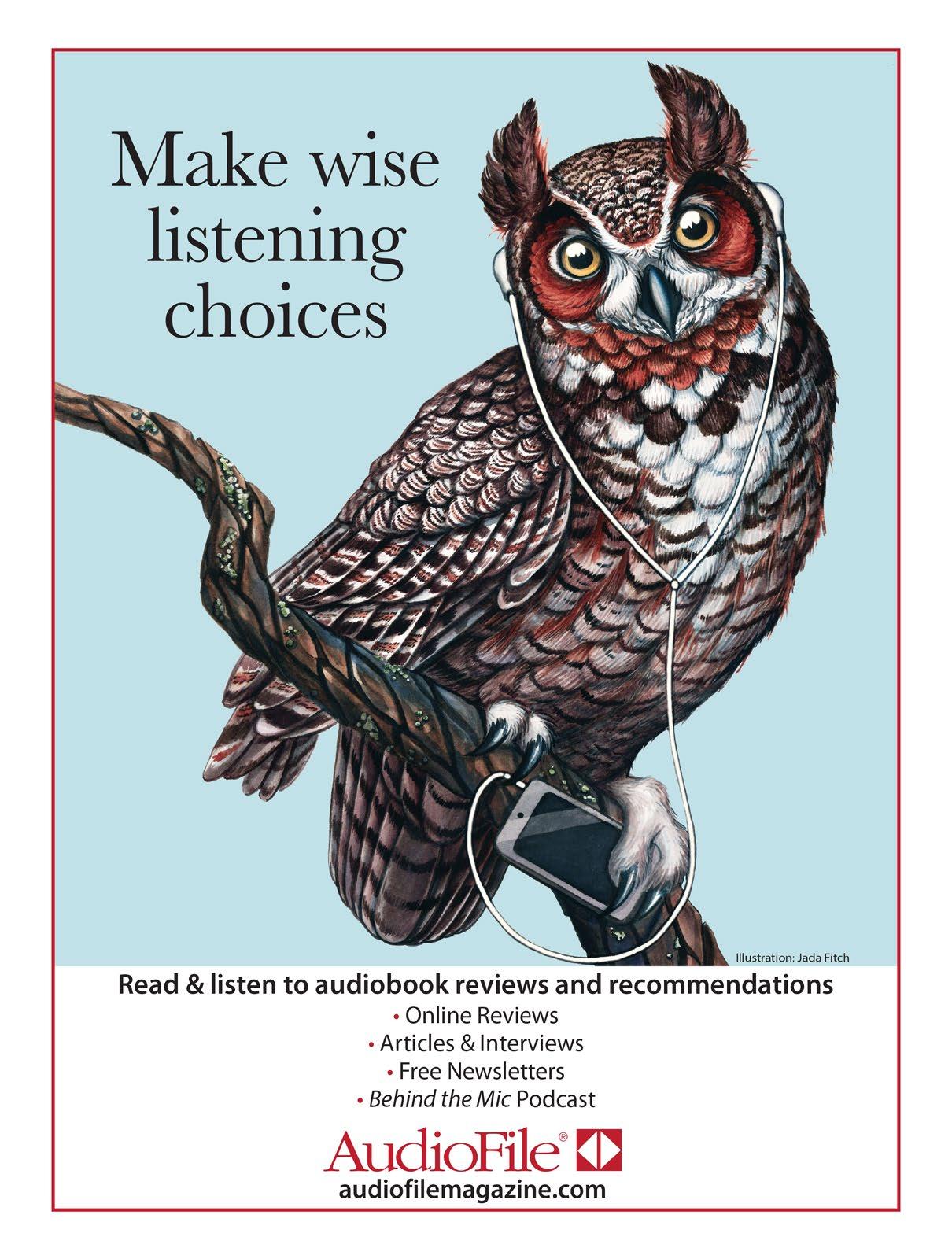THE Kirkus Prize 2025
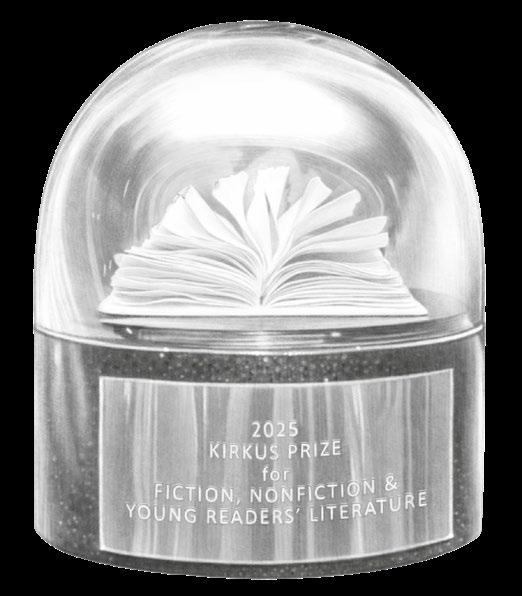

A special supplement to celebrate 12 years of recognizing great literature
THANK YOU to these generous supporters of the 2025 Kirkus Prize

Find your next great audiobook
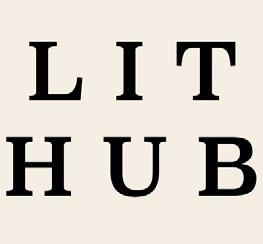




A special supplement to celebrate 12 years of recognizing great literature
THANK YOU to these generous supporters of the 2025 Kirkus Prize

Find your next great audiobook


created to honor decades of honest industry-first reviews, the Kirkus Prize shines a light on the best books being published today. It’s one of the richest literary honors in the world, with three awards of $50,000—in fiction, nonfiction, and young readers’ literature— given annually. Winners in each category also receive a trophy—a custom work of art created by the U.K. design firm Vezzini & Chen.
This year marks our 12th annual awards ceremony, heralding books published between
November 1, 2024, and October 31, 2025. To be eligible, a book must receive a starred review from our critics. The Kirkus star, awarded to less than a tenth of the thousands of books we review each year, is a well-known emblem of excellence in the industry. It illuminates the titles we think rise above the pack.
The editors of Kirkus and our expert jurors believe the six books we’ve chosen as finalists in each prize category will stand the test of time. We wholeheartedly hope you’ll spend time with these titles and, with luck, find a new favorite. There’s nothing we love more than a winning recommendation—except, perhaps, a big party.
Derrick Barnes author of

“This striking work, deeply rooted in the Mississippi soil and interwoven with Barnes’ invented tall tales, offers incisive commentary on America’s fixation with celebrating Black bodies— and silencing Black voices.”
—Kirkus Prize Jurors


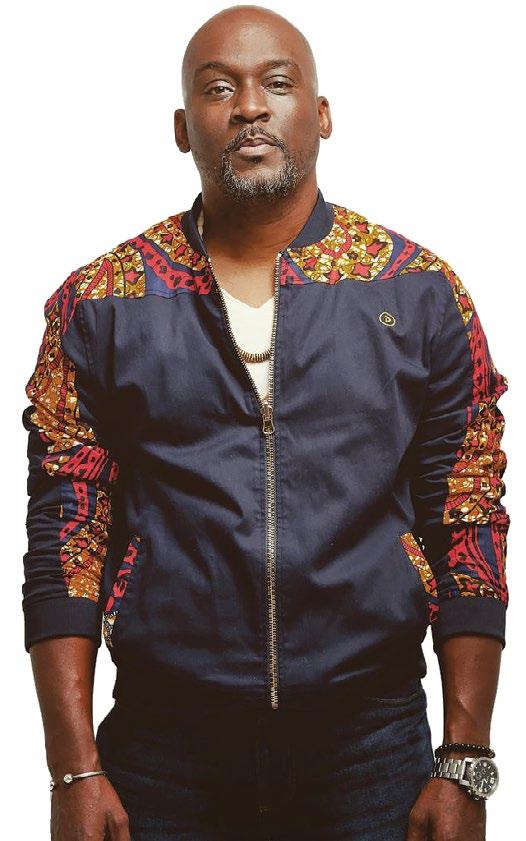
By Kiran Desai


Angela Flournoy
and unsettling, this
evades the expected at every turn.


Allegra Goodman
Lucas Schaefer

By Megha Majumdar
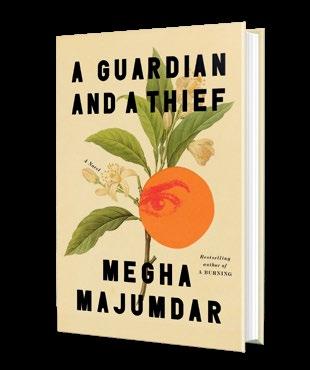
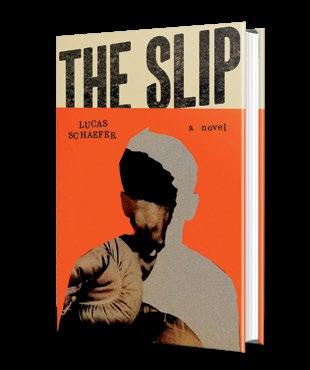
David Szalay
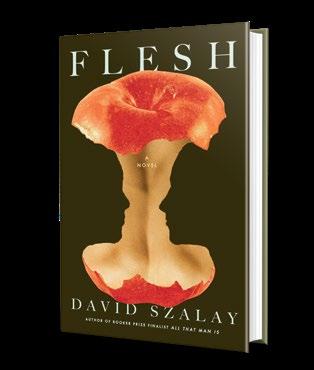
Candace Fleming author of
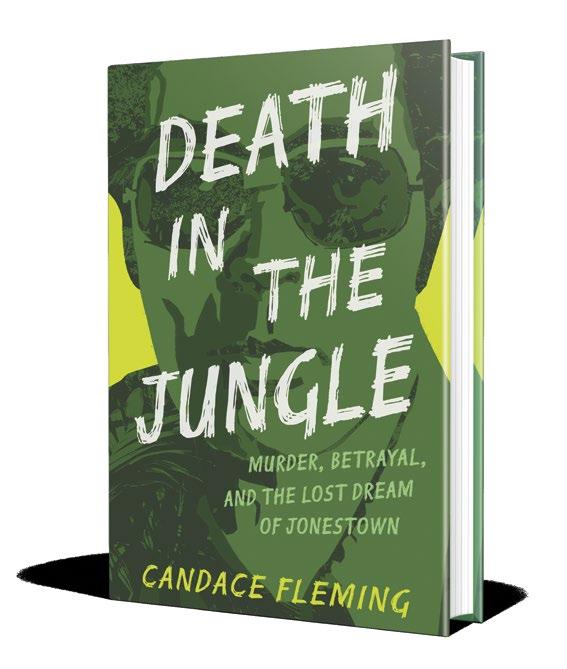
“Compelling storytelling and a deeply compassionate tone distinguish this authoritative work of narrative nonfiction that revisits the widely known—and widely misunderstood— Jonestown tragedy.”
—Kirkus Prize Jurors





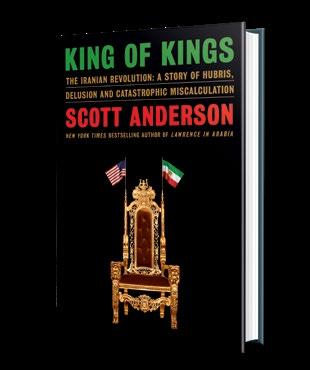

Scott Anderson
Nicholas Boggs

By Sophie Elmhirst
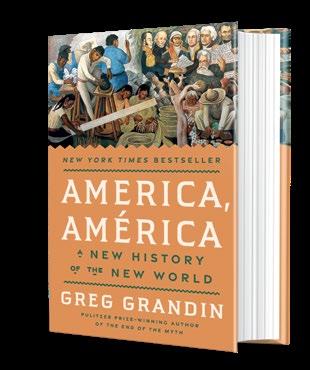
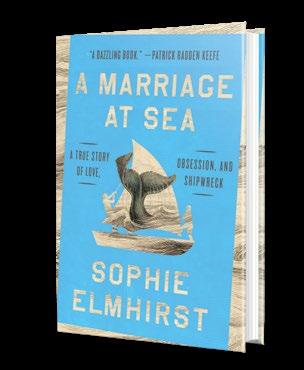


Imani Perry author of
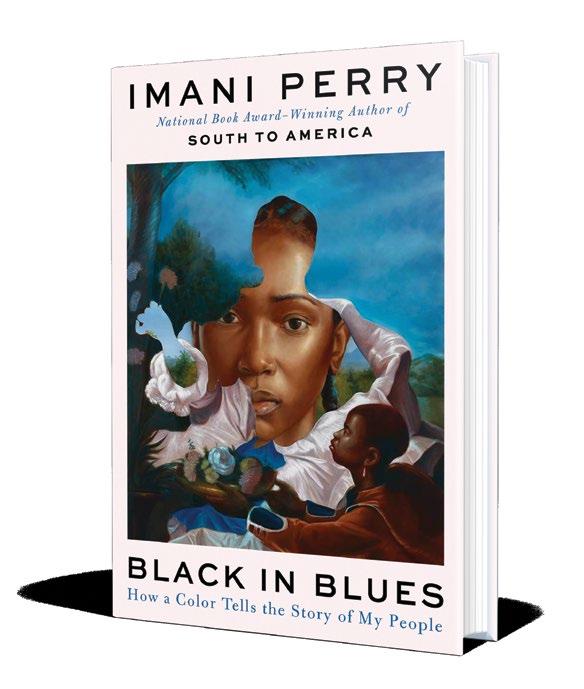
“Lyrical and meditative, Perry’s study is an inspired perspective on Black life in America.”
—Kirkus Prize Jurors



Brian Floca; illus.
Sydney Smith
By Thao Lam



By Derrick Barnes
By Triinu Laan; illus.
Marja-Liisa Plats;
Cullen
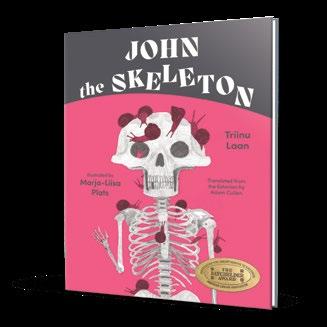


author and translator of
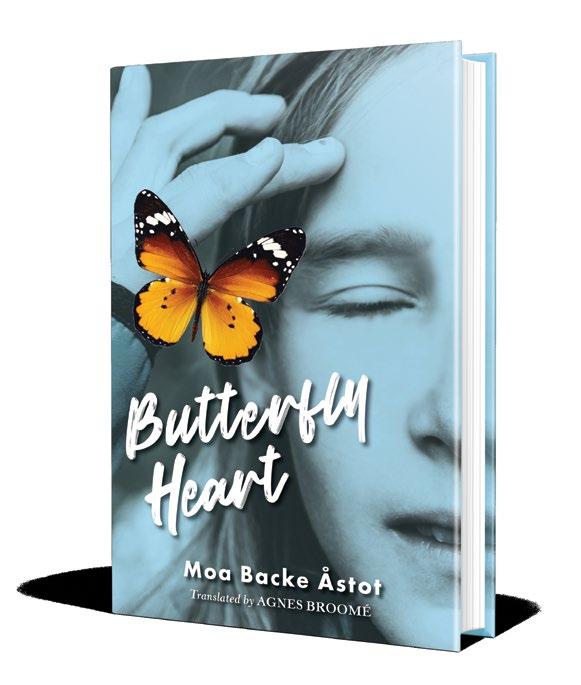
“A Swedish and Sámi teen wrestles with identity and authenticity in this story that’s grounded in an intimate journey of cultural exploration and universally recognizable themes of adolescence.”
—Kirkus Prize Jurors


and illustrator of
“Mesmerizing verse seamlessly pairs with arresting, impressionistic artwork for a thrillingly immersive tale that evokes the youthful spirit of adventure and the power of the sibling bond.”

—Kirkus Prize Jurors




These passionate and knowledgeable readers bring a wealth of experience to the mission.
Thérèse Purcell Nielsen is a fiction reviewer for Kirkus. She is a former head of reference and adult fiction selector at the Huntington Public Library. She served for years on the Long Island Reads Committee (One Island—One Book) including as the Suffolk County chairperson. She has been a reviewer for Library Journal , where she wrote a bimonthly column on memoir. Thérèse is a lifetime member of the National Book Critics

Circle and has been a panel member for the John Leonard Prize. Before becoming a public librarian, she practiced law.
Oscar Villalon is the editor of ZYZZYVA , the award-winning literary journal celebrating its 40th anniversary in 2025. His writing and reviews have been published in The Believer, VQR , Alta , Stranger’s Guide , and elsewhere. He lives in San Francisco.
Calvin Crosby, a Cherokee Nation member, is an owner of the King’s English Bookshop in Salt Lake City and the executive director of Brain Food Books, a 501(c)(3) organization that provides books to underrecognized communities along the Wasatch Front. Calvin served as a juror for the 2023 National Book Award Foundation’s fiction category and on the Library of Congress Youth Ambassador Committee. He


received the 2022 Duende-Word BIPOC Leadership Award and was honored as the 2023 University of Utah’s Native Excellence Community Partner. He is working on a Dial Fellowship in conjunction with Emerson Collective.
Anita Felicelli is the author of How We Know Our Time Travelers and other books. She is the books editor of Alta Journal . Her criticism and essays have appeared in the Los Angeles Times , the Washington Post , the New York Times , the Los Angeles Review of Books , Slate, and elsewhere. She served on the board of the National Book Critics Circle from 2021 to 2024. She lives in the Bay Area with her family.
Dr. Annette Y. Goldsmith has enjoyed working collaboratively to design community spaces and tools for readers— as a youth services librarian, a graduate instructor in children’s literature and librarianship, and currently as a Judaica librarian at Los Angeles’ Sephardic Temple Tifereth Israel (STTI). Annette was the founding editor of the online international children’s literature journal the Looking Glass, spearheaded the Global Literature in Libraries Initiative Translated YA Book Prize, won a 2023 ALA Carnegie-Whitney grant (with Dr. Marc Aronson and David Jacobson) to create “Building a Global Youth Literature Collection 101,” and runs the virtual STTI Second Sunday Book Club—you’re invited!

Erika Long is a dynamic force in the library world, blending a decade of librarianship with roles as a school librarian, adjunct lecturer, and founder/consultant at Not Yo Mama’s Librarian LLC. Her leadership shines through active participation in professional associations, including the American Library Association. Erika often shares her expertise as a speaker and content writer. She especially loves creating educator guides for children’s and YA literature. She co-authored the “Equity” chapter of Core Values in School Librarianship Outside the library world, Erika is a passionate foodie who enjoys a perfectly crafted meal, occasionally ending it with a fine cigar.


From all of us at Mariner Books and the Morrow Group, warm congratulations to Angela Flournoy on her novel The Wilderness being named a Finalist for the Kirkus Prize
We raise our glasses: to this, and more!


author

“With sly humor and vibrant collage artwork that playfully beckons young readers, Lam captures a child’s-eye view of a joyfully inclusive community in this tale with a resonant message of body positivity.”







1) 2016 : Jason Reynolds, right, author of As Brave as You , received the prize for young readers’ literature, presented by Kirkus’ Chaya Schechner, in Austin, Texas.
2) 2018 : Finalists in the young readers’ category in Austin, from upper left: Derrick Barnes, Tomi Ad -
eyemi, Elizabeth Acevedo, Meg Medina, Gordon C. James. Kneeling in front: Jacqueline Woodson. Barnes and James won the award for Crown: An Ode to the Fresh Cut
3) 2019: Nonfiction winner Saaed Jones (How We Fight for Our Lives), left, with young readers’


winner Jerry Craft (New Kid) in Austin.
4) 2020: During the Covid-19 pandemic, the ceremony moved online. The picture book I Am Every Good Thing won the young readers’ prize; author Derrick Barnes, left, and illustrator Gordon C. James, right, with their families,
accepted the award, their second, on Zoom.
5) 2021: Brian Broome won the nonfiction prize for Punch Me Up to the Gods. Joining us on Zoom from his home in Pittsburgh, Broome was visibly stunned by the news, to the delight of viewers. “Oh, crap! Are you kidding me? Wow!,” he exclaimed.






6) 2021 : Christina Soontornvat, at home in Austin, came on Zoom to accept the young readers’ prize for All Thirteen: The Incredible Cave Rescue of the Thai Boys’ Soccer Team
7) 2022: This year’s ceremony saw us back in person at the Austin Central
Library, where a cameraman captured the scene, simultaneously streamed live on YouTube.
8) 2023 : The 10th iteration brought Kirkus co-chairmen Marc Winkelman, left, and Herb Simon to our New York venue, Tribeca Rooftop. The Simon Foundation
has funded the prize since its inception.
9) 2023 : Author James McBride received the fiction prize for his novel The Heaven and Earth Grocery Store
10) 2024: Back at the Tribeca Rooftop, Percival Everett’s James collected the fiction
prize; Doubleday Publisher and Editor-in-Chief William J. Thomas accepted on his behalf.
11) 2024: Nonfiction winner Adam Higginbotham (Challenger: A True Story of Heroism and Disaster on the Edge of Space) and young readers’ winner Ken Cadow (Gather) posed with a trophy.
Past recipients reflect on the import of the Kirkus Prize.
The Kirkus Prize has created a superb canon of its own. Few literary awards carry as much weight as this prize, judged by some of our most distinguished editors, critics, booksellers, and librarians and given by a publication that, for almost a century, has helped readers find their bearings in a rich and wonderfully complicated iterary landscape.
—Hernan Diaz, author of Trust, winner of the 2022 fiction prize
Winning the Kirkus Prize meant so much to me, both for the public recognition and for the financial support that allowed me the space and freedom to imagine new stories.
—Harmony Becker, author/illustrator Himawari House, winner of the 2022 young readers’ prize

It made a real, material difference in my life, allowing me to dedicate more of my time to writing.

A prize from Kirkus Reviews says you’ve arrived. The press starts calling, your colleagues e-mail and text, and your 90-year-old mother beams. “My gosh,” you think, “I really am a writer.”
—Jack E. Davis, author of The Gulf , winner of the 2017 nonfiction prize

—Raven Leilani, author of Luster, winner of the 2020 fiction prize



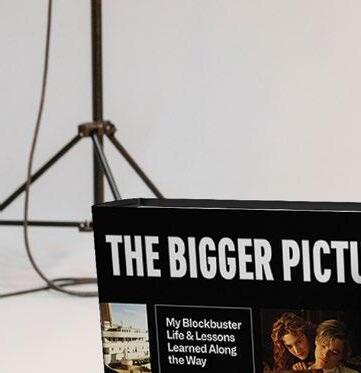












FEATURING 298 Industry-First Reviews of Fiction, Nonfiction, Children’s, and YA Books


The Supreme Court justice says her books for children are the heart of her legacy
When timing is everything, we deliver.
Your patrons don’t want to wait – and neither should you. IngramExpress® ensures you get the big books you need when you need them. With in-stock inventory and a customer-first mindset, we’re redefining reliability.
Fast, free shipping
Order from any distribution center
No order or shipment minimums
Competitive discounts
Discover IngramExpress at ingramcontent.com/express





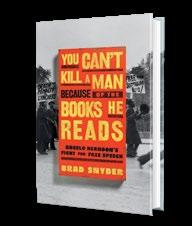

FROM THE EDITOR’S DESK
BOOK BANNING HAS become such an insidiously entrenched part of the contemporary political landscape that it’s easy to forget how long the problem has been with us. Reading about Banned Books Week—observed October 5-11 this year—I was surprised to learn that the American Library Association had launched this annual observance back in 1982, in response to a wave of attempted bans at the time.
That year also saw a significant Supreme Court ruling, Island Trees School District v. Pico. A group of parents in the district had lodged a complaint with the school board that nine books in the library were “antiAmerican, anti-Christian, anti-Semitic and just plain filthy.” Among the offending titles? Kurt Vonnegut’s Slaughterhouse-Five and a
volume of Best Short Stories by Negro Writers edited by Langston Hughes. When the books were removed from the shelves, four students filed a lawsuit. SCOTUS ultimately ruled in the students’ favor, citing the First Amendment. (Our cover subject, Justice Sonia Sotomayor, wasn’t yet on the court, but she has plenty to say about the value of literature for young readers; read the interview on p. 86.)
Alice Walker’s The Color Purple was published in 1982 as well. The novel garnered immediate critical acclaim, but by 1984, it was already a magnet for would-be censors, who disliked its depictions of sexual abuse and a lesbian relationship. In Oakland, California, a parent, whose daughter had been assigned to read it, objected to its use in public school classrooms; a committee was formed and
Frequently Asked Questions: www.kirkusreviews.com/about/faq
Fully Booked Podcast: www.kirkusreviews.com/podcast/
Advertising Opportunities: www.kirkusreviews.com/book-marketing
Submission Guidelines: www.kirkusreviews.com/about/publisher-submission-guidelines
Subscriptions: www.kirkusreviews.com/magazine/subscription
Newsletters: www.kirkusreviews.com
For customer service or subscription questions, please call 1-800-316-9361
“exonerated” the book—yet The Color Purple, like Slaughterhouse-Five, remains a frequent target, all these years later.
Clearly, the impulse to ban books is part of the American DNA, as two new books demonstrate. Ira Wells’ On Book Banning: Or, How the New Censorship Consensus Trivializes Art and Undermines Democracy (Biblioasis, June 3) zeroes in on public libraries as contested zones of free speech and censorship where, in an ideal world, democratic citizens can educate themselves and make informed decisions about what they will and will not read. Our review calls it a “thoughtful, conversationally written reflection on why banning books damages the fabric of social belonging.”
In You Can’t Kill a Man
Because of the Books He Reads: Angelo Herndon’s Fight for Free Speech (Norton, February 4), legal historian Brad Snyder shows the frightening flip side of book banning—the punishment of individuals for the books they choose to read. Snyder unearths the forgotten
story of a Black labor organizer who, in 1930s Georgia, was successfully prosecuted for possession of a book, discovered during an unwarranted search of his home, that advocated the formation of a Black homeland in several Southern states, supposedly violating a Georgia statute against inciting insurrection. Eventually, the Supreme Court struck down the law and freed Herndon.
You, too, can play a role in the ongoing struggle against censorship. Visit the Banned Books Week website (bannedbooks.org), which has more information and tool kits for further action, such as hosting a “Right To Read Night,” where friends and neighbors can discuss this year’s featured banned book: Laurie Halse Anderson’s Chains. Reading is indeed a right—one best defended by exercising it.

Co-Chairman
HERBERT SIMON
Interim Publisher & CEO
JUDY HOTTENSEN jhottensen@kirkus.com
Chief Marketing Officer
SARAH KALINA skalina@kirkus.com
Publisher Advertising & Promotions
RACHEL WEASE rwease@kirkus.com
Indie Advertising & Promotions
AMY BAIRD abaird@kirkus.com
Author Consultant
KEELIN FERDINANDSEN kferdinandsen@kirkus.com
Lead Designer KY NOVAK knovak@kirkus.com
Magazine Compositor
NIKKI RICHARDSON nrichardson@kirkus.com
Director of Kirkus Editorial ROBIN O’DELL rodell@kirkus.com
Kirkus Editorial Senior Production Editor
MARINNA CASTILLEJA mcastilleja@kirkus.com
Kirkus Editorial Production Editor
ASHLEY LITTLE alittle@kirkus.com
Copy Editors
ELIZABETH J. ASBORNO
NANCY MANDEL
BILL SIEVER
KENNETH WALSH
Mysteries Editor
THOMAS LEITCH
Co-Chairman
MARC WINKELMAN
Editor-in-Chief TOM BEER tbeer@kirkus.com
President of Kirkus Indie
CHAYA SCHECHNER cschechner@kirkus.com
Fiction Editor
LAURIE MUCHNICK lmuchnick@kirkus.com
Nonfiction Editor
JOHN McMURTRIE jmcmurtrie@kirkus.com
Young Readers’ Editor
LAURA SIMEON lsimeon@kirkus.com
Young Readers’ Editor
MAHNAZ DAR mdar@kirkus.com
Editor at Large
MEGAN LABRISE mlabrise@kirkus.com
Senior Indie Editor
DAVID RAPP drapp@kirkus.com
Indie Editor ARTHUR SMITH asmith@kirkus.com
Senior Editorial Assistant NINA PALATTELLA npalattella@kirkus.com
Senior Indie Editorial Assistant
DAN NOLAN dnolan@kirkus.com
Indie Editorial Assistant
KATARINA YERGER kyerger@kirkus.com
Contributing Writers
GREGORY McNAMEE
MICHAEL SCHAUB

Contributors
Colleen Abel, Jill Adams, Mahasin Aleem, Paul Allen, Stephanie Anderson, Jenny Arch, Kent Armstrong, Mark Athitakis, Kit Ballenger, Sally Battle, Carole Bell, Nell Beram, Elizabeth Bird, Ariel Birdoff, Christopher A. Biss-Brown, Sarah Blackman, Melissa Brinn, Jessica Hoptay Brown, Cliff Burke, Kevin Canfield, Bluebelle Carroll, Charles Cassady, Ann Childs, Alec B. Chunn, Tamar Cimenian, K.W. Colyard, Jeannie Coutant, Maya Davis, Cathy DeCampli, Dave DeChristopher, Kathleen Deedy, Elise DeGuiseppi, Amanda Diehl, Steve Donoghue, Robert Duxbury, Jacob Edwards, Gina Elbert, Lisa Elliott, Chelsea Ennen, Joshua Farrington, Brooke Faulkner, Margherita Ferrante, Katie Flanagan, Catherine Foster, Sasha Fox-Carney, Mia Franz, Ayn Reyes Frazee, Harvey Freedenberg, Jenna Friebel, Jackie Friedland, Nivair H. Gabriel, Emily Gaines, Jackie Garcia, Laurel Gardner, Cierra Gathers, Amanda Gefter, Danielle Galván Gomez, Melinda Greenblatt, Vicky Gudelot, Tobi Haberstroh, Dakota Hall, Sean Hammer, Alec Harvey, Peter Heck, Loren Hinton, Katrina Niidas Holm, Terry Hong, Kathleen T. Isaacs, Kristen Jacobson, Wesley Jacques, Danielle Jones, Betsy Judkins, Maya Kassutto, Lyneea Kmail, Maggie Knapp, Andrea Kreidler, Priti Krishtel, Megan Dowd Lambert, Carly Lane, Chelsea Langford, Christopher Lassen,, Tom Lavoie, Seth Lerer, Maureen Liebenson, Coeur de Lion, Karen Long, Patricia Lothrop, Sawyer Lovett, Georgia Lowe, Wendy Lukehart, Michael Magras, Joan Malewitz, Thomas Maluck, Joe Maniscalco, Michelle H Martin, Gabriela Martins, J. Alejandro Mazariegos, Kirby McCurtis, Kathleen McLaughlin, Zoe McLaughlin, Don McLeese, Cari Meister, Carol Memmott, Clayton Moore, Rebecca Moore, Andrea Moran, Jennifer Nabers, Christopher Navratil, Liza Nelson, Katrina Nye, Tori Ann Ogawa, Mike Oppenheim, Nick Owchar, Emilia Packard, Nina Palattella, Megan K. Palmer, Deb Paulson, Tara Peck, Rebecca Perry, John Edward Peters, Christofer Pierson, Vicki Pietrus, Shira Pilarski, Cathy Poland, Margaret Quamme, Carolyn Quimby, Judy Quinn, Kristy Raffensberger, Kristen Bonardi Rapp, Kristen Rasmussen, Matt Rauscher, Darryn Reams, Stephanie Reents, Sarah Rettger, Peter Richardson, Alyssa Rivera, Erica Rivera, Amy Robinson, Soumi Roy, Gia Ruiz, Lloyd Sachs, Roy Salzman-Cohen, Bob Sanchez, Keiko Sanders, Caitlin Savage, Christine Scheper, Jennifer Senick, Jerome Shea, Sadaf Siddique, Danielle Sigler, Linda Simon, Laurie Skinner, Wendy Smith, Margot E. Spangenberg, Allison Staley, Daneet Steffens, Allie Stevens, Mathangi Subramanian, Jennifer Sweeney, Ella Teevan, Bill Thompson, Renee Ting, Lenora Todaro, Francesca Vultaggio, Katie Weeks, Darryl Wellington, Paul Wilner, John Wilwol, Marion Winik, S.D. Winston

LILY KING WON the very first Kirkus Prize for Fiction, in 2014, for Euphoria, her wonderfully smart novel based on anthropologist Margaret Mead’s relationships with her second and third husbands—and the men’s relationship with each other. So I was excited to learn that her latest, Heart the Lover (Grove, October 7), is also about a love triangle. It’s narrated by a woman we know only as Jordan, who meets two ferociously smart guys in her 17th-century lit class. She starts dating Sam while trying to ignore the fact that she’s in love with his best friend, Yash; the two of them give her the nickname Jordan after Nick Carraway’s girlfriend in The Great Gatsby. This is a novel to
immerse yourself in: “King is a genius at writing love stories,” according to our starred review. When we finally learn Jordan’s real name, on the last page of the book, it’s a stunning moment. Here are four more highlights coming up in October:
Vaim by Jon Fosse, translated by Damion Searls (Transit Books, October 7):
The latest by Nobel laureate Fosse is made up of a single sentence split into three sections, each narrated by a resident of a small Norwegian fishing village, as they “ponder life, love, and what might’ve been,” according to our review.
Minor Black Figures by Brandon Taylor (Riverhead, October 14): Wyeth has hit

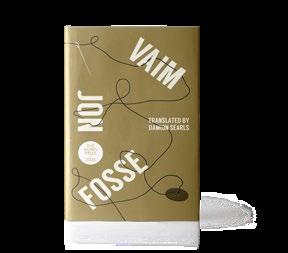
an artist’s block. He’s a young gay Black painter in New York, working parttime for an art restorer and trying to figure out which way to go with his work. A painting he made at the height of the pandemic was mistaken for a commentary on race, but he was mainly influenced by an Ingmar Bergman film. When he meets Keating, a white man who’s recently abandoned the Catholic priesthood, he sees an opportunity for change. “A piercing, precise, and affecting tale of young love and high art,” says our starred review.
Wreck by Catherine Newman (Harper/HarperCollins, October 28): Newman made a splash last year with Sandwich, set during a family vacation on Cape Cod. In this followup, Rocky is back home in Western Massachusetts, dealing once again with the perils of an overactive
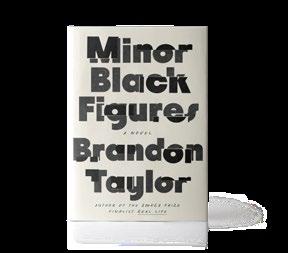

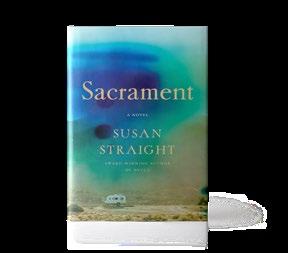
mind: What is that mysterious rash? What if her own family had faced a tragic death, rather than one with which they’re tangentially connected?
Our starred review says, “Newman excels at showing how sorrow and joy coexist in everyday life.…A heartbreaking, laugh-provoking, and absolutely Ephron-esque look at the beauty and fragility of everyday life.” Sacrament by Susan Straight (Counterpoint, October 28): Straight’s latest is something of a companion to her kaleidoscopic California novel, Mecca , which was a finalist for the 2022 Kirkus Prize, though it absolutely stands alone. Opening in the spring of 2020, Straight introduces three nurses— Cherrise, Larette, and Marisol—who are caring for Covid-19 patients, and who, for the safety of their own families, are living in a trailer park near the hospital where they work. Then Cherrise’s 15-yearold daughter, Raquel, goes missing. Our starred review says, “Straight reminds us of where we have been and where we are going without once looking away.”
Laurie Muchnick is the fiction editor.
Neighboring couples in the rural West Country weather the famously frigid British winter of 1962.
Miller’s 10th novel opens in an asylum near Bristol, England, where one patient awakens in the night to find that another—a boy of 19—has died by suicide. Though we will later learn how these characters connect to the main plot, the focus then shifts to a pair of marriages. One couple, Bill and Rita Simmons, lives on a dairy farm. Bill is new to farming and Rita not long ago worked as a dancer in a club; now she’s pregnant, reading paperbacks and half-heartedly attempting to cook. It is she who will one day, out of boredom, cross the field that separates the Simmonses
from their wealthier neighbors, the Parrys: the local physician, Dr. Eric Parry (he prescribed the pills the dead boy took) and his wife, Irene. Though her background is much fancier than Rita’s, Irene is also newly pregnant and the two easily form a friendship. One of the high points of the book, showing off Miller’s dazzling prose and very dry wit, is the drinks party Irene throws on Boxing Day. This party is complicated for Eric by the attendance of his mistress, along with her husband and son, but they will avoid trouble, at least for now. Very much in the air of the novel are World War II and the Holocaust, which the characters lived through in different ways not so long

ago. Eric’s medical partner, Gabby Miklos, barely escaped the camps, and tries to share his story with Bill Simmons at the drinks party. “When Gabby began again— Häftling, Sonderkommando, Judenlager Bill, staring at an abandoned cheese stick on the tablecloth, began to withdraw his heart.”
In the same room, to the delight of the other guests, Rita is demonstrating a dance called the mashed potato. Miller is an expert juggler of dark and light, of big and small, of seen and unseen. A masterful, acute, and very British novel, revealing the tensions of a time beset by winds of change.
Álvarez, Carlos Manuel | Trans. by Natasha Wimmer | Graywolf (272 pp.) | $17 paper November 4, 2025 | 9781644453636
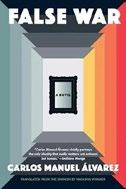
A novel-infragments about the far-flung, often broken lives of Cubans and Cuban refugees.
Álvarez’s second work of fiction—following The Fallen (2020)—is billed as a novel, though it more closely resembles a linked-story collection where each piece is shattered and reshuffled. In one section, a Cuban refugee nicknamed Fanboy describes a trip to the Louvre with his girlfriend, Elis; in another, Ines, based in Miami, consults with clients at an “Exceptional Concerns Clinic” in a role that seems part psychiatrist, part spiritual adviser. In a section titled “Usual Suspects,” a group of adolescents navigate Havana streets at night; in another, a barber works with clients who’ve made the trek to America, while in yet another an author attempts to gather his observations into a novel titled False War. At first, Álvarez’s approach seems less prismatic than scrambled, which makes the narrative difficult to penetrate. But the deliberate lack of clear footholds is part of the point: He wants to emphasize the individuality of his characters’ journeys and blunt any reader’s attempt to reduce them to types. (As one character puts it: “One thing I realized about art is it tries to confuse you, and sometimes you don’t know who’s what.”) To that end, the range of characters is an asset: Among the strongest are Fanboy, who feels displaced not just as Cuban in Miami but a macho baseball fan in Paris; a speed-chess master recalling his hustles; and an exile heading to Germany to share his story. There are pungent lines about the anxiety of exile throughout: Havana is “a city of many stray sadnesses.” Still, some more narrative coherence might better sell the point.
are as comfortable with
THE PREDICAMENT
A multivalent if often overly knotty portrait of alienation.
Baldacci, David | Grand Central Publishing (448 pp.) | $32 | November 11, 2025 9781538757987
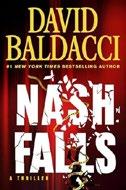
A business executive becomes an unjustly wanted man. Walter Nash attends his estranged father Tiberius’ funeral, where Ty’s Army buddy, Shock, rips into him for not being the kind of man the Vietnam vet Ty was. Instead, Nash is the successful head of acquisitions for Sybaritic Investments, where he earns a handsome paycheck that supports his wife, Judith, and his teenage daughter, Maggie. An FBI agent approaches Nash after the funeral and asks him to be a mole in his company, because the feds consider chief executive Rhett Temple “a criminal consorting with some very dangerous people.” It’s “a chance to be a hero,” the agent says, while admitting that Nash’s personal and financial risks are immense. Indeed, readers soon find Temple and a cohort standing over a fresh corpse and wondering what to do with it. Temple is not an especially talented executive, and he frets that his hated father, the chairman of the board, will eventually replace him with Nash. (Father-son relationships are not glorified in this tale.) Temple is cartoonishly rotten. He answers to a mysterious woman in Asia, whom he rightly fears. He kills. He beds various women including Judith, whom he
tries to turn against Nash. The story’s dramatic turn follows Maggie’s kidnapping, where Nash is wrongly accused. Believing Nash’s innocence, Shock helps him change completely with intense exercise, bulking up and tattooing his body, and learning how to fight and kill. Eventually he looks nothing like the dweeb who’d once taken up tennis instead of football, much to Ty’s undying disgust. Finding the victim and the kidnappers becomes his sole mission. As a child watching his father hunt, Nash could never have killed a living thing. But with his old life over— now he will kill, and he will take any risks necessary. His transformation is implausible, though at least he’s not green like the Incredible Hulk. Loose ends abound by the end as he ignores a plea to “not get on that damn plane,” so a sequel is a necessity. Hokey plot, good fun.
Boyd, William | Atlantic Crime (256 pp.) $28 | November 4, 2025 | 9780802166272

Travel writer Gabriel Dax, recruited by MI6, continent-hops from Guatemala to London to Berlin on agency business. Introduced in Gabriel’s Moon (2024), Dax has his hands full between his spying and his book-writing, which gives him a handy cover for his undercover work. In March 1963 he is sent to Guatemala to observe the charismatic “Padre Tiago,” an activist ex-priest who
may become president. No sooner does Gabriel arrive than a coup breaks out; Padre Tiago is killed, as is his promise to nationalize the all-powerful United Fruit’s plantations and return them to the workers. Dax returns to England, where he reignites the passionate (on his end) affair with Faith Green, his manipulative MI6 boss and “puppet-mistress.” She is a prime topic of his discussions with his shrink, Katerina Haas, who encourages him to be his “true self”—a concept with which this novel about people who aren’t what they seem has a lot of fun. Then he’s sent to Germany to work with a young female CIA agent in tracking Dean Furlan, a shady businessman he encountered in Guatemala; Furlan may have orchestrated two recent attempts to kill President Kennedy in the U.S. and is now in Berlin, a few weeks prior to JFK’s state visit. The novel breezes along, with Gabriel making like James Bond, until an anticlimactic epilogue dated November 22, 1963, implies that events in Berlin explain what happened in Dallas. Few literary novelists are as comfortable with espionage tropes as Boyd, who uses the genre as a platform for another of his comically flawed, self-delusional protagonists. An undeveloped subplot involving a Russian triple agent seems likely to be picked up in the next Dax novel.
A thriller that’s always in motion but, unlike its hero, always knows where it’s going.
de l’Horizon, Kim | Trans. by Jamie Lee Searle | Farrar, Straus and Giroux (336 pp.) $29 | August 26, 2025 | 9780374612375

A grandmother’s descent into dementia causes her genderfluid grandchild to embark on an exploration of the family tree in this prizewinning debut novel from a Swiss author.
In the Bernese German dialect, “grossmeer,” or grandmother, translates literally to “large ocean,” and the sense the narrator has of their own beloved but often troubling Grossmeer reflects this vast, enveloping unknowability. As Grossmeer’s condition declines, the narrator sets out to compile the stories that form the complex throughline from their cloistered childhood in the provincial Swiss city of Ostermundigen, growing up in the house their greatgrandfather built with his own hands, to their current life in Zürich as a genderfluid person with an abundant sex life. But, just as they see language as “an ocean, waving and mixing, ebbing and gushing, with no clear border,” the boundaries of memory prove equally fluid. The narrator travels backward through Grossmeer’s dark fairy tales of the Ostermundigen house and garden with its towering blood beech, planted on the day of Grossmeer’s birth, and then even further back through the biographical research their witch-obsessed mother has done into the family’s forgotten matrilineage of midwives, herbalists, and prostitutes. The resulting text is nothing so simple as a record of Grossmeer’s life, or even an answer to the questions that dog her descendants’ understanding of her secretive childhood, haunted by a harsh mother, dead or disappearing sisters, and the limitations placed upon her by both poverty and her gender. Rather, the narrator interrogates the “binaryfascism” of language (spoken, written, in the gestures of the body) in order to reflect the “urgent in-betweenness” forced upon them by their fluid reality in a rigidly binary world. As the narrator says, “Perhaps writing is the search for a foreign language in the words we have available to us.” This book, which flits stylistically among heady fairy-tale iconography, a meticulously researched cultural history, and a sendup of high postmodern maximalism, among other modes, reinvents the narrative of the family drama not as a vehicle for the narrator’s identity, but as a lucent mirror held up to the possibilities of our own. A joyous investment in the power of language to reveal and then transform.
Denetsosie, Stacie Shannon, Kinsale Drake & Darcie Little Badger, eds. | Torrey House Press (240 pp.) | $18.95 paper November 4, 2025 | 9798890920300

A collection of more than 20 Indigenous writers carving out space in the literary canon. “We are many and diverse cultures, histories, and present-day realities…There’s incredible beauty in this, our variety,” the editors write in their introduction. Featuring Indigenous writers of poetry and prose, including women, two-spirit people, and people of marginalized genders, the collection places particular emphasis on emerging writers: “We hold the door open behind us and encourage others to do the same.” Rooted in the past, present, and futures (both real and imagined), Indigenous language, culture, resilience, sorrow, hope, and traditions are fully realized in this collection. In A.J. Eversole’s engaging “Dilasulo Walks,” Little Dilasulo, a pair of moccasins that yearns to be worn, finds sentience after 177 years. Little Dilasulo fears that Indigenous people’s art, like themself, will forever be trapped within museums as “the aftermath of our apocalypse.” Imbued with science fiction and horror elements, Moniquill Blackgoose’s “Sky Woman Rising: A Memoir” and Denetsosie’s “No Wrong Roads Home” notably explore the apocalypse as a way back to humanity and the Earth (“All Natives have lived in a dystopia since colonization,” Denetsosie writes). Poetry standouts include Ayling Dominguez’s “Alfabetízate Otro Mundo: Reverse Abecedarian Broke Open” (“The path to liberation gets wider the more of us tread it”); Ha’åni Lucia Falo San Nicolas’ “Kahilinā’i” (“our shared being as / women of the Pacific. I knew / you long before I learned your // name…”); Arielle Twist’s “In the beginning, it’s just you and me against the world” (“My haunting will
be one of longing / to love something as you have loved me”); and Amelia Vigil’s “Splice of Genetic Material” (“these bones / these bones // are on loan”). Though the collection’s organization can feel jarring at times, the interconnectedness of the writing and the writers—as Indigenous people, stewards of the land, and keepers of history—serves as the anthology’s beating heart.
An enduring collection straddling time, language, and genre to explore Indigenous futures that await on and off the page.
Dickerman, Laura | Gallery Books/ Simon & Schuster (368 pp.) | $29 September 2, 2025 | 9781668081099
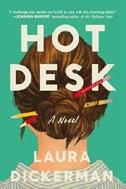
A mother’s and daughter’s journeys in the publishing world both begin with a lack of desk space. Rebecca Blume doesn’t want to share her desk. It’s 2022, and the publishing house where Rebecca is an editor has decided to return to the office on a hybrid schedule, implementing a technique called “hot desking,” by which Avenue employees share their desks with people from another imprint, Hawk Mills, on their work-from-home days. Not only must Rebecca sacrifice her carefully curated decor, but her desk partner, Ben Heath, is a bit of a slob, leading to passive-aggressive, sometimes-flirty Post-it notes and online banter. If that weren’t stressful enough, the recent death of literary lion Edward David Adams—yes, he’s actually known as the Lion—has left the publishing world in a tizzy, and his widow, Rose, specifically requested Rebecca’s help in handling his estate. Rebecca has no known relation to the Lion, though her mother, Jane, did intern for his literary magazine in the 1980s. It turns out that the Lion wrote a manuscript before he died that intimates a love triangle
A unique, decades-spanning story of friendship, love, and literature.
HOT DESK
among her mother, Rose, and himself. It won’t be long before everyone will want to get their hands on the posthumous manuscript, including the Lion’s party animal son, Atticus, and Rebecca’s own hot-desk partner. In a debut spanning decades, Dickerman leads readers on a funny, heartwarming journey through two generations’ involvement in the publishing industry. The author touches on the AIDS epidemic and the #MeToo movement, as well as exploring female friendship and post-pandemic attempts at a new normal, adding hints of romance and comedy. Jane and Rose’s relationship in the ’80s literary scene is the standout plot by far, and readers will be eager to learn what really occurred between the two young women all those years ago. The story has a lot of moving parts, but once all the pieces finally come together, readers will find a touching, satisfying ending.
A unique, decades-spanning story of friendship, love, and literature.
Emmons, Cai | Red Hen Press (232 pp.) | $17.95 paper October 28, 2025 | 9781636283623

A young man’s troubles follow him after he trades his spiritual calling for life as a teacher. Inspired by the life and teachings of Thomas Merton, Niall O’Malley leaves a stressful Ph.D. program to enter a Benedictine monastery in western Massachusetts full of “high hopes for communing with God and soothing his erratic temper.” But after five years, he
abruptly abandons the refuge he sought in that religious vocation for a job teaching history at a public high school in a downtrodden town on the New Jersey coast within sight of Manhattan. Despite that fresh start, brightened even more by a blossoming romantic relationship with Lluvia, a kindhearted Puerto Rican immigrant who’s single-mindedly devoted to his happiness, and who he believes “embodied the goodness and joy he’d been seeking,” and a close friendship with his fellow teacher, Trinity, Niall struggles to find fulfillment in his new role, concluding that he’s “not really built for teaching.” One of the major impediments to his job satisfaction is his student Colton Chadwick, the son of a wealthy family whose parents place him in the school in hopes of curing his disciplinary problems. Niall suspects Colton of racist sympathies, and he reinforces his antipathy toward the student by persistently interpreting even the boy’s most innocuous words and actions in a negative light. In spare but quietly eloquent prose, Emmons unobtrusively shifts her story between Niall’s years at the monastery, where his rewarding immersion in the simple daily routine of the contemplative life is marred by an increasingly ominous conflict with his fellow monk Brother Thomas, to his life in the classroom and back again, even briefly exploring the roots of the sometimes-explosive rage that has scarred him since childhood. In the comparatively brief second section of the novel, she fashions a resolution of these parallel plots that honors the depth and complexity of her protagonist’s internal turmoil, as she recognizes that changing one’s life is not as simple as changing its outer circumstances.
An immersive psychological portrait of one man’s battle with lifelong anger and guilt.
Kirkus Star
Godfrey, Jennie | Sourcebooks Landmark (416 pp.) | $17.99 paper | December 2, 2025 9781464249051

A 12-year-old girl determines to unmask a serial killer in this extravagantly ambitious story of small-town Britain in 1979. On the surface, Miv’s life seems to belong to an idyllic bygone era: She and her best friend, Sharon, walk to school every morning, passing a “snappy Jack Russell” and stopping to greet Omar, “the man in the corner shop,” who calls them the “Terrible Twosome.” But danger lurks around the edges of these familiar paths and faces; it’s been a few years since the Yorkshire Ripper began murdering nearby women, and the women and girls of the town have started taking a little extra care when they’re walking late and alone. Margaret Thatcher has recently been elected prime minister, pushing certain strains of misogyny and racism to the forefront of conversations and village life. For her part, Miv is trying to adjust to her mother’s complete withdrawal from the family due to depression. When she has the opportunity to make a wish, she wishes to “be the person to catch the Yorkshire Ripper,” and so begins a series of events that will forge friendships, expose bigots, and culminate in both tragedy and catharsis. The scope of the book is significant, and Godfrey shows a masterful control of the sprawl. This is a novel about a particular time that looks both backward and forward. For Miv and Sharon, straddling the gulf between childhood and adulthood and beginning to learn who they are, it’s a coming-of-age story; for Britain, struggling to hold space for a strong female leader alongside her conservative and xenophobic policies, it’s equally a story of reluctant yet
inevitable change. Despite some chapters told from other characters’ perspectives, this is very much Miv’s tale, and hers is one of the most engaging voices in recent fiction, both heartbreakingly innocent and incisively intelligent.
Imaginative, impressive, and illuminating.
Kirkus Star
Goldberg, Tod | Thomas & Mercer (362 pp.) $28.99 | November 4, 2025 | 9781662534089

A scuffling Seattle lawyer’s scheme to abscond with his firm’s safe deposit boxes has deadly consequences. It’s 15 years ago. Half a million in debt, Robert Green uses his access as manager of the safe deposit boxes to remove them and pile them into his van, with plans of extorting clients with the unaccounted-for cash and sensitive documents in the boxes. His plan is to escape to South America with his sister, Penny, a SoCal desertdweller whose genius IQ made her a child celebrity before she spent 14 years in prison for robbery and assaulting a cop. But his van spins off a mountain road, killing and decapitating him. His body, along with the ill-gotten loot—and his head—are discovered by Jack Biddle, the morally compromised, drug-using top cop of Granite Shores, a shabby Oregon beach town. While taking credit for cracking the safe-deposit case, he takes possession of the loot (he owes nefarious sorts a ton of money), claiming that Green disappeared with it. He thus leaves the town thinking for years that the daring thief, a hometown boy, is still alive. Flash forward to the present, when the now-legendary, media-friendly case has turned Granite Shores into a slickly gentrified destination spot—one where Penny’s nervy cousin Addie, a podcast
queen, spins conspiracy theories about the local cops. “Every new dumb thing I say creates a financial ecosystem,” she says. The novel is a nice geographical shift for Goldberg—known for capturing the seedy essence of Las Vegas and the Salton Sea in Gangsterland (2014) and The Low Desert (2021), respectively—who does an uncanny job of keeping multiple plot elements in the air, shifting among unholy alliances of mobsters and do-gooders turned bad with cutting humor. Warped family histories, the trivializing effects of social media, and an occasional jab of emotion are all in the mix. “To not have hope was acutely freeing,” thinks Penny, whose words linger more than they should. Internecine noir, done just right.
Gudenkauf, Heather | Park Row Books (320 pp.) | $18.99 paper | November 4, 2025 9780778360049

A gender-reveal celebration gone horribly wrong exposes hidden violence both past and present. On their Nightjar, Wyoming, ranch in the shadows of the Tetons, wealthy Madeline and Wes Drake are throwing the party of the year to announce the gender of their soon-to-beborn child. They have spared no expense: From the decor to the food, from the rodeo and the “pearls versus pistols” theme, to the plan to explode an old truck to ignite pink or blue powder, this is a party people will be talking about for months to come. So it is, but not for the right reasons. After Madeleine and Wes shoot the truck, a second explosion booms unexpectedly from the nearby barn, killing Madeleine’s best friend and midwife, Johanna, and injuring several more of the society guests. When ATF special agent Jamie Saldano arrives to investigate, several things immediately feel off. Among them: Madeleine’s estranged stepsister, Lucy, who turns up
after the explosion and seems unwelcome; Johanna’s volatile husband, Dalton, who had previously accused his wife of cheating; Mellie, a young cater-waitress who has been carrying on an affair with Wes. To make matters even more complicated, Jamie has history in Nightjar: His sister went missing from there nearly 30 years ago and was never found. As all these people and their secrets converge on Lone Tree Ranch, everyone has an angle to play, and it may be luck that determines who will survive. Gudenkauf excels at establishing character and atmosphere, and a sense of dread permeates every scene on this isolated (albeit beautiful and lavishly appointed) horse ranch. Intrigue is thick among the small cast of characters, and the final plot twist, though not exactly game-changing, is nonetheless satisfying. A beautifully rendered setting elevates this domestic thriller.
Harwicz, Ariana | Trans. by Jessie Mendez Sayer | New Directions (128 pp.) | $15.95 paper | October 7, 2025 | 9780811238892

A woman loses custody of her sons and her senses.
Lisa Trejman’s hard-won family has fractured. She is alone in France, far from her native Argentina, and without the costume of normalcy she once wore. Lisa eschews each societally approved step back to custody (how she lost it is only hinted at); she prowls outside her sons’ school, harangues her lawyer, and arrives at a supervised visit bearing a chocolate bar and a knife in her purse. Lisa’s motivation to reclaim her children is a mixture, of unknown proportions, of maternal love, power play, and vengeance. The father who now cares for them did not want children. Lisa is Jewish, and her husband’s family made antisemitic complaints about the fact that their grandchildren would have
Jewish heritage. Now, she watches from afar as the in-laws who insinuated that Jewish people “never wash their private parts” tend to her sons. That is, until Lisa sets her in-laws’ farm on fire, grabs her sleeping sons, and runs. From then on, she’s a fugitive, journeying across Europe with the confused boys unbuckled in the backseat. Lisa’s narration skids from past to present in a haze of run-on sentences, forcing the reader to parse plot from paranoia. As she alienates herself from traditional human connection, she mocks it: “I pushed him into the river for love. I did what I did in the name of love. I molested her because I loved her too much.” Underpinning her venomous musings is the thesis that there can be no love without violence—that love is a kind of violence. This is no thriller, as there is no question or fear about whether something terrible will occur, only the straight and dreadful flight toward it. So assured is the totality of destruction that the author need not name its cause.
A violent, delirious blur.
Hilton, Matt | Severn House (256 pp.)
$29.99 | October 7, 2025 | 9781448315826

Hilton, whose last few tales have turned away from crime and detection toward something darker, takes a further step into full-on horror.
When he’s shopping at the stalls of curio dealers, Ben Taylor likes nothing more than getting a bargain he can mark up and resell at Taylor and King Curiosities, the shop he runs with his wife, Helen King. So he’s irresistibly drawn to a box offered by an elderly female traveler that contains a gold and bejeweled amulet he tells her is only gold-plated and paste. The amulet is indeed valuable, but the box itself, marked with indecipherable words in
an unknown language, turns out to be far more consequential. When he attempts to open and clean it out, Ben is struck by a foul smell evidently emanating from a blackened tonguelike object inside that’s eager to inhabit and possess everyone who gets too close to it. The first victim is Jason Halloran, the rogue and thief who lives upstairs from Taylor and King, who suddenly and irrationally tries to strangle his girlfriend, drink and drug addict Belinda Sortwell. Shortly after Ben rescues Belinda from her boyfriend’s clutches, Jason’s found dead himself after apparently jumping from his fire escape. This horrific episode doesn’t end the carnage but merely launches the murderous spirit toward a new host who’ll repeat the pattern. Nearly every member of the tightly restricted cast—Ben, Helen, their part-time salesperson (Rachel Quinn), Helen’s mother, Gloria, and Cezary Nowak, the Polish fish-packer who lives upstairs from Jason—will be placed in mortal danger before Shay Connolly, an occultist specializing in demonology, drives the demon back into a safe place. Or does she? A high-casualty nightmare right out of the Twilight Zone, more memorable for its parts than its whole.
Jhabvala, Ruth Prawer | Counterpoint (352 pp.) | $29 | November 25, 2025 9781640097360

Short fiction by the writer best known for her Merchant Ivory screenplays and the Booker Prize–winning novel Heat and Dust Born in Germany in 1927, Jhabvala fled with her parents to England in 1939; she married and moved to India at 24, then relocated to New York 24 years later. Explaining
the title of this collection in an introduction, she describes herself as “a writer without any ground of being out of which to write…a cuckoo forever insinuating myself into other’s nests.” This gift is evident in 17 stories distinguished by a sharp eye for character and revealing details. The chronological organization (1957 to 2011) spotlights shifting subject matter that reflects Jhabvala’s transnational odyssey. The first six are immersed in Indian culture with authority and sensitivity; “Lekha,” “Better Than Dead,” and “The Elected” are notable for the implicit social criticism in their portraits of unhappy wives. “A Birthday in London” and “Wedding Preparations” shift the scene to Britain while evincing the same gimlet eye and brilliant ear for speech patterns. These pieces set the stage for the remarkable ones that follow. Some examine the complex interactions between expatriate Europeans and Indians (“In Love With a Beautiful Girl,” “An Indian Citizen,” “Foreign Wives,” “A Very Special Fate”). Others delineate New York lives: The love affair of “An Intellectual Girl and an Eminent Artiste” depicts a cultural chasm that sex does little to close; “Commensurate Happiness” and “Grandmother” feature stinging portraits of breathtakingly selfish people preying on the kinderhearted. The chilling final story, “Aphrodisiac,” takes selfishness to a whole new level in its tale of a naïve Cambridge graduate and aspiring novelist who returns to New Delhi and becomes enmeshed in the shameless manipulations of his brother’s wife. Despite all the bad behavior on display, the acuity of Jhabvala’s observations and the clarity of her prose make this collection exhilarating rather than depressing. Brilliant, unsparing examinations of the human condition in all its variety.
Jin, Ha | Other Press (384 pp.) | $19.99 paper | October 21, 2025 | 9781635423839

A Chinese scholar examines the buried history of the Tiananmen Square Massacre of 1989.
In something of a roman à clef, Jin scrutinizes the historical amnesia that surrounds the pro-democracy student demonstrations that shook China in the spring of 1989. His story begins nearly 20 years later at Harvard, where a Hong Kong exile, Liu Lan, greets an official delegation from the PRC with a sign denouncing the killings. Growls one Chinese student to her, “I lived in Beijing for many years and never heard of the Tiananmen Square Massacre. Look around, see who believes you and your nonsense.” But, intrigued, another young undergraduate student, Pei Lulu, begins to look into the matter, in time deciding to make the massacre the subject of her doctoral dissertation in history. Her fellow Chinese students don’t want to know, while an older professor assures Lulu that the events were very real, saying, “Oblivion and stupidity always go hand in hand. A historian’s job is to present the past truthfully and make others see it clearly.” The author blends a bit of academic intrigue into his story, with one lecherous senior professor—almost a stock character, that—attempting to suppress Lulu’s research in order to gain favor with the PRC government. That element of the novel isn’t as involving as Lulu’s experiences on the ground in her homeland: Her mother and father, both of whom took part in the
A scholar examines the buried history of the Tiananmen Square Massacre.
LOOKING FOR TANK MAN
demonstrations, are alternately fearful but encouraging, while the secret police keep a close eye out on her; one agent, burning the photo of the famed Tank Man who gives the book its title, warns sternly that she may well be “handled as a criminal and get a prison term or be shut up in a mental asylum.”
A skillfully charged blend of history, politics, and storytelling that revisits a moment that many wish were forgotten.
Kashino, Marisa | Celadon Books (288 pp.) | $27.99 | November 25, 2025
9781250400543

A desperate woman devises a killer strategy for snagging the home of her dreams. After losing 11 bidding wars, Margo Miyake goes full-on Fatal Attraction in a knockout debut novel that sets the pace for domestic suspense set in the world of competitive home-buying. Margo, 37, isn’t even close to achieving her life goals, namely having a baby—she’s struggling with infertility—and buying a seven-figure home in a tony suburb of Washington, D.C. When she discovers that the perfect house will soon go up for sale, she decides she’ll get her hands on the place before it hits the market—no matter what. If that means infiltrating the lives of the current owners, then lying and blackmailing her way to closing the deal, she’s braced for battle. Fueled by nuclear-hot rage and frustration, Margo becomes the walking, talking nightmare the owners never saw coming, and neither do the people she uses and throws away in order to buy that house. Author Kashino, a longtime journalist who covered the real estate market for the Washington Post and Washingtonian magazine, has created in Margo a character as vicious and conniving as the jilted lover played by Glenn Close
in Fatal Attraction. The novel is wonderfully inventive, and readers will marvel at the workings of Margo’s devious mind as she claws her way into a brick colonial-style home whose wide-plank oak floors and Carrara marble countertops she’s ready to kill for. Behind the closed doors of the perfect dream home, Kashino paints a gimlet-eyed portrait of the allure of status and the greed for material wealth that turns at least one woman into a predatory monster. Deliciously dark and twistedly funny.
Kirkus Star
Lozada-Oliva, Melissa | Astra House (256 pp.) | $26 | September 2, 2025 9781662601828

Ten tales of alienation and yearning. Though the stories in LozadaOliva’s dazzling collection are not explicitly linked, they are unmistakably of a piece, each a candid confessional rendered with Lynchian flair. Extraterrestrials may be invading, but the protagonist of “Pobrecito” is nevertheless determined to finish telling his distracted audience about the tragedy he witnessed en route to a quinceañera. “Heads” sees a teenager courageously square off against the enormous monster that’s been beheading neighborhood pets, only to quail at the notion of visiting her incarcerated father, while “Tails” is about a hospital worker who finds romance and a sense of self after her stepaunt curses her with a sentient, 3-foot-long tail. In the wistful, elegiac “Dream Man,” a government agent from the past falls in love with a doctor from the future whose prophetic dreams he’s been hired to monitor. “Pool House” is an exercise in experimental horror, a coming-of-age story that unfolds with the menacing surreality of
a fever-fueled nightmare. Lozada-Oliva explores liminal spaces both literal and figurative in “Community Hole,” a novella hazily narrated by a disgraced musician who flees New York to hide from the world in a Boston punk house that she believes to be haunted. Intimate and unsettling, Lozada-Oliva’s writing examines the longing and loneliness inherent to the human condition while maintaining a wry sense of humor. Evocative prose at once conjures imagery, conveys emotion, and develops character: “When she finally arrived in New Jersey at four in the morning, two flimsy blue masks over her face, eyes darting all around with anxiety, we knew she couldn’t travel alone anymore.” The author’s rich, economical worldbuilding and character development give this slim volume more punch than most collections of similar size. Powerful short fiction that lingers.
Macomber, Debbie | Ballantine (272 pp.) $25 | October 21, 2025 | 9780593974674

As a ferry stalls halfway between Bremerton and Seattle two days before Christmas, new connections are made and old ones rekindled.
Avery Bond is on her way to Seattle to meet her brother, Reed, for their first Christmas since their grandmother’s passing. Also on board is Harrison Stetler, a Navy man, on his way to spend Christmas with his sister, Kellie, whom he hasn’t seen in two years. Six-year-old Olivia Sullivan is off to see Santa along with her mother, Beth, and father, Logan. Virginia Talbot, a grandmother, is heading to see her estranged twin sister, Veronica. A band is en route to play their first paid gig. And James is stressed beyond all recognition because his wife has gone into labor on land and they don’t have any nearby family. Everyone is eagerly anticipating their arrival in Seattle. But half an hour into what
should have been a quick trip, the ferry stalls; then the cafeteria runs out of food. What begins as anger gradually shifts into acceptance. As the hours pass, the aggravation begins to grow. But then the group comes together to help James with the stress of not being at the hospital with his wife. This is a straightforward, old-fashioned set of love stories where the roles play out as expected, with clear signposts for readers—the beautiful single woman and the overeager sailor deep into love-at-first-sight; the co-workers who hit it off; the separated parents brought back together by their child; the harried father-to-be; the estranged sisters—and each story neatly concluded by the end of the book.
A cozy, easily read Christmas tale in which the couples happily pair off and disagreements are resolved.
Munson, Sam | Two Dollar Radio (162 pp.) | $17.95 paper | November 11, 2025 9781953387974
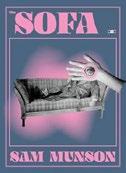
Sometimes it doesn’t take much to drive a person completely over the edge. Somewhere along the way, Munson’s trade has evolved from teenage angst to middle-aged angst. More specifically, there’s no good way to know how the author of The War Against the Assholes (2015), etc., has plummeted from his previous work— reasonably mainstream, often funny social satire—into this full-on existential crisis drama in search of a plot. Every stylistic tic of this work, from its vague, menacing plot to its slow creep into surrealism, will ring a bunch of bells for English majors and discerning horror readers but it’s a tough pill to swallow. Mr. Montessori is a well-meaning paper-pusher for an investment company who struggles to please his shrill wife and two growing boys. The family returns one night to find their titular furniture has been
replaced with a poor substitute—a smelly, damp, greasy mess of a striped sofa, labeled only with a single word: “MEERVERMESSER.” The inciting incident might seem mundane but this one little change sends Mr. Montessori right off the deep end. Unable to rid himself of the cursed lounge furniture, he quickly finds mind and body unraveling as well. His neighbor, Señor Periander, disappears under mysterious circumstances. His cat is butchered by another creature. Visions of a strange fat man and the man’s hat—a bowler straight out of A Clockwork Orange, no less—begin appearing to Montessori, worsening his condition, along with a serious infection that clouds his mind. It’s suitably dark and creepy, but there’s just not enough here to hang a story on. The younger son is so superfluous he’s not even named, while the wife is a judgmental placeholder at best. There’s something to be said for a good descent into madness, but this house isn’t haunted enough to leave an impression, let alone a scar.
An unkempt, scare-free portrait of a guy losing his mind in his couch cushions.
Kirkus Star
Nolan, Delaney | Astra House (304 pp.) $26 | October 14, 2025 | 9781662603280
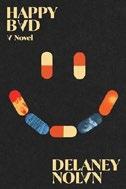
A treatment center’s planned relocation is upended by the effects of climate change.
The first words from Beatrice, the narrator of Nolan’s debut novel, are, “I lived in a box in the desert.” But it wasn’t always a desert; climate change has permanently altered the landscape of the northeast Texas town of Askewn, where Beatrice works as a coordinator at Twin Bridge Residential Treatment Center. The facility, “home for the traumatized/neglected/abused/criminal, oblivion addicts as a rule,” houses teenage girls. It’s run by a social services
company that has partnered with a pharmaceutical outfit, which plies the girls with BeZen, a drug that seems to be effective at treating their mental illnesses. Beatrice and her co-workers are planning to move the home to Atlanta if her report on the girls’ reaction to BeZen is approved, but two things get in the way: bureaucracy, of course, but also a heatwave that sparks a power grid failure that throws much of the state into anarchy. Ordered to evacuate, Beatrice, a few of her co-workers, and seven of the girls decide to head to Georgia anyway, where there may or may not be a place for them. Things get bad, and then they get worse when the BeZen runs out. Beatrice, whose memories of her own unhappy childhood are seamlessly integrated into the narrative, proves to be a memorable character, as does Teresa, the oldest girl in the center, whose battle with her demons Nolan portrays beautifully. While the subject matter is as serious as can be, Nolan leavens the novel with gallows humor: At one point in their journey, Beatrice’s search terms include “how smuggle best child drug withdrawal” and “mississippi how easy swim dead drowned missing die.” The darkness of this excellent novel is amplified by how terrifyingly plausible it all is.
A self-assured debut that is also a warning.
Pacheco Medrano, Karina | Trans. by Mara Faye Lethem | Graywolf (240 pp.) | $17 paper | November 4, 2025 | 9781644453650

A Peruvian woman seeks a cousin lost to the siren call of political violence. In her intriguing first book to be translated into English, Peruvian novelist Pacheco Medrano explores “what there [is] to be learned from [the] abyss.” Her story centers on the intimacy and horror generated by Shining Path rebels and Peruvian
government soldiers who slaughtered residents in spasms of dueling atrocities. The author, an anthropologist, makes certain to give the official count: 69,280 people killed and disappeared from 1980 to 2000. But this ambitious, intelligent novel casts its spell narrowly, through a trio of women: the charismatic and reckless Bárbara Varas; her grandmother, Bernarda, a widowed shepherd tucked high into the Andes; and the narrator, Nina, Bárbara’s younger cousin. Forty years after Bárbara disappears, a middle-aged Nina spots her cousin’s doppelgänger in Madrid. The shock propels Nina back to the Andes, where she and Bárbara sang Beatles songs, smirked at Garfield the Cat, trekked up granite peaks, and milked cows. Nina plunges back into their shared history and the conundrum of communities who both know and don’t know what befell them. The first murder—of Bernarda’s 28-year-old husband—arrives quickly, and at first feels apart from the forces that later ensnare his widow and granddaughter. As Nina hunts the truth, she travels folkways, carefully collects the testimony of neighbors, and, yes, dives into human rights archives, giving the book a whiff of autofiction. She also traces her nightmares and dreamscapes in a story that shape-shifts time. The prose is occasionally awkward, the doubling-back can be confusing. But as the current political violence—in Sudan, Haiti, Gaza—and its creeping assertion in North America both attest, people will “ask what we’ve done to deserve this.” Then, chillingly, “the news in our country was horrific, but we got used to it.”
A timely callback to Peruvian political bloodletting that blurs the line between victims and perpetrators.

The Canadian poet and story writer takes up space with her first novel.
BY BETHANNE PATRICK
THE TITLE OF Souvankham Thammavongsa’s new novel, Pick a Color, refers to the phrase recited daily by nail technicians across North America—many of them women from Asia who might love or hate their jobs but are often ignored by their clients. Thammavongsa, whose Laotian family emigrated from a refugee camp in Thailand to Canada when she was still a baby, has never worked at a salon. But she did spend a year learning how to box in order to better understand her protagonist, Ning, whose years in the ring influence her slightly aggressive solitude as a salon manager—not to mention her dry wit, pragmatism, and keen eye for detail. Although the author had already published four poetry books, it was her 2020 Giller Prize–winning story collection, How To Pronounce Knife, that brought her to the attention of U.S. readers. Pick a Color, which received a starred review from Kirkus, promises to multiply that attention. Thammavongsa, 47, recently spoke to Kirkus via Zoom from her home in Toronto; our conversation has been edited for length and clarity.


couldn’t do that because it wasn’t how the story was written. I was more interested in writing the stories than in reciting someone else’s words. I wanted to control the narrative.
Do you think there’s an attention gap for Canadian literature in the United States?
Yes, but for younger Canadian writers there’s also the challenge of established authors who dominate the literary arena. I’m thinking of Margaret Atwood and Michael Ondaatje, for example. They deserve their attention, but it’s tough to break through. I don’t seek to align myself with a specific genre or a specific narrative, such as
“first-generation writer.” I went to university, but I don’t have an MFA. Instead, I have influences: Carson McCullers, James Baldwin, Flannery O’Connor, Edward P. Jones.
Those authors maintain exquisite control over their prose. Is that important for you and your work, too? When I was very young, I wanted to be an actor, but on an audition for a production of “Little Red Riding Hood,” I decided to bite the Wolf. The director told me I
I don’t read the Lao language, but I speak it. I have the vocabulary of a 3-year-old and that allows me to understand the Lao sense of humor, especially among women. I think that is a very Lao attitude to turn everything, even painful things, into something to be laughed about. When you can make the thing that makes other people laugh, you’re in charge.
It might surprise some readers that, despite the characters’ hard work and sometimes-spare lives, the novel is filled with humor. It was a challenge to construct a novel that integrates multiple
universes, like the salon and the boxing gym, while making the language appear natural and effortless. I wanted to challenge stereotypes and portray salon workers as having pride and agency. When the women at Ning’s franchise talk in their own language, they’re often very funny. But their humor also shows the issues they face, including racism. I think literary fiction has great power to make readers care about previously overlooked aspects of life.
Pick a Color isn’t built on plot but on a voice that you follow, and that’s a real challenge for a writer, to locate the power of a novel in voice, to lean not on what happens but on what you hear. In the novel, we can’t hear the clients, but we can hear Ning and she transmits their words. We
can hear the sound of a nail salon filled with people, but we can also hear the shift when it becomes a private conversation between salon worker and client.
Ning, who manages the salon, also lives alone in a small apartment right above it. Is her solitude a difficult thing for her to bear, or not?
Loneliness isn’t the same as solitude. Ning is a content, independent woman in her 40s. That challenges societal expectations of women’s happiness being tied to relationships or companionship. Even the other nail salon workers don’t really understand why Ning is so solitary and content. It’s not that she doesn’t know love. She knows the act of devotion. She’s devoted to her job. She has a purpose, and people who love have that.
The novel takes place over the span of one day. There’s only so much you can know about a person in a single day. You have some sense that something has happened to Ning, that something has made her solitary, but to reveal what that is would, I think, betray the form. It creates a lot of questions for the reader, but I love that—unlike a long novel of 400 or 700 pages that answers all those questions, [but] then we close it and never think of it again. A novel of 200 pages like this will, I hope, have readers wondering more about Ning.
Ning is single. Did your own recent divorce contribute to her experience?
I don’t like to provide too many details about my
personal life that might affect a novel’s magic, but many people know that I recently published a [New York Times] “Modern Love” essay called “Divorce Is a Gift” about ending my 12-year marriage. The reactions to the piece were mixed, with many women relating to it and many men finding it controversial.
A lot of people think if you just offer somebody
love that that is enough. There was love in my marriage, but it was not enough. To watch a woman say that and to do what she wants is not something we’re used to seeing. Women are often there to serve as mothers or wives, which are lovely things to be. But when you don’t have that role, people don’t know what to do with you. And in fact, you are
I wanted to challenge stereotypes and portray salon workers as having pride and agency.

Pick a Color
Thammavongsa, Souvankham
Little, Brown | 208 pp. | $28 September 30, 2025 | 9780316422147
put in a position to explain why you don’t want that. What is wrong with you?
The way in which we write about immigrants and refugees is very narrow. But, also, I think the way we write about women is also very narrowing.
Since you’re now single and you don’t have children, what challenges do you have in your independent life as a writer?
Much of my life has involved working at paying jobs, including preparing taxes and doing research for a publisher of investment advice. Now I’m able to write full time, and I view those previous jobs as writer residencies, because they allowed me to pay my bills and then write during my free time. But having agency over my own work schedule and decisions is important. I’m grateful for the opportunity to do what I love, and I appreciate the achievements of my fellow writers, too. That said, publishing is a precarious business. Publishing a debut short story collection during the pandemic was a risk. I want to emphasize the support of publishers and readers who embraced my work anyway.
Before I wrote a novel, I didn’t know how to take up space. Before I wrote a novel, I’d written four poetry books and a short story collection. I’m very comfortable saying a lot with very little. But you can’t do that with a novel. You have to actually take up space
Bethanne Patrick is the author of Life B and host of the Missing Pages podcast.

The thriller writer published his final novel, Southern Man, last year.
Greg Iles, the author known for his mystery and thriller novels set in the Deep South, has died at 65, the Associated Press reports.
Iles was born in Stuttgart, Germany, raised in Natchez, Mississippi, and educated at the University of Missi ssippi. He sang and played guitar in the band Frankly Scarlet before making his literary debut in 1993 with Spandau Phoenix , a thriller about Rudolf Hess, the Nazi war criminal.
In 1999, he published The Quiet Game, which introduced readers to Penn Cage, a former prosecutor turned bestselling novelist. Cage would return in Iles’ Natchez Burning trilogy, which kicked off in 2014 with Natchez Burning and continued with The


Bone Tree and Mississippi Blood
Iles brought Cage back in his final novel, Southern Man, published last year by Morrow/ HarperCollins. In a starred review, a critic for Kirkus called the novel “a perfectly done political thriller with genuine resonance.”
Iles struggled with his health for years. He was diagnosed with blood cancer in 1996, and in 2011 he was severely injured in a car crash that led to the amputation of part of one leg. He reflected on his battle with cancer on his website, writing, “One thing this experience has taught me is that there is nothing unique about my situation.…My last thought for today is that only two things matter: family and friends.”
—MICHAEL SCHAUB


For reviews of Greg Iles’ books, visit Kirkus online.

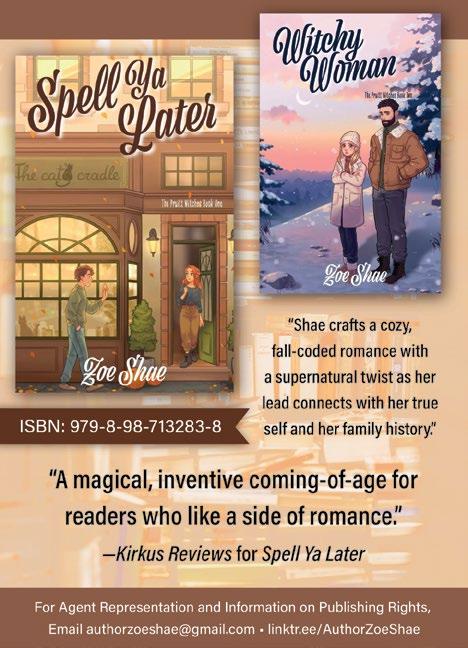

More than half the award’s longlisted authors withdrew to protest John Boyne’s inclusion.
This year’s Polari Prize has been canceled following a controversy over longlisted Irish novelist John Boyne, the Guardian reports. Boyne was longlisted for the Polari Book Prize, one of the two Polari awards, for his novella Earth, which is collected in the forthcoming book The Elements. His nomination was condemned by many in the LGBTQ+ community who object to his views on transgender people. Boyne has described himself as a “TERF,” a term for people who do not believe that transgender women are women.
After news of his nomination broke, more than half the authors longlisted for the awards, along with two judges, withdrew from the prize in protest. Boyne responded to the withdrawals on the

For a review of The Elements, visit Kirkus online.

social platform X, suggesting that the controversy had harmed his mental health and asking that the writers who withdrew to reconsider. If they did, he said, he would ask that Earth not be considered for the prize. On X, the prize organizers wrote, “We have decided…to pause the prize this year while we increase representation of trans and gender- nonconforming judges on the panels for all the awards and undertake a governance and management review to include our aims and values and work to better support everyone within our LGBTQ+ Polari community.…We extend our heartfelt apologies to everyone affected this year, for the disappointment and despair this has caused.”—M.S.

Kirkus Star
Pearce, Barry | Cornerstone Press (258 pp.) | $25.95 paper | November 1, 2025 9781968148119

Voices from all over the map of the city’s neighborhoods combine for a chorus that is singularly Chicago’s.
This debut story collection lifts its title from a 1909 manifesto co-authored by urban designer Daniel H. Burnham, which also provides the epigram invoking the city’s motto: “Urbs in Horto —a city set in a garden.” More than a century later, that garden is no Eden. There are way more cracks than flowers: cracks in the foundation; psychological cracks in the narrators and characters, whose vernacular provides the style of these stories. Cracks in their relationships, their marriages, their families. Yet there is also great resilience, through the survival skills necessary in a city that plays rough. In “Enumerator,” the opening and longest story, Margaret Cieslak-Jablonski, a Polish immigrant, loses her American husband and gains a job as a census taker. She lives on a block so undistinguished that it isn’t considered part of any of the northwest neighborhoods around it: “No one wanted to claim that swath of poor transients, weedy lots, and industrial waste.” Her temp job has her tracking and counting those who are ever farther off the grid. And she’s very good at it, learning the stories of those who had otherwise evaded scrutiny and gaining entry where she isn’t legally permitted. “Out of Egypt” follows, with a teenage boy named Izzy Bramaciu apparently unconscious in the hospital, from a car accident arranged by his scamming father for insurance fraud. Then “Chez Whatever,” where very white Lincoln Park finds a Black girl increasingly frustrated and resentful in a Valentine’s Day blizzard, following a fight with her
more privileged white girlfriend. “Dibs” explores the Chicago tradition of saving winter parking places amid the gentrification of a frequently changing Humboldt Park. The progression of the stories connects neighborhoods, with protagonists in one story becoming bit players in another.
With deep empathy and granular detail, these stories take the measure of a city on the make.
Rogers, Ben | Univ. of Nevada (240 pp.) | $29.95 | November 4, 2025 9781647792015
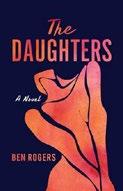
An aging writer in love with his neighbor traces the stories of her family back for decades.
Peter “Z” Zemeckis won the National Book Award back in 1997, but when readers meet him in 2012, he has eased his way into retirement and irrelevance. He’s about to fulfill the purpose of the little blue pill he swallowed earlier in the night when his date is interrupted by his neighbor and “unrequited love,” Nancy Chu, who asks to borrow his car to rescue her daughter, Charlotte, from a bad situation at a bar. Fascinated with tracing the history of Nancy’s family, Z rewinds to 1977 and the story of Amy, a teenage barrel-racing champion in Amarillo, Texas, whose pregnancy scare forces her to re-evaluate her priorities. “A baby fell out of thin air and she had to let go of everything to make sure she could catch it. Maybe she didn’t want to pick all that stuff back up.” Then it’s off to 1986 and Chinese immigrant Zhiyu, who painstakingly cooks a duck in preparation for dinner with his daughter, our Nancy, and her new boyfriend, Eric. In 2001, Eric and Nancy divorce and Nancy chooses her high-powered career at IBM, leaving Eric, a physics professor, to raise their 12-year-old daughter, Charlotte, alone (that is, if you don’t count the
occasional help from his new girlfriend, Amy). Rogers crafts a richly textured vision of everyday life as he explores the ways the bonds of family stretch and collapse over generations. His characters struggle with questions about what it means to be a spouse, a parent, a daughter. In one of several physics metaphors, Z explains that “radioactive atoms also have ‘daughters.’ Parent atoms expend their energy in waves until eventually decaying into different elements altogether.…Why? Because. Just the way of the universe. But ask any father, and he’ll probably tell you: that’s just fine with him.” Rogers is at his best in the details, grounding characters with tidbits like Amy naming her horse Patton “after the American general. Not the actual general. The one from the movie.” The prose, funneled through Z’s narration, never drags; the bungalow where Eric and Charlotte live post-divorce is described as having “the aspect of a man who isn’t growing a beard so much as not shaving.”
An authentic and poignant depiction of the complex, contradictory relationships among family members.
Chronicles
Rosales, Harmonia | Norton (304 pp.) $39.99 | October 14, 2025 | 9781324111115
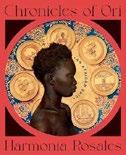
A reimagining of Yoruba mythology and folklore, vividly illustrated. An acclaimed Afro-Cuban American painter, Rosales specializes in using the stylistic tropes of European artists to depict Black- and African-oriented subject matter. So this “personal retelling of West African myths” is a powerful extension of that body of work. Opening with creation stories and closing with the launch of the slave trade, Rosales fills chapters with stories about gods, spirits, Orishas, and mortals, often focused on climactic battles and
transformative moments. Some elements of the narrative resonate with Judeo-Christian stories, like a garden called Edin, or Oah, a mortal who preserves humanity after a torrential flood; others are rooted fully in Yoruba lore, such as the supreme being Olodumare, the god of creation, and the concept of ashé, a divine force. The cast of characters is massive and complex, which makes the storytelling sometimes feel overly dense. But the paintings that accompany Rosales’ words are clear and stunning. A painting of Mama Onile, the Earth’s female spirit, evokes Orthodox iconography and Michaelangelo. Oah’s battle against the coming flood is evoked in an epic seascape; another spread featuring Bida, a seven-headed snake encompassing humans’ multiple sins, is an exquisite rendering of Boschian horror. Centering Black bodies in each of these works alters not only the composition of mythological tropes but also their meanings; Rosales wants to spotlight Yoruba lore and cosmology that’s often neglected by Western definitions of mythology. “I do not claim that my retelling of these myths is definitive or authoritative. It is simply mine,” she writes in a closing note. But her sensitive touch with words and gifted imagery should make this a sourcebook for retellings to come.
A lavish, eye-catching rethinking of ages-old stories.

Rothery, Lauren | Ecco/HarperCollins (256 pp.) | $28 | December 2, 2025
9780063443327

An aging actor, his best friend, and some others navigate fame and frustration in Hollywood. Verity’s current project is the fifth installment of a commercial blockbuster movie franchise in which he plays “green old void Bly.” His closest confidant is 40-something scriptwriter and editor Helen; the two met in a diner days after Verity moved to Los Angeles and have spent decades intertwined, having sex sometimes and often living together. Verity is a heavy drinker, vain, obsessed with beauty, and beautiful himself—“with that face he would have gotten famous if he couldn’t act his way out of a shoe,” as Helen puts it. Verity gets the idea to lottery off his salary and his percentage of box office sales from his newest movie to someone who’s bought a ticket. The decision comes on the heels of an eyebrow-raising GQ profile, and the winner is announced on the TikTok account of “hitherto unknown” actress Nina Walker, who’s admittedly too young for Verity but with whom he shacks up anyway. These actions scandalize his professional colleagues but don’t surprise Helen. The first-person narration alternates between Verity and Helen until readers are introduced to Phoebe, a young aspiring scriptwriter looking for ways to find support for her fledgling career. The full extent of Phoebe’s connection to Helen and Verity isn’t revealed until quite late in the book. The meandering prose and
ruminations on fame and the industry certainly have touches of Joan Didion, who’s explicitly mentioned twice, while Verity’s anachronisms (he refers to cellphones as “rectangles”) and dismal attitude frequently feel Holden Caulfield– esque. An example: Thinking about the relationship between older men and beautiful women, he remarks, “I felt pretty depressed. I really did. I was all over the place.” Though readers may find the winding plot a little thin, Rothery’s prose is frequently a knockout, and her sense of literary style is enjoyable.
A slick and largely entertaining debut about the entertainment world.
Rowley, Steven | Putnam (80 pp.) | $20 October 14, 2025 | 9798217047604

A man finds solace in Venice after a breakup in this novella. Shortly before the trip they planned to take together for the holidays, Paul’s husband breaks up with him and moves out. Paul decides to go anyway. While in Venice, Italy, he must face his anxieties about dining alone, not knowing the language, and working the espresso machine in his rental loft. He does seem comfortable shopping, attending museums, and finding his way around the city, but his shame over the dining issue—and his ex’s accusations of his neediness—haunt him. A particular insouciant street dog catches his eye and provides inspiration, and Paul spends much of the book watching out for the dog, hoping for another encounter. Will he find the dog and learn from him how to be independent? Rowley’s glib tone has worked before in his hits The Guncle (2021) and The Guncle Abroad (2024), and he is capable of real pathos, as seen in The Celebrants (2023). It serves him less well here; if Paul is grieving the loss of his marriage, it mostly happens off the
page, and what is on the page feels more told than lived in. Most of his problems are solved by the end of this brief novella, so the book is more successful at being a holiday romp than a journey with emotional stakes. There are a few solid jokes, though, and lots of ambience.
Like the steamed milk Paul accidentally orders instead of espresso—frothy but disappointing.
Stefánsson, Jón Kalman | Trans. by Philip Roughton | Biblioasis (336 pp.) | $17.95 paper | November 4, 2025 | 9781771966801

Delivering mail to remote Icelandic farms becomes a struggle for survival against the crushing forces of nature. Three weeks have passed since the tragic incidents in Heaven and Hell , the first installment in Stefánsson’s Trilogy About the Boy. Now, in the second, the eponymous main character, who had planned to kill himself in despair after the accidental death of his friend, is finding a reason to live again in his village in northwestern Iceland. The unnamed, orphaned boy has found a new family with Geirþrúður, an older woman whose independence unsettles the village’s male leadership, and with the strays she’s welcomed into her stately home. Geirþrúður detects a sensitivity in him that’s unlike the men around her; she plans to give him a good education and help him make his way in the world. But first the boy is enlisted to help the postman Jens in the perilous task of delivering mail to remote farms in the frostbitten north. The pair find themselves trudging across wind-blasted heaths and mountains with zero visibility in the falling snow (“the sorrow of angels”). Each carries internal conflicts with him: Jens is afraid to admit his love for Salvör, a farmer’s maid with an unhappy romantic past; the boy feels
On the day of a prisoner’s release, a woman sets out to settle a score.
THE SUNSHINE MAN
sadness for his dead friend and attraction to a flirtatious shopgirl who’s leaving the village soon. Nature’s humbling power, Stefánsson suggests, gives sharpened clarity to those with troubled hearts. But the monotony of the pair’s endless trek is reflected in the excessively long account of their journey, which ends frustratingly with a literal and figurative cliffhanger that dangles many questions. Will the boy’s love of literature blossom into a writer’s career? Will he find happiness? Meaning? Love? Readers must look ahead to the final book for answers. “Some books are essential, others diversions,” the boy thinks to himself. This book belongs in the former category.
The Sunshine Man
Stonex, Emma | Viking (320 pp.) | $30 November 11, 2025 | 9781984882189

On the day of a prisoner’s release, a woman sets out to settle an old score.
“The week I shot a man clean through the head began like any other.” With that opening sentence, Stonex plunges us into the mind and world of Bridget “Birdie” Keller, a wife and mother in the rural countryside of Wiltshire, England. But Birdie’s world is not quite so tranquil: 18 years earlier, a man was incarcerated for killing Birdie’s half sister, Providence, and this is the day of his release, a day that Birdie has prepared for. Just as Birdie’s voice settles in comfortably, a
second narrator emerges. James Maguire is the man convicted of killing Providence, and his voice and story prove to be just as immersive as Birdie’s. Shaped by Stonex’s skillful hands, a compelling picture emerges spanning the decades from 1947 to 1989. In a small Devon village where everyone knows everyone else’s business, the lives of several kids are ineluctably entwined. Some of their interconnections are due to Birdie’s kind, caring grandmother. Gamma raised Birdie and Providence after their mother abandoned them, and she welcomed James into her home at a critical time. Though the makeshift family initially works well, miscommunication and outright lies quickly set in. Stonex’s success doesn’t lie solely in the creation of two riveting narrators. She weaves evocative imagery throughout the text, from a piece of knitting “messy as a jellyfish” to a carpet stain shaped like the Isle of Wight and the titular Sunshine Man, a wooden scarecrow doubling as an ad for Yellowfields Seed Oil. This thriller demonstrates on nearly every page the power of the written word.
Surya, Eshani | Roxane Gay Books/ Grove (320 pp.) | $28 | November 11, 2025 9780802164681
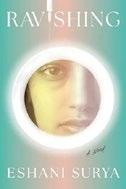
A South Jersey teen and her brother have their lives changed by a wellness product that alters users’ faces. Seventeen-yearold Kashmira Mehta can’t stand her face. Not that she’s ugly; it’s just
that she looks far too much like her father, Vinod. Not only has Vinod abandoned the family—there’s herself; her older brother, Nikhil; and their mother, Ami—but he was a tyrant, so obsessed with assimilating into American culture that he refused to allow his children to learn about their Indian heritage. Kashmira was even forbidden from spending time with her best friend, Roshni, who merely wanted Kashmira to attend her kathak dance classes. But now there’s a new product on the market from a company called Evolvoir that uses nanoparticles to rearrange facial features, and Kashmira hopes it’s her answer to no longer seeing her father’s face every time she looks in a mirror. Moreover, Nikhil is an Evolvoir employee in charge of spearheading the company’s move into more aggressive uses of the face-changing technology. His goal is idealistic: He wants to get his product into the hands of “everyone who need[s] it,” especially “BIPOC clients, many of whom he is aware have less access to competent mental health services.” But as Kashmira begins using the cream and starts suffering dire physical consequences, and as Nikhil struggles to control the trajectory of the company, they must both reexamine the ethical implications of their choices. Though Surya can be heavy-handed in her messaging and heavy-footed in her prose, this debut is thoughtful in its handling of tricky themes of identity, belonging, and, perhaps most compellingly, the intersection of wellness culture and chronic illness. Surya handles this latter with unflinching—even discomfiting—clarity.
A speculative take on the all-too-real rot at the heart of the beauty and wellness industry.

Tagle-Dokus, Allie | Tin House (368 pp.) | $17.99 paper November 11, 2025 | 9781963108620

A rollicking ride of a debut novel about the weird world of teenage stardom. Eleven-year-old Lucy loves to dance, and she’s determined to win a spot at the Dance Awards, a national competition, even if it means ditching her best friend, threatening to kill herself if she can’t attend an expensive competition in California, and plotting to blackmail her older brother to get him to help her hire a choreographer. Winning nationals is just the beginning: Lucy winds up on Dance Till You Drop, Juniors!!, a fictionalized version of Dance Moms, a Lifetime reality-TV show. “I just want to dance,” Lucy repeats, often as an excuse when her ambition wins out over her friendships with the other young dancers she meets in the hothouse-flower environment of reality TV. Throughout, Tagle-Dokus offers a lively critique of the manufactured melodrama of reality shows. “There is reality TV, and then there is the reality behind the reality TV,” Lucy explains, “and that’s why people watch, poised for the moment the visage slips. Reality tastes better after diet reality.” Split pages—where Tagle-Dokus offers the “Diet Reality” version of scenes alongside the dance mothers backstabbing each other in the “Confession Booth” are followed by “Reality” sections, where Lucy tries to make sense of this warped world. When Bruise, a mega–pop star and one of the
judges, takes a liking to Lucy, Lucy heads out to LA to become Bruise’s muse and the oversexualized star of Bruise’s music videos. Tagle-Dokus’ depiction of Hollywood is both hilarious and horrifying, with adults behaving like spoiled children and children willingly giving up their innocence because they don’t know any better. Despite her many mistakes, Lucy is a likable narrator, and the novel’s many memorable characters— who aren’t so dissimilar from the cast of a reality show—all have their own fascinating stories.
A novel as binge-worthy as reality TV.
Taylor, Elena | Severn House (288 pp.)
$29.99 | November 4, 2025 | 9781448317370

A woman who’s hit rock bottom tries desperately to reclaim her life. Emily Grace Turner was a very good carpenter until her daughter’s death from cancer left her shattered and buried in bills. Now she has a chance for a new start. Her mentor has broken his leg and recommended her to finish the project he started only a week ago on Salish Island. On the ferry ride from the coast of Oregon, the first sign of her return to life may be her observation that first mate Adrian Han is very attractive. Although the Salish locals are friendly, she soon learns that her client Cameron Lang’s stunning home, End of the World, is built on land reputed to be haunted by the
A rollicking ride of a debut novel about the weird world of teenage stardom.
LUCKY GIRL
nuns and monks who used to live there. The house, perched on Monk’s Rock at the island’s north end, was designed by Lang’s architect wife, Katrina, who vanished while out sailing. All goes well until Lang’s estranged daughter from a short-lived early marriage arrives. At first, Chloe Hawker, who’s badly scarred from an accident, appears odd but nice. But she quickly turns manipulative and tries to make trouble between Emily and her father. It becomes apparent that Cameron and Adrian dislike each other because each thinks the other murdered Katrina. Emily hears mysterious noises and even sees damp footprints. She develops a friendship with psychic artist Juniper Lancaster, who helps calm her when things get strange at the house. It’s not her imagination running wild, she learns, when she makes a shocking discovery and realizes that it’s not ghosts but humans who are haunting the house with nefarious plans she must uncover to save her future.
An eerie, convoluted mystery whose well-defined characters lead the way to plenty of surprises.
Tracy, P.J. | Crooked Lane (288 pp.) | $29.99 September 9, 2025 | 9781639108770

The 11th outing for the Monkeewrench gang and its associates is, as Tracy says, “more a continuation than a sequel” to their 10th, Ice Cold Heart (2019).
Det. Leo Magozzi’s last day on the job with Minneapolis PD Homicide kicks off with news of two prison escapes 4,000 miles apart. A timely explosion helps Goran Stanković, who insists that he’s not a war criminal, escape his confinement in The Hague, and a hack of the security system frees Wolfgang Mauer, who’d hastened Magozzi’s retirement by shooting him, from the Gustavus Adolphus Security Hospital. Mauer kills a passerby for his clothing, identification, and vehicle; Stanković, seeking $20 million in bitcoin he thinks Mauer stole from him, makes a beeline for Minnesota. Since Mauer’s known to have a hit list of the Eight that presumably includes all the co-founders of Monkeewrench Software—cowboy Harley Davidson; programmer Annie Belinsky; funky Roadrunner; and Grace MacBride, Magozzi’s baby mama and longtime domestic partner—they swiftly act to turn themselves into moving targets whose best defense is an unstoppable offense. Suspense is limited by the fact that the good guys, from Monkeewrench to the Minnesota Bureau of Criminal Apprehension, are so numerous, well-informed, and well-equipped, and the bad guys so unremittingly hostile to each other. But Mauer’s kidnapping of Travis Dunbar, an abused 10-year-old he somehow bonds with, supplies a wild card that complicates his every encounter, and fans of the crew will welcome their return and root for Magozzi to survive his last day and make the right decision when it’s over. Welcome back, Monkeewrench. Long may you wave.
A wild tale of a newbie bounty hunter who goes from bad to worse.
Tromblay, David | Dzanc (256 pp.) $17.95 paper | November 11, 2025 9781938603389

A cast of grotesques populates this wild tale of a newbie bounty hunter who goes from bad to worse.
“Daytime is the wrong time to go ferreting out folks like the Drumgooles….You’ve got to go after them nonchalantly. Go with the element of surprise.” That advice is directed to Moses Kincaid, a former military policeman who figures bounty hunting will be a good fit for his skillset. It should be a fairly straightforward job to find bail jumper Eric Drumgoole Jr., who’s on the lam after mowing down two members of the Filthy Thirteen motorcycle gang, but this bunch of “Odin-worshipping white supremacist bikers” give Moe no end of trouble. He has a bad run-in with them that would have been much worse if he didn’t have Elise, a waitress with a heart of gold, to nurse him back to health. Drumgoole is one of several jumpers Moe pursues across these pages in the aftermath of the Oklahoma City bombing. Tromblay captures the antics and characters of trailer park denizens, sadists, dwarf wrestlers on angel dust, venomous snakes, wandering buffalo, roller derby girls, and other denizens of America’s dusty margins. He also spotlights the racism that dogs Moe, who is Native American, at every turn. A sudden tragedy causes his trajectory to change, everything goes sideways when a jumper dies in his custody, and Moe lands in Big Mac, the toughest penitentiary in Oklahoma. He has a chance to get his freedom back, however, if he can find out who is involved with trafficking an extremely lethal drug. Tromblay doles out violence in Tarantino-sized portions—“all crash and no brakes,” as Moe would say. Considering how much bad stuff happens to him, Moe is perhaps too unfazed. He’s not deep or complex; he just goes from one disaster
THE PELICAN CHILD
to the next. His story is light on reflection and heavy on the action. Best for readers who love a plot-driven tale; anyone wanting more depth should look elsewhere.
van de Sandt, Viola | Little, Brown (304 pp.) $29 | November 4, 2025 | 9780316593847

In this debut novel, a young Dutch woman slowly comes to grips with the events surrounding a London dinner party that ended badly, as well as earlier emotional crises that have shaped her. Van de Sandt sets most of the action in Utrecht and London although Franca narrates her story from Berlin, where her ever-patient therapist, Stella, helps her remember both the party and previous traumas in fractured recollections. Taking the form of a letter Stella suggested Franca write, Franca’s narrative drifts among various unresolved issues: Franca’s unclear memory of what she did or didn’t do with a knife after the party; her problematic relationship with her boyfriend, British tech entrepreneur Andrew, especially an interaction while she was preparing dinner that may or may not have been sexual assault; Franca’s wealthy father’s death when she was 12 and her mother’s apparent detachment; Franca’s intense platonic friendship with fellow comparative literature student Harry that ended badly shortly before Harry left Utrecht for Cambridge. While readers may find themselves analyzing Franca through the fuzzy but evocative memories of her
unhappy if privileged life, the book ultimately feels less like a psychological case study than an argument proposing that woman are always victimized by badly behaving men. Franca points toward statistics showing that sexual assault by men is the norm, and van de Sandt’s straight male characters—even those, like Franca’s father, displaying good intentions—have negative effects on the women who love them. Women lovers are much kinder to each other. The one gay man, Gerald, is merely pathetic. Hard on Gerald’s literary pretensions, van de Sandt is not shy about flashing Franca’s intellectual credentials or quoting highbrows like Martha Nussbaum. Despite the author’s elegant, sometimes insightful prose, Franca’s never-ending victimhood and the constant hints about revelations to come become tiresome. The novel’s saving bright spot is Franca’s mother, a complex and affecting surprise. Though there’s lots of talk about feelings, van de Sandt has written a polemic on sexual politics disguised as a novel.
The Pelican Child
Williams, Joy | Knopf (176 pp.) | $27 November 18, 2025 | 9780525657583

Enigmatic, elegant stories by a writer at the pinnacle of her art. Williams has long worked magic with stories that, on the surface, seem quite quotidian, save that something
unspoken—and occasionally sinister—lies beneath. The interactions of a woman and her driver in the opening story, “Flour,” are a case in point: She is well-off, but she invents an excuse to get rid of an expected weekend guest so that she can escape her daily life. The driver “spends the nights searching for the missing word in some Coptic riddle,” the woman tells us. That missing word figures in a folktale—Williams being a devotee of the genre—that echoes in the odd events that follow, ending at a destination that, the woman says, “struck me then as being utterly foreign.” In another story, a man is told he has cancer, then that he’s been confused for another patient but still has cancer. He tells his mother, “According to the doctor, I’m dying,” to which she replies, “Oh, well.” A talking dog tells an assistant at a writers’ retreat, “The river of indifference flows through the country of forgetfulness.” The mystical charlatan George Gurdjieff drifts down to Tucson, Arizona, to visit the childhood home of Susan Sontag, whom he adores; never mind that the chronology doesn’t line up. An ethereal child, perhaps a ghost, tells a woman, “Imagination only fails us in the end, when the stories we tell ourselves have to stop.” All the stories here are lovely, and so skillfully written that disbelief is suspended forthwith. But the pièce de résistance is “Baba Iaga & The Pelican Child,” where the Slavic folkloric figure meets the murderous naturalist John James Audubon, much to the detriment of her pelican daughter, a searing fable of the destruction of nature and the ease with which humans do harm. Superb, and yet more evidence that Williams should be next in line for the Nobel Prize in Literature.





By Hiro Arikawa; trans.
by
Allison Markin Powell
gentle intertwining of small vignettes that evoke smiles in the characters—and the reader.
By Robert Seethaler
By Grace Flahive
By Moira Macdonald
By Adriana Trigiani





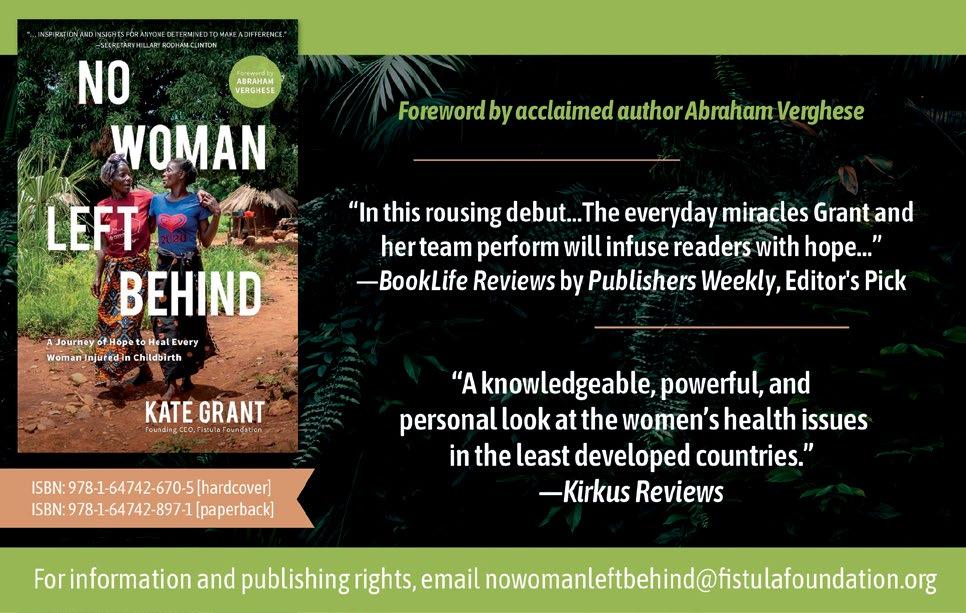

R.F. Kuang’s new darkacademia novel will be adapted by Angela Kang.
R.F. Kuang’s Katabasis is headed to the small screen, Variety reports.
Kuang’s novel, published in August by Harper Voyager, follows Alice Law, a student of magic at the University of Cambridge, who travels to hell to find her late professor, Jacob Grimes. In a starred review, a critic for Kirkus called the book “a learned, literary manifesto on academia—and its darkness.”
In an interview with Kirkus, Kuang reflected on academic life, saying, “Academia is founded on delusions.… I’m fascinated by how many people still go through these programs and cling to this vanishing, irrational belief that this is still the best possible way that they could be spending their lives.”
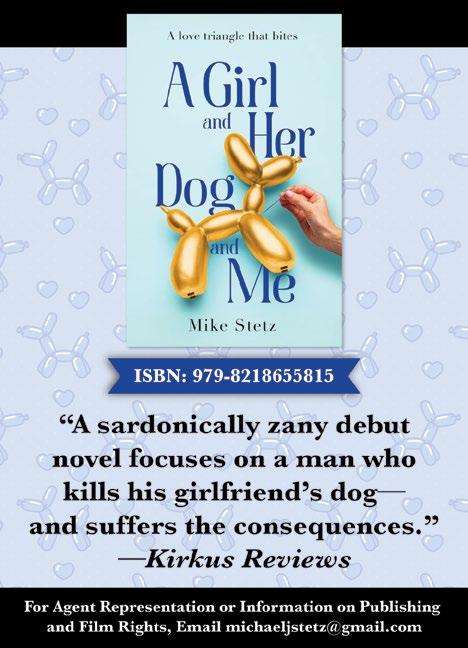
The adaptation of Katabasis is being developed by Amazon MGM Studios. Angela Kang, known for her work on The Walking Dead, will serve as writer and showrunner. Kang and Kuang are among the series’ executive producers.
Kuang’s 2023 novel Yellowface is being developed as a television series with Karyn Kusama on board to direct, and Babel, her dark-academia novel from 2022, has been optioned for an adaptation as well.

Showrunner Kang shared news of the adaptation on Instagram, writing, “@kuangrf’s new novel is incredible and it’s so much fun delving into this world. If you love magic, myths about the underworld, romance, smart themes and witty prose, this is a story for you.”—M.S.


Andrews, Donna | Minotaur (304 pp.)
$28 | October 14, 2025 | 9781250407306

Meg Langslow’s 38th recorded case harks back to her very first, in which she served as a bridesmaid in a cluster of three weddings, by challenging her ability to cope with two competing Bridezillas. Despite being frequently mistaken for each other, Alexis Turner and Emily Winningham, second cousins once removed of Meg and first cousins of each other, have never gotten along. Even so, their furious rivalry has never before reached the fever pitch that led them to book the same venues, Trinity Episcopal Church and the Caerphilly Inn, for weddings only two hours apart on the same Saturday before Christmas. While Meg watches in dismay as the cousins fight over everything from whether they can share a room to store their wedding gifts to Emily’s choice of Jenna McCracken as one of her bridesmaids despite Jenna’s previous affair with Blaine, Lexy’s bridegroom, adrenaline-fueled fans of the series may feel almost sorry that their bickering will have to be interrupted by murder. Rules are rules, however, and soon enough, Austin Luckett, the wedding photographer hired by both cousins, is found shot to death in a nearby graveyard. Since Austin, who’s already taken several phone calls from a disgruntled past client, had somehow managed to act as obnoxious and offensive as both his current clients, the list of potential suspects is relatively long—though they’re still outnumbered by Meg’s friends and relations, none of whom could possibly be guilty, right? In a signature parting gesture, the whodunit is wound up economically, leaving only the conflicts between Lexy and Emily and the coming of Christmas, which will require many more pages.
The impressively well-wrought mystery still can’t compete with two hostile brides.
Armstrong, Jess | Minotaur (336 pp.) | $28 November 4, 2025 | 9781250374653
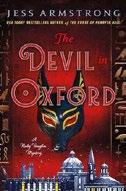
A daring heroine unravels another tangled murder mystery with lurid trappings.
Oxford 1923: Headstrong American Ruby Vaughn finds respite from the stresses of her life via daily fencing forays at the Artemis Club with alluring Leona Abernathy. Their blossoming relationship seems headed for an affair. Armstrong packs a great deal of exposition into the opening chapter of Ruby’s third case, much of it referencing previous mysteries while foreshadowing upcoming events. These include Ruby’s questionable relationship with handsome solicitor Hari Anand. At the home of former professor Emmanuel Laurent, Ruby learns about the feud between Oxford Egyptologist Frederick Reaver and the scoundrel Julius Harker, who runs a “curiosity museum.” The mystery develops slowly, driven by ornate language and a swirl of mysterious characters. Perhaps most mysterious is Ruby’s octogenarian boss, Mr. Owen, an antiquarian book dealer and perhaps a puppet master, who’s introduced her to the world of the occult. A reception at Harker’s museum ends with the discovery of Harker’s corpse. Although the police arrest Harker’s mild-mannered bookkeeper, Mr. Mueller, Ruby is unsettled by Leona’s suspicious behavior. So of course righteous Ruby must probe. As if on cue, folk healer and former inamoratos-cum–sleuthing sidekick Ruan Kivell reappears to assist her. Ruby’s attraction for Ruan simmers beneath their banter, which is charged with sexual tension and studded with barbs. A handful of other
patrician suspects with colorful backstories are folded in, and Hari reappears with the startling news that Ruby’s mother and sister, who reportedly perished on the Lusitania , may be alive.
A bustling, elegant whodunit fueled by suppressed lust and enigmatic characters.
Bowen, Rhys | Berkley (336 pp.) | $30 November 18, 2025 | 9780593641392
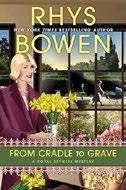
An aristocratic young mother proves a dab hand at solving murders in 1937. Lady Georgiana O’Mara is a cousin to both the new King George VI and the Duke of Windsor, who abdicated to marry the rapacious Mrs. Simpson. She’s married to the Honorable Darcy O’Mara, heir to an Irish title, but they don’t have much money even though Darcy works for the government in a hush-hush position. Luckily, she’s the heir to her well-off godfather, who’s letting Georgie, Darcy, and their son, James, live in his home. Everything is going well until Georgie’s bossy sister-in-law, Fig, Duchess of Rannoch, sends a much-too-proper nanny to take care of James, and announces that she intends to visit herself to make sure things run as she insists they should. Thoroughly intimidated, Georgie unhappily puts up with her unwanted visitors. Darcy encourages Georgie to go to London to visit her friend Zou Zou, a Polish princess who might help her find a nanny more to her liking. When Georgie arrives at her friend’s house, Zou Zou is rushing off to a funeral for a young man who died in a tragic accident, but Georgie soon runs into another friend, Belinda, who’s just returned from Paris. Another young man has just died in an apparent accident, but there’s something that doesn’t sit well with
that’s also a searing indictment of racism.
THE BLUEST NIGHT
Georgie about the deaths. The death of a third young man sets the alarm bells ringing, and a fourth death sends sirens blaring, urging Georgie to look for connections among the deceased. They were all Darcy’s age and all set to inherit estates. Why were they targeted for death?
The pre–World War II ambiance provides an apt setting for some ingenious murders in a case worthy of the clever sleuth.
Brett, Simon | Severn House (192 pp.) $29.99 | October 7, 2025 | 9781448314676
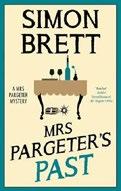
Not all of Mrs. Melita Pargeter’s storied past, mind you, but a single incident that plays a pivotal role in determining the course of her present.
“Short Head”
Shimmings, accountant to the late Lionel Pargeter and a compulsive gambler, has fallen £500,000 into debt to the Batinga Brothers, whose professional code forbids them from forgiving a penny or extending their deadline. Naturally Short Head appeals to Mrs. Pargeter for help, and naturally she insists that her staff set up a face-to-face meeting with Damone Batinga (a genteel loan shark) and his brother, Como (a psychopath). The arrangements are complicated by two factors: Mrs. Pargeter’s general ignorance of the extensive criminal dealings that made her beloved husband, and by implication herself, a force to be reckoned with—a defining feature of this slyly sunny franchise—
and her particular ignorance of the fact that 30 years ago, when a hyperextended Act 2 flashback shows that she was abducted and threatened with torture by opponents of Lionel’s latest felonious enterprise, her kidnappers, the Smith Brothers, were actually the Batinga Brothers, using a pseudonym that deceived no one but her. Mrs. Pargeter makes her way through the usual crowd of zanies, who this time range from Athena Shimmings, Short Head’s ultracontrolling mother, to “Canary” Wolfe, the financier scheduled to yield his position as master of The Worshipful Company of Cozeners and Usurers to Damone Batinga, who looks forward eagerly to meeting Mrs. Pargeter at his investiture because, unlike his brother, he still has a crush on the woman he kidnapped so long ago.
It’s a mark of the heroine’s distinctive appeal that she emerges from this adventure both triumphant and clueless as ever.
Clark, Aaron Philip | Severn House (256 pp.)
$29.99 | October 7, 2025 | 9781448317080

A Black ex-LAPD detective who now investigates police misconduct for a law firm gets more work than he ever could have wished for.
Veronica Dixion, one of many ex-lovers of retired LAPD detective turned PI Shaun Finnegan, is concerned that Avery Dixion, the son driving from Nevada to meet his father for the first time, has disappeared en route along
with his girlfriend, Keisha Landry. And she’s right to be concerned, because soon after the police find Keisha’s dead body in the Malibu Hills, Finnegan’s son, ex-cop Trevor, stumbles over Avery’s not-quite-dead body along a nearby road. Sharply challenging the assumption of primary investigator Det.
Beatrice Brennan that Avery, who pleads amnesia, killed Keisha, Trevor, struck by the unusual clothing both victims were wearing, beats the bushes for other suspects and unearths three disturbing patterns. One is the similarity of this incident to another crime nearly 30 years ago, when Sharice and Gabriel Mitchell, teenage siblings fleeing an oppressive foster home, were attacked by a gang that left Gabriel dead and Sharice devastated after dressing them in remarkably similar outfits. A second is that the attackers, who may have been responsible for dozens of outrages in between the two Trevor can identify, seem to have deliberately targeted Black people, either because they won’t be missed or because their predators want to celebrate a return to slavery via “antebellum chic.” And a third is that yes, the local authorities are probably involved; in fact, it’s hard to say for sure if any of them definitely aren’t.
Clark delivers a mystery that’s also a searing indictment of contemporary racism.
Holloway, J. Kent | Keylight Books (240 pp.) | $31.99 | November 18, 2025 9798887980713

A surfeit of Santas seriously complicates a murder investigation. Thomas Nast owns Wonderland, a shop specializing in all things Yuletide in Christmas, Florida. The shop is in a large Victorian house that hides many secrets, including the fact that Tom is a Santa-in-Training. Entering his shop one day, he finds the dead body of a
man dressed as Santa, stabbed to death with one of six unique pocketknives he’d given as gifts to special friends. The police arrive, and their questions lead them to suspect Trixie McNamara, the store assistant who lives there and is almost a daughter to Tom. The dead man is Trixie’s estranged father, the much-disliked Hank Cobb, with whom she’d recently argued in a local bar. Tom can hardly tell the police that the house is home to both an elf, Peppermint, and a guard alligator. The police arrest Trixie, and since they’ll never believe she’s innocent and the house has magical properties, Tom resolves to investigate. He’s pained to consider everyone who received a special knife a suspect because all of them are or were his friends. On top of the murder, Tom must deal with a gangster who’s convinced that his $50,000 is stashed somewhere in the house. Despite a thorough search, all Tom discovers is a token from Alcoholics Anonymous. As he questions his suspects, Tom uncovers lots of secrets, deals with a rare snowfall, and survives an attempt on his life. A magical mystery with a Christmas theme.
Laurie, Victoria | Kensington (304 pp.) $27 | November 25, 2025 | 9781496742520

A Washington, D.C., investigator with an unusual past becomes enmeshed in a murder mystery that tests her loyalties and reveals unsettling secrets about the
people and world she thought she knew.
Dovey Van Dalen is just an ordinary PI to most people who know her, but she’s actually a “mystic investigator,” retrieving magical objects that fall into non-magical hands. Some 180 years ago, as a young society girl in Copenhagen, Denmark, she met Elric, the jealous mystic who bound her to him as his lover and spell-casting pupil. Now 200 years old and the owner of an enchanted hedgehog who doubles as her personal stylist, Dovey has fallen in love with FBI agent Grant “Gib” Barlow, whom she met while investigating a spellcasting trinket from her world used to murder people in his. Her feelings for Gib are undeniably strong, yet she avoids him for fear of incurring Elric’s murderous wrath. When a matchmaking friend manipulates Dovey into a date with Gib, she learns from him that another FBI agent has had every bone crushedin his body. Immediately, Dovey suspects that Elric or another very powerful mystic is behind the crime and launches a private investigation at Elric’s company to find answers. Blending elements of romance, fantasy, and suspense, Laurie creates a fast-paced, ever-twisting narrative that moves between two parallel worlds bound in sometimesdangerous ways through the interactions of mystics, mortals and magical creatures. The closer Dovey gets to the truth, the more she peels back layers of deception involving powerful stolen trinkets, secret love triangles, hidden identities and plots to disrupt the delicate balance of power between spellbound mystics and unbound humans.
Captivating supernatural suspense laced with romantic intrigue.
Captivating supernatural suspense laced with a bit of romantic intrigue.
Mark, David | Severn House (240 pp.) | $29.99 | December 2, 2025 9781448315345
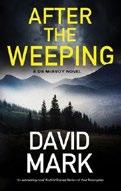
DI Aector McAvoy investigates a cold case, unaware of the international intrigue that surrounds it.
DCS Trish Pharaoh intermittently regrets sending McAvoy to reopen an inquiry into the murder of Davey Hawksmoor, found beaten to death in a local cemetery nearly 15 years ago, without revealing the real reason for her quest: trying to get a lead on the current whereabouts of reporter Vicky Dexter, who’s disappeared in Romania while documenting the trafficking of Roma children by Davey’s father, self-styled “Dark Angel” Rab. Mark’s thriller-cum-police-procedural offers its share of moral complexity. Not only are Trish’s motives conflicted, but Rab himself is a controversial figure, hailed by his fellow Brits for rescuing children from terrifying conditions in Romanian orphanages, but reviled ov erseas as stealing these children, whose families surrendered them only under severe economic duress. But moral complexities are a sideshow here. The main attraction is red meat: clinically detailed descriptions of brutal fights between men bent on inflicting horrific physical injuries on each other. Even McAvoy becomes a target, with the pounding rain, the mud, the blood, and the gore prominent features at every turn. McAvoy’s wife, Roisin, a Traveller whose father is head of an important clan, has every reason to fear for her husband’s safety, and the constant presence of their charming young daughter, Lilah, makes McAvoy’s plight all the more harrowing. Strictly for fans who like their murders bloody.
Reichs, Kathy | Scribner (288 pp.) | $27.99
November 18, 2025 | 9781668051474
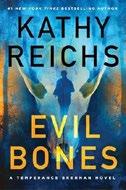
Dr. Temperance
Brennan tackles the case of a serial killer of animals who’s been ascending the food chain over a period of years.
The unnerving vision that causes an elderly woman to drive off a rainy road in Mecklenburg County, North Carolina, turns out to be a painted head nailed to a tree. Even more disquieting than this discovery is Tempe’s realization that it’s only the latest of a series of heads similarly disfigured, decorated, and displayed as death’s heads. The only thing that prevents the perp, whoever it is, from being threatened with life imprisonment is that none of the remains are human: They’re all skulls of rats, squirrels, rabbits, skunks, and dogs, the earliest of them three years old. Tempe and Erskine “Skinny” Slidell, the surly retired police investigator who partners with her, suspect that the killer, whose latest display does contain some human bones, is working up to killing people, and they turn out to be all too correct. Just in case Tempe is looking for relief from this stressful case at home, her willful 17-year-old grandniece, Ruthie, has overcome her resistance to setting foot on the campus of UNC Charlotte and made contact with Lester Meloy, a grad student who’s supplied her with weed, and Danielle Hall, his fellow member in a secretive group called “Live.” Ruthie inevitably goes missing and Tempe is kidnapped herself before all the promising complications of the case are waved aside in favor of a solution that comes out of left field and answers almost none of the sharpest questions the mystery has raised. Apart from recurring characters, this entry is less interested in live people than in dead animals.
Rosenfelt, David | Minotaur (304 pp.) $28 | October 14, 2025 | 9781250324573

How better to celebrate the holidays than by taking in a homeless dog and solving multiple murders?
One year after a gas leak killed financial director
Lisa Dozier and six other employees of Marstan Industries, and one day after Jeff Wheeler, who’d planned to ask Lisa to marry him, publicly accused Marstan head Stanley Franklin of deliberately arranging the leak himself in order to kill his underlings, Franklin is obligingly found shot to death in the doorway of his magisterial home. The police, who find the murder weapon discarded in a plastic bag containing lots of stuff traceable to Jeff, quickly arrest him. His case seems so hopeless that his sister, Carol Hendrickson, appeals to still-notretired Paterson, New Jersey, defense attorney Andy Carpenter to replace his court-appointed counsel, and Andy agrees both to provide a temporary home for Lisa’s dog, Rufus, whom Jeff rescued from the burning building when he couldn’t reach Lisa, and to represent Jeff in hopes that Rufus’ tenancy will indeed be only temporary. The defense Andy constructs, which begins by looking for reasonable doubt under every possible rock, eventually focuses on an auction Franklin had scheduled for a Nazi-held trove of master paintings only recently discovered and liberated, a collection Franklin plans to sell en masse for a minimum bid of $150 million. With that much money at stake, there’s got to be a connection to the principal’s murder, Andy reasons, and of course he’s right—though working through that connection proves perhaps the least interesting part of Andy’s characteristically insouciant narration of his adventures, falling far behind his appealingly flippant remarks to everyone from grieving widow
Margaret Franklin to Bergen County Judge Danielle Eddings.
A middling entry in this unfailingly entertaining series.
Whishaw, Iona | TouchWood Editions (180 pp.) | $17.95 paper | November 11, 2025 9781771514828

A prequel for Lane Winslow: Not yet a sleuth in the wilds of British Columbia, she’s on a dangerous mission for Britain during World War II. Given her facility for languages, Lane is working as a translator, a dull job that gets exciting when her boss reluctantly asks her to meet “someone off the east coast of Scotland and take him home to a nice Christmas with your grandparents.” Then he gives her a gun and snowshoes. Her cover story is that she’s meeting a cousin for a ramble and then taking her fiancé to her grandparents’ for Christmas. In fact, she’s picking up Marc Nowak, a double agent being dropped off by a German submarine. In the meantime, Lane’s grandparents are making do with a sweet helper who’s a hopeless cook. While out collecting greens for decorations, Gran finds a military bag hanging from a tree limb and gets strict orders to hide it until it can be picked up. On the train to Scotland, Lane meets Freda Beauville, a friend from Oxford with a dim view of Britain’s chances in the war. They part in Edinburgh, where the unexpectedly heavy snow proves a real challenge for Lane, who’s due at the rendezvous in two days. Using the snowshoes, she reaches a farm where she wangles a meal before setting off again to an inn, escaping an amorous landlord and reaching the shore in time to overpower Freda, who’s pretending to be the escort. Once Freda is jailed, Lane and Marc set off for the cottage of Lane’s grandparents, where more danger awaits.
A delight for fans of intelligent, strong-willed sleuths like Maisie Dobbs and Phryne Fisher.
Kirkus Star
The Blackfire Blade
Logan, James | Tor (496 pp.) | $19.99 paper November 4, 2025 | 9781250350657

The second installment of Logan’s Last Legacy saga, following The Silverblood Promise (2024), continues the chronicles of Lukan Gardova, a disgraced heir attempting to solve a mystery revolving around his father’s death.
With a key that opens a vault at a bank located in the city of Korslakov—in the far north of the Old Empire—that should contain insights into his father’s demise, Gardova sets off on the grand adventure with master thief Ashra (aka Lady Midnight) and Flea, a “sharptongued street rat” who is deadly with a crossbow. But once they reach their destination, Gardova gets drunk and has the jeweled key stolen from him by an infamous thief known as the Rook. Highly irritated by their companion’s bonehead mistake, Ashra and Flea— along with a contrite Gardova—vow to locate the Rook and somehow retrieve the key. Their mission, however, is beset with many perilous side quests, all of which seem to be tied to noble houses attempting to open an ancient portal called the Crimson Door in the side of a mountain left behind by a godlike race. Behind the door could be advances beyond their wildest dreams, or that could annihilate them all. While no novel is flawless, this comes close. Deeply developed and authentic characters (even the supporting cast are adeptly portrayed), nonstop action, immersive worldbuilding, and a plethora of cool fantasy elements (golems, ghouls, rogue alchemists, mythical beasts, sentient swords, and more) make this an undeniable page-turner. Logan achieves this readability in no small part by savvily ending chapters with bombshell revelations, powerful statements, and leading sentences like this one, which will all but compel fantasy fans to keep
reading: “And with a terrible slowness, the door began to open.”
A stay-up-all-night-until-your-eyesbleed kind of read—a virtually unputdownable adventure fantasy.
qntm | Ballantine (288 pp.) | $28 November 11, 2025 | 9780593983751

A highly secretive intelligence agency fights an underground war against an enemy it can never remember. Speculative fiction and the funkier corners of digital culture go together like chocolate and peanut butter—see Ryan North’s crowdsourced Machine of Death series or the novels based on the podcast Welcome to Night Vale for prime examples. Here, qntm (aka British author Sam Hughes) offers a legally sanitized but fantastically composed take on the SCP Foundation, a collaborative online fiction project that blends horror and SF tropes with satire and literary experimentation. Nominally, it’s offered here as a series of interconnected short stories, field reports, and other interstitial components of a larger mythology. In these Twilight Zone -quality twists, we learn that our protagonist, Marie Quinn, leads a particular division at the Organization—imagine an international spy agency with G.I. Joe’s budget and The X-Files’ mandate—that locks down “antimemetics,” or ideas that cannot be spread or retained. In other words, how do you fight a war you can never remember exists? “It’s a conceptual ecosystem, of ideas consuming other ideas and…sometimes…segments of reality,” the book explains. “Sometimes, people.” Normally the project’s fragmented, nonlinear nature might work against it, but not here. Though he cleverly stitches everything into a whole after the fact, qntm weaves the novel’s fundamental, world-altering conflict underneath a whole lot of
noodle-bending quantum mechanics. There’s even a little romance as we meet Adam Quinn, Marie’s hopelessly normal husband, as he struggles to help his wife remember him, let alone reconnect with her. The disposable nature of most characters doesn’t generate a lot of sympathy, it’s true. But simultaneously solving the linguistic gymnastics around arcane physics and spooking the bejesus out of readers is no mean trick. Much like a first viewing of The Matrix, a clever twist matched with an adversary this unstoppable is both cool and unsettling. The answer? “Ideas can be killed,” says Quinn. “With better ideas.”
A quixotic science-fictional universe that plays with memory as much as calamity physics.
Roth, Veronica | Tor (240 pp.) | $21.99 September 16, 2025 | 9781250855503
Series: Curse Bearer, 2
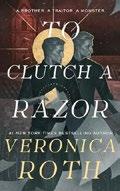
Dymitr, a monster hunter turned monster, must return to face his family when he’s called home for a funeral in the second of Roth’s Curse Bearer series.
Baba Jaga, the great sorceress of Slavic folklore, has something that belongs to Dymitr: his bone sword, a magical weapon that comes from his own spine. As a Knight of the Holy Order, Dymitr was meant to use it to kill magical creatures, whom he was taught to regard as inhuman. After learning that everything he was taught about monsters was a lie, that they are in fact just as human as he is, and after Baba Jaga turned him into a magical monster himself, Dymitr has no interest in hunting them anymore. Baba Jaga made Dymitr a zmora, a magical being that feeds on human fear, and he’s only interested in figuring out what to do with his new life. But his bone sword is also made of a piece of his soul, and being separated from it will cause him to go mad. Luckily, Baba
Jaga is happy to give Dymitr his sword back—so long as he kills 33 fellow Knights, starting with his own grandmother. Horrified at the thought of killing the woman who raised him, Dymitr hears more awful news from his sister. His uncle has died, and the family is gathering to perform the Knights’ burial rituals. Dymitr hopes that he can use the trip home to steal his family’s book of Knight curses and offer it to Baba Jaga as a bargaining chip for his sword. As in the first installment in the Curse Bearer series, Roth’s fantasy worldbuilding is efficient and effective. Most of the short—for fantasy, anyway—novel is dedicated to tense action sequences, expanding the fantasy world in ways that directly impact the plot, and to compelling character development as Dymitr faces his violent family. A character-driven fantasy story that doesn’t waste readers’ time.
Kirkus Star
Siegel, Natasha | Morrow/HarperCollins (352 pp.) | $30 | November 25, 2025 9780063418028
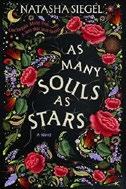
A woman marked by a family curse has a chance to rewrite her fate—but not without making a bargain with darkness. Centuries ago, a being is born from the shadows, the product of a ritual, and roams in search of light from souls to feed its darkness. The being eats its first soul and takes the soul’s human
form, becoming Miriam Richter. Fast forward to 1576 when Cybil Harding is born “under inauspicious stars,” the first daughter who, according to family lore, is cursed to be a witch and bring nothing but destruction. Cybil’s father, a man of magic himself, is heavily influenced by the Reformation and believes his magic to be the spreading of miracles. Cybil, then, is a dark spot in his vision. When witchcraft becomes a death sentence in England, her father takes matters into his own hands. Using the same ritual as his forefathers, he summons a spirit of the darkness to do his bidding—Miriam. Emboldened by the brightest soul she has ever seen— Cybil’s—Miriam wants her above all else. Cybil is less than willing to give up her soul to darkness when she has barely had a chance to live. Thus begins a unique game of cat and mouse: “We are light and darkness, you and I. There is no choice. Eventually, one of us must destroy the other.” Cybil’s realization of her supernatural potential is juxtaposed against the fury of men at her mere existence. Miriam sees her opportunity to offer Cybil a deal, a life free from the bonds of her curse. But wagering a deal with darkness comes with unimaginable consequences, and Cybil’s soul is destined for a journey of lifetimes. Siegel uses her skills as a writer of historical fiction to highlight the changing form of oppression against women across centuries, while infusing a compelling supernatural arc that makes this story one to remember. Cybil’s journey is one of oppression, self-discovery, violence, and love, these dichotomies most simply summed up by the struggle of light versus darkness. Cybil and Miriam’s deeply complicated bond shows the human side of evil and the dark side of love. Despite her story’s grand scope, Siegel has written
something both ugly and beautiful in the most human of ways. This novel will bend and twist your notion of what love is, while leaving you utterly bewitched.
Summers, Georgia | Redhook/Orbit (384 pp.) | $29 | November 18, 2025 9780316561839

A deeply flawed young woman tries to find a way to save London’s source of ink magic. Cassandra Fairfax is many things: an ink magic reader, liar, and former bookseller. Under the name Cass Holt, she’s also a world-class book thief. When she receives a letter from her old mentor, Chiron—now dead— inviting her to take over his bookshop, which she’d left on bad terms, Cassandra practically leaps at the chance to settle back into her previous honest life. She may be a bookstore owner now, but she quickly comes to realize that she’s in way over her head. And no one delights in reminding her of that more than her frustratingly handsome fellow bookseller, Lowell Sharpe. He is poised and knowledgeable in every way Cassandra is not, and he wants Chiron’s for himself. Thankfully, she has Byron— her own protégé, and a woman who lost her previous position to the work of Cass Holt—to lean on. But secrets do not remain secret for long in Cassandra’s world of magical books, and Chiron had more than a few of his own for her to inherit. With the magical river that powers the tributary bookshops mysteriously waning, Cassandra might just be in a unique position to save London’s source of powerful ink magic. But can she put together the solution before her past catches up with her and destroys her new life? There is a lot to love in Summers’ standalone fantasy novel, like the slow burn, enemies-to-lovers romance between Cassandra and Lowell, the immediate
prose, and Errata the ink magic cat. Sadly, readers who want detailed answers to how the river and ink magic system work will be disappointed. The pacing is slow and then the ending wraps up too quickly, leaving this book feeling only half-baked. A unique novel of books and bookish magic that unfortunately just misses the mark.
Daria, Alexis | Montlake (205 pp.) | $16.99 paper | October 7, 2025 | 9781662534157

High school enemies fall in love in their 20s. Manhattan lawyer Valencia Torres is newly single. Her ex-fiancé, a man she had been dating since high school, cheated on her and then blamed his behavior on her busy work schedule. When her friend Fern invites her out to a holiday bash, Valencia is determined to dance her troubles away. Instead, she runs into Gideon Noble, her teenage arch-nemesis. Gideon has always regretted the years he teased and tormented Valencia. He’s hoping for the opportunity to apologize but is surprised and distracted by their incendiary chemistry on the dance floor. Valencia isn’t shy about what she wants and invites Gideon back to her apartment for what she assumes will be a one-night stand. Gideon’s heartfelt apology for his past behavior convinces her he’s changed, and they decide to extend their affair. Both of them have recently lost parents and are facing the holidays alone. They agree to spend the next 12 nights together until Christmas Day, at which point they’ll go their separate ways. Together they make a “Naughty and Nice” list for each day: a sexy activity paired with a holiday-themed outing in the city. Their high-heat bedroom games are provocative and notably equitable; Valencia insists they must each try every activity as both giver and
receiver. Daria’s story is a fun and sexy holiday romp, but the emotional beats feel simple, even facile. Gideon and Valencia build a relationship by excavating their past, but their focus on discussing high school drama comes at the expense of more indepth exploration of the adult worries and concerns they currently face. Sure to please those looking for a sexy holiday read.
Dumais, Eliza | 831 Stories (176 pp.) | $14.99 paper | November 4, 2025 | 9798893310566
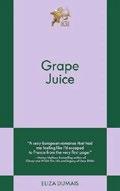
A New Yorker finds herself, and perhaps a bit of romance, in a therapeutic trip to French wine country. Desperate for a change of pace from her accidental relationship and lack of fulfillment in her job as a wine sales representative, Alice takes advantage of an offer from her boss to work a wine harvest in Alsace, France. In reality, Alice knows it was more a mandate than a suggestion; her boss has sensed her waning passion for her job for quite some time. For three and a half weeks, she’ll enjoy the hard labor of picking grapes with a global group of fellow wine appreciators. Alice is one of only two women on the crew and the only American. As the work begins, Alice often finds herself paired up and in conversation with the vineyard owner’s nephew, Henri. He comes with his own brand of relationship baggage, and their grape-picking often involves deep, probing questions and intimate conversations. Those working the harvest build a lovely community together, enjoying communal meals and finding moments to confide in one another, complete with a good glass of wine. Alice’s fledgling friendship with her roommate, the affable Australian Ruby, is particularly sweet, as they giggle and gossip about their colleagues. There’s a comforting slice-of-life quality to Alice’s time at the winery, as she forges connections that
may or may not last. Henri and Alice ease into a cozy rapport and their chemistry leans toward an introspective, slow burn. The mundanity of it all could be a blessing or a curse, depending on the reader. Dedicated romance readers should be warned that there’s no neatly tied up happily-ever-after, but rather a hopeful and open-ended happy-for-now resolution for Alice and Henri. Reminiscent of a summer fling, this is a warm and relaxing though fleeting read.
Heron, Farah | Forever (368 pp.) | $17.99 paper | October 21, 2025 | 9781538725498

A Toronto woman plans to move to the U.K. to open an inn. Ruby Dhanji loves the Christmas season, which reminds her of many joyful times with her late mother. Ruby recently gained access to an inheritance that will allow her to open the English country inn that was her mother’s dream. She’s moving to London on New Year’s Day and, before she goes, she’s determined to enjoy every last parade, holiday market, and gingerbread latte the city of Toronto has to offer. After a chance encounter with handsome but grumpy dermatologist Rashid Hakim, Ruby discovers he has loose ties to her friend group. Rashid has temporarily relocated to Toronto for his family. His sister has recently separated from her husband and needs help with her 5-year-old twin daughters. Ruby discovers his family owns a chain of European luxury hotels and thinks he might be able to help her; since she’s always worked in retail, she’s had difficulty landing a hotel job in England. She offers to show Rashid and his nieces the best holiday events in the Toronto, hoping he’ll give her a good reference to his family’s business. But while they have chemistry, it turns out that they only see the worst in each other: Rashid thinks Ruby is frivolous
and materialistic, while Ruby thinks Rashid is judgmental and privileged. As they spend more time together, though, they discard these misconceptions and become friends. They decide a brief holiday fling can’t hurt either of them since they’ll both be leaving Toronto soon. Heron carefully crafts interesting, fully realized characters and gives them time to grow. Although the ending feels a little rushed, both Ruby and Rashid are given the opportunity to fully explore their dreams and obligations before committing to each other. A beautiful, slow-burn romance celebrates love in all its forms.
Jordan, Sophie | Avon/HarperCollins (360 pp.) | $32 | October 14, 2025 9780063414341

After a young woman discovers she’s a dragon, she has to learn how to act like one. It’s been a year since Tamsyn’s life crumbled in an instant. After years of being a royal whipping girl, she was married off to Fell, Lord of the Borderlands, and discovered that both of them were dragons in human form. Then he died. Tamsyn was accepted into the pride led by Vetr, Fell’s brother, but after a lifetime with humans, she struggles to learn the ways of dragons and still yearns for Fell. Though everyone tells her she should move on, she has a physical brand that bonds them, and it seems to be telling her he’s still alive. Her confusion grows when Vetr tries to convince her to bond with him and forget Fell. When she learns that Fell isn’t actually dead, but buried so deep in a mountain that he can’t escape, she leaves the pride to try to save him—but so much has changed in the past year that it’s not clear she’ll be happy even if she can. This sequel to A Fire in the Sky (2024) doesn’t live up to that book’s promise. The decision to resume Tamsyn’s story a year after the
cliffhanger ending is jarring, and even fans will need several chapters to figure out what’s going on and settle into this story. Tamsyn’s growth is compelling, but it feels one-note because of Fell’s absence from most of it except as an object of longing; though the book is a romantasy, there isn’t much romance to be found. Much of the emotional heft of the first volume came from the conflict and chemistry between Tamsyn and Fell, and though Jordan attempts to add complexity through a potential connection between Tamsyn and Vetr, it feels out of place in the context of the world she’s built, and is barely explored before Tamsyn abandons the pride. Though Tamsyn remains a compelling character, the book never rises to the expectations set by the first volume, and the ending is strangely underdeveloped for an apparent duology.
An underwhelming conclusion to a dragon romantasy series.
Lee, Mackenzi | Dial Press (384 pp.) $17.99 paper | September 9, 2025
9780593730607

Two ladies chase the same duke, then fall for each other.
Harriet Lockhart, born in a Camden brothel and now an actress in a Sapphist Shakespearean theater company, has long been accustomed to living on the fringes of society and finding happiness when she can, with whomever she pleases. When she learns that her father is the prince regent, it’s a shock to consider what life might be like on London’s fancier side. Prinny offers her an inheritance, of sorts, provided that she can find a respectable marriage. Luckily, Harriet knows the Duke of Rochester, and she can imagine some sort of marriage in name only to him. Unfortunately, he is also being pursued by Emily Sergeant, who has
arrived in London desperately looking for a husband who can outrank the odious man to whom her family has betrothed her. When their separate pursuits of the duke bring the two women together, after a few days of bickering both become more interested in each other’s company than anything, or anyone, else. The worldly Harriet is well aware of the nature of her developing feelings for Emily, but it takes Emily longer to understand her emotions. When she finally learns what a Sapphist is, the women connect emotionally and physically. However, society hasn’t changed, nor have the expectations of their families. Lee’s delightful adult debut will please fans of her YA historical fiction as well as romance readers encountering her for the first time. The story, which centers queer and theatrical Regency life alongside the familiar tropes of the London Season, is well-paced, with entertaining side characters and rich detail. The clever ending, moving and satisfying on its own, is enhanced by Lee’s extensive, thoughtful notes sharing historical background and revealing that much of her plot is less fantastic than readers might assume.
A sparkling Sapphic romance that brings many facets of Regency London to life.
Lehane, Lucy | St. Martin’s Griffin (336 pp.) | $19 paper | October 14, 2025 9781250329660

Charlie Wever is a down-on-his-luck advice columnist who doesn’t have the answers about dating magical creatures. Can a chance run-in with a vampire acquaintance be his ticket back to the top?
When the online magazine Charlie writes for is bought out, his salary is replaced by a pay-per-click rate, and he’s forced to move from New York back to his hometown in rural Virginia. Luckily, he soon runs into Lorenzo, who dated
one of his college friends until she dumped him—on Charlie’s advice. When Charlie asks Lorenzo to be his guide to the world of supernatural creatures, Lorenzo agrees because he sees the request as an opportunity for revenge. This dubious arrangement seems to benefit Charlie more than Lorenzo, who asks for Charlie’s help with a few mundane tasks involving a plumber, a dry cleaner, and a driver’s license. When Charlie complies, Lorenzo reciprocates by bringing him to a werewolf prom, a druid initiation ceremony, interspecies game nights, and more. Eventually Lorenzo moves past Charlie’s previous betrayal, and they act on their growing attraction to one another. Their plan begins with a fair amount of deception—rather than telling Lorenzo about his advice column, Charlie says he’s a graduate student working on a thesis that no one will ever read (hoping to placate the vampire sense of privacy), and Lorenzo invades Charlie’s sleeping subconscious to scare him away. Both of Charlie’s betrayals seem fairly manufactured, and it’s never clear why Charlie needs to lie about writing a column when there are other people publicly discussing intraspecies relationships and mystical creatures are a known population. Lorenzo’s supernatural roommates and Charlie’s letters from the paranormal lovelorn are the highlights of Lehane’s debut. Ambitious and fun, but fails to find the right magic.
Long, Ilana | Berkley (368 pp.) | $19 paper October 28, 2025 | 9780593642252
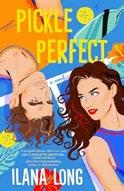
A single mother joins an impromptu pickleball vacation to Costa Rica, only to discover that her ex-boyfriend is on the very same trip. Lulu Gardner is a rule follower. As a high school business teacher and single mom to toddler Zoe, the 33-year-old has
that brings the heat on and off the court.
PICKLE PERFECT
little time for risk-taking. There was a time when Lulu would sneak out late with her high school boyfriend, Tyler Demming, to play tennis after dark on Washington’s Bainbridge Island. But that was then, before her parents died and she abandoned her dreams of going pro. It’s been years since she last heard from Tyler, since he didn’t show up to her parents’ funeral and later became a pro pickleball star. And while she attributes some of her current prudence to that heartbreak, she doesn’t know if she can ever reclaim her past adventurousness. That is, until an inappropriate speech-to-text incident lands Lulu in hot water at school and she’s suspended. With her job in limbo, Lulu decides to join her godparents on their weeklong Costa Rican pickleball vacation, with Zoe in tow. There, Lulu is presented with the offer of a lifetime: Join a trial pickleball adventure tour through the Costa Rican wilderness for free! Hoping to regain her old spark, Lulu says yes—what could be more fun than pickleball with a sprinkling of zip lining and bat caves? Then a surprise celebrity guest is announced: Tyler Demming. Suddenly, Lulu is thrust into the great unknown with a group of pickleballers and her ex-boyfriend, who’s just as damn charming as she remembers. Can Lulu forgive Tyler for the past and conquer her fears, or will she forever be too afraid to take chances? Long’s second pickleball romance is a score, full of heart, excitement, spice, and shenanigans. Lulu and Tyler aren’t afraid to be vulnerable and their chemistry is undeniable, with just the right amount of a sizzling slow burn. Fans of Pickleballers (2024) will enjoy the
perfect mix of sports and romance that proves to be Long’s specialty. A page-turning second-chance romance that brings the heat on and off the court.
Matthews, Mimi | Berkley (416 pp.) $19 paper | November 25, 2025 9780593639313
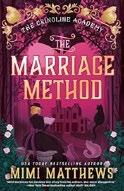
A double mystery involving London’s seamy underbelly turns a marriage of inconvenience into a love match in this multi layered historical romance. In the London jungle, Penelope “Nell” Trewlove and Miles Quincey are natural adversaries until shared threats turn them into allies. A senior teacher at 23, Nell has considered the Benevolent Academy for the Betterment of Young Ladies her home and salvation since she was 4 years old. Relentless newspaper editor Miles hopes that uncovering the secrets of the isolated charity school and “home for dangerous revolutionaries” could revive his plummeting readership after his last investigative series took down a popular politician and aristocrat. When he demands that the school send a representative to London or he will come to them, the headmistress dispatches Nell to keep him outside their gates. With humor and attention to historical detail, Matthews skillfully explores every dimension of their awkward meet-cute and evolution, down to
how Nell’s sartorial choices reflect the constraints and dangers of being a woman in 1864. The youthful “goddess” with the face and figure of a “sultry angel” who shows up at the London Courant shrouded in an all-black widow’s uniform with a veil and an enormous crinoline was not what Miles expected. Nell knew her costume conferred “a degree of respect not offered to unaccompanied young ladies.” She and her colleagues donned crinolines, those “controversial cage-like” undergarments, “like armor.” A woman so encased “demanded space…in every sphere through which she traveled.” And yet, in a deft bit of irony, a crinoline also precipitates Nell’s loss of power. When Miles’ cat gets entangled in the elaborate netting, Miles tries to free the mischievous animal and gets caught by one of the most judgmental clergymen in the city looming over Nell while she lay on the floor with her skirts above her knees. To save their reputations and livelihoods, Nell and Miles enter a hasty marriage arrangement that morphs into true partnership as they investigate the suspicious disappearances of her new pupil and his reporter in London’s seamier environs.
This Victorian romance is a winner, weaving social history, intrigue, and humor with falling in love.
Tschida, Sam | Quirk Books (320 pp.) $17.99 paper | October 28, 2025
9781683694724

After a case of mistaken identity leads her to inherit a rundown Vermont inn, a lonely vampire struggles to adjust to smalltown living.
Tiffenie Ruba has been trying to live under the radar as a vampire for the last 300 years, but maintaining the secret has
led to some serious loneliness. Borrowing an identity from a human who shares her name—Tiffany Blair—she moves between a job at a blood bank and the LA apartment she shares with her cat. With nothing but eternity ahead of her, though, Tiffenie’s secretly longing for a more Hallmarkmovie lifestyle. When she learns that the real Tiffany has inherited a Vermont inn, she seizes the opportunity to start over. Unfortunately, she’s bringing her own baggage on this unexpected road trip, chiefly a neighbor she sort of accidentally turned into a vampire, too. Settling in isn’t the cozy experience Tiffenie envisioned, since the inn is days away from being condemned and she’s forced to keep pretending to be someone she isn’t in a small town where everyone knows everyone else. At least there’s a deeply attractive Christmas tree farmer named Tyrone who seems genuinely interested in her, but the situation is made complicated when Tiffenie’s ex-boyfriend Vlad, the vampire who made her, decides to pay a visit—and his presence is a reminder of everything that used to be good about their relationship. Tschida’s latest is billed as a rom-com, but the romance takes a backseat to the comedy, in large part because Tiffenie’s quirky inner narration is so strong. The novel has all the makings of the Hallmark holiday love story Tiffenie longs for, but with limited space afforded to all sides of the relationship triangle that emerges—especially as even more characters and hijinks start to occupy the narrative—it’s hard to fully buy into her ultimate choice. More time spent building to that happily-everafter would have given the ending more weight and significance. This witty, unconventional small-town story could use a bit of renovation.

Vesselless
Winn, Cortney L. | Harper Voyager (448 pp.) | $19.99 paper
October 7, 2025 | 9780063451803
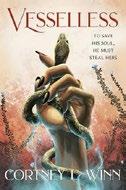
For more romance reviews, visit Kirkus online.
A princess connected to the spirit realm teams up with the half-spirit of her kingdom’s former ruler—the man whose throne her father stole a decade ago. Nizzara’s betrothal looms on the horizon. Though there hasn’t been an official announcement, her father, the king of Zarr, has made it clear that he’ll find her a suitor by spring. However, should she win the King’s Duel, a deadly tournament, she’ll be granted a gift of her choosing and she plans to ask for an exemption from her father’s betrothal law. Nizzara’s preparation for the tournament isn’t going well, given her resistance to using the full power of her vessel, a ring that acts as a conduit for a spirit’s power, and her resistance to killing in battle. This presents an opportunity for Zarr’s former king, Dagen. He is now a half-spirit, not quite dead and not quite alive. Nil, the god of death, presents him with a chance to regain his throne. To reclaim Zarr, Dagen will have to bring Nil a pure soul, which currently resides in Nizzara. This soul has the power to vanquish her villainous father and release Dagen back to the land of the living. The one catch: Nizzara has to offer the soul willingly. So Dagen goes back to his former castle, seeking to infiltrate Nizzara’s memories, win her trust, and help her win the tournament. Extensive worldbuilding is more hindrance than help here, as the plot bogs down in constructing a foundation for the magical system and explaining the political intricacies of Zarr and the surrounding kingdoms. This extensive detailing never coheres into an understandable fictional universe. The growing attraction between the main characters and the forward momentum of the story suffer for it, and the author’s attempts to enliven the slog with occasional lustful moments don’t improve matters.
A muddled and meandering fantasy romance debut.


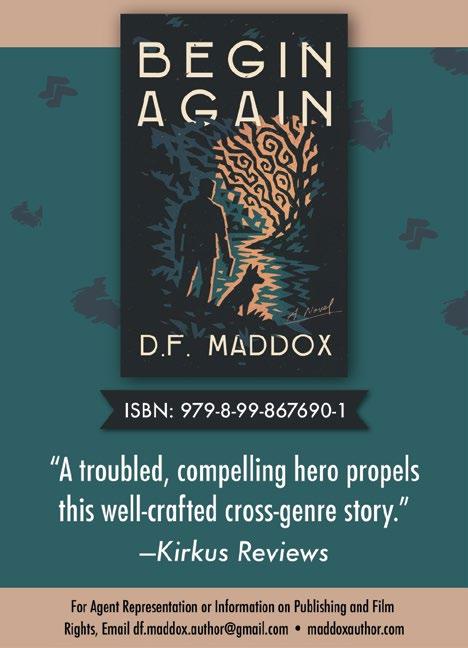


EDITORS’ PICKS:
Murder Between Friends by Liz Lawson (Delacorte)
Ceecee: Underground Railroad Cinderella by Shana Keller, illus. by Laura Freeman (Charlesbridge)
Here Comes the Sun: A Last Chance for the Climate and a Fresh Chance for Civilization by Bill McKibben (Norton)
Fonseca by Jessica Francis Kane (Penguin Press)
THANKS TO OUR SPONSORS:
Roller Coaster by Peter Searle
Fully Booked is produced by Cabel Adkins Audio and Megan Labrise.

A spellbinding new novel tackles the morality of magic. BY MEGAN
On this episode of Fully Booked , Charlie Jane Anders joins us to discuss Lessons in Magic and Disaster (Tor, August 19), the story of a young witch who teaches her grieving mother how to do magic. In a starred review, Kirkus writes that Anders’ eagerly anticipated latest provides “much to ponder, much to cry over and rage against, much to appreciate.” Anders is the best selling, award-winning author of All the Birds in the Sky, The City in the Middle of the Night , the Unstoppable trilogy, Even Greater Mistakes , and Never Say You Can’t Survive. She co-created Escapade, a transgender superhero, for Marvel Comics, and is currently the science fiction and fantasy book reviewer for the Washington Post . Annalee Newitz and she co-host the podcast Our Opinions Are Correct
Here’s a bit more from our review of Lessons in Magic and Disaster : “Jamie, a trans graduate student, needs to find that piece of evidence that will give direction to her Ph.D. dissertation about 18th-century female authors, even as her university threatens to pull her funding and she faces misogyny and transphobia every day in the classes she teaches. She’s also trying to reconnect with her mother, Serena, who is suffering from a crippling depression stemming from the long-ago death of her wife, Mae, and the ruin of her career as a social justice activist by the leader of a right-wing smear group. So Jamie shares something with Serena that she hasn’t even shared with her nonbinary spouse, Ro: Jamie can do magic….This compact novel is about many things: a literary



Lessons in Magic and Disaster
Anders, Charlie Jane Tor | 320 pp. | $29.99 August 19, 2025 | 9781250867322
treasure hunt that strongly recalls A.S. Byatt’s Possession ; the struggle to negotiate obligations to parents, spouses, and oneself; moving forward from grief; and a selftaught witch’s fraught journey toward understanding her own magic. But underlying everything is this profound question: How do minority groups fight effectively and ethically against the tolerance of intolerance?”
In a wide-ranging conversation, Anders and I discuss podcasting, plot, pedagogical practices, what—if anything—novels should “teach,” Susan Sontag, and how to live well.
Then editors Laura Simeon, Mahnaz Dar, John McMurtrie, and Laurie Muchnick share their top picks in books for the week.
Editor at large Megan Labrise hosts the Fully Booked podcast.
THESE ARE NAIL-BITING times—marked by war, political rancor, and economic jitters—and plenty of new books rightfully address those important topics. But every so often it’s good to get off the dark ride of dread and focus on books that’ll lighten your mood. Maybe they’ll even bring you some joy.
You could do worse than start with Susan Orlean’s latest book, whose title reflects her spirited nature. In Joyride: A Memoir (Avid Reader Press, October 14), the author of such beloved bestsellers as The Library Book and The Orchid Thief looks back at her own life story. In relating her journey as a writer, she exhibits the same effervescence and good humor—and sense of wonder—that lift her accounts of other people. “Being a writer is so much fun ,” she writes. “It’s Make-A-Wish for the curious, an excuse to do anything that seems interesting because there is always a story if you look for it.…I want to go to Bhutan, to a taxidermy convention, to Mount Fuji, to South Africa, to a dog


show, to a cat show. I want to talk to everyone and tag along as they live their lives, and because I am a writer, I can.”
Tagging along is what one does in reading Rob Reiner’s A Fine Line Between Stupid and Clever: The Story of Spinal Tap (Gallery Books/Simon & Schuster, September 9). Few movies have brought me as much joy as This Is Spinal Tap, and this book by the film’s director—written with its lead actors, Christopher Guest, Michael McKean, and Harry Shearer— is a treat for any fan who’s been waiting for the faux rock documentary’s sequel, Spinal Tap II: The End Continues. Among the book’s highlights are bits of subplots that never made it into the final cut of the film, as when Derek Smalls (Shearer) is going

JOHN McMURTRIE


over the details of his divorce with his lawyer. “She can’t have the Lamborghini,” he says. “OK, she can have the Mini.”
Another behind-thescenes delight is David M. Lubin’s Ready for My Closeup: The Making of Sunset Boulevard and the Dark Side of the Hollywood Dream (Grand Central Publishing, August 12). As Lubin writes of the classic 1950 film noir starring Gloria Swanson as Norma Desmond, Billy Wilder originally “wanted it to be a comedy with Mae West ‘as the faded glamour item.’”
After meeting with the comic actor, however, the director “realized her acting style would turn the production into a ‘kind of Laurel and Hardy picture.’” There’s also a fair amount in the book about the great Erich von Stroheim, the
director who plays Desmond’s butler in the film— and is often seen from behind. “Are you going to make up my ass?” von Stroheim complained to a makeup man. “Because that’s all that’s being photographed.”
Readers get to learn of another creative outlet of a musical genius in Barry Joseph’s Matching Minds With Sondheim: The Puzzles and Games of the Broadway Legend (Bloomsbury Academic, September 18). When not composing and conducting, Sondheim dedicated much of his free time to games. “It’s a whole side of me nobody knows,” Sondheim once said of designing games. Happily, this playful book unravels that puzzle.
John McMurtrie is the nonfiction editor.
How money has made the world.
Religion, technology, power, and the rise and fall of entire empires are tied up with economics and commerce in McWilliams’ excellent whistle-stop tour of the way money has shaped world history. Covering centuries of innovations— from an ancient baboon femur called the Ishango Bone, possibly used for accounting, to digital-age solutions like M-Pesa, a service in Africa that turns mobile-phone credit into money—it’s a blast of a book. A former Central Bank of Ireland economist who says his peers in the field “take the fun out of money,” McWilliams is a clever and irreverent guide with a knack for turning economic concepts into easy
conversation. “For economists, price is only a number,” he writes; “for real people, price is a feeling.” He takes shots at the way the elite turn up their noses at discussing money matters. “No one pretends to dislike money more than the truly posh,” he says. “Beneath the snobbery is fear,” he adds, “fear of usurpation” thanks to money’s “ability to propel social advancement.”
McWilliams is skeptical of crypto, calling it “more or less an elaborate scam” that has preyed on anemic public trust in institutions. A “few tech-savvy bros issuing tokens and calling these coupons ‘currency,’” he says, “is not the future of money.” This isn’t surprising. Here is an author who is fascinated by his subject, who holds it in esteem and sees it as
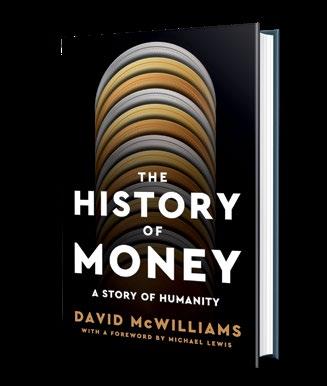
McWilliams, David | Henry Holt | 416 pp.
$32.99 | November 11, 2025 | 9781250408181
second to only fire as “the crucial technology” shaping humanity for the past 5,000 years. Money emerges in the book as something almost miraculous: the connective tissue between cultures, the oxygen for innovation. It’s “a kind of magic,” McWilliams says, “motivating people to strive, to innovate, and ultimately to
change their own personal circumstances and thereby change the world.” Early in the book he claims: “Money was the first thing we wrote about.” In McWilliams’ hands, it’s wonderful to read about. An absolute romp through history, with money— its uses and misuses— as the throughline.
Ando, Miya with Joan Halifax MIT Press (280 pp.) | $29.95 November 4, 2025 | 9780262049863

An artist’s book of abstract visions of rain.
Ando’s art reflects the natural world in its most elemental form and, in doing so, captures the marvelous mystery of its simplest phenomenon. While creating the book, Ando gave physical form to 2,000 Japanese terms for “rain,” drawing from classical texts and Buddhist scripture as well as from Japan’s 72 traditional micro-seasons and phrases in regional dialects. The book is able to hold only 100 images, but the representative selection is wonderful. Spending time with Ando’s artwork allows the reader to sink under the weight of a heavy storm, soar into clouds spitting sudden showers, and inhale the rich dampness of rain-soaked earth. The images are visually unified by the medium of indigo dye but vary by degree—some rain-scapes are consumed by a deep darkness of heavy ink, while others appear nearly white, haunted by the ghost of water. Clouds bloom quick where ink has leeched away. Sharp, silvery-gray streaks of graphite, invoking fast, fierce rainfall, pierce through images like stinging needles. In an erudite foreword, Hollis Goodall, former curator of Japanese Art at LACMA, ties Ando’s work to the Zen Buddhist embrace of the transience of all things. The artist’s preface addresses her own multilayered personal purpose, the images’ immediacy (“a time capsule or an extinction diary”), even the viewer’s primitive response to the work. Having cultivated her own “wonder and ardent respect for nature” since childhood, the author urges the viewer to linger in that mode. Finally, Ando provides a dictionary of the phrases that inspired her images, including their kanji characters, Japanese phonetic
reading, romanized spelling, and English translation.
A meditative artistic practice that encourages deep reflection.
Camus, Albert | Trans. by Ryan Bloom Univ. of Chicago (648 pp.) | $45 December 5, 2025 | 9780226694818

Writing the rebellion.
The Nobel Prize–winning French writer Albert Camus (1913-1960) saw the world through an absurdist lens, one polished in his youth in French Algeria, his wartime life in the Resistance, and his anti-totalitarian activism. The Stranger, The Plague, and The Myth of Sisyphus still stand as the greatest critiques of modern bureaucratic life since those of Kafka. Camus wrote constantly throughout his life, and his notebooks offer a voice-over to the great upheavals of the mid-20th century. Now complete for the first time, in a fluent English translation, they flash with scintillating phrases. Camus thinks of an opening sentence for a novel (worthy of any Latin American magical realist):
“When the evening soup was late, it meant that an execution was taking place the next morning.” Or this idea: “Write the story of a contemporary cured of his heartbreak by nothing other than the long contemplation of a landscape.” Camus records what he thinks are the central questions of modern life: Is rebellion necessary in the face of unbridled power? How can we find the strength to live in a society that has “pushed nihilism to its extreme conclusions?” When should we stop reading and writing and start acting? We get lines on moral responsibility that we might use today: “They say I’m opposed to violence, no matter what. That would be about as smart as being opposed to the wind always blowing in the same direction.” And yet, for all his politics and his polemics, Camus
affirms the human focus of his work: “I only depict individuals, opposed to the machinery of the State, because I know of what I speak.” Camus invites us, now, to speak of what we know and to act on it.
The inner life of a great absurdist, with lessons for us in times of turmoil.
Chan, Eleanor | Pegasus (304 pp.) | $32 January 6, 2026 | 9798897100385

A visual journey through sound.
Chan, a classically trained musician and art historian, offers an “insight into the sheer variety of ways the visual has been integral to music throughout history.” She goes back 12,000 years to Western European caves covered with paintings to discuss how people made sounds of running bulls using shells and other items, creating the first music venues. Impressionist Edgar Degas “was fascinated, throughout his life, by what it meant to depict music.” Serge Diaghliev and his Ballets Russes married art and music in ballet, transforming “what music looked and sounded like.” The painting Four Children Making Music (ca. 1565) changed “how people think about English musical culture and how music travelled.” The author nicely uses the movie Frozen to explain how music can be magically made into something we can see with our eyes, to fix sound into something tangible—which leads to a discussion of Hildegard von Bingen and Fanny Hensel Mendelssohn and their invention of new ways of writing music. Guido, a medieval Benedictine monk, may have used his hand and finger joints to “memorise pitch space—the intervals between notes.” It was music, generated by image, guiding sound. Chan revisits her past and the English choral tradition as she celebrates the importance of the hymnbook and The Whole Booke of Psalmes in particular,
which “changed what music looked like and how it was fantasised, forever.”
Printed sheet music—“music as a visible, visual phenomenon”—soon followed, and later still, sheet music as art itself. Next up are musical instruments as art objects, especially flutes, which Chan played, briefly. She concludes by discussing some favorite artists who rethought the way we conceptualize music, including Levina Teerlinc’s painting An Elizabethan Maundy from the 1560s to Aubrey Williams’ 1981 painting Shostakovich Symphony No. 6 and Toko Shinoda’s visualized music lithograph Duet (1955).
A perky, enthusiastic foray into the overlap of music, art, and history.
Songwriter Sylvia Moy
Christian, Margena A. | Da Capo (304 pp.) $30 | February 10, 2026 | 9780306833632

A pioneering musician rescued from obscurity. Sylvia Moy may not be among the names that come to mind when thinking of the Motown sound.
Painfully shy, Moy was nevertheless respected by peers at the Detroit record label—for her musicality as a lyricist and her sharp instincts for song construction on paper and in the studio. But before second-wave feminism blossomed in the 1970s, unless a woman worked with a male artist (think Carole King and Gerry Goffin), she wasn’t likely to get a songwriting credit; a production credit was out of the question. Christian, a former journalist at Ebony and Jet magazines, writes, “With all the things [Moy] cultivated at Motown, for her to have been the first woman contracted in-house to simultaneously…write songs and produce alongside her male counterparts during the label’s peak in the sixties, and not be distinguished for it at the time, is deplorable.” Full
Full appreciation of Sylvia Moy’s Motown work would have to wait decades.
IT’S NO WONDER
appreciation of Moy’s work would have to wait decades. Before her death at age 78 in 2017, peers who worked with her during Motown’s golden age, including Martha Reeves and, above all, Stevie Wonder, were already giving the artist her due as one of the greatest songwriters of all time. Hits she contributed to include Wonder’s “Uptight (Everything’s Alright)” and “My Cherie Amour” and Martha and the Vandellas’ “Honey Child” and “Forget Me Not,” among many others. Christian has a tricky task of making her taciturn subject stand out from the background of a vibrant scene full of colorful characters, but Moy comes alive as the author describes the productive relationship with Wonder as he moved from wunderkind to mature artist, just before the label was ready to drop him for failing to earn a hit.
A heart-tugging tale of brilliance finally rewarded.
Cline, Eric H. | Princeton Univ. (272 pp.) $35 | November 11, 2025 | 9780691274089

Letters on clay offer a portal to a lost world.
In 1887, nearly 400 cuneiform tablets, dating from the 14th century B.C.E., were discovered at Amarna, in Egypt, a find that set dealers, scholars, and museum curators astir. As classicist Cline reveals in his lucid and
authoritative investigation, the letters afford a rare look into the late Bronze Age and testify to the interconnectedness of the eastern Mediterranean. Besides detailing the content of the tablets, Cline applies social network analysis to draw surprising patterns of connections and relationships among the 246 people named in the letters. Nearly 50 tablets contain letters among the region’s great kings concerning diplomatic negotiations, demands, royal marriages, and other alliances. Sending a daughter to marry the reigning Egyptian pharaoh created bonds between families that likely led to agreements of mutual defense. These liaisons also involved the exchange of precious gifts, such as chariots, horses, lapis lazuli—and much gold. In contrast to royal letters, the large number of exchanges among local rulers portrays an unstable world of petty rivalries, “alliances made and broken, caravans robbed, and even assassinations and rulers sent into exile.” Accessing the letters’ contents depended on translations: immediately after their discovery, British and German scholars raced to be first. All faced daunting challenges: neither the Egyptians nor the Canaanite petty kingdoms spoke the same language as standard AssyroBabylonian, and not every tablet was written in the same language, leading translators to make egregious errors. Some, for example, found biblical references when in fact there were none. Now scattered among 14 museums in eight countries, the tablets portray a historical past that, Cline asserts, has parallels to the complexities of the region in our own time. Illustrations include photographs of the tablets and drawings by Glynnis Fawkes. Impressive scholarship illuminates the Bronze Age.
THREE OR MORE IS A RIOT
Kirkus Star
Three or More Is a Riot: Notes on How We Got Here: 2012-2025
Cobb, Jelani | One World/ Random House (448 pp.) | $32 October 14, 2025 | 9780593978207
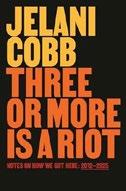
Incisive reportage on Black life and history by the noted journalist. Dean of journalism at Columbia, Cobb has a pronounced contrarian bent: He refuses, for one, to capitalize “Black,” writing, “Our existence as a community need not be premised on the canards of charlatans seeking to justify murder and slavery. The bonds of shared history and culture will suffice. In short, black people exist; Black people need not.” For another, he takes a pin to many a thought balloon, as in the idea that Barack Obama represented a post-racial America, noting archly, “Unlike the maligned mulattoes of old, Obama wasn’t passing for white—he was passing for mixed.” A case in point is Rodney King, savagely beaten by Los Angeles cops; days of rioting followed, police reforms were promised, but in the end nothing substantial changed. Cobb visits various points in American history, more often than not to find them wanting: His assessment of Abraham Lincoln, for instance, squares with historical critics who “undercut the inane idea that the formerly enslaved owed him anything at all, even a thank-you, for his self-interested decision to end a practice that the nation should never have begun in the first place.” The touchstones continue: Colin Kaepernick may have been brave for protesting system violence against
Blacks, but he still wanted to play football in a league complicit in that oppression; the 2018 electoral campaign pitting Stacey Abrams against Brian Kemp, marked by extreme voter suppression, is proof by his lights that “most elections are framed as a referendum on the future; Georgia’s race was about how much of the past had been dragged into the present.” Cobb’s remarks on the intertwining of journalism and history are invaluable, while his account of inequalities of health care and its list of victims within the Black cultural community is harrowing. Provocative, arguable, written with both bravado and great care: an exemplary collection.
Captain’s Dinner: A Shipwreck, an Act of Cannibalism, and a Murder Trial
Cohen, Adam | Authors Equity (448 pp.) $32 | November 18, 2025 | 9798893310597

Shipwreck accounts are an established genre, but this is well off the usual track.
Journalist and author Cohen, author of Imbeciles: The Supreme Court, American Eugenics, and the Sterilization of Carrie Buck, strikes gold with a story from Victorian Britain that comes with a scholar’s favorite documentation: court transcripts. In 1883 a wealthy Australian bought a used yacht in Britain and hired a crew to deliver it: an experienced captain, two crewmen, and a cabin boy. After six weeks sailing south in the Atlantic, a storm sank it. With only minutes to save themselves, the crew fled to its dinghy
with time to grab two cans of turnips and a few instruments but no water. After nearly three weeks, with all nearly moribund from thirst and starvation, the captain cut the boy’s throat, and all consumed his blood and organs “with quite as much relish as ordinary food.” Four days later, a ship appeared. The survivors did not conceal their actions, and their rescuers were not scandalized because all knew similar stories. Cohen describes half a dozen documented occasions and summarizes the history of human cannibalism before moving on to what followed after the men landed in England. Newspapers covered the story mostly favorably. No sailor in history had been prosecuted for cannibalism, so the men were shocked to be arrested and charged with murder. The decision came from the government where senior officials rejected the ancient tradition that allowed sailors in danger of starving to eat someone. More than half the book recounts the trials, which concluded for the first time in history that the men had committed homicide. Almost no one wanted them hanged, so they served six months in prison. Readers will likely agree with current legal opinion that denies that murder is justified when it can be presented as the lesser of two evils. A legal milestone and a good read.
Dando, Evan with Jim Ruland | Gallery Books/Simon & Schuster (304 pp.)
$30 | October 7, 2025 | 9781982175221
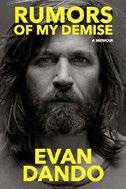
A singer-songwriter reflects on his life in the (too) fast lane.
The title of this memoir by the Lemonheads frontman is wry but fitting. The indie rocker has long had his fans worried about him—in the 1990s, he was open with reporters about his heroin and crack use, which, he writes, continued until recently and once cost him $400 a day. Dando revisits both his lows and highs, beginning with his
early years in Massachusetts, where he was an unenthusiastic student but an eager music fan. Dando writes, “I remember singing along to ‘One Way Out’ by the Allman Brothers and my dad said, ‘Your voice sounds good, Griff!’ My dad called me Griff, short for Griffith, which is my middle name. ‘Maybe you’re the rocker of the family!’” Dando and two friends founded the Lemonheads while they were still in high school (rejected band names included Yipes Stripes!, Popcorn Fucks, and the Piggy Popcorn Queers). The band took off quickly, which Dando attributes to their onstage antics: “They came to see a bunch of guys getting drunk and playing loud and fast. Part of the appeal of the Lemonheads was that it could all fall apart at a moment’s notice.” Fall apart it did, many times, with the lineup often changing, and while the band gained worldwide attention for its cover of Simon & Garfunkel’s “Mrs. Robinson” (about which Dando is ambivalent), the fame didn’t last, especially with Dando high and unreliable much of the time. The author writes with disarming candor and vulnerability, admitting that his actions hurt people; at one point, he writes, “If I could go back in time and give a bit of advice to myself, I’d say, ‘Evan, don’t be such a dick.’” He is also quite funny at times: “Opiates help you go to sleep. Sometimes they help you drop your face in your carbonara at a fancy restaurant. That’s not a good look.”
An amiable—and sometimes dark—self-portrait of a self-deprecating artist.
Deakins, Roger | Grand Central Publishing (416 pp.) | $45 | November 11, 2025 9781538771501

A cinematographer describes his craft. When Roger Deakins was growing up in Torquay, England, in the 1950s and early 1960s, he loved
painters and photographers, from Edvard Munch to Dorothea Lange, but except for taking pictures with an ancient Kodak Box Brownie camera, “the notion of a career with a camera did not ever enter my mind.” He also loved film but assumed it “was simply something that other people did.” Yet after Deakins graduated from the Bath Academy of Art, a friend mentioned the newly formed National Film School and suggested he apply. It took a couple of tries, but he finally got in. Since then, after several years of shooting documentaries on such subjects as yachting, war-torn Eritrea, and schizophrenia, he has had one of the most illustrious careers of any mainstream cinematographer. This informative hybrid describes the many films he has shot for such directors as the Coen brothers, Sam Mendes, and Denis Villeneuve and the techniques he has used to achieve his lighting and camera effects. Much of the book, lavishly illustrated with film stills and storyboards, can get quite technical, from the Agfa stock at 320 ASA he used to create the naturalistic look of Mountains of the Moon to the multiple lenses he used on The Shawshank Redemption . He writes about his work on animated films, including WALL•E , Rango, and How To Train Your Dragon . The longest chapters are devoted to the two films for which he received his Academy Awards, Blade Runner 2049 and 1917. Apprentice cinematographers will learn a lot from this book, as will anyone with a passing interest in the technical side of cinema. Deakins includes many behind-the-scenes details, such as when he reveals that the snowy scene in which a body is shoved into a wood chipper in Fargo required “a large amount of strawberry jam.”
Film school in book form from a great cinematographer.

DeSalle, Rob | Illus.
by
Patricia J. Wynne
Yale Univ. (336 pp.) | $32.50
November 18, 2025 | 9780300270945

A wide-ranging study of the evolution, chemistry, and allure of marijuana.
“As a full-time evolutionary biologist, part-time botanist, recreational user, and more than likely a future medicinal user, I find cannabis one of the most fascinating of all plants on our planet,” writes DeSalle, a curator of molecular systematics at the American Museum of Natural History. It’s fascinating indeed: A flowering plant, cannabis is a distant cousin of the grape (thus pairing nicely with a glass of wine) but is more closely related to hops (thus also pairing nicely with a pint of ale). The divergence from the latter took place about 28 million years ago, meaning that cannabis was known to early animal forms, including our ancestral primates, who, by DeSalle’s account, preferred the booze that they found in fallen fruit—thus becoming evolutionarily “preadapted” to getting high, a trait they passed along to their human kin. As the author notes, the earliest attested use of cannabis dates to about 12,000 years ago on the Tibetan Plateau, but soon after the plant spread all over Eurasia, so that “it is more than likely that any human group in those occupied areas was using cannabis in some way.” The author writes with an occasional winking reference, as when he titles one section of a chapter “Light Up or Leave Me Alone,” but in the main his text is rigorously scientific; it helps to have some background in botany and chemistry, as well as a tolerance for terms such as “xerostomia” and “cannabidiolic acid synthase.” Read on, though, and DeSalle sneaks in some popular culture, venturing that the Coen brothers’ film The Big Lebowski deserves the “highest” (wink, wink)
rank of films about weed and recommending that the medical establishment take a more relaxed attitude toward cannabis and allow it into “our medical toolbox.” Everything you ever wanted to know about pot. Just don’t try to read it when you’re baked.
Driver, Justin | Columbia Global Reports (280 pp.) | $18 paper | September 16, 2025 9798987053768

Opportunity for all.
For many Americans, affirmative action remains a pathway to economic and social advancement. Others, however, believe it to be an impediment to fair evaluation. This book by Driver, a professor at Yale Law School, shows how the Supreme Court played the defining role in determining the place of race and gender in the fabric of American life. It focuses on the 2023 case Students for Fair Admissions, Inc. v. President and Fellows of Harvard College (abbreviated as SFFA) as the decision that effectively killed affirmative action as a legally enshrined practice. Driver argues that the tradition of taking race into consideration in college admissions created opportunities for historically underrepresented minority students. The author presents material from surveys and studies to show that classroom and workplace diversity enhances intellectual inquiry and fosters a productive competitiveness in the economy at large. He also reviews the arguments against affirmative action: that it privileges identity over accomplishment; that it potentially advances students who are otherwise unprepared for “elite” institutions; that it runs counter to a race-blind ideal of American meritocracy. SFFA was, in the author’s view, a radical decision, one made not
transparently through argument and evidence, but disingenuously. Chief Justice John Roberts’ opinion “managed to violate virtually every tenet of the judicial approach that he announced [during his confirmation hearings]….The opinion evinced no willingness whatsoever to relinquish his own ideological priors in order to embrace the larger institutional considerations.” In short, SFFA was a product of changes in court personnel rather than of principled argument. It is now up to universities, the author argues, not to acquiesce in the face of judicial spinelessness or presidential extortion, but rather to fight vigorously for classrooms inclusive of all Americans, irrespective of the color of their skin or the thickness of their wallets.
A judicious assessment of the history of affirmative action, with strong arguments for diversity in the wake of its demise.
Fitts, Robert K. | Univ. of Nebraska (312 pp.) $36.95 | November 1, 2025 | 9781496244079

Japan’s national pastime.
Fitts, the author of several books about Japanese baseball, takes a close look at the inner workings of Nippon Professional Baseball through first-person accounts from players, front-office personnel, data analysts, business executives, and, engagingly, one of the urikos (“beer girls”) who lug hefty kegs through the stands: “When I poured a drink, I always smiled,” she said. “At night, after the games, my face usually hurt from smiling.” While the oral history format usually allows for a more personal approach, it’s hampered here, as the author acknowledges in his introduction, by the propensity of team owners to limit direct access to the players and staff and attempt to control the message. The result, while detailed, comes across at
times more like a “just the facts” approach than Moneyball, where the different strands were pulled together for a compelling narrative. Nevertheless, the author offers a clear picture of a thriving subculture that most American readers likely know little about, apart from passing familiarity with transplanted superstars like the Dodgers’ celebrated two-way player, Shohei Ohtani. Differences in the way the game is played are front and center. The Japanese prefer small ball—getting runners on base, bunts, steals, and moving things along—over Major League Baseball’s listless power game. Cheerleading is also hugely popular. When Saori Ogure, director of the Hokkaido Nippon Ham Fighter Girls, choreographed the viral “Fox Dance,” even players joined the fun. Former MLB manager Bobby Valentine, looking back at his time heading the Chiba Lotte Marines, said, “They knew how to play the game. They just needed someone to let them know that they knew how to play the game.”
An informative if sometimes dense read for curious sports fans.
Funneman, Sander | Illus. by Peter Brouwers | 23rd St. (304 pp.) | $29.99 November 18, 2025 | 9781250868404

From galaxies to grains of pollen, it’s electricity that connects everything in our universe.
Funneman argues his point convincingly in this ample graphic adaptation of 2020’s Electric Ecosystem by weight of example if nothing else. He begins with bees, which not only see glowing electric fields around the flowers they visit but, their bodies being positively charged, actually attract negatively charged pollen when they land. They and the many other organisms he goes on to mention can detect and navigate by
magnetic lines of force (thus explaining, for instance, why dogs tend to orient themselves north-south to poop), and they show measurable physical responses when exposed to different portions of the entire electromagnetic spectrum. The author cites research demonstrating that plants have nervous systems, that fungi and tree roots communicate using a distinct “electrochemical language,” and, startlingly, that many outbreaks of viral epidemics and pandemics coincide with solar cycles. On a broader scale yet, we are literally “plugged into the cosmos,” with the electrical fields of our planet, sun, and galaxy nested like matryoshka dolls and continually affecting each another in complex ways. When, as he writes in the course of all these big insights, “every raindrop, every snowflake…has an electric charge,” it hardly seems a stretch to characterize the penetration of eggs by sperm as an event governed by magnetic polarity or our own human consciousness as an electromagnetic field. Pausing for occasional flashbacks to introduce paradigm-changing scientists of the past, author and illustrator put most of this dense but easily absorbable barrage of established facts and suggestive research results into the mouths of a pair of modern tour guides who pop into view to lecture in various locales amid cleanly drawn images of flora, fauna, geophysical features, and dramatic electromagnetic manifestations. A jolting perspective changer.
Furmanovsky, Jill & Noel Gallagher
Thames & Hudson (304 pp.) | $65 October 14, 2025 | 9780500030646
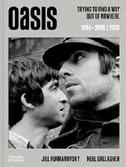
A photographic look at the Britpop pioneers. Furmanovsky has long been considered one of the greatest rock photographers ever, known for her images of, among others, Bob Dylan, Amy Winehouse, and Stevie Wonder.
She is particularly well known for chronicling the Britpop pioneers Oasis from 1994 to the band’s dissolution in 2009. (They notably reunited in 2024.) Her book collects more than 500 images—photographs, film strips, contract prints—mostly taken during the band’s mid-1990s heyday, which saw the release of the hit albums Definitely Maybe and (What’s the Story) Morning Glory? Some come from photo shoots, which Oasis co-frontman Noel Gallagher, who provides commentary throughout the book, admits he hates—and indeed, much of those photographs depict undisguised scowls from Noel and his brother, Liam. They’re beautiful pictures, but what really stand out are the candid shots, especially of the band performing. (These were not always easy to get, Furmanovsky writes: “Noel and Liam never stood together…the only way to get both of them in one picture during a performance was to take a photo when one walked past the other.”) Noel’s additions to the book are frequently hilarious: One photo, which shows fans in Philadelphia holding a sign that says “WE GOT POT” is accompanied by Noel’s text, “Yeah, if ever a band was not fucking weed smoking, it was Oasis. That ain’t going to get you backstage at an Oasis gig. If you said, ‘We’ve got cocaine,’ we’d have been like, ‘Right, get them in!’” Also providing excellent commentary by way of essays are publicist Johnny Hopkins and writers Simon Spence and Laura Barton. In her introduction, Furmanovsky calls photographing Oasis “the greatest chapter in my working life.” Paging through this joyful collection will make readers understand why. Beautiful photographs and enlightening commentary make this a wonderwall of a book.
Gamwell, Lynn | MIT Press (208 pp.)
$44.95 | October 21, 2025 | 9780262049962
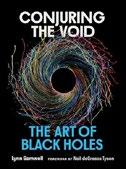
How to visualize the invisible. They were, from the start, an aberration: seeds of destruction planted in the laws of physics that could grow gravity so strong it would tear holes in space and time. Physicists tried to rid them from their equations to no avail—black holes are real. And they pose a real conundrum: How can we see something that eats not only light but darkness? It’s a question that Gamwell, art curator and historian, tackles in this arrestingly beautiful book. In 2019, she explains, the Event Horizon Telescope produced the first direct image of a black hole. It took a global array of telescopes forming an aperture nearly as wide as the Earth to capture the black hole in silhouette from 55 million light-years away. It’s an astounding achievement—but no less powerful are the metaphors that black holes provide in the hands of brilliant artists. “Once scientists discovered that the laws of physics no longer applied within a black hole, abstract artists drawn to irrationality were also drawn to black holes,” Gamwell writes. They stood for the darkness of the Holocaust, the erasure of atomic bombs, the bleak atmosphere of the Cold War. Full Stop by British artist John Latham, whose work deals with book burnings, shows what could be a black hole or a period at the end of a sentence—marking the end not only of space, time, and light, but of
How can we see something that eats not only light but darkness?
CONJURING THE VOID
EXTRACTING THE FUTURE
language, meaning, and discourse.
South African artist Kamil Hassim’s Event Horizon installed prisms in the former prison that held Nelson Mandela and other anti-apartheid politicians. “The terms ‘inescapable’ and ‘point of no return’ can certainly be applied to the Old Fort Prison Complex,” the author writes. A photograph of the piece showing refracted light converging on a person shrouded in darkness is haunting, as are so many of the works Gamwell has chosen—from Chiharu Shiota’s burnt piano and charred chairs wrapped in a cocoon of black thread to Anish Kapoor’s painting in Vantablack, a coating that absorbs 99.96% of visible light. For a topic so inherently mysterious and emotional, Gamwell’s prose is stilted and dry, but the art more than makes up for it. A stunning convergence of art and science that plumbs the depths of black holes, both cosmic and cultural.
Lithium in an Era of Energy Transition
Goodale, Mark | Univ. of California (304 pp.) | $29.95 paper | October 7, 2025 9780520402799

Examining Bolivia’s complex path toward embracing lithium.
Known as the Lithium Triangle, Bolivia, Argentina, and Chile hold vast reserves of the metal that may determine the future of electric vehicles and battery-based technologies. Goodale, a cultural and social
anthropologist at the University of Lausanne, tells a surprisingly contentious story of metal light enough to float on water. The author explores Bolivia’s turbulent political history—marked by coups, wars, revolutions, and shifting economic fortunes—alongside its efforts to control lithium production. He traces the country’s long-standing role in global resource markets, as Americans, Europeans, and Chinese investors vie to profit from Bolivia’s lithium, oil, and gas—enlisting scientific tools and satellites to scan Earth’s surface for deposits. Employing ethnographic methods and immersing himself in Bolivia’s mining and scientific circles, the author critiques extractive industries and their effects on Indigenous rights and livelihoods, contrasting these impacts with government ambitions for export-led growth. He highlights the irony in global climate strategies that hinge on mining a nonrenewable resource. Ultimately, Goodale contends that global capitalism—dependent on resource extraction— cannot meaningfully address climate change. The author’s blended anthropological, political, and historical approach yields a winding narrative that may challenge general readers with its academic tone, and in some sections additional sourcing would be helpful. A brief but compelling aside is lithium’s strange journey through uses in soft drinks, psychiatry, and green tech. Yet the core focus remains Bolivia’s fight to harness its lithium, amid political, economic, and environmental crosscurrents.
A book that raises a pressing question: Is Bolivia’s lithium a blessing or a burden?
Harris, Steve, Bruce Dickinson & Iron Maiden | Thames & Hudson October 7, 2025

Metal mania. It’s been 50 years since Harris, armed with his cheap bass guitar, founded what would become one of the bestknown bands of the new wave of British heavy metal, one that still packs venues all over the world. The rockers celebrate their anniversary in this visual history book, and it’s hard to imagine a more comprehensive one. Bookended by a foreword by Harris and a “backword” by singer Dickinson, the first pages point to how well preserved the Iron Maiden archive is, with photographs of a young Harris alongside some of his diary entries, fliers for shows, newspaper clippings, and images of the young band in action. The book tracks the band’s rise, from its appearance on the influential Metal for Muthas compilation to its worldwide breakthrough in 1982 with the now-legendary album The Number of the Beast, its first record to feature Dickinson on vocals. Each album and tour gets its own section, with admirable attention paid to cover boy Eddie, the band’s nightmareinducing, zombielike mascot, and the artist who created him, Derek Riggs. The band photographs by Ross Halfin and official band photographer John McMurtrie are excellent, but there’s much more: images of the band’s gear, galleries of concert T-shirts, and pictures of “Ed Force One,” the tour plane that Dickinson piloted. (The singer contains multitudes.) The text functions as an approachable and informative history of the band, highlighting its frequent personnel changes and its often literary lyrics, which at times drew from Samuel Taylor Coleridge, G.K. Chesterton, and Alfred, Lord Tennyson. This is an astonishingly well-documented and lovingly curated look at a band that
changed rock forever. Its fans will love it, but the appeal isn’t limited to them. A headbanging romp of a beautifully designed book.
iWar: Fortnite, Elon Musk, Spotify, WeChat, and Laying Siege to Apple’s Empire Higgins, Tim | Harper Business (288 pp.) $32 | September 16, 2025 | 9780063397941

Techies go to the mattresses, and the picture isn’t pretty. The opening tableau in Wall Street Journal writer Higgins’ narrative is a federal courtroom, Covid-19 era, in which Apple CEO Tim Cook faces a carefully mounted challenge by Tim Sweeney, publisher of the wildly popular video game Fortnite. Sweeney charged that Apple was a monopolist, an argument, Higgins writes, that had some merit: “With the advent of the iPhone, in order for other businesses to gain access to its marketplace, Apple had set up a drawbridge for all of the companies that wanted to make money through it.” That drawbridge was largely monetary: Apple took 30% of revenues for the sale of every app, “akin to a tax for breathing their air,” protecting its practice inside a “Walled Garden” that other entrepreneurs longed to storm. It didn’t help that throughout the app sales ecosystem, favorable rates were being extended to some app makers but not others, with Sweeney stating, “We’re all in for a prolonged battle if Apple tries to keep their monopoly and 30% by cutting backroom deals with big publishers to keep them quiet.” To complicate matters, after the Capitol insurrection of January 6, 2021, Apple removed the conservative social media app Parler, Amazon dropped Parler from its servers, and Facebook and Twitter shut down Donald Trump’s account; then tech magnate Elon Musk entered the fray, pushing the argument that the Big Four were not only monopolizing markets but also controlling free speech, and in doing
so he was “able to do something that Tim Sweeney…failed to do: frame Apple’s power in terms that resonated beyond the business.” Though, as Higgins chronicles, Apple survived most legal challenges, the debate continues as to whether the company and other giants are true monopolies—and just how much control over speech they exert.
A lively hook-and-tong tale of how megacorporations battle to rule the world—and the world’s consumers.
Hitt, Tarpley | One Signal/Atria (352 pp.) $30 | December 2, 2025 | 9781668031827

Toy mania. Journalist Hitt makes a lively book debut with a dive into the creation, marketing, and meaning of the iconic Barbie doll, Mattel’s huge moneymaker, launched in 1959. Finding the toy world to be “like the Pentagon,” “highly secretive, obsessed with the threat of espionage and the potential theft of secrets,” Hitt has mined archives and published sources to unravel the mystery of Barbie’s origins, the company’s internal machinations, and its battles against competitors. Barbie, she reveals, was based on a German newspaper cartoon figure called Lilli, who became fashioned into a plaything by a German toy maker. Lilli the figurine debuted in 1955, looking “like a plastic Marlene Dietrich—impossibly thin, synthetically perky, eyebrows angled over a sidelong gaze, already bored by her beholder.” Barbie’s American creator, the feisty Ruth Handler, bought several Lilli dolls on a European trip in 1956, probably having seen one first in a posh toy store on Rodeo Drive, a short distance from her Los Angeles home. Although toy mogul Louis Marx got an exclusive contract to sell Lilli in the U.S., Mattel prevailed after a lawsuit that went on for two years. From the first, the company understood Barbie not as “a terminal product that ends with the first
sale, but something to collect, nurture, and feed with a constant supply of costumes and accessories.” Hitt follows Barbie’s fortunes decade by decade, as Mattel strived to change with the times: offering diverse dolls in the 1980s, a President Barbie in 1992, and a roster of niche Barbies later. At the same time, the company mounted relentless infringement suits. By 2023, though, when Greta Gerwig’s movie satirized its clueless male leadership, Mattel finally realized that parody could be a boon for its brand. A shrewd take on cultural history.
The Girl Bandits of the Warsaw Ghetto: The True Story of Five Courageous Young Women Who Sparked an Uprising
Hyman, Elizabeth R. | Harper Perennial/ HarperCollins (352 pp.) | $19.99 paper October 14, 2025 | 9780063355019

Saying their names. In this uncompromisingly terrifying work of historical recovery, historian Hyman writes of the lives of the young women who led Polish Jewry into a period of confident self-awareness and then, ultimately, to the great and self-annihilating resistance of the Warsaw Ghetto uprising of 1943. Hyman retells a history of the Holocaust in women’s voices. She illustrates how they were educated in the traditions of religious learning and Hebrew language. The Zionist impulses of the 1930s found some of their most vigorous leaders in the women born in Poland after World War I. They worked in the interstices of Polish Jewish life. Because they were not physically marked like Jewish men, and because they were largely ignored by occupying German authorities, they could move back and forth among the Jewish and non-Jewish spheres of Polish life. “It is in recognition of these women’s psychological impact on the Jews of Occupied Poland, and
The author’s new biography reveals the kind soul behind a comedy icon of the ’80s and ’90s.
BY DONALD LIEBENSON
THERE’S A STORY in Paul Myers’ John Candy: A Life in Comedy that exemplifies everything the actor’s legion of fans would like to believe about him. Candy was starring in the romantic dramedy Only the Lonely, and, as the name above the title, he was given the luxury of a deluxe twin Teton trailer to use on set. His co-star, Maureen O’Hara, who’d come out of retirement to portray the character’s smothering mother, was given a smaller trailer. Candy was furious and demanded she be given accommodations befitting her legendary status. When the studio hemmed and hawed, he insisted on switching trailers with O’Hara. The producers finally relented.
“It does tell you a lot about him,” says Myers, who’s also written a book about the Canadian comedy troupe the Kids in the Hall. “He knew Maureen O’Hara deserved more and he wanted to make sure she felt the love. He cared deeply about everyone—the catering people, the person slinging cables on the set. When he himself felt disrespected, he was not shy about speaking up. I was told constantly while researching the book that he was exactly who you hoped he would be, and that’s so rare.”
Candy was a member of the famed Second City troupe in Toronto and a breakout star on the classic SCTV series alongside Eugene Levy, Andrea Martin, Joe Flaherty, Harold Ramis, Rick Moranis, Dave Thomas, Martin Short, and Catherine O’Hara. He made the transition to films and went from scene-stealing comic relief (Splash) to leading man (Uncle Buck). Then, in 1994, he died in his sleep of a heart attack at the age of 43.
Candy was one of the most beloved character actors of his generation. Stories like the one above were something of a relief for Myers, also a fan, who worried he might uncover something that would tarnish Candy’s memory and the public’s perception of him. But John Candy is no “Johnny Dearest.” It is, the author says, a fair, honest, and loving appreciation of Candy’s life and career. “Fans of John Candy will delight in Myers’ comprehensive biography,” writes our critic.
We spoke with Myers, comedian Mike Myers’ older brother, by phone from his home in Berkeley, California. Our conversation has been edited for length and clarity.


What was your introduction to John Candy?
SCTV. I grew up in Toronto. My brothers and I were big fans of comedy. We loved Monty Python and Saturday Night Live. When we heard [Second City] was coming to TV, we said, “Let’s see what they do.” We were kids; we didn’t go downtown to Second City’s theater. What was so cool about SCTV was that it was very low budget; it was like black box theater for television. I instantly loved John. Superficially, he could be compared to John Belushi in his physicality and loveable quality. You could tell he was a smart actor to do these different types of characters. Again, you’re a kid, you don’t articulate that, you just know he [is] great.
In writing a biography, as
in comedy, timing is everything. Why now for a book about John Candy? We were approaching the 30th anniversary of his passing, but I wanted to hold out for people I needed to talk to. I suggested to the publisher that the book coincide with what would have been his 75th birthday this year.
Who did you want to be sure to talk to?
I wanted to get to as many first-person interviews as possible. I had a list of people: Dan Aykroyd, Catherine O’Hara, David Steinberg (who gave John his first big break), Martin Short, Steve Martin, Ron Howard, and Tom Hanks.
These are not easy gets. They all wanted to talk about John. Tom Hanks is one of Hollywood’s busiest men, but he gave me so much time. He was so
detailed and glowing about his admiration for John. I was so gratified. I had a sense when I spoke with Catherine O’Hara that she wanted to give John a good send-off. She was there at the beginning of his career, and I think she wanted to make sure that if someone was telling John’s story that he was looked out for.
Dan Aykroyd was very public about the betrayal he felt by Bob Woodward’s unflattering Belushi biography, Wired. You not only got him to talk to you, but he wrote the book’s foreword. How did you gain his trust?
It’s so funny you said that. When I put him on my list, I said to my wife, “I wonder if he does interviews after
what happened with Bob Woodward.” But I’ve written other bios where I concentrate on the craft. He must have sensed my approach. Dan is so generous and a great storyteller. The foreword gave him a chance to make his statement for his friend [Candy,] whom he clearly loved. He’s such a great champion of talented people. I was just over the moon to talk to him.
What was your impression of John going into the book? That he was a boundlessly talented person whom everybody seemed to like and that he was a master of characters. And now you’re going to ask if my impression changed after writing the book. I learned that he
did internalize a lot of the body shaming he experienced. There were really horrible things in print about his body. Journalists in essence told him he didn’t look like he could be a romantic leading man in Only the Lonely. He did suffer the slings and arrows. He was constantly fighting for respect. He presented a happy face, and he wanted to make nice and wanted everyone to get along, but I feel like he did suffer more than we knew.
What is your favorite John Candy movie?
Planes, Trains and Automobiles. It shows John Candy’s full range. It has heart and madcap adventures.
Which of his films do you

think is underrated?
I don’t know what people think of Cool Runnings. It’s put in the Disney sports movie category. I personally think it’s great. I also have to say Michael Moore’s Canadian Bacon [Moore’s only comedy, a critical and commercial failure]. As political satires go, it is strangely relevant to our time and John Candy is pretty great in it.
You write about some of Candy’s unrealized projects. Some, like a film adaptation of A Confederacy of Dunces , are really intriguing. Which one would you have most liked to see?
Bartholomew vs. Neff, which was to have been directed by John Hughes and would have paired John with Sylvester Stallone in an action comedy about the feud between a disgraced former baseball player and his neighbor. But Hughes walked away from it, and then Stallone walked away. I would have loved to see that.
What do you hope readers and John Candy fans get from your book?
A fuller understanding of the brief but brightly burning candle that was John Candy and how he created his own language for comedy acting. I want readers to know what he left behind, and why to this day the people that I talked to still sigh when they talk about John Candy because they know how the story ends. But what he achieved while he was alive was influential beyond his time.
Donald Liebenson is a writer in Chicago.

The book by the Curb Your Enthusiasm actor will be published in November by Skyhorse.
Actor Cheryl Hines will tell the story of her life and career in a new memoir.
Skyhorse will publish Cheryl Hines Unscripted in the fall, the press announced in a news release. It calls the book “an inspiring, laugh-outloud, and deeply moving memoir that showcases Cheryl’s ability to find grace and humor in every chapter of her life.”
Hines was a relatively unknown actor and comedian before being

cast in the HBO series Curb Your Enthusiasm as the wife—and later ex-wife—of comedian Larry David, who played a fictional version of himself. She was nominated for two Emmy Awards for her work on the show. She later starred in the ABC sitcom Suburgatory
In 2014, she married Robert F. Kennedy Jr., the lawyer, environmental activist, and conspiracy theorist who earlier this year was appointed as the U.S. secretary of health and human services by President Donald Trump. Skyhorse has published several books by Kennedy, including The Real Anthony Fauci, A Letter to Liberals, and The Wuhan Cover-Up
In her book, Skyhorse says, Hines writes about her experiences on the set of Curb Your Enthusiasm as well as her marriage to Kennedy. “With humor, wisdom, and unflinching honesty, Cheryl navigates the highs and lows of fame, family, and an unexpected foray into politics—complete with twists no one saw coming,” the press says. Cheryl Hines Unscripted is slated for publication on November 11.—M.S.

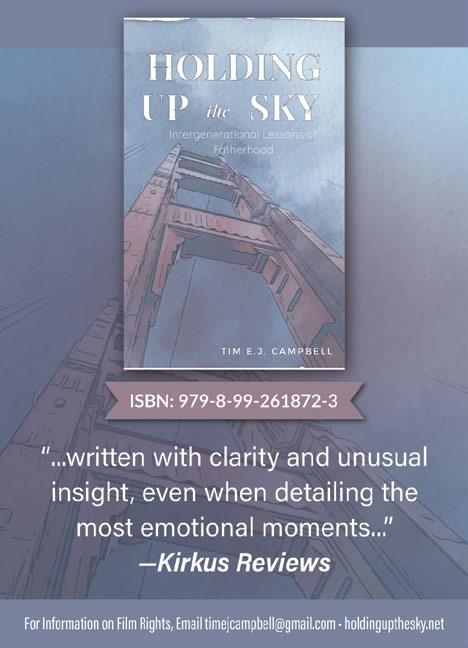


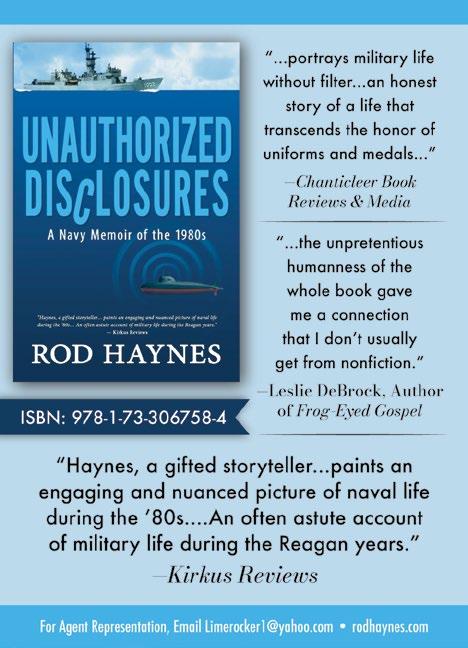

Reality Check , by the Jersey Shore star, was published in 2023.
Mike “The Situation” Sorrentino’s memoir is getting a film adaptation, according to the Hollywood Reporter. ITV America is making a documentary based on the reality television star’s Reality Check: Making the Best of the Situation—How I Overcame Addiction, Loss, and Prison, published by Ballast in 2023. “Sorrentino is ready to come clean in a revealing, no-holds-barred documentary,” the production company said.

Sorrentino first rose to fame as a star of the MTV reality series Jersey Shore, which chronicled the lives of eight mostly Italian American housemates in Seaside Heights, New Jersey. Although the series only ran for three seasons, it became a pop-culture phenomenon, spawning spinoff shows including Snooki & Jwoww. Sorrentino currently stars in a revival of the show titled Jersey Shore: Family Vacation
Sorrentino has had a troubled personal life, including an addiction to drugs, which he documented in Reality Check . He also served almost eight months in prison for tax evasion. He has said that he is now clean and sober.
“This project is more than just my story; it’s a raw, unfiltered journey through addiction, fame and redemption,” Sorrentino told the Reporter. “I hope this documentary inspires others to believe that no matter how far you fall, the comeback is always greater than the setback.”—M.S.

their roles in organizing and supporting the Polish Jewish underground, that they were dubbed the kashariyot ; a word derived from the Hebrew kesher, or ‘connection.’” Zivia Lubetkin, the sisters Frumka and Hancia Plotnitzka, Lea Perlstein, and Tosia Altman— these are among heroines of the story. In a day-by-day chronicle of the ghetto uprising, women appear, trying to run their households, moving among the resistance, building communities of survival. They come alive in letters, memoirs, and reminiscences. Theirs is a story of friendship against hardship. As one of them, Feigele Peltel, writing under the assumed name of Vladka Kowalska, said, “We formed a closeknit group, almost a family, each looking after the other….In the warm atmosphere of camaraderie, we felt much more secure and at ease than even in the best hideout.” We have no statues to their courage. Instead, we have this book.
Women of the Jewish resistance come alive in this revisionary history of the Polish Holocaust.
Irfan, Anne | Norton (304 pp.) | $29.99 October 28, 2025 | 9781324105954
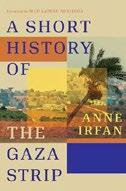
The events preceding October 7, 2023.
Irfan’s study of Gaza since 1948—the year Israel was established, “displacing the majority of the Palestinian population”—argues that several “critical episodes” can inform our understanding of the catastrophic 2020s. “To explain is not to excuse,” writes Irfan, a lecturer in interdisciplinary race, gender, and postcolonial studies at University College London who focuses on Palestinian refugee rights. Her account of wars, rebellions, atrocities, and short-lived governments highlights often-overlooked background to the ongoing humanitarian disaster in Gaza, which followed Hamas’
2023 deadly attacks on Israel. Much of the writing in this well-documented book is followed by endnotes pointing to Irfan’s sources. The “infamous population density” of the Gaza Strip, often cited in media reports on civilian deaths, took shape when 80,000 people living on the 141-square-mile piece of land saw their number more than triple with the arrival of 200,000 Palestinian refugees in the two years after Israel’s founding. While images of Palestinian boys throwing rocks at Israeli tanks “became an icon of the conflict’s asymmetry,” there were periods of relative openness and hope, Irfan reminds us. Malcolm X and other midcentury activists visited Gaza, and in 1998 President Bill Clinton landed at Gaza’s new international airport, which was destroyed in 2002 by Israeli airstrikes launched during the second Palestinian intifada. The author doesn’t seek false equivalents. Hamas and other Palestinian militant groups—so-called fedayeen, “the ones who sacrifice themselves”—have oppressed their own people, rallied around antisemitic lies, and murdered many unarmed Israeli civilians long before 2023. And for decades, Israel has used “collective punishment” and “disproportionate retaliation” in Gaza, killing tens of thousands of Gazans since 2023 and nearly halving the life expectancy of the area’s residents. Readers seeking context to the awful headlines from the region should seek out this thought-provoking book. Robust research underpins this judicious record of Palestinian life.
Isaacson, Walter | Simon & Schuster (80 pp.) | $20 | November 18, 2025 9781982181314

Words that made a nation. Isaacson is known for expansive biographies of great thinkers (and Elon Musk), but here he pens a succinct, stimulating commentary on the
Founding Fathers’ ode to “life, liberty, and the pursuit of happiness.” His close reading of the Declaration of Independence’s second sentence, published to mark the 250th anniversary of the document’s adoption, doesn’t downplay its “moral contradiction.” Thomas Jefferson enslaved hundreds of people yet called slavery “a cruel war against human nature” in his first draft of the Declaration. All but 15 of the document’s 56 signers owned enslaved people. While the sentence in question asserted “all men are created equal” and possess “unalienable rights,” the Founders “consciously and intentionally” excluded women, Native Americans, and enslaved people. And yet the sentence is powerful, Isaacson writes, because it names a young nation’s “aspirations.” He mounts a solid defense of what ought to be shared goals, among them economic fairness, “moral compassion,” and a willingness to compromise. “Democracy depends on this,” he writes. Isaacson is excellent when explaining how Enlightenment intellectuals abroad influenced the founders. Benjamin Franklin, one of the Declaration’s “five-person drafting committee,” stayed in David Hume’s home for a month in the early 1770s, “discussing ideas of natural rights” with the Scottish philosopher. Also strong is Isaacson’s discussion of the “edits and tweaks” made to Jefferson’s draft. As recommended by Franklin and others, the changes were substantial, leaving Jefferson “distraught.” Franklin, who emerges as the book’s hero, helped establish municipal services, founded a library, and encouraged religious diversity—the kind of civicmindedness that we could use more of today, Isaacson reminds us.
A short, smart analysis of perhaps the most famous passage in American history reveals its potency and unfulfilled promise.

Jeppie, Shamil | Princeton Univ. (240 pp.)
$27.95 | January 6, 2026 | 9780691273853

Empires of the mind.
This revelatory history by Jeppie, a historian at the University of Cape Town, explores the literate culture of the African city of Timbuktu. A center of empire during the darkest of the European dark ages, Timbuktu attracted learned scholars from all over West Africa and the Arabic-speaking world. From the 12th through 16th centuries, books were being made by hand—written in the Arabic script (though often in local languages as well as Arabic), drawing on Koranic learning, and rich with natural observation and political advice. We meet the 16th-century political philosopher Ahmad Baba, the scion of a respected West African family and the writer of advisory manuals that rival Machiavelli’s The Prince. His advice resonates with anyone who seeks power and preference: “Beware of the Sultan, because he becomes angry like a young boy but attacks like a lion.” And this: “The most wretched of all people in relation to the ruler and those closest to him, just as the things closest to the fire will burn the quickest.” Readers also learn of the Europeans who sought wealth and came back not with gold but with the gleanings of an intellectual elite. Reading this book makes us realize that in Timbuktu, as throughout precolonial Africa, communities of learning, devotion, and teaching lived as fully as those anywhere in Europe. As much as Christianity informed the universities of Oxford or Bologna, so Islam shaped the ways of reading and writing in Timbuktu. One manuscript from the 19th century has this at its top: “Written for a student in a state of mental confusion.” Reading this book, we all become new students, at the start confused about the legacy of Africa but, by the end, enlightened with the
knowledge that we need to seek new lands of learning. An eye-opening history of the intellectual life of West Africa, written with passion and erudition.
Jung, C.G. and Aniela Jaffé | Ed. by Shamdasani, Sonu | Trans. by Heather McCartney and John Peck Princeton Univ. (456 pp.) | $35 December 2, 2025 | 9780691193229

The analyst on the couch. Jung (18751961) was fascinated by the archetypes of symbol, understanding, and social life that, he believed, made up a kind of collective unconscious of humankind. Toward the close of his life, he published an autobiography, Memories, Dreams, Reflections, that sought to place himself in the great landscapes of human consciousness. There, childhood reminiscences dovetail with a lifetime of dreams. His book, however, was not the undertaking of the old man on his own. Instead, it grew out of a series of interviews and conversations, pieced together to create a seemingly seamless narrative. This new book publishes the transcripts of those interviews, enabling us to get behind the analyst and see the human being in all his vulnerability. “Yesterday I had a dream I’d like to relate to you: in the dream, I’m on a journey, or at a station….A wide field spreads out before me.…A dark expanse. Stretching into infinity. And there is an awareness in me that I’m on a journey.” Jung’s journeys were more like quests, searches for a holy grail of understanding. It’s not surprising, then, that he often invoked the legends of King Arthur to locate himself. Merlin is central to his story. He is “the great tragic figure from this
whole epic,” the magician who can solve any problem, who remains in exile but who sees more than any other. He is, in short, the figure of psychoanalysis itself. Wading through the stories in this long, often repetitive collection, we can glimpse, every now and then, light in the dark expanse. It’s like being trapped in one vast therapy session, waiting for awareness. The raw materials behind Carl Jung’s autobiography, full of insights for the patient reader.
Kelly, Jack | St. Martin’s (352 pp.) | $31 January 6, 2026 | 9781250331939
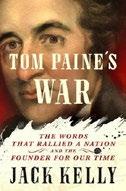
How a middleaged English immigrant’s words kickstarted the American Revolution and sustained it in its darkest days. The first chapter thrusts us into a minutely detailed account of the Battle of Kips Bay, which forced George Washington to abandon New York City to the British in September 1776. Thomas Paine was among the rebel soldiers who viewed those catastrophic events from their post across the harbor in New Jersey, and historian Kelly rolls back from there to explain how an artisan with bitter personal experience of England’s brutally unfair class system came to America at age 37. Then it’s back to more battles in the fall of 1776 before Part 4 finally gets to Paine’s arrival in 1774 and the publication in January 1776 of his fiery pamphlet Common Sense, which persuaded dissatisfied colonists that what they wanted from Great Britain was not better treatment but independence. It’s an odd way to launch into a gripping soldier’s-eye view of the string of losses that the underequipped, inexperienced American troops experienced in late 1776, climaxing in the loss of two forts
in New Jersey and Washington’s retreat west of the Delaware River, followed by a vivid analysis of Paine’s resulting we’re-not-licked-yet manifesto, The American Crisis. Once readers adjust to Kelly’s idiosyncratic organization, however, they will appreciate his ability to convey terrors and uncertainties of people who had no way of knowing how their struggle would turn out. Paine’s firsthand experience of those catastrophic battles gave him the moral authority, Kelly argues persuasively, to urge Americans to fight on. He reminds us that, in an age when many people could not read, Paine’s gift for simple, direct prose made his words equally effective when read aloud. Continuing with his detailed military history, Kelly depicts the reinvigorated patriot army following Washington across the Delaware in a bold gamble to turn crisis into opportunity. It worked, and the revolution would never be in quite such dire straits again.
History as lived in the moment, messy and galvanizing.
Kennedy, Anthony | Simon & Schuster (336 pp.) $30 | October 14, 2025 | 9781668052747

Plodding memoir by the long-serving Supreme Court justice. Bush v. Gore. and Citizens United v. FEC .— both cases inalterably changed the political climate of the U.S. Kennedy, though long pegged a liberal on the bench, joined the majority in each. As a memoir, his book follows the expected trajectory from birth to law school to a succession of federal court positions. As insight into the workings of the judiciary, it is mildly interesting. Kennedy’s legal philosophy is based on the idea that the law and a judge’s own views—he, like the majority of the bench today, is doctrinaire Catholic—need to be
carefully separated, such that in cases reviewing whether burning the U.S. flag is constitutional or women have the right to abortion, “it is not for judges to rule on the personal morality of a choice but rather on the permissibility of it under our Constitution.” That’s all well and good, particularly given the ideological bent of the court that became ever more pronounced after he left, courtesy of appointments spearheaded by President Trump, whom he mentions by name precisely once. But he proudly states that one of those appointments stands out: “It was immeasurably fulfilling that the President chose one of my former law clerks, Brett Kavanaugh, to take my place.” True, Kennedy led the way in ruling in favor of gay rights in four critical Supreme Court cases; still, the “liberal” tag seems unwarranted, especially in his insistence, for example, that he did the right thing in Citizens United , despite his earlier avowal, “Power is vested in the people.” And as for the outcome of Citizens United , he adds, in the most milquetoast of phrasing, “We should not be blind to the argument that it does seem troubling that large corporations or unions can now make unlimited independent expenditures in political campaigns.” A bland blend of autobiography and law 101.
Khatwa, Anjana | Basic Books (336 pp.) $30 | November 4, 2025 | 9781541604643

walked over solidified lava flows in south-east Kenya….This touchpoint experience sparked a fire deep inside me.” She travels the world and tells of the rocks she encounters, including one at Stonehenge: “‘See here ’ whispers Stone 56, the tallest of the sarsens at Stonehenge, ‘Can you sense the invisible traces of hands that once cleaved at rock? ’” In Petra, Jordan, the sandstones “whisper” of how “the river danced over the land.” These accounts might seem woo-woo to some readers, but Khatwa maintains that science, with its impersonal observation, measurement, and recording of data, can take us only so far in understanding the earth.
Silent stones speak.
Khatwa, an earth scientist and self-described “rock whisperer,” describes her book as a mixture of science and spirituality. “My love for rock began as a child when I
Traditional knowledge from Indigenous peoples who live in areas where rocks are or were located needs to be respected as well. She cites the display of a moai statue taken from Rapa Nui (formerly Easter Island) at the British Museum. The removal of the Willamette Meteorite from the Clackamas Chinook peoples of Oregon, who call it Tomanowos, is another example. The meteorite is at the American Museum of Natural History in New York City, where parts of it were cut into fragments for research purposes. For years, the museum and the tribe fought over ownership of Tomanowos, and tribal members now have access to the meteorite for ceremonies. As the author writes, “The story of Tomanowos neatly frames the dichotomy that continues to exist between communities who believe in the animacy of nature and those who adopt a more Western scientific approach. To bridge this divide, I believe that it is the scientists who need to shift their position so that they are willing to accept knowledge and expertise in its many forms.”
A “rock whisperer” shares vivid stories from deep time.

For more science books, visit Kirkus online.
Knowles, Charles | Celadon Books (304 pp.) $28 | January 6, 2026 | 9781250392923
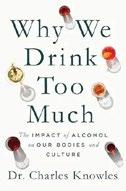
Thinking about drinking.
Problem drinkers who seek to get sober are told they will always remember their first drink and how it felt.
The mind-altering experience is indelible and life-changing. For Knowles, a British surgeon and professor, that moment came on a school trip in Germany at age 13 with a liter of lager. Nearly 30 years later, his love affair with our favorite drug ended with a half-empty bottle of Bacardi, a gun, and thoughts of suicide. In seeking to understand his own troubled relationship with alcohol, Knowles has produced a work that turns the magnifying glass on human society and history and how we developed a global relationship with a drug that has caused us great harm to our health and our relationships. These are questions many are asking in this moment, after alcohol consumption rates, which soared during the Covid-19 pandemic, are crashing. The number of Americans who drink has fallen to a 90-year low, according to a 2025 Gallup survey. Though not every person who drinks is addicted to alcohol or exhibits problematic behavior, many of us are reexamining our relationship with a drug that is legal, socially condoned, and often more dangerous than we like to acknowledge. The paradox, of course, is that drinking feels good to so many. We speak less openly of its wreckage. This investigation, the author is careful to note, is not a lecture: “I have no wish to ban alcohol or stop anyone who enjoys it from continuing to do so.” Nor is it a manual on how to get sober in 30 days. Rather, the book digs deep into the relationship with our favorite mind-altering chemical and offers a robust, thorough examination
of how alcohol seeped into our lives and the many ways it endangers them. A comprehensive look at the human relationship with alcohol, at a time when many are beginning to question it.
Kolb, Rachel | Ecco/HarperCollins (304 pp.)
$29.99 | September 16, 2025 | 9780063375185

A deaf writer explores her relationship with language. At the age of 23, author Kolb became “the first signing deaf person” to be awarded a Rhodes scholarship. Although she revels in this victory, she is disappointed with the media’s framing of her story as a triumph over her disability. She writes, “Despite This is the word that jars me most. As if excellence and fulfillment are somehow at odds with living in a deaf body.” Throughout her life, Kolb resists the idea that her deafness is an obstacle rather than an integral part of her humanity. As a child, she works hard at speech therapy, not because she wants to fit into the hearing world, but because she craves control. She writes, “If I spoke well, then those words would forever be my own. I would prove myself to be the success I wanted to be. I would never again need anyone or anything else to speak for me.” Navigating landscapes ranging from deaf summer camp to college life before and after receiving a cochlear implant transforms Kolb’s sense of self and her relationship with her deafness. Being deaf, she writes, is about learning that “there was always a way to sort out what someone else had meant,” treating the body as “the text,” and understanding
that “speech isn’t the real measure of one’s intimacy with English, nor is English the real measure of one’s intimacy with language.” Kolb masterfully uses her life story as a springboard for reframing deafness and, more broadly, disability from an assets approach. Her lyrical prose and trenchant analysis upend non-deaf people’s limited conceptions of language, exposing the limitations of a world defined by hearing. An exquisite memoir about deafness that brilliantly shatters our ideas about language.
Kolbert, Elizabeth | Crown (320 pp.) | $32 November 4, 2025 | 9798217086061

A lens on “an extraordinary time.” In 17 long-form essays, all but one of which were originally published in the New Yorker in the past two decades, environmental journalist Kolbert gracefully balances a realistic awareness of losses brought about by human activity—particularly by the use of fossil fuels—with a sense of wonder at just how much there is still to learn about this “little-known planet” and admiration for those who quixotically explore and attempt to heal it. Often, she travels with the subjects of her profiles, as when, in the title essay, she accompanies entomologist David Wagner on a caterpillar-collecting expedition in Texas, finding “one marvel after another.” The book includes brief notes on many of the essays, updating the reader on whatever
situation an essay describes. While certain undercurrents run through the pieces, notably a brief rehearsal of how Earth has warmed over the past centuries and how impossible a quick turnaround of that trend is, the book doesn’t feel repetitious. The author’s emphasis on the particular, and her quirky sense of humor—evident, for example, in her descriptions of her adventures in beekeeping as documented in “Stung”—make the pieces fascinating variations on a complicated theme in which despair and hope dance together. Horror and admiration mix in essays like “Killing Mrs. Tiggy-Winkle,” which evokes in gruesome detail the delight that New Zealanders take in disposing of the invasive mammals that have hurt the ecosystem there. Kolbert isn’t afraid to tackle difficult topics: A section of pieces grouped under the title “Big Ideas” addresses questions such as “Should the Natural World Have Rights?” and “Can Carbon Dioxide Removal Save the World?” Thought-provoking speculations about a world on the edge of violent change.
Leibovitz, Annie with Chimamanda Ngozi Adichie, Susan Sontag & Gloria Steinem | Phaidon (493 pp.) | $99.95 November 4, 2025 | 9781837290499

Homage to an iconic portraitist. In a lavish celebration of photographer Annie Leibovitz, Phaidon has republished her 1999 volume of women’s portraits, with an introduction by Sontag, along with a second volume of recent portraits, with essays by Steinem and Adichie. Totaling 250 in all, the portraits, as Sontag writes, stand as “an anthology of destinies and disabilities and new possibilities.” Reflecting Leibovitz’s reputation as celebrity portraitist, Volume 1 is aptly star-studded, featuring Drew Barrymore, Patti Smith, Hillary Rodham Clinton, Yoko Ono, Serena and Vanessa Williams, Katharine Graham, and Martha Stewart, among many others. But Leibovitz
also focuses her lens on women out of the limelight: a mountain biker and sewing machine operator, a waitress and two battered victims of domestic violence. “The ensemble says: So this is what women are now,” Sontag writes. “One of the tasks of photography is to disclose, and shape our sense of, the variety of the world. It is not to present ideals.” Steinem reiterates that message, adding that “Annie’s images demanded that women be seen” in all their variety and as a “proud reflection” of “feminist rebellion, self-respect, visibility and humanity.” Each essayist asserts that beyond their impressive artistry, the portraits convey an important message about beauty, power, and agency: “Any book of photographs of women,” Adichie writes, “simply by existing, has taken a political position about the value of women’s stories.” Volume 2 is replete with images of actors and activists, politicians and writers, musicians and scientists, young and old, among them Kara Walker, Michelle Obama, Greta Thumberg, Joan Baez, and Kim Kardashian. Each volume contains thumbnail biographies of the women portrayed; what is lacking, however, is the date the photograph was taken, which would be helpful information. An opulent coffee-table tribute.
Kirkus Star
Palace of Deception: Museum Men and the Rise of Scientific Racism
Lunde, Darrin | Norton (288 pp.) | $29.99 November 4, 2025 | 9781324065678
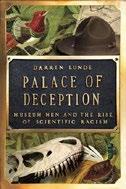
The troubled past of a major museum. Lunde, mammal collection manager at the National Museum of Natural History, recounts the early decades of the American Museum of Natural History, which opened in 1877 on what was then a remote tract in upper Manhattan. From the first, its mission was “the promotion of moral lessons through the use of science.” Those moral lessons, Lunde reveals, were informed by prevalent assumptions about
man’s dominion over nature and white man’s supremacy. Lunde’s narrative stars three men most prominent in shaping the museum’s identity: the wealthy and well-connected Henry Fairfield Osborn, hired as the first curator of paleontology and serving as the museum’s president from 1908 to 1933; intrepid explorer Roy Chapman Andrews; and Carl Ethan Akeley, a pioneering taxidermist, who once killed a leopard with his bare hands and later survived being mauled by a bull elephant. To amass the collections, they raised funds for and carried out expeditions in Africa, Asia, and South America to bring back specimens, trapping and shooting as many animals as they thought they needed for their displays. Their haul was often huge: Akeley, for one, collected 80 tons of whale skeletons in Japan. The decades of expansion for the museum coincided with the rise of eugenics, which held that certain moral, intellectual, and behavioral traits were inherited and that Nordics, the pinnacle of human evolution, had a separate origin from peoples of Africa. Osborn’s Hall of the Age of Man reflected this pseudoscience. “To Osborn,” Lunde writes, “humanity was a race-based social hierarchy, with the likes of himself at the top.” Even as he exposes the “exploitative ideas and practices” that pervaded the museum’s early days, Lunde acknowledges too the lasting treasure that shines as these men’s legacy.
A colorful, authoritative history.
Man, John | Pegasus (384 pp.) | $29.95 December 2, 2025 | 9781639369973
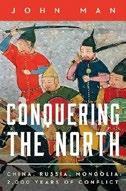
China quarrels with the West but expands to the north. Not everything north of China is Russia, writes historian Mann, author of The Great Wall: The Extraordinary Story of China’s Wonder of
the World. Much of it is Mongolia. Beginning in the centuries before the common era, he recounts the history of China’s growth. Inevitably, this took place to the north and west, mostly by conquest, so this is essentially 300 pages of battles interspersed with the author’s visits to areas of historical interest, ruins, and passages describing China’s current policies. China itself did not get its act together without repeated centuries of infighting and then proceeded to enlarge its borders. Neighbors often found Chinese culture appealing and adopted it, and China itself was not shy about sharing its wealth in the form of bribery of pugnacious opponents. It also invested heavily in the well-known wall, which was effective if heavily manned. Mongols under Genghis Khan (1162-1227) conquered the largest empire in history, and his heirs ruled China until expelled by the Mings in 1368. He remains a figure worshipped, often literally, throughout Asia, and his relics (rarely authentic) are tourist attractions throughout China despite being ravaged in 1968 by Red Guards during the Cultural Revolution. An expansive Russia reached the Pacific in 1639, and the Mings and the succeeding dynasty, the Manchus (1644-1912), fended it off while working to reconquer Mongolia. Unconquered “outer” Mongolia took advantage of the Manchus’ 1912 collapse to declare independence but was scooped up in the Bolshevik Revolution to become a satellite, regaining independence after the 1990 Soviet collapse. Today China dominates its tiny economy (below Jamaica in size, a thousandth that of China). The 3.5 million Mongolians to the north have no interest in joining the 6 million already under Chinese rule, but this is a decision for China’s leaders to make. Manifest destiny, the Chinese version.
Mangan, Lucy | Pegasus (304 pp.) | $28.95 February 3, 2026 | 9798897100446
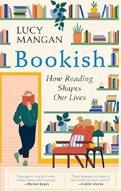
Reading like your life depends on it. Ask journalist and author Mangan what she did as a child, and she will tell you what she read. Her book maps the growth of her mind and body through the pleasures of the text. She never felt more grown-up, she recalls, than “when I first took my seat opposite the newspaper spikes…and started doing my homework [in the library] for the first time.” She goes to university with a great love for Jane Austen. She quotes Virginia Woolf: Austen “was the most difficult to catch in the act of greatness.” And yet, learning about “free indirect discourse” as an undergraduate, Mangan found Jane’s greatness in her way of both “inhabiting and viewing a consciousness at the same time.” The books that Mangan loves, then, are those that bring such consciousness to life. We are the heroes of our own novels, and like all great novelists, we must learn to see our childhood from our own adult perspective. We must become like Dickens or Charlotte Brontë, able to inhabit a young narrator but always to have the perspective of maturity. The best books are those that show the child in the adult and the adult in the child: “The real magic of the books…lies in the seriousness with which the childish pursuits are treated.” She thus advises: Follow “your bookish instincts.” Read not just to escape the world but to live in it, to learn how to negotiate a friendship,
As Mel Brooks himself said, “No Sid Caesar, no Mel Brooks.”
WHEN CAESAR WAS KING
hold a job, and find that “precious constant in a life that increasingly seems to have too few of them.” Some live to read. Mangan reads to live. An enthusiastic paean to the comfort, joy, and self-awareness that we find in literature.
Margolick, David | Schocken (352 pp.)
$30 | November 11, 2025 | 9780805242553

Lively biography of the original king of TV comedy. “No Sid Caesar, no Mel Brooks.” So said Brooks himself, who spent years with Caesar as both friend and writer. Caesar ruled the airwaves in the mid-1950s, earning a then-astonishing $25,000 a year (about $300,000 today) and revolutionizing comedy with deeply philosophical sketches mixed in with silliness and his patented double-talk in many an invented language. Even Albert Einstein took time out of his week to watch Caesar’s Hour —fittingly, since in high school, by journalist-turned-author Margolick’s account, Caesar excelled in science and held Einstein as a personal hero. Yet underlying his comic genius was a roiling rage, unusually pronounced even in a profession known for misfits; Neil Simon called him “extremely smart but completely inarticulate.” Joining him was a battery of “very gifted, neurotic young Jews, punching our brains out,” as Caesar scriptwriter Larry Gelbart put it, that included a young Woody Allen. Renowned for his strength and legendary appetite—he could polish off four steaks at a sitting before going home to eat his real dinner—Caesar felt the toll of success and the stress of keeping his show fresh, and in that he was a pioneer, bringing on guests and players such as the singer Lena Horne and the brilliant comic Imogene Coca. For all that, by the 1960s Caesar was effectively over, his arch comedy series replaced by “pleasant
shows about pleasant people.” One of them was the meta program The Dick Van Dyke Show, with Caesar veteran Carl Reiner in the Caesar role. More anarchically fun was Saturday Night Live, which an embittered Caesar hated with a passion: “During his Dark Period,” Margolick writes, “Caesar had viewed all younger comics as enemies, stealing from him the laughs he no longer got himself.”
Both a life and a cautionary tale, of great interest to any fan of golden era television.
Marsden, Philip | Counterpoint (352 pp.) $28.97 | November 4, 2025 | 9781640097445
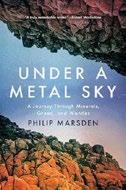
Pursuing the “strange abstract hunger that follows us all.”
A rock hound and fossil fanatic from childhood, Marsden, a Fellow of the Royal Society of Literature, grasped early on that another world lay hidden beneath our surface realm. The Cornish author’s book bores into the history, science, and consequences of mining and metallurgy, accorded greater depth and range by personal experiences and his recent journeys to European mines and mining towns. He explores metals and metal-bearing matrixes integral to human culture—ochre, tin, peat, bronze, silver, radium, aerolite, mercury, copper, gold, lithium, and soil—and the veins our uses of metals have taken. But just as fascinating are his reflections, mythological asides, and the historical figures whose lives he alloys with the narrative. Chief among Marsden’s essays on disparate but
notable individuals is a magisterial appreciation of Goethe. In many respects, the history of metals defines the strata of human development, with pivotal successes and sometimes deadly consequences. Marsden, also a gifted fiction and travel writer, invests a portion of the book in a reconsideration of alchemy, long “eclipsed by the glare of reason and the Enlightenment,” but whose arcane texts are now regarded as a proto-science, with methodologies and a spirit of discovery that helped spur the scientific revolution. Yet as Marsden demonstrates, all things have their price, in metals’ case those of greed, resource depletion, and environmental decay. His study also yields nuggets of insight into the Big Questions, offered with humility. And girded throughout by some of the loveliest descriptive writing one will read anywhere: “Beneath our feet, if we look closely, are shards of heaven, and overhead are wonders too, and everywhere is the ceaseless dance of the universe— endlessly moving, endlessly changing, endlessly mysterious.”
An exploration of minerals that gleams with substance and authority.
Martínez, Gabi | Trans. by Ezra Fitz Restless Books (416 pp.) | $22 paper November 11, 2025 | 9781632064035
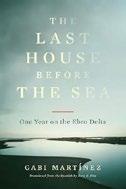
Observations from the front lines of an endangered landscape.
Just before turning 50, author and journalist Martínez arranged to spend a year in Buda, an island owned by the Gallart family at the tip of Spain’s Ebro Delta,
“Shards of heaven” beneath our feet.
which is anticipated to be “ground zero for Europe’s first climate refugees.” Over the past hundred years Buda has transformed from a place of leisure to one meant for investment; both its natural and monetary returns have deteriorated through industrial production, national environmental regulations, and the broader economic landscape. In his attempt to “rescue” the island, heir Mateo Gallart has become a rare combination of landowner and local, an outspoken, fiery advocate for the delta, decrying its looming destruction along with the shortsightedness of environmentalists and the questionable motives of the bureaucratic La Administración. In Buda, Martínez embeds with a small community of remaining rice farmers, fishermen, and bull ranchers, toiling under the eye of the militant supervisor Simona and the accelerating threat of climate change. His record bears witness to the transition caused by rising seawater and reflects transitions in the author’s own life—his milestone birthday, the decline of his aging father. Each industry, interest, and individual that Martínez encounters is presented with tender respect, quiet amusement, and a deep appreciation for natural wonder, the cycles of history, and the human predicament of those who know and love the delta best. But these stories, like everything in any delta, are momentary foci, pieces of sediment undergirding the shape-shifting of the whole. The mission of preservation is, like the land itself, murky and muddied, a product of progress and growth both triumphant and misguided; urgency swells and subsides like waters amid daily livelihoods. Martínez’s account, in content, structure, and style, mirrors this nuance and complexity, resisting myopic quick fixes and even easy catastrophizing. A steady, tempering, enigmatic chronicle of a polarizing, and ultimately personal, ending.

McCracken, Elizabeth | Ecco/ HarperCollins (208 pp.) | $24.98
December 2, 2025 | 9780063375291

Pithy nuggets on writing well.
Novelist, short story writer, and memoirist McCracken draws on her experiences as a student, writer, and creative writing teacher to offer 280 concise reflections—not rules, but guidelines—on writing fiction. Confessing a dislike for craft books and skepticism about the value of workshop critiques, still she acknowledges the value of sharing insights, some gleaned from teaching, many from failures and frustrations in her own work. “I try not to dispense imperatives,” she says. Organized by “vague broad concepts, digressions, flights of fancy,” the book covers topics typical of any writing guide: generating ideas, outlining, types of narrators (first person, singular or plural; second person; third). “All narrative decisions,” McCracken advises, “are more interesting when you think about the mobility they grant you instead of the mobility they restrict.” Narrators, in other words, should fit a writer’s goals. “Beware of any dispenser of writing advice who deems one sort of narrator better than another.” Writers would do well to be wary of any hard and fast rules: about the use of present or past tense, punctuation, and process. “No process is wrong that leads to the first draft of a book,” she asserts. As for the dictum “Write what you know,” she thinks it’s simply silly. “If you already know it—if there’s no mystery—what’s the point in writing it?” She does hold strong opinions, though, on such matters as adverbs, writing about children, and the muchdebated concept of “voice.” She cautions beginning writers against looking for approval: “Why do I write these days? I want to be loved. But I don’t care whether anybody approves of me.” Every writer, she believes, has the same mantra: “I am a genius with much to learn.”
A witty, generous guide.
Noble, Lauretta Malloy & LeeAnét Noble Amistad/HarperCollins (256 pp.) | $29.99 November 18, 2025 | 9780063352223
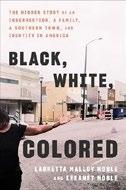
A tribute to a larger-than-life father that sheds light on race, identity, and American history.
Mother and daughter Lauretta Malloy Noble and LeeAnét Noble honor the life of Lauretta’s father, Lawrence Edward Malloy Sr., a man who “embraced his Blackness as a badge of honor” and regaled his daughter, and most people he encountered, with stories of his family’s life in Laurinburg, North Carolina. After his death, the Nobles set out to learn more about the family and the town that loomed so large in Malloy’s life. Their work is at once personal and political: “Stories about towns like Laurinburg fill in the deliberate gaps in Black history. They live in between the lines and references, taking space solely in the hearts and minds of our elders.”
The Malloy family experience is interwoven with aspects of U.S. history that many Americans would prefer to ignore, including the horrific violence perpetrated by the Red Shirts (a white supremacist organization) and systemic efforts to eliminate political and economic gains made during Reconstruction. The Nobles balance this history with accounts of the resilience of their family and other Laurinburg community members, “the people who triumphed amid chaos, who found ways to fight through generations by planting seeds that would continue to grow after they passed away. Now, more than ever before, we need to see a path to reinvent, to persevere, and to heal.” Such perseverance is apparent in the 1904 founding of the Laurinburg Institute, “the first Black boarding school in the United States” that “was responsible for the education of jazz musician Dizzy Gillespie, the
families of director Spike Lee and actor Danny Glover,” among others. The historical context, which includes quotations from general interest websites, can be stilted, but the prose shines brightly in the more personal passages, particularly those recounting the sights and sounds of Malloy family gatherings. A personal exploration of two centuries of family, community, and identity in the South.
O’Connor, Danny Boy and Jimmie Tramel Viking (416 pp.) | $25 | November 4, 2025 9780593622988

A n intimate account of the enduring legacy of The Outsiders, particularly its 1983 film adaptation. Decades after its initial publication in 1967, S.E. Hinton’s novel about Socs and greasers rumbling in Tulsa, Oklahoma, remains an archetypal and much-assigned novel about teenage alienation and class anxiety. Francis Ford Coppola’s film version, shot on location, assembled a cast of then-unknowns playing the greasers: Matt Dillon, Tom Cruise, Ralph Macchio, Patrick Swayze, Emilio Estevez, Rob Lowe, and C. Thomas Howell. (The biggest name before shooting was singer Leif Garrett, playing one of the Socs.)
O’Connor, a former member of the hip-hop group House of Pain, was thunderstruck by the film when he first saw it, stoking an obsession that ultimately prompted him to purchase a Tulsa home used in the movie and convert it into an Outsiders museum in 2019. It also prompted him (with the help of Tramel, a Tulsa journalist) to research this oral history. Not every cast member participated—Howell, Macchio, and Garrett do most of the talking from that perspective—but the two tracked down hosts of extras, producers, crew members, and more, making for an obsessively thorough study of the production.







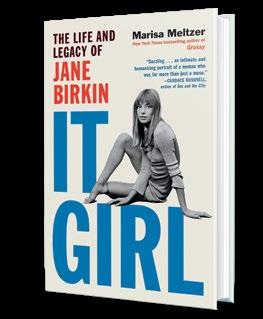
Claire McCardell By Elizabeth Evitts Dickinson Debut biographer Dickinson digs up buried treasure in this essential and inspiring account.
Make It Ours By Robin Givhan A finely tailored biography of a prestigious designer.
Walk Like a Girl By Prabal Gurung An insightful and entertaining look into the life of a famous fashion designer.
Yves Saint Laurent and Photography Edited by Elsa Janssen
An elegantly produced homage.
It Girl
By Marisa Meltzer
An affectionate and appealing account of the young Englishwoman who became a French icon.




Amistad will publish the couple’s The Way Love Goes next year.
Rapper Da Brat and her wife, Jesseca “Judy” Harris-Dupart, will write about their relationship in a new book, People magazine reports.
Amistad will publish the couple’s The Way Love Goes: A Guide to Building a “Beaurtiful” and Everlasting Relationship next year. The press calls the book “laughout-loud funny and filled with warmth and love.”
Da Brat first rose to fame in 1994 with her album Funkdafied and went on to release the albums Anuthatantrum; Unrestricted; and Limelite, Luv & Niteclubz. She married Harris-Dupart, an entrepreneur, in 2022. The couple stars in a reality television series, Brat Loves Judy.
Amistad says of the book, “Told in Da Brat’s signature Chicago tone, and Judy’s distinctive New Orleans patois, they each take turns detailing
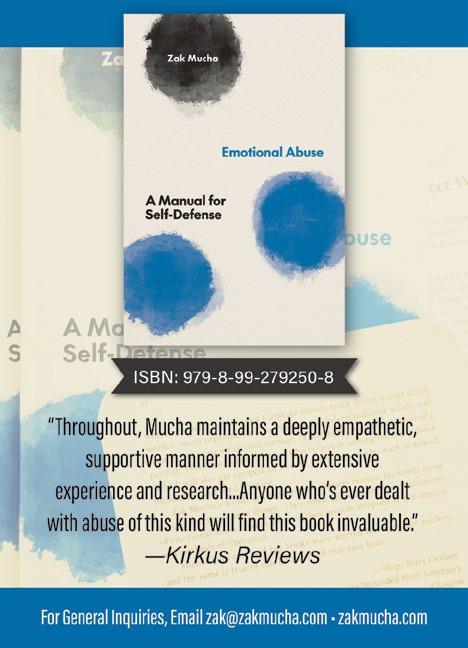
common relationship challenges, from sharing successful and meaningful communication to creating balance to coping with jealousy—and how they conquered them.”
“We’re beyond excited to finally share our story in this book,” the co-authors told People. “It’s raw, it’s real, it’s us—full of love, lessons, laughter and everything in between.…We hope readers
thoroughly enjoy our journey and how we sustain a happy and successful partnership.”

The Way Love Goes is scheduled for publication on February 3, 2026.
—M.S.


Anecdotes about extras’ haircuts and wardrobe decisions feel like overkill, but entertaining details abound: how producers shared the script with high schoolers for input, how Coppola shunted the greaser actors into worse digs than the Soc actors’ to stoke the class-war vibes, and the cast’s various off-screen hijinks. Everyone was trying to establish themselves, but they were also eager to please Hinton, who plays a matriarchal role in the story: approving or criticizing the film, a short-lived Outsiders TV series, and a Tony-winning 2024 Broadway musical adaptation. For any fan of the book, film, and beyond, this is as thorough as it gets.
An entertainingly comprehensive study of a book, film, and fandom.
Kirkus Star
Only God Can Judge Me: The Many Lives of Tupac Shakur
Pearlman, Jeff | Mariner Books (464 pp.)
$29.99 | October 21, 2025 | 9780063304574
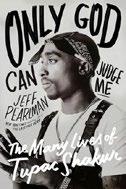
Inside the brief, brilliant, and tragically reckless life of Tupac Shakur (1971-1996). Pearlman, a sportswriter by trade (The Last Folk Hero: The Life and Myth of Bo Jackson, 2022, etc.), seems an odd fit as a biographer of a hip-hop icon, but his reportorial chops and distance from the hip-hop world are largely an advantage here. He uncovers a complex persona who at once dominated ’90s and rap and succumbed to its worst influences. Shakur was raised in New York and Baltimore by his mother, Afeni Shakur, who worked with the Black Panthers and other groups devoted to improving Black lives. But it’s more correct to say he was hardly raised at all, as she fell victim to a crack addiction in the ’80s. Shakur found a sanctuary at a Baltimore arts school, and the acting skills he developed there served him well when he headed west. In the early ’90s he
A rising film actor and rapper who could also be wildly mercurial.
ONLY GOD CAN JUDGE ME
was both a rising film actor and rapper (“I always thought he was one or two movies away from Academy Award talk,” said his Gang Related co-star Jim Belushi), but internally he was going south. He could be wildly mercurial—Pearlman’s sources suggest Shakur had undiagnosed ADHD—serving prison time for sexual assault, suffering paranoid delusions (particularly around rival MC Biggie Smalls), and, at the instigation of record exec Suge Knight, developing a belligerent persona that insiders felt was forced (his infamous “thug life” tattoo puzzled many) and speeded his murder in Las Vegas. Pearlman spoke to many in Shakur’s orbit, from family (his sister, Set, is particularly poignant and observant) to entourage members, to the man who, abandoned as a newborn, inspired Shakur to write his classic “Brenda’s Got a Baby.” A thorough accounting of a complex figure.
Phillip, Abby | Flatiron Books (352 pp.)
$30.99 | October 28, 2025 | 9781250806314
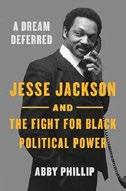
A sympathetic yet nuanced examination of the civil rights leader’s complex legacy.
In this incisive account of the trailblazing and often controversial civil rights leader and presidential candidate, CNN anchor Phillip brings a seasoned reporter’s sharp research and keen insight to the inner workings and significant accomplishments of this complicated but compelling figure. Phillip traces Jackson’s formative
years in Greenville, South Carolina— from discovering his birth father was a married neighbor who had impregnated his teenage mother, through his college experiences with segregation that propelled him into civil rights activism and eventually to the Southern Christian Leadership Conference under Martin Luther King Jr. Jackson’s presence at King’s assassination and his subsequent news appearances in a bloodied shirt created lasting tensions within the movement’s leadership, as peers suspected opportunism. As Phillip notes, “Those tense days made Jesse Jackson infamous and planted the seeds of suspicion among his peers and the King family that would never really go away.” The core of Phillip’s narrative examines Jackson’s groundbreaking presidential campaigns, particularly his 1988 run, when he secured several primary victories before finishing second to Michael Dukakis. These historic efforts would later pave the way for Barack Obama’s successful campaigns, though Phillip acknowledges that Shirley Chisholm had blazed an even more challenging trail as a Black female candidate. Jackson’s charismatic media presence and faith-infused speeches built an unlikely coalition extending beyond the Black community to marginalized white voters, including struggling Midwest farmers. As Phillip explains, “The coalition he sought was one that intended to unite marginalized groups and whites to create a powerful majority [and] would tie together aims of racial, gender, and religious justice with commonly held economic demands.” This ambitious vision became Jackson’s signature political strategy. Noting a striking irony, Phillip suggests that Donald Trump’s populist outsider campaign may have done more to validate Jackson’s 1980s blueprint than Obama’s historic victory.
An admiring yet unflinching portrait convincingly weighing Jackson’s contributions against his contradictions.
Plokhy, Serhii | Norton (432 pp.) | $31.99 October 21, 2025 | 9781324051176

From two nuclear weapons in the world, 80 years ago, to 12,500 warheads around the globe today. The development of nuclear weapons divided the world both militarily and technologically into the haves and have-nots, as Harvard historian Plokhy writes. In 1945, the only “have” was the United States, but the Soviets, Britain, and France quickly developed their own weapons, creating what Winston Churchill called a “balance of terror,” with fear being the leading factor in efforts to control the use of atomic weapons and the proliferation of nuclear materials and technology. Treaty negotiation efforts began with a recognition of mutually assured destruction, or MAD—the reality that any country using a nuclear weapon will almost certainly be countered by another, leaving both countries in ruins. That mindset shifted in the 1980s to “mutually assured survival,” a strategic concept where nations prioritize cooperation and coexistence to avoid nuclear war. Ronald Reagan and Mikhail Gorbachev signed several treaties reducing the number of nuclear weapons in both arsenals and even eliminating entire classes of weapons. Both men were motivated by a desire for a stable international order and by visions of the aftermath of any nuclear weapons exchange (Reagan’s from the movie The Day After, Gorbachev’s from the reality of Chernobyl). The spirit of mutually assured survival seemed to indicate that the nuclear arms race was over, or at least greatly diminished. But by 1996, amid growing international tensions and increasing levels of fear and
distrust, only two-thirds of United Nations member nations signed the Comprehensive Nuclear Test Ban Treaty, with India, Pakistan, and North Korea among the naysayers. All three now have their own bombs, and other nations and nongovernmental “rogue nations” have the capability to build their own nuclear weapons. This “new international order” brings us back to MADness, the author asserts, with a return to the nuclear arms race of the 1950s and ’60s. Fear of enemies, both real and perceived, is once again the driving force in control of arms negotiation.
A well-documented history of the effort to control nuclear weapons.
Prejean, Helen & Rose Vines | Illus. by Catherine Anyango Grünewald Random House (304 pp.) | $24 paper October 28, 2025 | 9780593134856

Three decades after the memoir and film adaptation, the graphic novel targets a fresh audience through a new medium.
Striking visuals and judicious editing renew a familiar narrative (one that had also been adapted into a stage play and an opera). This version hews more closely to the source material of the crusading Sister Prejean’s memoir and her experiences with two inmates on death row (which the film had turned into a single composite character). But more striking is the visual artistry of Anyango Grünewald, the award-winning illustrator whose noirish drawings make the splashes of color seem more dramatic. She introduces an owl bearing witness to the savage murder and rape that open the book and some ants that will eventually serve almost as a Greek chorus. But most of the power still resides in the original story—the transformation of the nun whose religious calling awakens a social conscience and a campaign against capital punishment. It presents
contextual evidence of how this sentence is unfairly applied according to race and financial resources and how often those career criminals seem to have been cursed since childhood. While the focus throughout is on the judicial process and the criminal community, as well as those most directly affected by such violent crime, the narrative also shows what a toll all of this took on her, both physically and psychologically. The author couldn’t have known what she was getting into, the relationships she would forge with those whose violence she would have considered unthinkable, and the care she would also need to extend to those whose families had been victimized, even brutalized, by the criminals who had come to think of her as their friend and advocate. By prevailing and persevering, she has done her best to counter vicious violence and a thirst for revenge with a forgiving grace, and in the process helping to bridge a moral abyss.
There is no flinching here from the darkness of these horrendous crimes, yet there are glimmers of redemptive light.
Richie, Lionel | HarperOne (496 pp.) | $36 September 30, 2025 | 9780063253643
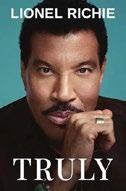
A look at the life of one of pop music’s most enduring stars. Pop star and American Idol judge Richie opens his memoir with an account of his 2015 appearance at the Glastonbury Festival in England, where more than 175,000 people gathered to watch him perform some of his many hit singles. The singer reacts with disbelief to the crowd’s enthusiasm: “Did I dream all of this up? If not, I mean— How in the world did this even
happen? ” His book, marked with wide-eyed disbelief about his own success, aims to answer that question. Richie movingly tells the story of his childhood in his “forever home” of Tuskegee, Alabama; he was a “painfully, awkwardly, horribly shy” boy who struggled with anxiety and undiagnosed ADHD. While a student at Tuskegee Institute, he joined the funk band the Commodores, who in short order became a sensation, playing residencies at Smalls Paradise in Harlem and opening for the Jackson 5 on tour. With no small amount of gentle self-deprecation, Richie writes about his hit singles with the band, including “Easy” and “Three Times a Lady.” He left the band in 1982 and embarked on his solo career, which saw him take the top of the charts with songs including “You Are,” “All Night Long,” and “Hello,” which cemented his status as a worldwide icon. Richie’s book is infused with gratitude; while the reader gets the sense that he is aware of his talent, there is nothing in the book that comes off as bragging, and he still seems star-struck when writing about celebrity friends such as Stevie Wonder and Gregory Peck. Richie is refreshingly open in the book, which functions as both a fun memoir and a love letter to music and his beloved Tuskegee. There’s an abundance of love and gratitude in this wildly entertaining, utterly charming memoir.
Roe, Sue | Norton (304 pp.) | $32.99 November 18, 2025 | 9781324076407

Art lovers. Roe offers colorful portraits of six women involved with Pablo Picasso (1881-1973): Fernande Olivier, Olga Khokhlova, Marie-Thérèse Walter, Dora Maar,
Françoise Gilot, and Jacqueline Roque. “Their relationships with Picasso transformed their lives,” Roe asserts, “and they enhanced and underpinned his.” Olivier was 22, an artists’ model, when, in 1904, she met a young Spanish painter who lived in her building and was swept up in his artistic world. Khokhlova, a ballerina, met Picasso in 1917, when he was working on scenery for the Ballets Russes in Rome. They married in 1918; a son, Paulo, was born in 1921. Picasso was successful by then, able to live well and to help out Olga’s Russian family. Then one day he encountered 17-year-old Walter and asked her to model. Marie-Therese “knew nothing about painting; nor did she ever take any interest in it,” Roe observes. “She just loved Picasso.” The 45-year-old married painter would install her in lodgings near where he was staying with Olga and Paulo. She inspired a “flood of brilliant new work,” Roe writes. In December 1934, eight years into their relationship, Walter became pregnant; their daughter was born in September 1935, causing Picasso to press for a legal separation from his distraught wife. He met photographer Maar in the summer of 1936, which effectively ended his relationship with Walter; he was still involved with Maar when he met 21-year-old Gilot, a painter who eventually left him. Roque was the “devoted, energetic” wife of Picasso’s last years. Roe persuasively depicts the women as more than “silent muses,” but her recounting of Picasso’s betrayals belies the “positive images” that she tries to create.
A vividly detailed group biography.
Sardet, Christian | The Experiment (224 pp.) $29.95 paper | December 2, 2025 9798893030839
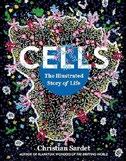
A colorful look at basic biology by a French researcher and artist. Life as we know it emerged some 4 billion years ago in conditions radically different from today’s world. Chemical elements created in the stars somehow assembled into complex molecules able to absorb and use energy from the external environment. At some point there emerged a creature that became the last universal common ancestor—LUCA— of modern life. LUCA’s descendants— bacteria and archaea—radically transformed their environment by excreting oxygen, methane, and other gases that filled Earth’s atmosphere and altered the climate. In this new environment, more complex organisms arose—eukaryotes, the result of mergers and combinations of simpler cells. These were the ancestors of today’s plants, animals, fungi, and algae, multicellular life-forms that first appeared some 600 million years ago. Sardet gives detailed explanations of the processes taking place inside cells, with particular focus on the biological “machines” they use to exploit energy sources and transport proteins and other molecules for use or disposal within or beyond the cell. The book explores the mechanisms of heredity and reproduction, with emphasis on the roles of DNA and RNA. The author credits the many scientists who discovered parts of the story of life,
including women whose work was neglected at the time they made their contributions. Illustrations make up nearly half of the book, ranging from portraits of scientists and microscopy photos to the author’s own drawings of cells and their processes. The book is probably too technical for the casual reader, but those with some background in biology will find it well worthwhile. A vibrant exploration of the history of life and how it works at the most basic level.
The Maritime Epic of World War II
Sebag-Montefiore, Hugh | Pegasus (672 pp.)
$39.95 | December 2, 2025 | 9781639369010
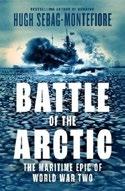
Fighting in freezing-cold waters.
Beginning soon after Hitler’s June 1941 invasion of the USSR, Britain and, after Pearl Harbor, the United States sent supplies in 78 convoys sailing across the Arctic north of Norway to Soviet ports. Journalist and historian Sebag-Montefiore, author of Dunkirk: Fight to the Last Man, covers a subject well explored by scholars such as Richard Woodman in Arctic Convoys: 1941-45, but he is a tireless researcher who has turned up letters, diaries, and personal accounts that fill in some gaps. Soviet ports remained ice-free, so convoys sailed year-round, but even arctic summers were freezing, foggy, and stormy, with icebergs a persistent threat. Not surprisingly, everyone hated the weather. As Sebag-Montefiore writes of the
sailors, “when they signed up to the Merchant Navy, they had to be able to endure a claustrophobic existence below decks, the monotony of an uneventful long journey, as well as terror when the wind got up and the sea became rough.” Relentlessly ungrateful, Stalin and his agents denounced the allies for skimping on supplies and fleeing German attacks; their hostility extended to allied seamen, both healthy and injured, landing at their ports, where hospitals were so primitive that amputations were performed without anesthesia. A lively writer, Sebag-Montefiore delivers 600 pages that will hold most readers’ attention without attempting to cover all the battles, courage, suffering, and tortuous strategic and political background. The author takes advantage of interviews and fresh documentation to emphasize the experiences of individual sailors. Heroism was not in short supply, but readers may squirm at the scale of their suffering. Sailors who jumped into the icy water when abandoning ship froze to death within minutes. Remaining dry in a lifeboat was impossible, and frostbite was epidemic. Terrible weather and the priority of fending off attackers meant that rescue was slow or absent. A gripping chronicle of warfare in extreme conditions.
Serrano, Shea | Illus. by Ian Klarer Grand Central Publishing (352 pp.) | $30 October 28, 2025 | 9781538755228

Revering roundball royalty.
Fervor fuels this impressionistic celebration of basketball’s greatest performers. Serrano,
An impressionistic celebration of basketball’s greatest performers.
the author of bestsellers about sports and pop culture, sticks with what’s made him successful, peppering this collection of essays about LeBron James, A’ja Wilson, and others with go-for-broke adjectives and references to rappers and action movies. You might not agree that Kobe Bryant’s final game was “monumental” or that the Golden State Warriors’ record 73 wins was a “godly” achievement, but Serrano is irresistibly passionate, a fan-writer who greets each game as a chance to be awed. Its title notwithstanding, this effervescent book isn’t about player contracts or billion-dollar revenue streams. To the author, “expensive” is synonymous with virtuosity. Ray Allen’s textbook jump shot was expensive. Though Serrano quotes William Carlos Williams in a chapter about WNBA all-timer Sue Bird, he’s more apt to cite blockbuster films, prestige TV, and hip-hop. Often, this works nicely. His inspired paean to Giannis Antetokounmpo is probably the first time that a streaky free-throw shooter has been likened to “cool-asfuck” Helen Mirren’s unlikely appearance in The Fate of the Furious . Conversely, Serrano’s long list of memorable rap lyrics adds little to his Stephen Curry chapter. The author is appealingly self-effacing—a footnote calls attention to his “dorkiest” sentence—and watchful for manifestations of unbridled athletic joy, like the gleeful “little jump-skip thing” Dwyane Wade did after tossing an alley-oop pass. His support of the WNBA is just as strong as his love of the men’s game. DeWanna Bonner, Brittney Griner, and Diana Taurasi “are sledgehammers covered in scorpions.” Wilson “is a goddamn basketball obliteration monster.” Serrano is great at exploring how fans’ memories of their favorite players intermingle with important events from their lives. That’s the subject of his affable chapter about former San Antonio Spur Tim Duncan. Infectiously enthusiastic appraisals of NBA and WNBA stars.
Cromwell’s Spy: The Notorious Double Life of George Downing: From the American Colonies to the English Civil War
Sewell, Dennis | Pegasus (384 pp.) | $32 February 3, 2026 | 9798897100507

The life and times of a “perfidious rogue.”
This biography by journalist and author Sewell follows Sir George Downing from being in the first class to graduate Harvard to rising through the British aristocracy—working for Oliver Cromwell as a spy, and then in the same capacity for Charles II after the Restoration. He acquired a wife and children, a country house, and a reputation not just as a turncoat, but also as “real vile,” in the words of the Earl of Shaftesbury. It was Samuel Pepys, Downing’s clerk, who called him a “perfidious rogue.” Downing was also responsible for a war with the Dutch and for creating what we now know as “appropriations,” wherein money set aside by Parliament must be used for that specific purpose. He was also a property speculator, building a rather shabby terrace in London named on his behalf and which, at Number 10, still houses the British prime minister. The bare bones of the author’s narrative, however, do not so much flesh out a portrait of a fascinating character as signify a Zelig-like ability to be in so many interesting places. The reason, despite Sewell’s best efforts, is that people engaged in espionage tend to be elusive. Downing’s trade was torture, bribery, and thuggery, including a kidnapping the author suggests was the first recorded case of extraordinary rendition. Readers are given a flavor of the mayhem, when reminded that under Cromwell, “Aston, commander of the Royalist troops, was beaten to death with his own wooden leg.” Of course, between the Cavaliers and the Roundheads, atrocities were
committed on both sides—and Downing worked for both. He also tried to sell Scottish prisoners of war into slavery, and the slave trade helped his own family’s rise. Briefly imprisoned in the Tower after infuriating the king by his escape from the Dutch, he characteristically kept his purse open and his mouth shut.
A capable history of a sketchy rogue.
Smith, Sam & Phil Jackson
Penguin Press (400 pp.) | $32
November 4, 2025 | 9798217060702

Basketball buddies swap stories. This meandering book features some interesting tales about the best players in league history, as chosen in a 2021 poll. Chicago sportswriter Smith covered Jackson when he coached the Chicago Bulls to six championships. Here, they share anecdotes whose defining quality is truthiness. Smith recalls Paul Arizin having “a 90-point game or something” in college. (85, actually.) Jackson says James Harden led the league in free throw attempts “maybe three, four, five years” running. (Six, in fact.) Smith concludes one yarn with the words “perhaps apocryphal,” though others probably qualify. Each chapter starts with a thumbnail sketch of a player. Then comes a breezy chat between the authors. Staying focused isn’t their priority. Ostensibly talking about Nate Thurmond, they barely mention the stalwart rebounder while musing about officiating and obscure players. Some of their stories are delightful. Smith remembers Julius Erving, who was running late for their planned interview, calling from a highway emergency phone. Jackson, who asked players to read classics, says Shaquille O’Neal described Hermann Hesse’s Siddhartha
as having “a lot of money and women, just like me.” As the subtitle promises, their give-and-takes appear to be transcribed conversations—memory lapses included. Jackson, thinking of a player’s name, says, “McCarthy, McClellan,” before getting it: “McNamara.” In several chapters, the authors mention an NBA figure by first name only, leaving readers to hunt elsewhere in the book for surnames. Smith’s preface asserts that basketball “history needs to be told and remembered and told again.” Yet much of what they’ve produced has only a glancing relationship to the players themselves. Bafflingly, their exchange in the Moses Malone chapter mentions Bobby Knight and Lonesome Dove —but not Malone. A genial but frustrating appraisal of pro hoop’s all-time greats.
Stephens, Philip | Pegasus (320 pp.) | $29.95 December 2, 2025 | 9798897100057

Troubled neighbors. Irish and British journalist Stevens, author of Politics and the Pound , Tony Blair, and Britain Alone, concentrates on the past century. By late in Victoria’s reign, Ireland’s persistent disorder finally energized the establishment, and a powerful leader, Prime Minister William Gladstone, proposed granting a measure of independence: Home Rule. Wildly controversial, this split his Liberal Party and Ireland itself. Its six largely Protestant northern counties armed themselves and vowed to resist rule by a largely Catholic Ireland, and supporters in Britain and parliament carried the day. Gladstone failed, but debate persisted, although everyone agreed to suspend it when World War I broke out. The 1916 Easter Rising in Dublin outraged Britons, then in the midst of war. It was quickly suppressed, but
Stephen writes that “it fell to the British to turn military victory into political defeat.” Mass execution of rebel leaders produced an international outcry, energized Irish revolutionaries, and led to the vicious 1921-23 rebellion and Ireland’s independence—minus the northern counties that remained within the empire. “Partition was never part of a grand design,” writes the author, but largely Britain’s effort to wash its hands of the Irish. Never prosperous, the new nation stagnated as leaders emphasized Irish culture over economics and tolerated “the most conservative, clericalist and reactionary government in Europe.” Matters did not improve after World War II, when Northern Ireland alone benefited from Britain’s welfare state and Marshall Plan prosperity. Persistent northern oppression of its Catholic minority encouraged a splinter IRA group to begin a terrorist campaign that provoked a clumsy British response. Eventually, exhaustive negotiations extending from the 1970s to the ’90s produced a surprisingly effective modus operandi. By the 21st century, Ireland was prospering, and a peaceful reunion became a possibility until Britain’s exit from the European Union turned the vanishing border between north and south into a solid international frontier. Astute insights into a seemingly endless problem.
El Generalísimo:
A Biography of Francisco Franco
Tremlett, Giles | Oxford Univ. (384 pp.)
$35 | November 6, 2025 | 9780197832318
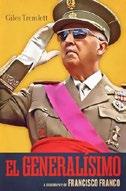
Seeing a “coldblooded” leader in a new light. This fascinating biography by British historian Tremlett gives us dictator Francisco Franco’s Galician childhood, military school, and the “Africanist” apprenticeship in Spanish Morocco before the civil war that brought him to
A dictator “fueled by relentless personal ambition and considerable luck.”
EL GENERALÍSIMO
power. The book is also, inevitably, a concise history of Spain during the first three-quarters of the 20th century. Unlike Hitler and Mussolini, Franco remained on the world stage until 1975. Tremlett describes him as a kind of dam that held back progress, despite “his lack of charisma, intellectual spark, ideological conviction or the kind of personal traits that Spaniards consider ‘simpático.’” He was, however, “fueled by relentless personal ambition and considerable luck.” Franco ruled for 39 years as the nation’s caudillo, or military strongman, not so much for power itself, but to prevent others from wielding it. He was forever caught between church and monarchy, his own reactionary position, and progressive Republicanism in a conflict that cost half a million lives. He also played both sides between the Axis and the Allies, depending on one for arms and the other for wheat. Wracked by indecision, he masked it as shrewdness. Stranded in Morocco at the outbreak of the uprising, he depended on Italian and German planes to airlift 24,000 of his troops into Andalucia, the first air bridge in history. Franco was a brilliant military tactician, but waited months before pressing his advantage invading Madrid, his own capital. Relations with the church soured as it became more liberal, and his desire for autocracy stunted economic development. It took the tourist boom of the 1960s and the return of workers from abroad to give his oppressed people a view of their isolation from the prospering outside world. His late years were marked by physical decline from Parkinson’s disease and terrorist attacks by Basque and Catalan separatists. Fifty years after his death, the book offers a fresh look at a ruthless leader.
A timely and balanced appraisal of a dictator’s legacy.
Italy:
Trend, Nick | Illus. by Cassandre Montoriol Thames & Hudson (352 pp.) | $65 November 4, 2025 | 9780500027530

A treasure map of Italy. Art historian Trend creates 12 curated itineraries centered on an artist or group of artists who lived and worked in Italy. Because much of their art still survives in the churches, chapels, and palaces for which they were commissioned, discovering those works offers travelers—even armchair travelers—a chance to explore Italy beyond its famous museums. Trend’s tour includes world-famous artists, such as Giotto, da Vinci, Michelangelo, Titian, and Canaletto, and lesser-known women artists. Besides illuminating particular works, the author depicts the backstreets and piazzas, landscapes and vistas that inspired their art. He follows Giotto to Padua, Assisi, and Florence; Raphael and Michelangelo to Florence and Rome; Titian, Tintoretto, and Canaletto to Venice. Veronese worked in Venice, too, and his paintings, spanning his entire career, still can be seen in 15 churches and palazzi. Trend points out Caravaggio’s altar pieces in Rome, then follows the painter to Naples, where he fled after killing a man; we learn the sites of three of his paintings in that city, including what turned out to be his final work, at the Palazzo Zevallos Stigliano. Hoping for a papal pardon, Caravaggio died before he was able to return to Rome. The majority of the figures Trend follows are men, but he honors many women artists who, from 1500 to the 18th
century, found unprecedented recognition and opportunities in Bologna. Of some 70 women, he chooses two painters and two sculptors, well known in their time, whose works adorn public spaces. The beautifully produced volume contains more than 450 color plates, photographs, and illustrations; each chapter opens with a whimsical map, hand-drawn by Montoriol, indicating the people and places that feature in that area. In an appendix, a gazetteer lists major sites by region. A richly detailed, innovative travel guide.
Wales, Jimmy with Dan Gardner Crown Currency (240 pp.) | $29 October 28, 2025 | 9780593727461

Lessons learned from an encyclopedic commitment to facts.
This motivational monograph isn’t helped by a framework that emphasizes its unoriginal aspects, but it’s easy to warm to Wales’ eloquent case for the “sunny, pro-social view of human nature” behind Wikipedia’s unlikely rise. His big idea was a tough sell. An online encyclopedia that anyone can write or edit? Hopelessly naïve. So said TV comedians and august publishers when Wales launched Wikipedia in 2001. But by the 2010s, his nonprofit was widely admired—“the last bastion of shared reality,” the Atlantic said. To Wales,
nothing happens without trust. Wikipedia editors “assume good faith” from fellow volunteers, and because “people are natural reciprocators,” this fosters thoughtful debate, transparency, and fidelity to documentable facts. With polls showing Americans’ faith in institutions and one another on a decades-long decline, he means to inspire a “restoration of trust.” Wales’ “rules,” presented as subheadings for the first seven chapters, aren’t revolutionary. Some aren’t even his. One—“Want Trust? Give Trust.”—rewords a statement attributed to Chinese philosopher Lao Tzu. But they’re productive starting points for the author’s reflections on the Wikipedia way, which he augments by interviewing various thinkers. Most compellingly, he shows how Wikipedia’s emphasis on civility helps attract ideologically and demographically diverse contributors, resulting in “articles of higher quality than politically homogenous teams,” an academic study found. Wales shares interesting behind-the-scenes anecdotes about Wikipedians’ rigor. An editorial discussion about punctuation and capitalization in the title of a Star Trek movie resulted in a 40,000word exchange. While he occasionally writes like someone scheduling a bland corporate retreat—organizations should conduct a “trust inventory”—Wales’ appreciative tributes to diligent Wikipedia contributors provide instructive examples for readers inspired to counter falsehoods wherever they arise.
Wikipedia’s founder makes an invigorating plea for collaboration and respectful debate.
How Wikipedia’s emphasis on civility helps attract diverse contributors.
Ward, Geoffrey C. & Ken Burns | Knopf (608 pp.) | $80 | November 11, 2025 9780525658672

Companion volume to the much-awaited Ken Burns documentary series.
Longtime Burns collaborator Ward treats the American Revolution not just as a laboratory for addressing the question of how people are best governed, but also as a “savage civil war” with more than its share of atrocities. Noting that “we have mostly chosen to see the Revolution in bloodless, gallant terms,” Ward enumerates the reasons for breaking away from Britain: the failure of Parliament to include colonial representatives, providing an argument for not paying taxes to the mother country; ordinances forbidding the expansion of the colonies beyond the Appalachians; the provocation of enlisting runaway enslaved people in the British army, which “only deepened anti-British feeling among many southern colonists”; and other perceived injuries. There were wars within the Revolutionary War: Ward writes of the Continental campaign to wage war on the Cherokees and other southern Indigenous groups, with Thomas Jefferson saying, “Nothing will reduce those wretches so soon as pushing the war into the heart of their country.” Many familiar figures appear, including George Washington, whom King George III called “the greatest character of the age,” and Thomas Paine, whose Common Sense motivated the rebellious colonists to continue the fight with phrases such as “Tyranny, like hell, is not easily conquered.” But Ward is also good at turning up little-known episodes, such as Benjamin Franklin’s convincing the French crown that aiding the
revolutionaries’ cause would reduce Britain’s power everywhere, adding, “Every nation in Europe wishes to see Britain humbled.” American victory at Saratoga sealed the alliance. As the author notes, the successful conclusion of the Revolutionary War did not end its strife: “The war had brought the states together, but peace threatened to tear them apart again” as they vied for position in the postwar world. A well-written and thoughtful history shrouded in myth, but even more interesting when laid bare.
A Landmark Trial and the Decades-Long Struggle To Make Spousal Rape a Crime
Weinman, Sarah | Ecco/HarperCollins (304 pp.) $32 | November 11, 2025 | 9780063279889

Journalistic study of the legal battle to criminalize marital rape. As late as 1974, writes Weinman, “it was perfectly legal for a man to rape his wife, because the very concept of marital rape seemed unfathomable” with wives considered property in the spirit if not the letter of the law. That was until the case of Greta Rideout reached a court in Oregon. She had reported to the police that her husband had raped her—and moreover, beaten her in the presence of their 2-year-old daughter. Greta’s case prompted a wave of legislative reforms, such that by 1993, as Weinman chronicles, “marital rape was a crime in every state.” As the author goes on to recount, Rideout’s husband had all the psychological hallmarks of an abuser, abused himself in childhood, forever promising to change his ways but never doing so. While remaining closely focused on the Rideout case, Weinman’s discussion is wide-
As late as 1974, it was “legal for a man to rape his wife.” WITHOUT CONSENT
ranging: She reports on statistical surveys indicating that as many as one in eight married women had been sexually assaulted by their husbands, though the word “rape” elicited far fewer numbers, as if the victims were reluctant to apply it to their experience. (A later study revised the figure slightly upward to 14%.) The Rideouts themselves provided fodder for commentary, much of it in the sexist framing of the period, with one calling the working-class couple “terminally stupid” and adding that “Greta had sensational legs and spent most of her time shaving them in the bathtub,” while another railed against “women who dress inappropriately, flaunt their right to be comfortable at the expense of the comfort of others.”
The blaming-the-victim trope remained a constant, even as John Rideout, divorced from Greta, proved a repeat offender and was imprisoned for his crimes.
A well-argued work of legal journalism that shines light on the darkest corners of married life.
Weldon, Duncan | Pegasus (320 pp.) $32 | January 6, 2026 | 9798897100309

Economics may sound dull, but this is mostly about war.
Journalist and broadcaster Weldon, author of Two Hundred Years of Muddling Through: The Surprising Story of Britain’s Economy
From Boom to Bust and Back Again , emphasizes that economics explains human behavior well beyond simple money and trade. He writes that the first states were built by “violence specialists.” After the agricultural revolution some humans realized that farming was hard work and stealing from farmers was easier. This is Weldon’s introduction to Vikings, who took robbery to a new level. European nations sometimes fought them off; others paid them off. This sounds cowardly but turned out to be a good tactic. Flush with wealth, Vikings lost interest in returning to impoverished Scandinavia, where there was little to buy, and spent it on the spot, settling and eventually ruling many areas in Europe, England included. The ultimate violence specialists were Mongols, nomads from the Eurasian Steppe, who, under Genghis Khan, conquered an empire so large that he can be considered the father of globalization. Readers will quickly learn that this is not a seamless account, but 17 isolated yet delightful chapters recount signal events in war economics down to the present day. Again and again, sensible decisions were no such thing, and irrational policies succeeded. Having defeated France in the Seven Years War, Britain had a choice between acquiring Canada or the rich, tiny French Caribbean sugar island: Guadeloupe. It chose Canada, which turned out disastrously. Everyone praises Russian Premiere Khrushchev for ending Stalin’s murderous paranoia, but staying alive was one of few motivations in the clunky peacetime Soviet economy, where patronage networks and corruption soon thrived. Many chapters are only distantly related to economics but no less entertaining. The Luftwaffe
showered medals and publicity on successful fighter pilots, but it turns out that fighter pilots are already fiercely competitive, and these rewards encouraged excessive, often suicidal, risk-taking. An ingenious juxtaposition.
The Great Black Swamp: Toxic Algae, Toxic Relationships, and the Most Interesting Place Nobody’s Ever Heard Of Wensink, Patrick | Belt Publishing (256 pp.) $19.99 paper | November 11, 2025 9781540270108

Troubled waters. In this case study, college professor Wensink embarks on a journey to learn how a Lake Erie algae bloom came to be—in 2014, it infamously poisoned the drinking water of Toledo, Ohio. The author is unabashedly curious, his tone is breezy, and he doles out pop culture references and factual information in equal parts. Readers can be assured they won’t be bogged down by overly detailed timelines or scholarly analysis, and yet, they will learn plenty about the complex causes and multipronged solutions related to harmful algal blooms. Northwest Ohio used to be home to the Great Black Swamp, an ecosystem the size of Connecticut with seemingly bottomless mud holes, dense, dark forests, and insufferable populations of insects. During westward expansion, settlers endeavored to conquer the swamp by draining water and clear-cutting the dense forest. These actions often relied on human ingenuity, such as an automated ditch-digging machine invented in 1893. Today’s Ohioans face an out-of-balance ecosystem— an unintended consequence of such progress. Previous generations turned uninhabitable land into
“The peculiar and perhaps fatal American violence is the refusal to connect.”
LANGUAGES OF HOME
farmland, thereby providing farmers a chance to achieve a middle-class lifestyle. But now, many see that the swamp’s conversion was a recipe for ecological disaster. The author weaves in bits of memoir, writing that he had no knowledge of the swamp even though he grew up nearby. He also details his present-day divorce; he doesn’t make a direct parallel between his divorce and the 2014 algal bloom, but it’s an undercurrent: “Often, it’s at these breaking points that we find the clarity or strength to try something new.” And thus, the story wends its way to interventions in Ohio and beyond, such as dam removal, wetlands restoration, and farm management. Each strategy helps a little bit, the author notes, and together, they can add up to make a difference.
A surprisingly entertaining read about an environmental disaster.
Kirkus Star
Essays on Writing, Hoop, and American
1971–2025
Wideman, John Edgar | Scribner (400 pp.)
$29 | November 18, 2025 | 9781668036372

A gathering of sharply focused essays by the distinguished novelist. “The peculiar and perhaps fatal American violence is the refusal to connect,” writes Wideman. One
aspect of that refusal gives this collection its title, as the author recounts gazing, as a youngster, into a confectioner’s shop in his native Pittsburgh, his pockets full from the proceeds of his paper route, and pronouncing the prices “exorbitant,” infuriating a white passerby. Wideman knows why: “I’d stolen a piece of their language. Not only was it in my possession, I also had the nerve to flaunt it in a public place, in their righteous faces.”
Another source for the title is the author’s close attention to language: the blending of “literate, and oral traditions” in Gayl Jones’ novel Corregidora , the use of dialect in 19th-century literature, and the contrary refusal of the poet Phillis Wheatley to use anything but “the eighteenth-century literary code of English, a code doubly foreign, a tradition in which her achievements seem both miraculous and pedestrian.” One of several tours de force here is Wideman’s long meditation on, among other things, the unhappy fate that befell Louis Till, estranged father of Emmett, who was executed for allegedly committing rape in Italy during World War II; the author has long been attuned to issues of justice and injustice, with an early essay on white police in Black communities carrying a blunt message: “Whatever else the policeman is, he is also a further validation of the cage.” Wideman’s serious considerations of history and culture are punctuated by several perceptive pieces on hoops, writing in one that “playground basketball is the most democratic of games” and celebrating the sui generis style of Dennis Rodman, whom, in a fine literary turn, he groups alongside
Caliban and Frankenstein’s monster as “neither one thing or another.”
Brittle and brilliant, a welcome record of Black life and thought in an often unwelcoming nation.
Zengerle, Jason | Crooked Media Reads/ Zando (352 pp.) | $28 | January 27, 2026
9781638932932

A straightforward account of a crooked path to prominence. In this thoroughly documented account of Tucker Carlson’s career, journalist Zengerle tracks his subject’s jagged course through a gauntlet of media outlets and platforms. The son of a journalist and diplomat, Carlson was a private-school slacker who admired Jerry Garcia and Hunter S. Thompson. Following his father into journalism, he excelled at the Weekly Standard but realized that cable television was eclipsing magazines as a career option and political force. He was soon hosting programs on CNN, PBS, and MSNBC, where he clicked with Rachel Maddow. Fired by that cable channel in 2008, Carlson landed a low-level position at Fox News and co-founded the Daily Caller. He cast that outlet as a conservative version of the New Republic, but when the bombastic Breitbart News outmaneuvered it, Carlson responded by hiring hardcore culture warriors, including white supremacists. Meanwhile, he rose through the ranks at Fox News by skewering liberals and avoiding nuance, which he considered the enemy of clear debate. Carlson harbored grave doubts about Donald Trump, but when he learned that the president watched his program avidly, he began to pitch his stories to
an audience of one. Fired by Fox News without explanation in 2023, he launched the Tucker Carlson Network with the help of Elon Musk. There he interviewed Trump, Vladimir Putin, and Viktor Orbán, whose authoritarian style he openly admired. After Trump’s victory in 2024, Carlson was deeply involved in cabinet and staff appointments, and Zengerle notes that Carlson’s favorite themes have shaped Trump’s priorities. Although Zengerle steers clear of polemic, what emerges from his portrait is a kind of morality tale about the decline of political journalism and the rise of for-profit agitprop. Carlson, Zengerle concludes, “has descended into madness, but he is speaking to millions.”
A richly detailed portrait of Tucker Carlson and the media trends that have shaped political commentary.
Zierler, Wendy I. | Jewish Publication Society (360 pp.) | $32.95 paper October 1, 2025 | 9780827615700

The “recuperative power” of prayer.
Zierler, a professor of Jewish studies and an ordained rabbi, turns to modern Hebrew poetry to guide her journey, grieving for lost family. Her book interlaces personal reflection and critical analysis with an anthology of verse in Hebrew and English translation. It offers a road map to
both inner and public voices. Hebrew poetry today draws on the rich traditions of biblical verse and liturgical prayer. There is a constant dialogue between the holy and the homespun. Everyday words in modern Hebrew ripple with their ancient origins. Modern women’s voices, too, come to the fore here, as Zierler offers powerful translations of the writers Lea Goldberg, Ruhama Weiss, Rachel Bluwstein, and Rachel Morpurgo. Some of these translations have the feel of nursery rhyme, such as this one from Goldberg: “I don’t remember and do not know, / But to the past I shall not go / And today there’s joy and glow.” Weiss’ poem, “Lament for Rashi’s Daughters,” imagines the children of the great medieval scholar and goes to the heart of what it means to be a Jewish woman of scholarship in a world of men: “One day, perhaps he will long for them.” Everything is personal for Zierler, and every poem and translation resonates with an event in her life. “For me, reading Rashi’s declaration that fathers don’t usually treat their daughters with enough affection to occasion feelings of longing for their father only brought to the fore my own wonderfully different story with my own father.” Traditional literary critics may wish for more objectivity in Zierler’s readings. But what this book asserts is that such traditional, objective criticism may no longer satisfy in worlds of women longing to be heard and emotions unable to be constrained. An autobiography of mourning, told through translations and analyses of modern Hebrew poetry.
Carlson’s favorite themes, writes Zengerle, have shaped Trump’s priorities.
HATED BY ALL THE RIGHT PEOPLE

READING JON SCIESZKA
and Lane Smith’s The Stinky Cheese Man: And Other Fairly Stupid Tales (1992) was a truly formative childhood literary experience for me. In this spectacularly subversive collection, a princess is tricked into kissing a devious frog who’s no prince at all, while the ugly duckling grows into an equally hideous swan. My appetite for fractured fairy tales was whetted. Happily, the 21st century has been rife with creative retellings, among them David Wiesner’s The Three Pigs (2001), Adam Gidwitz’s A Tale Dark and Grimm (2010), and Laurel Snyder and Dan Santat’s Endlessly Ever After: Pick Your Path to Countless Fairy Tale Endings! (2022).
Kid lit authors are still breaking new ground. With The Fairy Tale Fan Club: Legendary Letters Collected by C.C. Cecily (Walker US/Candlewick, 2024), actor and author Richard Ayoade casts folktale characters as celebrities of sorts, receiving mail from devoted fans with questions galore: How did Red Riding Hood mistake her

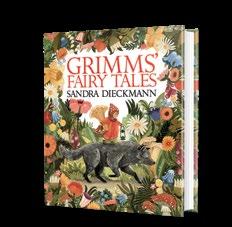
grandmother for a wolf?
What advice does Rapunzel have for someone mulling “the big chop”? The responses are just as witty: Granny’s on the hirsute side, while Rapunzel replies with a pros-andcons list in which pixie cuts win the day. This archly funny middle-grade work, illustrated by David Roberts, encourages young people to become active, engaged readers.
Grimms’ Fairy Tales , an anthology by Sandra Dieckmann (Candlewick, September 23), is more earnest in tone, largely hewing to the source material, but it nevertheless makes a much-needed contribution to the genre. In Dieckmann’s lush artwork, same-sex couples dance at Cinderella’s ball, while characters are racially diverse, and the author/illustrator often describes babies with they / them pronouns. The result
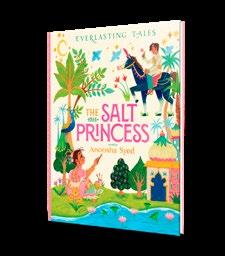
is, to quote the Kirkus review, a “boldly inclusive” and “thoroughly modern fairy-tale anthology.”

Picture-book creators, too, are doing impressive work in this sphere. In Anoosha Syed’s The Salt Princess (Harper/HarperCollins, April 1), a retelling of a Pakistani folktale, a king asks his daughters to describe their love for him. The eldest three compare their devotion to sugar, honey, and sherbet, but free-spirited Amal replies, “I love you like salt”—prompting the insecure king, enraged at being compared to something so common, to exile her. The narrative is infused with a modern sensibility and thoughtful commentary. Amal emerges as a feminist icon, doodling the words “fierce fearless female” on the castle wall, while Syed emphasizes that the king is motivated by a desire for social approval—an issue, as she notes in the backmatter,
that remains prevalent in South Asian communities. Brilliantly blending elements of a beloved fairy tale with real-life American history, Shana Keller’s picture book CeeCee: Underground Railroad Cinderella , illustrated by Laura Freeman (Charlesbridge, August 12), follows an enslaved girl as she plots to leave the plantation one night: not to dance with the prince at the ball, but to flee north to freedom. Folktale fans will recognize familiar characters—cruel Mrs. Townsend (the wife of the plantation owner) is clearly the wicked stepmother, while Binty the cook serves as the fairy godmother—as they absorb lessons about everything from Harriet Tubman to the importance of literacy: Stories are what inspire CeeCee even as Mrs. Townsend forbids her from learning to read.
Mahnaz Dar is a young readers’ editor.
After a boy in a remote, snowy town quarrels with a friend, his subsequent tumble while skiing reveals a mysterious, glowing theater. As this Japanese import opens, the two companions argue over the butterfly book they’re admiring. As they tussle, a page tears, and the friend skis home. The boy worriedly repairs the book (one of his father’s treasured possessions), then skis off himself, seeking to quell his discomfort. Negotiating a steep downhill trail, the boy overlooks a gap and falls in. Within the shallow crevasse, he discovers a tiny theater and a dazzling musical, staged by snow
people, about to begin. After he rescues a fallen performer, the troupe invites him to view their show. Whispering ballerinas, singing children, and a sudden transformation from a tiny to full-size production hint at the boy’s dream state. He joins the troupe onstage as they begin a “spinning top song.” A giant top appears, sparkling with snow crystals; a snow queen summons an enchanted blizzard. Arai’s charming illustrations dazzle. Intentionally naïve and expressionistic, they pair thick, impasto-like color with delicately rendered performers— singing, dancing, even
Ryōji Arai;
David Boyd

Arai, Ryōji | Trans. by David Boyd Enchanted Lion Books | 36 pp. November 25, 2025 | $18.99 | 9781592704606
snowboarding. Playing with perspective, the artist contrasts the village’s snowy expanses with the small figures of the boy and his father, who rescues him with a promise of cocoa and a suggestion to lend the
butterfly book to his friend tomorrow. Human characters are tan-skinned. Conflict, enchantment, resolution, solace— all interweave in this beautifully illustrated tale. (Picture book. 4-8)
PENCIL & ERASER
Adderson, Caroline | Illus. by Lauren Tamaki | Groundwood (36 pp.) | $19.99 October 7, 2025 | 9781773068930

The quintessential 17th-century Japanese poet Bashō composes his signature haiku despite demanding distractions. While out for an evening walk, Bashō finds a “peaceful place…to think” along a pond’s mossy banks. Soon enough, he’s recognized as “the most famous poet in the land” by nearby inhabitants, each hoping for literary recognition. The golden carp rises to the surface to dance and flutter, demanding, “O, Bashō!…Look at me!” but the poet’s eyes continue to rest. The water lily, realizing “a flower lives only one season, unless he’s the subject of a poem,” unfurls his petals to entice the poet with his perfume, but Bashō’s nose doesn’t twitch. The mosquito, smelling blood, whines in Bashō’s ear, but the poet remains “deaf to droning pests.” Just as the frog decides he won’t allow the “flashing fish, lavish lily, megalomaniacal mosquito, [and] pensive poet” to ruin his midnight swim, Bashō reengages his senses to capture the moment: “Old pond— / Frog jumps in. / Splash!” Adderson’s succinct text is a clever reflection of Bashō and his precise verses. Tamaki presents her visceral illustrations in saturated swathes of blues and greens with pleasingly popping yellows and pinks. Multiple close-ups of uninterruptible Bashō brilliantly ensures that his wide-eyed, rainbow-energy-emitting final portrait is a humorous, affecting delight. Appended backmatter explains
haiku, introduces Bashō, and encourages nature-inspired creativity. A gleefully inventive tale that captures the provenance of one of history’s most famous poems. (Picture book. 5-10)
Allepuz, Anuska | Trans. by Cecilia Ross | NubeOcho (36 pp.)
$17.99 | September 30, 2025
9788410406353 | Series: Somos8

The inexplicable appeal of a sharp roof-ridge leads to conflict— and then sudden resolution. In this tale translated from Spanish, Bennett the bear lives in a house with an ordinary, shingled, steeply pitched roof. It’s not an urban oasis, but nonetheless it’s mysteriously attractive to a series of animals. Cat, Mouse, Fox, Squirrel, Owl, Moth, a family of hedgehogs, and finally Flea all claim sole occupancy rights. Piling on, they bring the roof down onto Bennett, who’s calmly drinking tea inside. No one is hurt; everyone immediately recognizes and accepts their responsibility and then teams up to rebuild. Bear offers hot chocolate as they sit demurely on the restored (and presumably reinforced) roof: “Bennett’s roof!” Have the characters learned and changed? Or are they just behaving under Bennett’s eye? Some readers may also wonder why only Bennett has a roof and home of his own—where do the other creatures live? Nevertheless, the value of teamwork comes through easily. The very cute critters are sherbet-colored but roughly to scale; they are rotund and stylized.
The cat is spotted, the squirrel is red. The faint background is wintry; the existence of many similar neighboring roofs makes the compelling appeal of Bennett’s a puzzle.
An attractive tribute to collaboration—though one that may leave readers with unanswered questions. (Picture book. 3-6)
Alvarado, Jenny | Putnam (80 pp.)
$12.99 | January 6, 2026 | 9780593699898
Series: Pencil & Eraser, 3

Can Pencil and Eraser’s friendship stretch to accommodate a third pal?
Pencil’s wavering attempts to draw a castle wall are interrupted by Ruler’s offer to help. Pencil’s grateful, though Eraser’s uncertain, especially when Ruler unwittingly makes him unnecessary—who needs an eraser when a ruler’s on hand to help draw straight lines? Still, he joins in their joint quest to find a missing green crayon. (Alert readers will have spotted it early on near Stella, the school supplies’ curly-haired, brown-skinned owner.) Throughout, Eraser offers commonsense correctives to the well-meant but not well-thought-out impulses of the other two. In keeping with Pencil’s medieval obsession, she proposes making a catapult and, with both flattery and force, propels reluctant Eraser to the vantage point of some old chewing gum stuck on the ceiling. Challenges ensue as Alvarado underscores her point: Teamwork makes the dream work. And Ruler learns that being “perfect” isn’t required for acceptance. Once again, this lively adventure is divided among four brief well-paced chapters, with clearly defined characters, simple cartoon illustrations, and brisk, on-point dialogue. “Joke Break!” sections between chapters keep the laughs coming. Sticky social situations are easy to see and solve in this amusing series,
perfect for beginning readers. (how to draw Ruler and Crayon) (Graphic easy reader. 5-8)
Aniston, Jennifer | Illus. by Invisible Universe | Harper/HarperCollins (128 pp.) | $24.99 | September 9, 2025 9780063372382 | Series: Clydeo

Clydeo the canine YouTube chef brings 35 kid-friendly recipes to life in his first cookbook with the help of actor and author Jennifer Aniston.
The titular character of Clydeo Takes a Bite Out of Life (2024)—based on Aniston’s real-life pet—presents a cookbook for kids with recipes for breakfast, lunch, dinner, and dessert, along with a selection of snacks and sides—and a sweet treat for dogs, too. Recipes are organized and clearly written, with enticing descriptions, step-by-step instructions, gorgeous food photography, and information about serving size, preparation, and cooking time for each dish. Clydeo’s fans will appreciate that he’s featured on almost every page, often in whimsical photos with finished food items. Recipe modifications and suggestions are provided in notes and speech balloons. While Aniston doesn’t provide the levels of expertise or adult supervision needed for each recipe, the book spans a range of technical abilities. For example, the No-Bake Oreo Pie would be easy for a novice young chef to prepare, while a recipe like Handmade Sweet Potato Gnocchi would require the
A
knife skills and kitchen know-how of a more experienced hand. Readers unfamiliar with Clydeo will enjoy the book’s introduction, where he describes his quest to become the “most famous furry foodie” and encourages chefsin-training to approach cooking with a growth mindset and to ask for help when they need it.
A delectable recipe collection perfect for family culinary collaborations. (Cookbook. 8-12)
Bajaj, Varsha | Illus. by Ishaa Lobo Nancy Paulsen Books (32 pp.) | $18.99 October 14, 2025 | 9780593625156
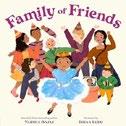
A young girl of Indian heritage eagerly awaits a relative’s arrival. Isha excitedly tells Mrs. Garcia, who lives next door, all about Nani, her grandmother. Christened the “queen of fun,” Nani lives across the ocean and loves to dance. Isha video chats with Nani as they both make grand plans for Isha’s upcoming birthday party. The next week is a flurry of activity as Isha hands out invitations, picks out a dress, and decorates Nani’s room with a welcome banner. Unfortunately, Nani falls ill and must postpone her trip. Upset, Isha rips down the banner and mopes about, but her neighbors and friends rally around to cheer her up. Sensing her disappointment, Mrs. Garcia asks Isha to help her bake cookies for her granddaughter in New York and for Isha, who she says “is like another granddaughter to me.” Her comforting words help Isha reflect on her friends, who feel like family, and she enjoys a joyous get-together with her
chosen family. Bajaj’s heartwarming story, with its clever coinage of the term grandfriend to describe Mrs. Garcia, encapsulates relationships that grow from a close-knit community. Lobo’s endearing illustrations create a sense of coziness and celebration. Isha’s surrounded by an intergenerational, multicultural mix of loved ones. A charming rendering of life’s ups and downs and those who buoy us along the way. (Picture book. 4-8)
Barr, Catherine | Illus. by Chaaya Prabhat Bloomsbury (48 pp.) | $19.99
February 3, 2026 | 9781547619177

A celebration of select colors in the visible spectrum, plus black and white. While Barr writes that “our world spins in color,” she sidesteps the issue of just how many colors we can see (current estimates range up to 10 million). The author presents examples of flora, fauna, rocks, and more that flash hues or blends of various colors, including pink, gray, and brown, plus all colors (“wonderful white”) and none (“deep black”). She rhapsodizes about the “brilliant blue” of the sky, lapis lazuli, and peacock tarantulas and explains how the color results from the selective reflection and absorption of spectra. She also invites readers to join her in marveling that white “is bursting with secret colors,” that the blood of certain skinks is actually green (and that of icefish totally colorless), and that rainbows are round when viewed from the right vantage point. She extends her topic in multiple directions, with glances at iridescence, bioluminescence, and the effects of climate change on wildfires and other ominous events, from earlier-blooming cherry trees in Japan to the impending extinction of freshwater dolphins. In her appropriately colorforward illustrations, Prabhat uses a vivid palette to reflect the author’s elevated tone. Limited in some ways, but shines with both facts and feeling. (glossary) (Informational picture book. 6-9)
Beccaloni, Jan | Illus. by Namasri Niumim
Thames & Hudson (48 pp.) | $19.95
September 23, 2025 | 9780500653845
Series: The Secret World
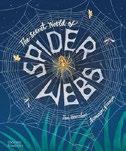
Discover a world of web-weavers. This intriguing title introduces 20 different spiders from around the world via the webs they weave, describing the spiders, their silk, and the ways they make and use 13 different styles of webs. Arachnid expert Beccaloni’s topically organized presentation goes beyond the familiar world of orb-weavers to introduce a variety of web shapes and purposes. For the most part, each page or spread shows a different web and a different kind of spider. Some webs have decorations. Some use a kind of silk that is woolly. Some silk is stretchy; much, but not all, is sticky. Many webs are traps, but the book also includes descriptions of webs designed mainly to conceal or support the waiting spider, one that provides a stable barrier against sand, and one that dangles fishing lines. Each web is described in two to four short, informative paragraphs. Most of the web-makers are identified with both Latin and common names in these descriptions. Niumim’s gouache illustrations show the intricacies of each of the webs and the beauty of their spider creators. The varying background details and colors provide a sense of the worlds they inhabit, be it a cave, a desert, a forest, or your own backyard. The volume concludes with tips for spotting the spiders
shown and a short list of sources for further research.
For arachnid appreciators of any age. (Index, sources) (Nonfiction. 8-12)
Betts, Bruce | Lerner (32 pp.) | $9.99 paper October 7, 2025 | 9798765684672
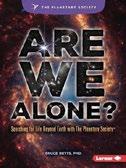
Basic introductions to exoplanets and indications to whether they harbor life. Betts kicks off with the big question: “Are we alone in the universe?” Rather than taking on the Fermi paradox, however (“If the universe is so old and big, where is everybody?”), he follows an easier, less troublesome path. He explains that scientists are actually looking for signs of water, and for the six building blocks of earthly life, both on our near neighbors in our solar system and on planets orbiting within the just-theright-temperature “Goldilocks zone” of other stars. For younger readers who want to pursue the topic, a brief but audience-appropriate resource list at the end offers a good starting point. Big, bright photos and digital images of space probes, currently active telescopes, and distant moons and planetscapes light up the simply phrased narrative. If the one speculative representation of what aliens might look like is a stereotypical image of a little green man and his dog, at least it’s not a Predator or a chest-bursting Xenomorph.
A peek at a scientific enterprise with truly revolutionary potential. ARE WE ALONE?
A tantalizing peek at a scientific enterprise with truly revolutionary potential. (glossary, index) (Nonfiction. 7-10)
Brown, Merrilees | Tundra Books (48 pp.) $18.99 | September 30, 2025 | 9780735262782

A young mouse who avidly collects found objects is forced to use them (constructively) or lose them. Spaghetti “sees beauty and possibility in what others no longer need or want.” Two pencil stubs make a terrific pair of stilts, an uncooked strand of spaghetti supports an attractive Alexander Calder–like mobile made up of odds and ends, and so on. Unfortunately, Spaghetti’s large family doesn’t “see the beauty and possibility that Spaghetti sees”; his parents and siblings just want him to clear up the clutter that has overwhelmed their nest. Spaghetti has an idea: Maybe what he sees as “mouse treasure” can be used to “build something beautiful…for everyone in the mouse house!” Spaghetti throws himself into his construction project (“He gathers and sorts. He nibbles and gnaws”) and single-handedly creates a mouse-scale park with button swings, a teeter-totter with Q-tip seats, and more. Brown’s paean to creativity comes with a built-in game of “I spy”: Her delicate digitally assembled mixed-media art features a banquet of repurposed everyday objects that readers can enjoy trying to identify, like the toilet paper–tube base for a nifty mask and the egg carton sorting station that Spaghetti uses while preparing to build. It’s all in good fun—and good conscience, although, while the eco-message is present, it’s no louder than a squeak.
An entertaining case for industriousness and an understated case for upcycling. (Picture book. 3-7)
Brown, Ruth | Scallywag Press (32 pp.)
$18.99 | October 7, 2025 | 9781836300205

During a museum outing with his grandmother, a boy wanders into an exhibition that yields the unexpected.
“Jackson” is the first image that readers encounter. The black, yellow, and orange drip painting features a felineshaped white space at the base and a paint-splattered cat emerging on the right. The label for the Jackson Pollack–inspired piece reads: “Adventurous and curious… / but messy.” As Tom, a pale-skinned youngster in shorts and sandals, meanders along, the labels indirectly communicate something about the parodied artists as a stylistically appropriate cat crawls out of each work to join the parade. (The artists, mostly male Europeans, are listed after the conclusion with dates and nationalities.) René Magritte’s animal is blue, dotted with clouds; M.C. Escher’s white twins “sometimes find the world / puzzling.” Ultimately, Henri Rousseau’s tiger sends the terrified kitties back to their respective artworks, except for Jackson, now nearly paint-free, who bids Tom farewell. It’s always fun for children to imagine entering paintings or interacting with their subjects, and while this book is thin on action, young people and adults who know the originals (and are therefore in on the humor) or who enjoy looking at skillfully rendered art will appreciate the experience. As sometimes happens, the publishing planets aligned: The American edition of this U.K. edition publishes
the same season as Brian Lies’ Cat Nap (2025), the story of a cat chasing a mouse through historically diverse artworks. Both books offer playful explorations of gallery treasures. Visually enticing, inviting repeat visits. (Picture book. 4-8)
Bryant, Megan E. | Penguin Workshop (240 pp.) | $17.99 | December 30, 2025 9780593226551 | Series: Abby in Between, 2

Changes once again complicate Abby’s life. After ringing in the new year, Abby is eager to finish up fifth grade—and elementary school. She’s got plenty on her plate: Menstruation is a hot topic among her peers, and opportunities for embarrassment lurk everywhere, especially in health and wellness class. Tensions flair at home; Dad’s new job schedule makes him largely unavailable, and Mom resents carrying the domestic load. Worried about climate change after her teacher brings it up in class, Abby lashes out at her family for not doing enough to protect the environment. Arguments with little brother Max and clashes with Mom add further conflict, especially as Mom puts the kibosh on Abby’s plans of adopting a kitten. The class Eco Campout provides an eventful climax before graduation shows the path forward. Abby veers between a desire for independence and a need for reassurance as she deals with interpersonal conflict and endures a complex relationship with her “best frenemy,” Savannah, a charismatic classmate with a mean streak. Bryant
once more clearly and convincingly conveys Abby’s emotions as she navigates typical tween challenges. Lively language, peppered with expressions of edgy attitude, bring Abby’s experiences to life. Bryant adeptly balances action, description, and Abby’s thoughts, worries, and perceptions, keeping readers fully engaged. As in the first installment, physical descriptors are minimal. A winning sequel that sees the welcome return of a flawed yet bighearted protagonist. (Fiction. 7-10)
Bussing, Kim | Random House (320 pp.)
$17.99 | November 11, 2025 | 9780593708118 Series: The Princess Swap, 3

Thanks to unexpected magic, two princesses swap lives. Rapunzel resides in a tall, secluded tower, unable to leave due to a curse that brings misfortune to anyone she nears. Hana, the youngest mermaid princess, dwells in the Vallian Sea with her shark friend, Leonard, passing time exploring sunken ships. Both girls long for something different. Recently, an ominous Storm has been hanging over the sea, portending catastrophe; humans blame merfolk for it and vice versa, creating tensions between the communities. After Leonard is unexpectedly captured in a net and pulled onto a boat, Hana gets sucked up by the Storm’s violent winds. Rapunzel touches an enchanted model ship in the tower’s Library, and soon, Hana finds herself in Rapunzel’s tower with human legs in place of her tail, while Rapunzel is in the water, confronting the sea witch. When the girls’ paths eventually cross, they uncover malevolent schemes by those seeking to exert power and control people through fear and manipulation. Bringing together these and other recognizable figures
CHILDREN'S
from European fairy tales, this life-swap story follows characters who are learning how to challenge the things they were always taught to believe. Amid lots of action, Bussing provides enough description of the setting for readers to understand the magic at play—and a little romance even blooms between Hana and the human prince, Oliver. Main characters read white. A fresh, fast-paced fairy-tale retelling that explores themes of agency. (Fantasy. 8-12)
Bybee, Veeda | Illus. by Hoan Phan Shadow Mountain (224 pp.) | $18.99 October 7, 2025 | 9781639934331
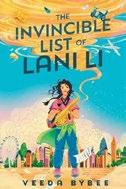
Can a girl go outside her comfort zone to do something meaningful for her brother?
Thirteen-yearold Lani Li has a 10-year-old brother, Gavin; the six older siblings in their big Chinese American family always seem a bit separate from the two youngest Lis. Lani is excited to leave Provo, Utah, behind for her band trip to London. She’ll get to see a new country with her best friend, Sam Aina, who’s Hawaiian Māori Chinese, and get a little more attention from her parents, who are chaperoning (and bringing Gavin along). Her younger brother plans to compete in—and win—a 200-year-old race that involves chasing a wheel of cheese down a hill in Gloucestershire. When Gavin’s congenital heart condition, Tetralogy of Fallot, rears its
head, he’s forced to stay home to recover with Dad, while Lani and Mom go to England. Gavin asks Lani to enter the cheese race in his place, but she isn’t sure she can do something so daring. She turns for help to the traditional Chinese stories that are beloved by her family. Phan’s playful illustrations as well as excerpts from the folktales Lani uses to guide her path break up the central narrative and complement the travel adventures. While some of the dialogue feels wooden, the story balances fun elements with more serious topics, like Gavin’s health, and the folktales help unify the various themes. A thoughtful exploration of sibling bonds and the power of stories. (author’s note) (Fiction. 8-12)
Byrd, Jesse | Illus. by Berto Santiago Paw Prints Publishing/Baker & Taylor (152 pp.) | $13.99 paper | October 28, 2025 9781223187938 | Series: Dream Warriors, 1

A plucky 12-year-old boy slips into the realm of dreams and nightmares in this series opener. Floating on a cosmic river, young Khi wakes up, only to fall right into Cloud 9, a realm in the afterlife full of celestial heroes known as Dream Warriors tasked with keeping slumbering humans safe at night. Thrust into the warrior ranks without a choice, Khi immediately begins training while also learning about the action-packed perils that Dream Warriors face. When Khi is assigned to
protect his younger sister Lo-Lo’s bully, he resolves to get reassigned to Lo-Lo instead by proving he can become the hero she needs. Meanwhile, nightmarish creatures known as Fears plot to overthrow the Dream Warriors and conquer Cloud 9 amid whispers of a prophecy that all dreams will be plunged into darkness. As the prospect of an invasion looms, Khi discovers how he ended up in the dream realm. Injecting levity into rather weighty subject matter, Byrd establishes an intriguing premise through compelling worldbuilding, but underdeveloped characters and a bewildering pace (breakneck battle scenes that end abruptly; a plot point that seemingly comes out of nowhere) deflate the impact of this adventure. Santiago’s zany, frenetic illustrations translate the dream realms into battlefield landscapes rich in varied colors. Khi is Black, and the characters around him are culturally diverse. Inconsistently spellbinding. (Graphic fantasy. 9-12)
La
Chambers, Veronica | Illus. by Sujean Rim Dial Books (192 pp.) | $18.99 October 7, 2025 | 9780525556329
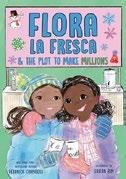
In this sequel to Flora la Fresca & the Art of Friendship (2023), Flora is determined to become a millionaire. Flora Violeta LeFevre, affectionately nicknamed Flora la Fresca, is entering sixth grade with big dreams. Superstar singer-songwriter Pilar Velez has bought an $18,000,000 home in their small coastal Rhode Island town of Westerly. Flora believes becoming a millionaire like Pilar would solve all her problems—first and foremost, it would allow her to buy a plane ticket to spend July in California with Argentinian American Clara, the BFF she desperately misses. Fortunately, a school project on entrepreneurship might offer her the first
step to millionaire status: Students will work in small teams to plan and launch their own businesses. Flora and her friends Zaidee, Aidan, and Aditya form a group, working together to sell Flora’s abuela’s thick, fragrant Aztec hot chocolate. With her summer dreams riding on her business, X is for Xocoatl, Flora has no choice but to succeed. Chambers returns with another lighthearted adventure centering on a Panamanian American girl, her family, and her diverse group of friends. Rim’s delightful black-and-white illustrations capture the optimistic energy flowing through each page. Flora’s determination, excitement, and humor are endearing and relatable, and her story will appeal to fans of Sundee Frazier’s Cleo Edison Oliver series and Hena Khan’s Zara Rules books.
A slice-of-life story that’s rich in heart. (Fiction. 8-12)
Chanani, Nidhi | Colors by Joli Hamada Abrams Fanfare (216 pp.) | $24.99 September 23, 2025 | 9781419759581 Series: Super Boba Café, 2
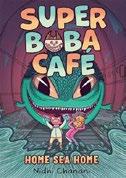
Aria and Nainai must work together to help the ancient monster that’s living beneath San Francisco. Ever since returning home from her summer with Nainai, 13-year-old Aria has been experiencing terrible nightmares. Each night, she wakes up screaming, dreaming of the monster who shakes the city unless it’s fed boba from Nainai’s shop. Aria also discovers that she now has water powers that she can’t fully control, which she finds scary but also “kinda fun.” Her parents don’t understand that the monster isn’t a symbolic representation of her stress but a real problem. She finally convinces them to let her return to San Francisco in hopes of curing the nightmares. Aria and Nainai venture into the tunnels
beneath the city to confront Rano, the scaly, green, sharp-toothed monster— but they discover that it needs their help to return home to the sea. Aria and Nainai must make a lot of boba, figure out how to control Aria’s powers, and trust others who can help them help Rano. Fear, bravery, family, and friendship lie at the heart of this sequel. Chanani’s appealingly cute illustrations and effective linework, complemented by Hamada’s attractive color palette, heighten the humorous and heartfelt moments. Fascinating facts about San Francisco’s history are woven into the monster’s story. The previous book established that Aria is Taiwanese and Indian American. The ending tantalizingly sets the stage for the next series entry.
Another suspenseful, lively, bobalicious adventure. (notes about San Francisco) (Graphic adventure. 8-12)
Clarkson, Giselle | Gecko Press (96 pp.) $24.99 | October 7, 2025 | 9798765670514

A charming oversize field guide that aims to transform young readers into “omnibird” detectives, encouraging them to investigate the fascinating world of birds through observation and deduction. New Zealander Clarkson presents birding as an engaging mystery-solving adventure and introduces the concept of an “omnibird”—a universal bird template that helps readers identify and understand any species they encounter. The approach is refreshingly practical, moving beyond simple identification to explore bird behavior, anatomy, and ecology. What sets this guide apart is its perfect balance of scientific accuracy and playful humor. Clarkson’s colorful illustrations are particularly effective, combining detailed anatomical diagrams with whimsical touches—from
cartoon speech bubbles revealing what birds might be thinking to amusing visual comparisons (like the fact that T. rex was an ancestor of modern birds). The substantial “Notes From 18 Investigations” section covers everything from duck behavior to owl anatomy, while practical “How To” sections will help hone concrete skills like spotting fledglings, holding chickens, and helping a bird find its way back outdoors. The book’s detective framework cleverly reframes birding as puzzle-solving rather than memorization, making it equally appealing to dedicated young ornithologists and reluctant nature observers. The thick, durable paper and ecofriendly vegetable ink printing enhance the detailed, delightful illustrations while demonstrating a genuine commitment to environmental values—a perfect complement to its nature-focused mission.
A truly stellar work that will delight bird enthusiasts while converting the ambivalent into eager avian investigators. (index) (Nonfiction. 8-13)
Cooper, Elisha | Roaring Brook Press (40 pp.) $18.99 | February 24, 2026 | 9781250364395

A day in the life of a house cat…who thinks he’s a bird. The book begins like so: “The Rare Bird flew through the forest, / flying so fast he knocked the leaves off the trees.” Actually, none of that is true. There is no bird, there is no forest, and there are no trees. But there is a house cat with a big imagination: The animal jumps from a curtain to a paper-lantern light shade as if they are tree branches before proceeding to cavort “under the splashing waterfall” (a running shower) and to leap “into the gurgling pond” (a toilet). On the cat goes, having a glorious time, and with no awareness that his antics might be irritating the house’s tan-skinned human residents. (“He sang his morning song to
the delight of everyone in the forest.”)
Loose pencil and watercolor illustrations, ranging from two-page spreads to vignettes, tell the real story—the words “he caught a worm” correspond with a thumbnail of the cat pawing a dog’s worm-shaped tail. Marvelously, Caldecott honoree Cooper doesn’t have to explain that the text is a feline fantasy; the art does the work exquisitely. The cat’s wild imagination even infiltrates his midday nap: Breathtaking wordless spreads find him dreaming that he’s a bird flying around outside with his feathered friends. As for the cat’s nighttime dream, that’s a whole different animal. Pure imagination. (Picture book. 3-6)
Curran-Bauer, Christee | Union Square Kids (80 pp.) | $13.99 | December 2, 2025 9781454960973 | Series: Pigeon Private Detectives, 3
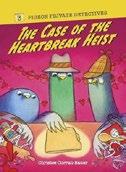
The Pigeon Private Detectives (PPD) return for their third urban investigation. Detective Martin P. Sweets and his avian colleagues will need all their skills for this latest outing; The Big Bake-a-Thon: Valentine’s Edition is being filmed in City Park, and supplies such as cake tins and cookie cutters are going missing. Mama Pigeon, Detective Sweets’ devoted mother, is serving as guest judge and calls upon her son and his colleagues to help—and they eagerly oblige, finding evidence that provides a possible hypothesis. Helped by Curran-Bauer’s colored pencil artwork, astute readers will reach their own conclusions early on: A news report of a groundhog who refuses to answer the door on February 2 offers some foreshadowing as to what might be going on. The PPD dutifully gather clues and conduct relevant research as the disappearances and the delicious competition continue. Once more, food figures heavily; the puns are less pervasive than in the earlier books
but still prominent in chapter titles: “Hearts and Crafts,” “Facts and Pinions,” and “If the Choux Fits.” As always, the mood is lighthearted, and the blend of chatty prose and graphic novel–style paneling makes for an ideal read for mystery novices; the information on hibernation, baking, and corvids laced throughout and found in the backmatter is the icing on the cake. A tasty blend of humor and facts that will leave readers hungry for more. (glossary) (Mystery. 6-9)
Datcher, Michael | Illus. by Charly Palmer
Random House Studio (40 pp.) | $18.99
October 7, 2025 | 9780593429365

A poetic, honest, child’s-eye view of divorce. Auset’s parents named her to honor their
African American ancestors, but family honor didn’t prevent divorce. As Auset mourns being split between two homes, she finds comfort and strength in the music of Bob Marley and Sweet Honey in the Rock. Auset’s therapist isn’t skilled at “sewing kids back together,” but the protagonist confides in her stuffed animal, Dolphie the Dolphin, who knows about being “stitched / Back together” and doesn’t write notes about her when she cries. Auset’s parents’ excitement over her good grades lessens the impact of the divorce, but the family division still cuts deeply. After kids criticize Auset’s raspy voice and boyish clothes, she feels better from learning new things, listening to music she loves, and excelling in karate, but she’s not proud about hurting another kid with her martial art. Auset hides her true
feelings from her mom but shares them with her dad, with whom she keeps it real. Palmer’s textured, full-color acrylic-on-canvas board illustrations capture both Auset’s love for her parents and her turmoil over their divorce, even though both are still actively involved in her daily life. This homage to Bob Marley, whose image and lyrics appear often, demonstrates that divorce is hard on kids, even if things are “gonna be all right” eventually.
A beautifully illustrated tale that will help children of divorce feel seen.
(Picture book. 4-9)
Dawnay, Gabby | Illus. by Mona K Magic Cat (112 pp.) | $14.99
October 7, 2025 | 9781419779688
Series: 5-Minute Discovery Stories
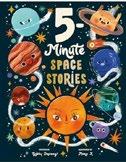
Personable planets and animated astronomical bodies introduce themselves in spirited verse. Dawnay presents 10 poems of regular fourbeat rhyming couplets (iambs and anapests), with a fact-filled page after each chapter. In proud, sometimes sassy voices, personified celestial bodies directly address readers; among them, the characters we meet are the moon, Earth, the entire solar system, the four “rocky” terrestrial planets, the four gas giants, the “remnants” (asteroids, meteoroids, comets, debris), the Milky Way, the sun, the five dwarf planets (Ceres, Pluto, Haumea, Makemake, and Eris), and finally a nebula cloud, a “nursery” for new planetary bodies. The bright, cheerful illustrations stylize the
A tasty blend of humor and facts that will leave readers hungry for more.
THE CASE OF THE HEARTBREAK HEIST
astral objects. Stars have sharp points; the nebula beams. Eyebrows and lashes adorn some eyes, while others are round or almond-shaped. Usually the heavenly bodies are simply round faces, but an occasional hand or tongue protrudes. Colors can convey astronomical information: Saturated blues suggest the depths of space or the gaseous ice giants; red, the iron of Mars or hot meteors (but cold Jupiter is also red); green, Earth’s vegetation. These versified vehicles for information are impressively precise and enlightening. Aspiring astronauts will be starstruck. (further reading) (Nonfiction. 5-7)
de Castro, Javi | Flying Eye Books (64 pp.) | $12.99 paper | December 2, 2025 9781838743550

A boy encounters curious creatures on a strange galactic journey. Cosmo is ready to test a jet pack prototype, but things go haywire as soon as it’s activated. Thrust deep into swirling space, he’s found by a purple creature who looks distinctly like an upside-down light bulb and who turns out to be most hospitable, offering Cosmo nachos and a place to rest. Soon, a careless push of a button sends Cosmo hurtling headlong into a lush jungle, where he discovers a wiggly white bloblike creature in search of its family. The pair proceed to a bustling city, where they narrowly evade a great green sewer monster and meet a bald, bearded, pink-skinned magician who vows to send them homeward. His specious spell simply flips them topsyturvy, and the story literally turns upside down as well. Youngsters must then flip the book over, reading from back to front and viewing the peculiar planetary passage in a new light—the seemingly bald magician grows a full head of hair, frowns become smiles, and a sinister skull
cracker replaces the harmless nachos— but all is made right in the end. De Castro’s creative concept is impressively executed; each image must work turned on its head, and it does. Moreover, Cosmo’s interstellar odyssey is so fun and fully realized that readers will intuitively understand what’s going on, making it a page-turner, twice over. In de Castro’s squared-off, thick-lined cartoon artwork, Cosmo is light-skinned and wears a spacesuit throughout.
A wild ride with a wonderfully weird cast of creatures.
(Graphic science fiction. 5-9)
DeHoney, Jeanine | Illus. by Robert Paul Jr. Sleeping Bear Press (32 pp.) | $18.99
August 1, 2025 | 9781534113336
Series: Own Voices, Own Stories
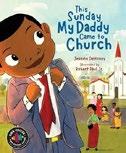
Dressed in his Sunday best, Omar goes to church every week with his mother but wishes his dad would come, too. “Daddy doesn’t go to church,” even as young Omar and his mother prepare to leave home, hoping that he’ll change his mind this time. But Daddy prefers to spend his Sundays “doing much of nothing or a little bit of something.” Paul’s bright, full-colored digital art depicts a Black family that’s nevertheless loving and supportive despite their differences of opinion. As mother and son walk to Ebenezer Church, a community made up of people of varied skin tones greets the duo in the street. In the pews, even as Omar and his best friend, Imani, make funny faces at one another, the absence of Omar’s father is felt. Back at home, Omar’s father has prepared lunch and dinner with his free time, but from Omar’s detailed and earnest narration, it’s clear that he and his mom share a lingering dream of their whole family attending a Sunday service together. Still, “sometimes worship isn’t in a building,” Mom assures son and readers alike. Daddy
eventually shows up to church in the suit and tie laid out for him by his loved ones, met by a big, exuberant smile from little Omar—a moment that may read as passive aggressive to some but that will earn smiles from others, particularly those who have found themselves in similar situations. In this tender tale, church-going wins over a relatable father with charm and bite-sized guilt. (Picture book. 5-8)
Delaunay, Amandine | Phaidon (48 pp.)
$24.95 | October 8, 2025 | 9781837290208
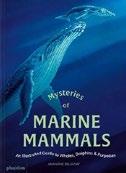
An enchanting close encounter with some beloved denizens of the deep. Many kids (and adults) understandably love aquatic mammals. Delaunay presents them from the inside out, in well-organized chapters with short paragraphs covering sleep habits, habitats and migration, reproduction, and diet. Several sections are devoted to these creatures’ social structures and communication, both complex enough that scientists believe cetaceans have their own group cultures. A chapter on the dangers whales face is optimistic, though Delaunay acknowledges that they still face plenty of threats. Indeed, descriptions of collaborative hunting strategies provide concrete evidence of cetacean smarts and social bonds. Though the focus is on facts, Delaunay also briefly summarizes the Inuit story of the Sedna, goddess of the oceans, and quickly lists several other “whale tales.” The writing is a model of clarity and concision. The great variations among cetaceans is evident from both text and art. Large engravings make the most of the subjects, with deep blues, white highlights, and occasional bits of color; point of view and compositional shifts are used to
The Supreme Court justice and author looks back to her childhood—and forward to her legacy.
BY MAGGIE REAGAN
“MY MOTHER HAD an extraordinary capacity to forgive,” says Justice Sonia Sotomayor. “It’s something I think I’ve learned from her. I’m still not quite the woman she was, but I’m closer.”
She’s calling in via Zoom from the Penguin Random House offices in New York, and behind her is a copy of her latest picture book, Just Shine! How To Be a Better You. Luminously illustrated by Jacqueline Alcántara and similar in structure to Sotomayor’s Just Ask! (2019) and Just Help! (2022), the book is an evocative tribute to her late mother, Celina. Drawing from Greek mythology, with an epigraph from the Homeric Hymns, Sotomayor compares her mother to the moon deity Selene; she explores the ways in which the everyday acts of kindness and generosity Celina performed throughout her life made the world a brighter place. Our conversation has been edited for length and clarity.
This is your fourth picture book for children. What about the format appeals to you?
I didn’t start out thinking I would be a children’s book author. I didn’t start out thinking I’d be an author at all. If you know my biography, you’ve heard that I spoke Spanish before I spoke English and struggled until my young adulthood with learning how to speak and write English properly. It was Philomel Books and [publisher] Jill Santopolo who came to me and proposed writing a children’s picture book about my life. My first reaction was that there’s already a children’s book about me [Sonia Sotomayor: A Judge Grows in the Bronx /
It’s a collaborative effort when you work with me—I enjoy the process.

La juez que creció en el Bronx] that I really like! But they suggested I tell my life story through the influence of books, and the idea was enough to make [my first picture book] Turning Pages a reality. I enjoyed the process tremendously, mostly because the thing I’ve learned the most is how to condense very complicated ideas into very concise and simple language.
Justice John Paul Stevens, who I overlapped with on the Supreme Court my first year, once said to me when I was unsure about what kind of justice I would become, “No one’s born a justice. You grow into it.” You live life learning lessons, and sometimes those lessons can be painful as you learn them. But my interactions with children, as a result of my books, have made me realize that that’s what drew me into becoming a children’s book author—that I could help them see things that took me so many years to learn.
Just Shine! is a book about being a light in the darkness, but that means you have to show a lot of the darkness. From your perspective, what’s the best way to help kids confront the darker things like grief and loss and war?
Every child is going to experience sadness. Learning how to navigate that space of sadness is a life skill—learning not merely about coping with it, but how to thrive from it. In some ways that’s what Just Shine! is talking about—it’s teaching children that from these moments of sadness, you can still draw some incredibly powerful and important lessons and a sense of being and belonging that can help you take next steps in life. For most people, it takes so many years to come to terms with that, and I’m hoping to give kids an edge.
The book often feels like a folktale— your inspiration and opening lines come from Homer—and kids won’t necessarily know it’s about a real person. Can you talk about how you took what is, for you, a very personal story and made it feel more universal?
This is the hardest children’s book I’ve had to write. The earlier versions were really my grief about losing my mami coming out on paper, and sharing it would
not have helped children understand, because it was a personal conversation I was having with my own mother. When I changed my perspective, I realized I could write a story not about her, but about how she made other people feel. I recognized when I was writing that the moment I shifted the focus from her or me to others—and how she’d made them feel—that it could be a story people could identify with, that I had the power to help other people feel special, just like she had shown me.
As a character, you yourself only show up in the book’s illustrations. How closely did you work with illustrator Jacqueline Alcántara?
I am told that I work more closely with my illustrator than most authors do! From the very beginning, I stuck my nose into every illustration. I have a fairly large suitcase filled with all the family photos I’ve been able to accumulate, left over from my mother and other family members, and those photos are the story of not just my mother’s life, but the life of everyone who’s been important to me.
Jacqueline spent the day with the photos, and we talked about what I saw in them. When the first illustrations came to me, I just knew she’d nailed it. We had a long conversation about whether I should be on the first page, where I’m sitting at a desk writing the story. It’s a collaborative effort when you work with me—I enjoy the process, because a picture book is words and pictures, and I think the impact has to be joined. If it’s not, then no matter how wonderful the words are, the message will not be as impactful.
You’ve spoken in other interviews about how your mother was an incredible guiding force throughout your life, but also how she could be distant, which makes the moon imagery you use throughout the book so much more powerful. A picturebook narrative is so concise—how did you balance these realities?
I don’t think anybody should ever believe that my relationship with my mom was perfect. We had a rocky start in life, and it took us decades to build our relationship to where I could write a book like this and

Sotomayor, Sonia | Illus. by Jacqueline Alcántara Philomel | 40 pp. | $18.99 September 9, 2025 | 9780593206294
mean every word. What I came to learn, and it was through her help, was that all the things I had been resentful about were never intentional—they were products of her own limitations in life. My mom’s willingness to listen to the things that had caused me pain and to respond to them—not dismissing my feelings or denying them, giving me the opportunity to understand where she’d come from and why—led both of us to be able to forgive.
A lot of kids today are pushed to leave a mark on the world, and I love the value that this book places on ordinary kindness and care as a legacy. I’m often asked what my greatest legacy will be, and the expectation is that I’ll say something that I’ve written as a Supreme Court justice that will be remembered in history. But the reality is, while I’ve certainly read some very great Supreme Court decisions, I don’t remember the men who wrote them. I don’t know anything about them.
I tell the kids that I speak with on these book tours that my greatest legacy will be the last child who remembers something I’ve said or done that helped them manage something in their life. Once I die, I will be alive through that last child whose life I helped make easier in some way. And that, I hope, could be a very long time.
Maggie Reagan is a program manager for the American Library Association and lives in Chicago.
dramatic effect. The book’s up-to-date information, oversize illustrations, and broad scope make it ideal for casual browsing as well as in-depth study, though no backmatter is included. Fascinating and dense with information: a beautiful celebration of all things cetacean. (Nonfiction. 9-12)
Delsooz, Shiva | Owlkids Books (32 pp.) $18.95 | October 14, 2025 | 9781771477031
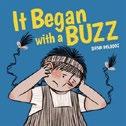
A child reflects on struggling with tinnitus. “It sounded like a bee,” the young narrator says of the constant buzzing noise that no one else could hear. But the narrator could: “I couldn’t think clearly…and I felt very alone.” Scratchy cartoon illustrations vividly convey the child’s frustrated attempts to banish the buzz, which Delsooz portrays as a hovering bee. Nothing seems to help. Finally, the narrator gets a diagnosis—a doctor points to a vaguely drawn diagram of the brain and inner ear labeled “tinnitus” but provides no advice or help. Just as the prognosis appears hopeless, the child winds up a music box, and in a rainbow burst of notes, “the buzzing quiet[s],” offering “magical” relief. “There will always be buzzing,” the narrator acknowledges, and while some days are difficult, “I listen to my music…and keep going.” The word tinnitus is limited to the illustrated diagram, and some readers may wish for more concrete details. Still, likening the condition to a pesky bee may help youngsters conceptualize the condition. In particular, a humorous depiction of the tinnitus-bee accompanying the narrator’s music box on the piano reassuringly underscores that, though tinnitus may be annoying, it can be tamed. While the narrator’s mitigation method might not work for everyone, many will be inspired to find their own coping mechanisms. Characters have light skin. An encouraging take on coping with a frustrating condition. (Picture book. 4-8)
Roman Holiday
Dempsey, Sheena | Bloomsbury
(240 pp.) | $12.99 | November 4, 2025
9781547617623 | Series: Pablo and Splash, 3
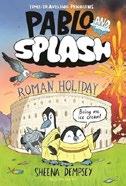
In this third series entry, the penguin buddies travel back in time to ancient Rome on a dare. What could go wrong?
Promising an irritatingly skeptical classmate proof that they can “krilly” time travel, Pablo and Splash board the TimeBender invented by their favorite scientist, pink-haired Professor O’Brain, for another junket into the past. Somehow unsurprisingly, given their penchant for chaos, after touching off an eruption from Mount Vesuvius and searching fruitlessly for the Leaning Tower of Pizza, they fetch up in the Colosseum in Rome. There, they join an assortment of captive exotic birds that are slated for slaughter by gladiators for the amusement of the crowd. The spirits of Laurel and Hardy and the Three Stooges loom large in these ancient antics as the squabbling penguins bloodlessly (if not pooplessly) go on to turn the tables on their captors and pull off a general rescue with help from some 300-pound Kumimanu (extinct giant penguin) cousins from prehistoric New Zealand. (“Woah,” exclaims a voice in the crowd, “those are some BIG BIRDS.”) Potty humor and repeated exclamations of “Oh my COD” make the frantic scramble all the more enjoyable. Dempsey’s cartoon panels are as bright and sunny as the story. More riotous pickles to waddle through for this Antarctic odd couple. (Colosseum and natural history facts, drawing lesson) (Graphic adventure. 7-10)
Dinh, Hà | Whitman (32 pp.) | $18.99 September 4, 2025 | 9780807510728

During Tết Trung Thu, a young boy of Vietnamese descent finds a way to honor the legend behind the celebration.
Huy is beyond excited. He’s been waiting for the MidAutumn Festival—also known as the Moon Festival—all year. But he wonders: “If the festival is for the moon, why are all the lanterns in the shapes of stars?” So he goes to his Ba (father) for answers. As the two make a lantern together for an upcoming competition—a tradition that reminds Ba of making lanterns with his own father back in Vietnam—Ba reminds Huy of the folktale of Chú Cuội, a woodcutter who floated all the way to the moon. During Tết Trung Thu, children create star lanterns to help him make his way back home. Huy is determined to make a lantern honoring the moon. When it comes time for the contest, Huy realizes that indeed, he has the only moon-themed lantern, and as the others display theirs, a sudden gust of wind blows out everyone’s lights—except Huy’s. He in turn takes the opportunity to relight everyone’s lantern while explaining the meaning behind his design, eventually winning the contest. Vietnamese words and rituals are deftly interwoven throughout Dinh’s straightforward, concise narrative, complemented by the cozy cartoons, illuminated with bold colors and textured with lines and shadow. A charming holiday tale of a child honoring tradition while marching to the beat of his own drummer. (author’s note, glossary) (Picture book. 5-8)
More riotous pickles to waddle through for this Antarctic odd couple.
PABLO AND SPLASH
Dobbs, Alda P. | Illus. by Emily Mendoza
Sourcebooks Jabberwocky (40 pp.) | $18.99
September 2, 2025 | 9781728297811

A flower’s history links Mexico and the United States. The poinsettia, originally a wildflower that grew in Mexico, has had many names. The Nahuas called it cuetlaxochitl, or “mortal flower that withers, like all that is pure.” When Spanish friars arrived in Mexico and encountered the flower, a legend rose about “Pepita, a poor mestiza girl with a giving heart,” who was mocked for placing weeds in a Nativity scene until its flowers burst forth, giving it the name flor de nochebuena, or “flower of the holy night.” It was renamed the poinsettia when an American ambassador and botanist, Joel Roberts Poinsett, visited Mexico and sent clippings of the plant back to the United States. Dobbs’ narration alternates awkwardly between printed narration and italicized poetry that ends with the refrain “You just wait and see.” The implied suspense, however, doesn’t manifest. What are we waiting to see? The latter half of the book focuses on the poinsettia’s ubiquitous holiday appearance in American culture from the White House to TV talk shows. Eventually Dobbs encourages readers to find beauty, “then give it back to the world”—a perfectly lovely sentiment that reads like an afterthought. The digital illustrations, showcased as full-page spreads in between the text, have a cartoonish character that feels a bit at odds with the solemnity of the story. An intriguing idea that doesn’t quite come together. (history of the poinsettia, timeline)
(Informational picture book. 4-8)

Dodd, Emma | Templar/Candlewick (24 pp.)
$17.99 | January 20, 2026 | 9781536247480
Series: Emma Dodd’s Love You Books

A parent marvels over a beloved little one.
A tiny lamb with fuzzy wool—illustrated with digital textures—gently nuzzles a larger sheep. “Isn’t it amazing?” wonders the narrator. “I can’t believe it’s true… / Of all the children in the world, I had you!” The lamb cavorts happily in a sun-drenched meadow before turning to face readers in an extreme close-up, eyes wide. “You have the sweetest nose and the loveliest of eyes. // Your smile is the best, and your laugh is just right. / You were made for kissing and cuddling tight.” Even in the pouring rain, the narrator can’t find fault: “When you’re feeling down, you’re still my number one.” But amid all the newborn wonder, curiosity abounds. “You are so much more than the sum of all these things, // and I can hardly wait to find out what your future brings.” Outlined in thick, loose, black lines, the parent and child stand out against muted farmland backdrops from sunrise to sunset. Following a classic Dodd pattern, the text rolls gently along in sweet rhymes and, of course, brims with tenderness.
Snuggle in close, and read together; a surefire baby shower hit. (Picture book. 1-3)
Dodd, Emma | Templar/Candlewick (24 pp.) | $17.99 | September 30, 2025 9781536243956 | Series: Emma Dodd’s Love You Books
centered on a fox parent and two kits. There’s no story to speak of; rhymes carry readers through a day enjoyed by the foxes, during which they think fondly of their loved ones, cuddle and cavort in the snow, enjoy a “holiday feast” (purple berries from a bush), and behold the night sky (“We snuggle together / under the stars, / and we are reminded / how lucky we are”). The book reads like something between a poem and a prayer and makes a hard sell for winter’s splendor. Winter is described as “the best time of year,” and Dodd emphasizes that readers will “remember / each winter forever.” Though the text borders on bland, that’s of no import. The book’s calling card is Dodd’s chunky but sumptuous digital art: The adorable, ever-smiling fox family’s gleaming orange fur is radiant against the wintry forest tableaux. The book’s showstopper is a final image of the trio curled up in their den on a leaf bed, the round door leading outside a portal to the stars.
A charming winter wonderland. (Picture book. 2-5)
Star
Donnelly, Rebecca | Illus. by Mercè López Henry Holt (40 pp.) | $18.99
February 10, 2026 | 9781250828538

For more by Alda P. Dobbs, visit Kirkus online.

For one forestdwelling fox family, winter is bliss.
“Winter is special / in every way— / a time for family, / sharing, and play.” The bounce of that opener is typical of the verse that appears throughout this ode to winter,
A decidedly tardy tribute to a brilliant 19thcentury scientist and suffragist. Starting with a title appropriate in both the literal and figurative senses, Donnelly follows Eunice Newton Foote (1819–1888) from childhood on a New York farm to a scientific education at the daringly innovative Troy Female Seminary. From there she continued on to active participation in the 1848 Seneca Falls Convention, which produced the suffragist Declaration of Sentiments. Later, inspired by recent evidence that the
Earth was once hotter than it was at the time, she set up an experiment that proved that carbon dioxide played a crucial role in warming the atmosphere and thus the planet—five years before John Tyndall, the supposed father of climate science, reported the same. Though Foote published two scientific papers in her lifetime (the first American woman to do so), her contributions went largely unrecognized until 2011. Happily, Donnelly pays proper tribute to this unusually well-educated woman, clearly describing her atmospheric experiments in lucid, sharply honed prose. Just as importantly, she frankly acknowledges that worthy though their cause was, suffragist leaders excluded Black women and men from their demands for equal voting rights. Change might have been “in the air,” but not for all. A small, straight-backed figure in voluminous period dress, Foote poses in the illustrations surrounded by evocative contextual clues, from contemporary marchers to abstract geometric shapes, plus glimpses of fossils and factory smokestacks. A nuanced portrait of a woman who was ahead of her times in more ways than one. (timeline, more information on Eunice Newton Foote, web resources on climate change, bibliography) (Picture-book biography. 7-10)
Duncan, Alice Faye | Illus. by E.B. Lewis Calkins Creek/Astra Books for Young Readers (32 pp.) | $19.99 January 6, 2026 | 9781662680311

A challenging pep talk composed of individual words and phrases selected from a rare 1967 speech by Dr. King to an audience of junior high school students.
The key lines and uplifting sentiments chosen for this “erasure poem” sometimes show their age, but they still make inspiring reading. The text floats on Lewis’ evocative images of opening
doorways and marching footsteps, of small figures standing on a mountaintop or rising through clouds, and of hands shaping a heart or holding a tool. “I want to suggest things that should be in your life’s blueprint,” King said. He went on to speak of believing in being Black, beautiful, and good; of staying in school; of rising up like Marian Anderson and Muhammad Ali; of choosing nonviolence over hate (“Our slogan must not be ‘Burn, baby, burn’”); and of transforming injustice into justice. Most of all, he urged, “DON’T SET DOWN / ON THE STEPS / ’CAUSE IT’S / HARD. / KEEP MOVING.” Duncan explains how readers can watch a video of the original talk and provides instructions for making an erasure poem; she closes with a quick summary of the Civil Rights Movement’s hard-won triumphs. It’s uncomfortable to consider how much of that last will be news to today’s middle schoolers.
Pithy, rousing, and never more cogent. (list of historical references, bibliography) (Picture book. 6-9)
Ecton, Emily | Illus. by David Mottram
Atheneum (288 pp.) | $17.99
November 11, 2025 | 9781665966467
Series: The Great Pet Heist
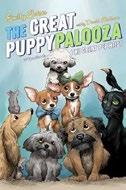
Helping five stray dogs stay out of the clutches of Animal Control really keeps the residents of the Strathmore apartment building on their toes, paws, claws, talons…and suckers.
It’s a mission worthy of the type of rescue dog Butterbean yearns to be:
hiding gruff Bruce and the four active puppies trailing him from beloved (but overwhelmed) Mrs. Food on the fourth floor, Mrs. Hates Dogs on Six, and the building’s other humans, all while also keeping the persistent, lurking dogcatcher at bay. With the help of confederates— including Chad the octopus, slithering out of the plumbing and eager to help give the obliging pooches cute makeovers, and Walt the white cat, who employs surprising computer skills to generate a printed flyer to pass out—finding them safe homes should be a snap, right? For series followers, the animals with recurring roles form an engaging ensemble with well-known quirks and foibles, while the ensuing mad scramble to carry another unlikely scheme to fruition and keeping at least some of the two-legged cast members in the dark entails the expected whirl of twists and narrow squeaks. The general tone may be comedic, but the issue of abandoned pets and a concurrent plotline involving a young resident and her deployed aunt add whiffs of more serious themes. Readers will wish to see more of Mottram’s illustrations, which are full of uncommonly winsome small animals. More madcap, multispecies hijinks. (Adventure. 8-12)
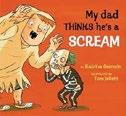
Germein, Katrina | Illus. by Tom Jellett Walker Books Australia (32 pp.) | $18.99 August 5, 2025 | 9781761601606 Halloween wouldn’t be the same without candy, costumes, and, in this case, comedy. A pale-skinned, red-haired family eagerly awaits a fun evening of trick-or-treating. Throughout
the night, Dad, dressed as a ghost, assails his family with groan-worthy puns. (“Guess what I use to wash my hair… Sham BOO! It makes it BOOtiful.”) As the family goes from house to house, Dad keeps up a running commentary peppered with a nonstop stream of puns. “Spooooo-key,” he says as Mom locks the door. He points out that the cemetery is “a great place for stories” (because it has “so many plots”), and he proposes “ghost chicken and grave-y” for dinner. As the night comes to a close, the family collapses on the couch and falls asleep amid a pile of candy wrappers while Dad continues with the wisecracks. Germein’s first-person text, told from the perspective of one of the children, is filled with relentless quips and wordplay; enjoyment will vary depending upon the reader’s tolerance for dad jokes. While Jellett’s enthusiastic digital art, rendered in a palette of warm, seasonally appropriate colors, feels a bit crowded at times due to Germein’s text—presented in variously sized fonts—it nevertheless captures the bustle of Halloween night as well as a fun family dynamic, though some especially corny lines will elicit the occasional eye roll.
A pun-derstorm of wordplay that celebrates quality family time as well as spooky season. (Picture book. 4-8)
Hallett, Braden | Annick Press (304 pp.) $15.99 paper | September 30, 2025 9781834020013 | Series: Secrets of Ravensbarrow, 3
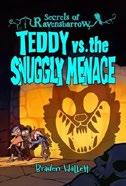
When Teddy pursues his cherished cat and source of comfort, Mr. Fuzzikins, into the dark woods, he’s pitted against his own fears— as well as hostile squirrels, fields of bones, and other terrifying surprises.
In this third series entry, Teddy continues to struggle with his rampant anxiety. For starters, he’s convinced that
his classmate’s “snuggly pupper,” a Corgi named Hashbrown, is out to get him—staring “with the searing intensity of a HATEFUL CORGISH SOUL!” But the mild reaction of his friends to this news sparks more of Teddy’s hysterical meltdowns and unkind words. His overwrought tempests may wear on readers, but his friends show commendable patience. As Shane, Hashbrown’s owner, says, “We’re friends, Teddy. But I still think we might need an apology.” They also readily provide support when Teddy stumbles off into the magical woods after his errant cat. As it turns out, when a giant shark-o-spider attacks, Mr. Fuzzikins—or “Hunter Hollowfang,” as the suddenly loquacious kitty prefers to be called—isn’t the one who most needs rescuing. Hallett’s lavish illustrations dish up arrays of creatures, both common and nightmarish, as well as a diverse cast of Ravensbarrow residents. White-presenting Teddy, who’s shadowed by a small, sketchier image representing his nagging fears, generally bears exaggerated expressions of rage, remorse, or bulgingeyed terror. Ultimately, he comes through with a selfless act of courage that may hearten children who struggle with big feelings of their own.
More about the emotional roller coaster than the monsters, but still fun. (Comic horror. 8-11)
Harper, Charise Mericle | Illus. by Liz Climo Little, Brown (48 pp.) | $18.99 February 24, 2026 | 9780316364942

A girl who thinks she’s a friend to the animals realizes she isn’t much of one and tries to make things right.
A little girl with beige skin and wavy brown hair is such an animal lover that she has a framed picture of her pals—two squirrels, a snail, and three crows—hanging on the wall at her house. But when she goes outside to play with them, she inadvertently makes their lives difficult. For starters, although she announces that “squirrels love to play hide-and-seek with
nuts,” dialogue balloons translated from squirrel-speak show the two animals grousing, “She dug up our nuts!” and “Why is she always doing this?” The girl demonstrates similar cluelessness while interacting with the snail. Finally, after a crow makes off with her sandwich, she reflects on her day and realizes that her shenanigans have hindered her animal friends’ abilities to access their food— they’re hungry!—so she fixes her mistakes. Climo’s scrupulously clean, cartoonish digital art can do only so much for a story that’s herky-jerky and confusing due to its changing perspectives and the ambush of running text, dialogue balloons, thought bubbles, and free-floating friendship mottoes (“Friends should not keep friends waiting” is one of several scattered throughout the book). One senses that a sturdier friendship story wouldn’t need the mottoes, which are sometimes used wryly, or the protagonist’s expository monologues to get the point across.
Good message, flawed delivery system. (Picture book. 4-6)
Heikkilä, Cecilia | Trans. by Polly Lawson Floris (44 pp.) | $19.99 | August 5, 2025 9781782509530

Ingratitude breeds monstrous results in this entrancing cautionary tale, originally published in Sweden. To say that there’s an imbalance of power in Fox and Mole’s friendship would be an understatement. Fox is responsible and generous, while Mole indiscriminately takes without regard. Even so, the two enjoy reading together each night. One day, Fox reads The Legend of the Scuffling Monster, about a raccoon who transforms into a horrifying creature. Soon after, Mole forgets Fox’s birthday, coming over instead to eat anything on hand.
“Something thorny [finds] its way to Fox’s heart,” and when he undergoes a grotesque transformation of his own that evening, Mole finds himself on the receiving end of a famished, voracious companion. When Heikkilä warns at the start that “the middle of the story might be a bit spooky,” she isn’t kidding; her standout illustrations are as capable of eliciting terror as laughs. One minute Fox is amusingly staring into space as an oblivious Mole prattles on; the next, a silent, two-page spread depicts two haunted yellow eyes against a dark background. Like Ed Young’s Lon Po Po (1989), the tale is laced with hints of the monster in the shadows. Heikkilä infuses her compelling narrative with an important, though never heavy-handed, message about balance in relationships as she explores what happens when generous souls swallow down their irritations and resentment.
A triumphant blend of humor and horror, perfect for teaching and scaring by turn. (Picture book. 4-7)
Herzog, Danielle | Jolly Fish Press (288 pp.) | $16.99 paper | October 21, 2025 9781631639852
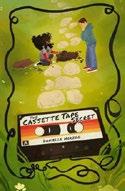
Mysteries are always better with a friend.
Thirteen-yearold Alex’s world is suddenly turned on its head when new student Ida May requests to work with him on a school project for their Technology and Living class. Most students avoid or tease Alex because of his “OCD tendencies,” but Ida May sees something else in him—specifically, a person who can fix a cassette player. Ida May discovered an old cassette tape bearing a cryptic label reading, “Please Georgia?” at a local thrift store (a preface explains this technology to readers). Her conviction that the tape contains something important pulls both her and Alex into a decades-old story of fame, love, and death. As their
friendship develops, Alex’s struggles to overcome his debilitating OCD impulses manifest with an honest sensitivity that many readers will appreciate. A subplot involving Ida May’s rocky family life also emerges, but it plays a less significant role. With its short chapters and a snappily paced plot, this work has broad appeal. The mystery is cozy enough that more sensitive fans of the genre—ones looking to avoid serious scares—will feel comfortable, but it contains enough twists and turns to ensure that others will remain engaged as they piece together the clues. Alex is cued white. Brown-eyed Ida May is racially ambiguous; the book contains frequent references to how voluminous her curly black hair is.
An engaging mystery blended with a strong story about forming a new friendship. (Mystery. 10-14)
Hilario, Mel & Lauren Davis | Illus. by Katie Longua | Oni Press (192 pp.) | $14.99 paper November 4, 2025 | 9781637158760
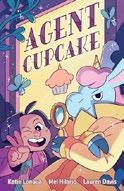
Unicorn magic has been stolen, and only spy skills will get it back.
It’s middle schooler Miguel Mangayayam’s first day working at the Mystical Beasts Bureau—as its first human field agent, no less. He meets his very first unicorn when trench-coated, pointy-horned Agent Cupcake is assigned as his partner. And soon Miguel’s working his first case: looking into Paleontologie, a high-end fashion brand that may be illegally smuggling phoenix feathers to use in its designs. While investigating, he accidentally uncovers a deeper plot—Paleontologie’s parent company is pilfering unicorn power. It’s a lot for the new kid to take in, especially since he’s hyperfocused on fitting in with the magical team—and a lot for readers as well. A focus on spying and specialized surveillance equipment
offers a lot of juicy info for those intrigued by espionage. The authors and illustrator set this graphic novel in a world where a panoply of creatures worthy of a medieval bestiary seamlessly coexist with humans. The conflict between corporations and small, unicorn-based businesses feels rather close to contemporary capitalist realities. Relying on solid story crafting and candy-colored yet noncloying visuals, the work pulls all these points together for an intense, riveting read. Miguel is tan-skinned; his surname suggests that he has Filipino heritage.
A spellbinding lesson in spycraft with magical appeal. (spy techniques glossary, profiles of real-life spies) (Graphic fantasy. 9-13)
Hunter, Erin | Adapt. by Natalie Riess & Sara Goetter | Illus. by Natalie Riess & Sara Goetter HarperAlley (272 pp.) | $15.99 paper September 30, 2025 | 9780063203938
Series: Warriors Graphic Novel, 3
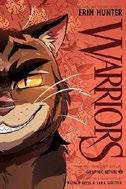
Rising tensions culminate in a savage battle even as Tigerstar’s bid for dominance over all the forest Clans fulfills the prophecy that “Lion and tiger will meet in battle…and blood will rule the forest.”
In this graphic novel, which adapts the events of the fifth and sixth novels in the Prophecies Begin series, Fireheart becomes Firestar, leader of ThunderClan, after Bluestar is killed while fighting off a pack of wild dogs. He then goes on to unite the Clans against threats from both within and without. The switch in format doesn’t help readers much in keeping track of the teeming cast; there’s no visual key, and so many of the cats differ so slightly in individual markings that even confirmed series fans may struggle to keep track of who’s who. Name changes are another issue:
Following an attack in which she has an eye torn out, Brightpaw is renamed Lostface, and finally Brightheart, and she spends much of the tale with medicinal leaves covering the healing wound, which at least makes her easy to identify. The art allows wordless montages to speed the plot along and also gives the artists license to depict tender moments of head bumping and anthropomorphic smiles and other expressions—not to mention lots of hideously vicious claws and teeth, and savage fights. Concept and character sketches at the end offer insights into the artists’ process. Unwieldy as ever cast-wise, but the visual format suits the violent, dramatic storylines. (Graphic animal fantasy. 11-13)
Hunter, Erin | Harper/HarperCollins (336 pp.) | $19.99 | November 4, 2025 9780063357112 | Series: Warriors: Changing Skies, 2

An urgent prophecy of dangerous impending change leaves the feline Clans of Sanctuary Lake wringing their paws even more in this sluggish sequel. Young Moonpaw continues to be haunted by the increasingly powerful ghost of dead littermate Morningkit, either for still-hidden reasons or to bulk up the page count. Meanwhile, veteran warrior Tawnypelt’s announcement of the prophecy revealed to her in the opener is only delivered after delays caused by heavy doses of narcotic poppy
seeds while she recovers from her injuries, followed by her son and Clan chief Tigerstar’s irrationally stubborn refusal to let her speak. Once the dismaying news is finally out, an expedition sets off to seek advice from the spirits of the Tribe of Rushing Water, since the Twolegs have blocked off the Moonpool, the Clans’ main access to their ancestors in StarClan. The author’s apparent determination to give most of the dozens of cats named in the cast list (plus a number of unlisted Tribe members) an appearance or a mention may excite confirmed series fans. Readers struggling to keep track of who’s who in the name-clogged narrative, however, not to mention those hoping for some resolution or significant twist in one of the several ongoing plotlines before this ambling episode simply trails off, are doomed to disappointment.
An uninspired placeholder that offers little beyond further feline fretting. (maps) (Animal fantasy. 9-12)
Huoshan, Lan | Clavis (32 pp.) | $20.95 November 25, 2025 | 9798890631114
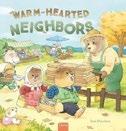
Charlie and Charlotte Woodchuck are working hard on their hibernation preparations, but they still come to the aid of all their neighbors. There’s plenty to do and only 10 days left before hibernation. Charlie and Charlotte are readying their den for winter when Bunny comes by, desperate for help harvesting carrots. Charlie offers his services: “Of course! We’re neighbors!” Charlie also offers to help Grandpa Goat fix his roof and to
This heartfelt story will stay with readers long after the tide goes out.
free Little Bear’s dad from a hole in the floor. When the Woodchucks are finally reunited, they have a lot to do to get ready for hibernation. To their surprise—and relief—all their neighbors show up to help, ensuring them a warm and cozy winter. The various animals are sweetly illustrated wearing little outfits with coats, plaid shirts, kerchiefs, and overalls. Their homes are a combination of animal burrow and human house, built into the ground, with working fireplaces and little bathrooms. Children will enjoy looking at these thoughtful details (dinosaur bones hidden beneath!) and taking in the action in each scene. The unnecessary rhyming stanzas that the animals sing, however, make for awkward read-alouds that readers may trip over. Otherwise, the story, originally published in Belgium and the Netherlands and translated from Dutch, moves along nicely while conveying a meaningful lesson about the importance of community and neighborly care. Preschoolers will surely appreciate the compelling artwork and adorable details. Succinct and effective messaging paired with darling illustrations. (Picture book. 4-8)
Kelly, Lynne | Delacorte (288 pp.) | $17.99 October 7, 2025 | 9780593898390

What begins as an octopus rescue mission becomes a summer of life-changing friendship and self-discovery. Max is tired of being Little Max, always in the shadow of Big Max, his glad-handing, big-shot city council member father. He’s ready for a fresh start, spending the summer with his mom on her graduate school research trip. They’re headed to a place on the Gulf Coast of Texas called Lafitte Island, which for Max feels full of possibility. During his first exploration of the island, Max comes across a beached
THE LETTER SETTERS IN FUN!
octopus on the shore, barely alive. His quick thinking and empathetic determination set the course for his entire summer. Max enlists Emmett, a YouTuber with a channel called “Stuff I Found on the Beach,” for help with octopus transport. Emmett leads him to Ollie Mae and her family, who run a vet clinic on the island. But Max’s bond with his octopus—whom Ollie Mae names Ursula after the sea witch from The Little Mermaid —becomes the most transformative part of his summer. As he cares for Ursula at the clinic, he also figures out how to care for himself—learning to speak up, be himself, and let go. Full of heart, a dash of science, and plenty of octopus antics, this story is a tender, bittersweet reminder that growth can come from the most unexpected of places. Primary characters present white. This quiet, heartfelt story will stay with readers long after the tide goes out. (author’s note) (Fiction. 9-12)
King, Rachael | McElderry (288 pp.) | $8.99 paper | October 28, 2025 | 9781665984218

When a New Zealand family is menaced by a creature of Scottish legend, they fight back to protect themselves and their neighbors. Grimmelings are “the first or last gleams of the day,” and Ella learned about them from Grizzly—her Scottish grandmother, Griselda, who calls herself a “word-hoarder.” Ella lives with her family (who are cued white), including little sister Fiona, their mother, Morag, and Grizzly, whose cancer has returned.
Morag runs a horse-trekking business with help from Hana, who’s Māori. Grandad drowned in the nearby lake, and Dad disappeared by the lake as well, six years ago, although his body was never found. When a class bully goes missing after Ella curses him, she feels guilty, although Ella isn’t from a house of witches, contrary to local rumor. But a kelpie has pursued her grandmother from Scotland through a “thin place” in the lake that allows passage between worlds—and it won’t leave their family in peace until they defeat it. Each woman and girl is strong in her own way, and Ella’s bond with her pony, Magpie, proves crucial in the fight, which ends in a climactic scene at the spring fair. A final chapter set at midsummer serves as an epilogue. Ella is a fierce hero, and the kelpie is a ferocious adversary. King effectively weaves together horses, Scottish mythology, and family history, threading the story with themes of conservation, awe of the natural world, and delight in new words. Prepare to be beglamoured. (Fantasy. 9-12)
Klepeis, Alicia Z. | Illus. by Jennifer Falkner
Neon Squid/Macmillan (160 pp.)
$19.99 | October 7, 2025 | 9781684494514
Series: Nature Bedtime Stories

Following Klepeis’ Secrets of the Forest (2023) and Secrets of the Ocean (2024), brief descriptions of typical animal nights. Despite the book’s subtitle, these aren’t bedtime
stories in the usual sense. Rather, they’re natural history narratives: slightly fictionalized (the author imagines the animals’ emotions) incidents in the lives of nocturnal creatures across the globe. A map helps readers locate them, though the countries lack labels. An Indian flying fox avoids a treetop belonging to “powerful males,” gives birth to a pup, and cares for it, followed by a page of bat facts. An episode set in the Florida Everglades is narrated in the second person as “you” hear and see wildlife, including a heron that narrowly escapes an alligator. A page on alligators concludes the tale. The dung beetle’s and indigo bunting’s astounding navigational abilities are among the dozens of interesting facts Klepeis has marshalled; she also covers habitats, ranges, diets, and more, like the wombat’s cube-shaped poop and rear-facing pouch. Several creatures, including the fennec fox, are both predator and prey; descriptions of the hunts provide jolts of excitement. Falkner’s realistic illustrations, in vignettes and full-page scenes, supply plenty of detail on the wildlife and their environments. Text in all caps highlights sounds such as the “BOOM! BOOM! BOOM!” of a herd of elephants or the “PI-PI-PI-PI-PI-PIEU-PIEU!” of a hornbill. The writing is informative but conversational, perfect for reading aloud. Small scientists will revel in these wild nocturnal adventures. (glossary, index) (Nonfiction. 5-8)
LaNier, Carlotta Walls & Lisa Frazier Page Illus. by Vanessa Brantley-Newton Little, Brown (48 pp.) | $18.99 January 6, 2026 | 9780316572545
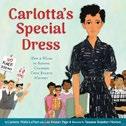
L aNier, one of the Little Rock Nine, shares the moving true story of how she helped integrate an all-white Arkansas school. As the summer of 1957 drew to a close, Carlotta eagerly anticipated attending Central High, a fancy school near her
home with well-equipped science labs ideal for preparing Carlotta for a medical career. With a $20 gift from her uncle, Carlotta and her mother found the perfect first-day-of-school outfit: an elegant black dress adorned with bluish-green numbers and letters. Despite Carlotta’s excitement about starting at Central, white parents’ objections to integration prevented the Black students from attending. When a judge ruled in favor of integration, Carlotta wore her new dress to school, praying that it would bring her good luck. Though surrounded by supportive white and Black ministers, the students encountered an angry mob, and the National Guard, called in by the governor, prevented them from entering the building. President Eisenhower intervened, sending soldiers to ensure that Black students could safely attend school. This colorfully illustrated, heartfelt account gives young readers an excellent introduction to the turbulent integration of public schools in the South. BrantleyNewton’s vibrant digital and collage illustrations effectively portray the flair and style of this middle-class Black family as well as the trauma of racism. Rich backmatter explains that Carlotta’s dress is now displayed at the Smithsonian’s National Museum of African American History and Culture in Washington, D.C., while also offering readers a deeper dive into this moment.
An intimate, well-crafted glimpse at the Civil Rights Movement. (author’s note, timeline, photographs) (Picture-book memoir. 8-11)
Lee, Jen Hayes | Illus. by Mokshini Harper/HarperCollins (40 pp.) | $19.99 September 2, 2025 | 9780063326750
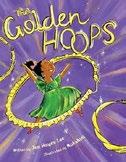
finally presents her with a pair in a regal purple velvet box, calling them “a magical rite of passage,” Janey feels transformed. Wearing them to school, she shines: She triumphs at the spelling bee, scores the winning soccer goal, and snags the last rainbow sprinkle cookie at lunch. But when one earring goes missing, Janey’s self-assurance falters, prompting a deeper reflection on the meaning of the hoops. Lee connects Janey’s experience to a global sisterhood of Black and brown women who wear hoops with pride; her writing captures the warmth and cadence of Black maternal love, with lines like “Of course, baby. It’s your time to shine.” Mokshini’s digital illustrations are whimsical yet sophisticated, conjuring a dreamy atmosphere that complements the tale’s emotional arc. The illustrations’ style also harkens back to classic picture books, with expressive characters and bold compositions. The book’s design, especially its deep purple cover and radiant final spreads, adds a regal touch. In the author’s note, Lee shares her own experiences with hoop earrings. Her claim that gifting hoops is a rite of passage for Black girls dating back to 2500 BCE would be stronger with supporting references. Still, this is a heartfelt celebration of identity and coming of age.
A shining tribute to self-expression, cultural pride, and the quiet power of adornment. (Picture book. 5-8)
Levinson, Suzy | Illus. by Dustin Harbin Tundra Books (40 pp.) | $18.99 September 30, 2025 | 9781774885239
truck, ice cream vending van, pickup, race car, and more). Scenes subsequently shift from city to country, but dinosaurs at the wheel are a constant. Clever, varied verses set a jaunty beat while offering colorful commentary on the action, while speech-bubble dialogue between tiny Triceratops and Pterosaur (who wears cowboy boots) provides further dino facts. Buckle up for wordplay like “CAR-NIVORE” and a minor running joke about the unfamiliarity of animals that haven’t made it on the scene yet. Fossil fuel is presented as a no-no, and the periodic menace of T. rex ends comically when he commits a parking violation. Finally, Levinson addresses the reptiles’ eventual disappearance by explaining that they traveled into space. Readers meet not only well-known dinos but also Trachodon, Aquilops (one of whom uses a wheelchair), Tuarangisaurus, and others, some using female pronouns. An unobtrusive pronunciation guide for each creature offers readers welcome help. The entertaining, Richard Scarry–inflected art is colorful and busy, with many small details repaying scrutiny—newspaper vending machines, volcanic explosions, and more—and driving youngsters to repeat reading. A delightful combo of fun and facts about reptiles on the road.
(Picture book/poetry. 3-7)
Long, Ethan | Holiday House (32 pp.)
$14.99 | January 13, 2026 | 9780823460328 Series: I Like To Read
Upon receiving her first pair of golden hoops, a young Black girl discovers confidence, culture, and a touch of magic.
Janey has long dreamed of owning a pair of golden hoops, symbols of beauty, power, and belonging. When her mother

Levinson doubledips, deftly combining vehicle obsession with dinosaur devotion. This Triassic population inhabits a world of modern infrastructure. On the opening spread, set against a backdrop that hints equally at Manhattan and Seattle, extinct reptiles fill the highway in an assortment of cars and trucks (fuel tanker, steamroller, dump
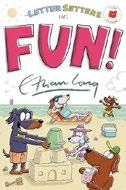
Short vowels steal the show in a phonetic extravaganza for new readers. What could be better than a day at the beach? A relaxing vacation is rife with ups and downs for this crew of fun-loving pooches, among them Pat the Gordon setter, Ren the English setter, Tip the red and white setter, and Irish
This review originally ran in the September 1, 2025, issue.
A Choose Your Own Adventure–style take on staying grounded amid turmoil.
In her foreword, Hayes explains that when life hands us lemons, we have two choices, represented by an anthropomorphic bubble and slug, a friendly-faced Goofus and Gallant–esque pair who each offer guidance as a variety of kids encounter challenging situations. Evelyn, for instance, is jealous of new student Melissa. Flipping the page to Bubble’s advice—Evelyn should try deep-breathing exercises when she’s
stressed—leads to a happy outcome: Evelyn planning a sleepover with Melissa. But listening to Slug’s panicked response—“Who is this new girl, and what is she doing in our life? She’s got to go!”— results in Evelyn feeling irritated, lashing out at her friends, and spending the weekend alone. Each of the subsequent stories proceeds similarly, with Slug advocating for self-sabotaging behaviors and Bubble suggesting calming techniques like listening to music and laughing with friends. The book presents positive


Calm: A Choose Your Own Attitude Book
and negative emotions as a sharp dichotomy; Hayes doesn’t acknowledge the importance of holding space for bad feelings such as embarrassment or disappointment. Still, overall, she offers a creative and thoughtful way to get kids unpacking their mental states. Flook’s sketchy cartoon illustrations helpfully
home in on key details in the various stories. The cast is diverse. The book concludes with a quirky emotion chart and an invitation to readers to think critically about the different situations.
A solid conversation starter for kids attempting to manage difficult emotions. (Picture book. 5-8)






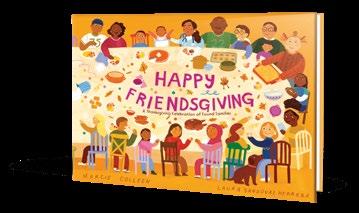

propulsive finale that finds strength in family and truth.
LOS MONSTRUOS
setters Bob and Bub. As the letter setters dig on the beach, poor Pat accidentally gets buried under a mountain of sand. After freeing Pat, the pups aim to build a sand castle, but the waves prove problematic. Fortunately, they’re aided in their quest by an almost painfully hip crocodile who’s passionate about both building sand castles and working out. Producing a narrative that uses just a word at a time is anything but easy, yet Long makes the writing seem effortless. The three-letter words in the text will reassure new and beginning readers, while the visual fun will entice them to enhance their literacy skills as they read without intimidation. Long’s signature cartoonish style also perfectly complements his light storytelling, providing context to the simple words on display. Yet it’s the humor of the piece that really lets it stand out—particularly that too-cool-for-school croc with the significant six-pack.
A surefire hit that will have kids telling these pups to “Go, dogs, go!” (Early reader. 4-7)
Ava and the Owl-Witch
López, Diana | Kokila (256 pp.) | $18.99
October 7, 2025 | 9798217110384
Series: Los Monstruos, 3

In this trilogy closer, Ava, the daughter of La Lechuza, confronts her mother’s past and the prejudice surrounding their monstrous legacy in the magical town of Tres Leches, Tejas.
After a couple of boys snap a photo of La Lechuza carrying away a drunk man, Ava’s mother, Minerva, becomes a fugitive from Sheriff Hayashi. Ava, who longs to fly but hasn’t inherited her mother’s powers, flees with her and begins unraveling long-held family secrets. With help from several familiar faces—including Mayor Reynaldo; Paco, her loyal squirrel companion and familiar; Felice, the daughter of La Llorona; Rooster, who’s the son of a devil; and newcomer Micaela, a podcaster who’s researching los monstruos—Ava investigates her family history and the mysterious rift between her mother and aunts. Guided by her surviving tía, Delia, Ava trains to learn how to transform into an owl and discovers that while monsters aren’t what they seem, neither are the people who fear them. The strong pacing brings readers along on an exploration of Mexican American folklore told through a fresh lens that highlights sisterhood, justice, and the complexities of legacy. Returning fans will enjoy visiting this familiar world, while newcomers will be able to easily follow Ava’s story without prior knowledge of the series. The swiftmoving plot manages to make space for emotional resonance, culminating in a moment of communal reckoning. A thoughtful yet propulsive finale that finds strength in family and truth. (Adventure. 8-12)

Martin Jr, Bill & John Archambault
Illus. by Julien Chung | Little Simon/ Simon & Schuster (40 pp.) | $9.99
December 2, 2025 | 9781665980876
Series: A Chicka Chicka Book

The letters of the alphabet celebrate love.
In the tradition of Martin and Archambault’s 1989 classic Chicka Chicka Boom Boom, the book features letters spelling out love-related words like hug and adore. The letters pile into a flowering tree and, with a “chicka chicka / BA-BOOM! BA-BOOM!” (like the pounding of a heart), they topple back out. The text is made up of rhyming couplets that don’t always flow smoothly, making for a potentially awkward read-aloud. Chung’s illustrations hammer home the love theme, thanks to heart-filled borders and the heavy use of pinks and reds. The tree itself is topped with spring-colored leaves, flowers, and hearts. Bees buzz across the pages, delivering letters or carrying symbols of love. The styling very much mirrors Lois Ehlert’s in the original book, serving mostly as a love-filled translation. The images are sweet enough, and the text is warm and loving, if a bit on the dull side, but it’s mostly a reworking of the source material that doesn’t breathe new life into it. Those seeking a fresh take may be disappointed, but caregivers or educators seeking options for Valentine’s Day will find it pleasant enough. A cute, if less than original, repackaging of a beloved ABC title for those who can’t get enough of all things love. (Picture book. 2-4)
McAnulty, Stacy | Illus. by Stevie Lewis Odd Dot (40 pp.) | $18.99 | February 3, 2026 9781250334473 | Series: Our Universe
For more by Diana López, visit Kirkus online.

The solar system’s hottest diva struts her stuff. The titular character’s claim that she’s the only
goddess among the planetary gods may leave partisans of “Gaea” (technically not an official name, but still) feeling a little miffed. That aside, Venus still has plenty to crow about—from having higher surface temperatures than Mercury, to sporting a day that’s longer than her year, to spinning so the sun comes up in the west. Joining McAnulty’s other solar system soliloquies with the same engaging mix of facts and attitude (“Earth has clouds. I don’t…just have clouds. I’m smothered in them!”), Venus shines up from the page. She sports a proud expression on her broad face, whether hovering with windswept golden locks over a seashell like her Botticellian counterpart or floating in space, waving to her earthly and celestial fans with stubby limbs. Closing with a review quiz and a roundup of basic statistics, this animated planetary self-portrait will give young readers more reason than ever to pay proper attention to the brightest of our non-stellar astronomical neighbors. An introduction to Venus that shows the planet at her most verbally and visually vivacious. (bibliography)
(Informational picture book. 6-8)
Meadows, Jodi | Holiday House (270 pp.)
$18.99 | October 21, 2025 | 9780823461226

It’s easy to be mean from behind a screen. Middle school isn’t easy, but Virginia is doing great. She loves volunteering at her local public library. The “really cute” Grayson Jennings also frequents the space—although his social stock fell precipitously when he quit football. With besties Mary Heather, Kat, and Jess, she runs Four Takes on Downtown Deer Hill, a popular community review account on the Scrollr app. That is, until the friends have a major fight, and Virginia ends up ostracized. Even worse, the other girls publish Virginia’s unkind private group chat comments about
classmates to Scrollr for the world to see, ensuring her social destruction. Desperate and alone, Virginia finds an anonymous friend in the form of a text-door neighbor (someone whose phone number is one digit away from her own), who helps her discover the person she wants to be. But no one ever said becoming a better person would be easy. Meadows makes room for honest exploration, inviting readers to witness self-discoveries (and better understand themselves), largely without moralizing. The book’s important messages about the power and pitfalls of social media are gentle but insistent, and the story includes relatable discourse around online bullying and harassment. The adult characters are supportive and savvy, and decisions—good and bad—are openly discussed. Accessible and timely, this book will leave readers hanging on every page. Characters are largely cued white.
A sweetly gratifying story that doesn’t shy away from moral complexities. (Fiction. 10-14)
Merabian, Sina | Simon & Schuster (40 pp.) | $19.99 | December 2, 2025 9781534496842
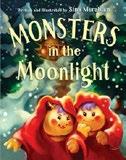
On the Persian holiday known as Yalda Night, two naughty divs try to live up to their monstrous reputations by ruining a family’s celebration.
In a shadowy cave with spiders and bones, Mother Div explains to young Choori and Shooli that “all divs are born to make the winter solstice as dark and cold as can be.” Though they’re monsters, the divs look cuddly, with plump bodies and fluffy violet hair. Even the scenery is full of round shapes and cozy light; as the night’s snow falls, it piles atop picture-perfect evergreens like soft-serve ice cream. After the pair venture out, a rosycheeked grandmother beckons them
into her luminous home, where they proceed to “STOMP, STEAL, and RIP APART”—to “DESTROY THEIR YALDA NIGHT!” To the divs’ great frustration, however, the family cheerfully agrees to eat apples when the divs demolish their watermelons, to recite poetry from memory when the divs rip up their poetry book, and to sit around the fire after the divs break their heater. Finally, Choori and Shooli prepare to head home in defeat, only for the grandmother to console them. They decide that the family’s celebration is “actually…kind of nice” and join the merriment. “Every year, some divs try to ruin Yalda Night’s celebrations, but there will always be many who will protect it,” Merabian concludes. Her gentle tale balances moments of mischief with good cheer, making for an enchanting holiday tale. Warmhearted. (information on Yalda Night) (Picture book. 3-6)
Naghdi, Yasmine | Illus. by Paula Franco Candlewick (224 pp.) | $16.99 September 9, 2025 | 9781536243802
Series: Ballet Besties, 1

The spotlight is on Indu, but stage fright—and a few missteps— threaten to steal the show. While Indu enjoys ballet class at the Shimmer and Shine studio with her ballet besties, the idea of performing onstage makes her queasy. She wonders if she really fits in, or if she might be better off sticking to something she’s really good at, like science. Indu feels even more left out when her class plans a field trip to see a professional production of Cinderella to inspire them for their own upcoming performance of the same ballet. Her friends are excited to go, but Indu’s mother is a nurse who works long hours, and they can’t afford the ticket.
Indu is so desperate to belong that she engages in some dishonest behavior to join the field trip. With support from her friends, Indu comes clean, then hatches a plan to make Shimmer and Shine a more accessible place for kids to learn how to dance, no matter their financial situation. Aspiring ballet dancers will find plenty to love in this positive tale, even though its moralistic messages err on the side of preachiness. Sporadic black-and-white line illustrations complement the story’s lighthearted tone. Indu has Indian heritage, and the rest of the ballet besties are a diverse group. A tender friendship story where honesty, courage, and a sense of belonging take center stage. (glossary of ballet terms, ballet basics, story of Cinderella, information on “the Fred Step,” cupcake recipe) (Fiction. 6-9)
Nargi, Lela | Illus. by Kristen Uroda Sleeping Bear Press (32 pp.)
$18.99 | July 1, 2025 | 9781534113251

A Detroit cafeteria worker acts on her belief that kids deserve delicious, nutritious food.
Determined to replace the beige fare that the 46,000 Detroit students in her charge usually found on their lunch trays with more nourishing food—and canny enough to know that she’d have to persuade them to eat it, too—Betti Wiggins started small. Goodbye, iceberg lettuce. Hello, romaine! Out with soggy white potato french fries, in with baked sweet potato fries! Soon a salad bar was stocked with fresh produce...and a lunchroom protest broke out when one principal tried to limit it to upper graders. Eighty school gardens later, plus expanded breakfast and dinner programs, Wiggins was ready for a bigger challenge. Hello, Houston! Not only are the students surrounding the
brown-skinned Wiggins in Uroda’s illustrations racially diverse, including one with vitiligo; their expressions also encompass a broad range of emotion, from listlessness to skepticism, dawning interest, and finally big smiles as floating images of fresh fruits and veggies give way to flashing stars and confetti. Nargi closes with a note on her still-active subject’s later achievements and a capsule history of U.S. school lunch programs that includes a provocative nod to those sponsored by the Black Panthers. Dishes up a decidedly well-earned tribute. (Informational picture book. 6-8)
Ollestad, Norman & Brendan Kiely Farrar, Straus and Giroux (272 pp.)
$18.99 | October 28, 2025 | 9780374392611
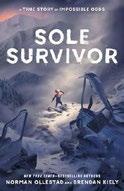
In 1979, 11-yearold Norman was the only survivor of a plane crash in Southern California: This is his true story. This book for middle-grade readers, coauthored with Kiely, covers much of the same material as Ollestad’s 2009 memoir for adults, Crazy for the Storm . Flying in a four-seater Cessna with his father, his father’s girlfriend, Sandra, and the pilot, Norman was excited to reach Big Bear to receive his ski-racing trophy. (As a vivid example of his busy childhood, they’d driven the 300 miles there yesterday for Norman to compete—and then driven back to Topanga Canyon in the evening for his hockey game.) But the plane tragically crashed on a mountain in a blizzard. Nothing is sugarcoated; readers encounter graphic descriptions of the pilot and Norman’s dad, who died, and Sandra, who suffered a gaping head wound. Eventually accepting that he had to figure things out on his own, Norman drew upon the extreme training his father had put his “Boy Wonder” through—training that had bullied Norman into facing difficult physical and mental challenges that he
feared and resented. During his trek to safety, Norman performed incredible mental and physical feats and encouraged the barely functioning Sandra— until she fell to her death. Norman’s conflicted feelings about the father he’d both idolized and resented are nuanced and satisfyingly resolved. Readers who enjoy nail-biting wilderness stories will be riveted. A tragic, gripping, and inspiring story. (Nonfiction. 10-14)
Petty, Dev | Illus. by Mike Boldt | Doubleday (40 pp.) | $18.99 | October 28, 2025

9780593518052 | Series: Elmore the Moose Elmore the Christmas moose returns for another holiday season. When Santa Claus falls sick a week before Christmas, Mrs. Claus sends him on vacation for some R&R. “I had an important decision to make: who to leave in charge while I was away,” says Santa. While the obvious choice seems Mrs. Claus, Santa decides to ask Elmore to step in for him and gives him an exceptionally long to-do list—just one of many instances of text contained in the artwork that invite readers’ laughter. Boldt’s illustrations feel busy, matching the wordiness of the writing; at times they seem as though they’d be better suited to animation, but there’s ample humor in several letters Elmore writes to Santa about his mishaps and struggles with grouchy reindeer and mischievous elves as they prepare for Christmas Eve. Santa tries to help by writing back from afar, but his medicine makes him sleepy, with a much-needed letter going unfinished, and Elmore is left to his own devices as chaos ensues in the cartoon-style illustrations. Santa rallies when he receives a particularly panicked missive and advises the moose to make this “Elmore’s Christmas.” With that encouragement, Elmore makes more work for everyone by doing away with
the naughty/nice list, but all’s well that ends well as he literally takes the reins on Christmas Eve and delivers presents before Santa’s return to the North Pole. Santa and Mrs. Claus are tan-skinned; the elves are diverse.
A bustling, jolly holiday read. (Picture book. 4-7)
Pinkney Barlow, Charnelle | Doubleday (32 pp.) | $18.99 | January 20, 2026 9780593571224
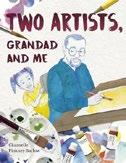
The author recalls time spent with her late grandfather, Caldecott Medalist Jerry Pinkney (19392021), in his art studio.
As a little girl, Pinkney Barlow relished her trips to her grandfather’s atelier: “Music shimmies up the stairs. The trill , cheep, chirp of birdsong drifts through the open window, mixing with the bop, tap, clap of Grandad’s jazz.” The watercolor paints that Grandad uses are on enticing display. Grandad shows young Charnelle how to create watercolor washes, which she initially finds hard to use, and he gives her a sketchbook. As the pair make art together, Grandad imparts a key bit of indelible wisdom: “There is no right way.” The child vows to “gather these memories and tuck them into my pocket,” and she has indeed unearthed them to create this charmer. The text reads like a prose poem that will likely speak to older picture-book readers and their elders, but audiences of all ages will appreciate Pinkney Barlow’s enchanting digitally tweaked mixedmedia art. Colored pencil illustrations tie together cut-paper and foundobject imagery, and all the careful layering sorely tempts the hand. An afterword includes two images that may be a revelation for readers: a photo of Pinkney Barlow as a 9-yearold posing as the Little Match Girl for
her grandfather and a resulting sketch that seeded the illustration that Jerry Pinkney used in his celebrated adaptation of the Hans Christian Andersen story.
An endearing tribute to a picture-book legend. (Picture-book memoir. 4-8)
Platt, Cynthia | Illus. by Josh Cleland
Clarion/HarperCollins
(32 pp.) | $12.99
September 23, 2025 | 9780063460331
Series: Holidays in Disguise

At Thanksgiving, creative children scheme to save their turkey friends.
“It’s Thanksgiving Day and if grown-ups have their way, there’ll be turkey in the oven—there’ll be turkey on a tray! So let’s put our heads together…to save our friends of beak and feather!” Black lettering is set against green grass in a colorful, full-bleed spread showing five large-eyed, generic but appealing children with varying skin tones. The rhymes and loose rhythms of the text continue as the children use their imaginations and all sorts of crafting materials to disguise the turkeys. The disguises range from “long-lost Auntie June” to potted flowers, an astronaut in a cardboard TV, and a unicorn. Humor abounds as each ridiculous disguise fools the grown-ups, despite Auntie June’s gobbling, the flowerpots’ decidedly unflowery odor, and the clearly visible beaks and feathers. A child pulls a wagon with the final turkey dressed like the local farmer and bearing the sign “All out of turkeys this year!” Will a vegetarian feast sate the Thanksgiving revelers? The well-matched text and art are lighthearted throughout, and the warmhearted ending does not disappoint. No didacticism here— just a reminder of why people gather together in the first place. Fun for vegetarians and omnivores alike. (Picture book. 4-8)
Poe, Edgar Allan | Illus. by Chloe Bristol Running Press Kids (32 pp.) | $18.99 September 23, 2025 | 9780762489619

A masterpiece in creepy rhymes / for Halloween or darker times. Sitting in a tenebrous, candlelit chamber mourning for a lost love whose specter periodically glides, disregarded, into view, a narrator bearing a mild resemblance to the author exchanges sentiments with a feathered visitor, dark and enigmatic. Probably still the best exemplar ever of what relentless assaults of dense, pounding rhyme can do, the old poem still works on sonic and metaphorical as well as literal levels to lower the spirits of any reader or listener, and to induce reactions ranging from mild unease to profound existential despair. Good stuff! Bristol’s atmospheric illustrations helpfully add visual weight to the gloom, though the solid-looking ghost of Lenore floating past sometimes makes the room look a bit crowded. Other versions with more macabre pictures from illustrators ranging from Gustave Doré to Gahan Wilson are available, but this one may be preferable for younger or more sensitive audiences. Accompanied by a few extra “nevermores,” anonymous notes at the end explain the author’s contributions to literature as well as the poem’s publication history and (superfluously) plotline.
Quoth the critic, “Worth a try!” (Picture book/poetry. 7-11)

Remenar, Kristen | Illus. by Matt Faulkner
Charlesbridge (32 pp.) | $17.99
September 2, 2025 | 9781623543716

An aim to please isn’t enough when preconceptions rule. Owl, a somewhat pompous old-guard avian gentleman given to phrases such as “egads” and “my good man,” holds an annual autumn banquet for his animal friends. (All are anthropomorphized, recognizable from two previous books, and, on a nonnaturalistic scale, almost all are the same size.) Famous didgeridoo player Platypus unexpectedly accepts a dinner invitation, putting fanboy Owl in a dither: What to serve? Reasoning that “Platypus is a bit like a reptile, but also a bit like a bird, and also a bit like a mammal,” Owl makes several assumptions about what the guest of honor would like, asking his friends for confirmation. Surely Platypus will enjoy beetles added to the cricket chutney (“for extra crunch”)? And certainly milk—something all mammals drink—should be on the menu? Owl’s friends gently disabuse him of his notions—and point out that they haven’t exactly been enjoying the food he’s been serving up. Bear proposes asking Platypus what he wants, but Owl prefers to dictate the menu; ultimately, a shortage of side dishes prompts a potluck and a sensible resolution. Rendered in an autumnal palette, the colorful illustrations are amusing and accomplished, the plot brisk enough, and the point obvious but worth making. Owl’s problems are self-created: perfectionism, an inability to accept help, and untested beliefs. A clever tale of a know-it-all who at last learns to listen. (Picture book. 4-8)
Nellie Zabel Willhite
Richman, Brittany | Illus. by Alisha Monnin Sleeping Bear Press (32 pp.) | $18.99
August 1, 2025 | 9781534113558
Series: Own Voices, Own Stories
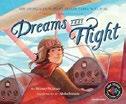
A brief introduction to the first deaf pilot in the U.S.
After Nellie Zabel Willhite contracted measles (which goes unnamed, though Richman describes Nellie’s high fever and spotted skin) at a young age, “sounds stopped.” Nellie’s supportive mother taught her sign language. In 1905, after her mother’s death, Nellie’s father sent her to a school for the deaf, where signing was considered detrimental. Encouraged by teachers who acted as foster parents, Nellie learned to speak and read lips. Notably, both speech and signing made Nellie feel that “maybe she could” do anything. In 1927, awestruck by a biplane’s graceful flight, Nellie started flying lessons. But at the time, airplane cockpits were designed with one seat in front of the other; “urgent commands were shouted over the buzz of the plane.” How would Nellie know what to do? Fortunately, when she took to the cockpit, “her other senses took flight”— she felt vibrations and monitored the instruments “like a hawk.” Buoyed by memories of her parents’ encouragement, Nellie completed her solo flight and received her license—becoming the first deaf pilot in the United States and the first female pilot in South Dakota. Now, though she couldn’t hear a robin singing, “she knew better than most what it was like to fly like one.” In simple text, Richman underscores Willhite’s determination and the importance of
A child keenly feels the recent death of a sibling as Yuletide approaches.
supportive role models; Monnin’s bright, sweeping illustrations capture the thrill of open sky. Backmatter includes further biographical details. Most figures, including Nellie, are light-skinned. Uplifting. (author’s note, sources) (Picture-book biography. 4-7)
Rowland, Joanna | Illus. by Thea Baker Beaming Books (32 pp.) | $18.99
October 14, 2025 | 9781506496641
Series: Memory Box

A child keenly feels the recent death of a sibling as Yuletide approaches. It’s the first holiday season since the tragedy. “How can I celebrate Christmas without you?” the young narrator wonders. Through the creation of a memory tree, the young protagonist finds a solution that brings comfort to all. The family heads to the tree farm and picks out the perfect tree. Back at home, they search for “trinkets and treasures you’ve collected,” which they use to construct handmade ornaments that reflect the deceased child’s life and interests. As they trim the tree, they speak about their memories. Soon, extended family and friends arrive, adding ornaments of their own, all of which will help to keep the protagonist’s sibling’s memory alive. Pairing well with the earnest text, written in second person and addressed to the deceased sibling, Baker’s flattened, naïve illustrations depict a loving suburban home. Parents or close relatives will want to share this simple, purposeful tale with young people who have undergone a similar situation. The protagonist is brownskinned and dark-haired; other members of the community are diverse. The backmatter includes a note from the real-life family whose memory tree inspired Rowland to pen this story. An idea that may offer solace to youngsters navigating the holiday season in the wake of loss. (Picture book. 4-8)
MEET THE SMUSHKINS
Rueda, Claudia | Candlewick (40 pp.)
$17.99 | December 2, 2025
9781536236583 | Series: The Smushkins

An assortment of charming critters search for a house with all the right features. The title says it all. Meet 10 animals and animal-like creatures known as the Smushkins, who are in need of a home. “So, what makes a good house for the Smushkins?” The residence must allow in lots of light, with big windows and ample walls for drawing upon. The outside of this ideal abode is just as important as its insides—the backyard must boast an apple tree. And the home must be near a scooter path, an ice cream vendor, a library full of books, and more. Relying on just a handful of words, Rueda deftly taps into the fun of coming up with one’s dream home with all one’s best friends. The Smushkins themselves (all identified by name at the start of the book, among them Ook, Iona, and Moe) are brightly colored, with various distinguishing characteristics. Puff, for example, resembles a mashup of a bunny and a pig with perpetually half-lidded eyes, while Tippi always wears a red hat and a striped tunic with a green worm in the front pocket. Everything ends with the Smushkins snuggled in a big bed together. After all, a good house for Smushkins “is a house full of Smushkins!”
Wishful thinking with friends galore and delicious ice cream? A win! Aspirational and friendly. (Picture book. 1-5)
Schmitt, Kelly Rice | Illus. by Jam Dong
Millbrook/Lerner (40 pp.) | $19.99
October 7, 2025 | 9798765619827
Series: On the Move

Travel along with a big rig making an important delivery. A giant 18-wheeler semi backs up to the loading dock. What freight will it carry? Toys! Two previous books by this team— I Ship (2023) and I Fuel (2024)—had a global scope, while this “coast to coast” truck is “westbound” (but from where to where? There’s no map). Lively verbs such as rumble, roll , tug , and lug , along with many surprise internal rhymes, propel the text forward. Through snow, wind, and treacherous black ice, Truck narrates and navigates. “Driver” is brown-skinned with a high bun, accompanied by a cute, vocal dog. At trip’s end, Driver is reunited with a loving family. Like the earlier titles, this one works on two levels: It’s a fun picture book with geometric shapes in bright primary color-blocks, while in-depth backmatter serves as a rich source of STEM information, with appreciation for the important work that truckers do. Also included are a “trucker talk” glossary and a detailed diagram of truck components. Dong’s illustrations are reminiscent of those in Donald Crews’ vehicle books and are just as appealing. A seek-and-find challenge finishes the book.
An enticing tale of hitting the road that will hit the spot for transportation lovers. (Informational picture book. 5-9)
Sometimes You Find a Dragon: Find Your Dragon. Find Your Creativity.
Schwarz, Viviane | Candlewick (32 pp.) | $18.99 | September 16, 2025
9781536245110

A conceptual picture book that uses dragons as metaphors for creativity. Schwarz leads readers on an adventure of discovery, guiding them to find their own artistic voices through everyday objects and activities. She moves through various scenarios where children might discover dragons— falling from trees after storms (to the unobservant, they look like twigs), hiding in paintbrushes, emerging from musical instruments, or taking flight through dance. The mixedmedia illustrations combine loose line drawings of children with vibrant watercolor washes and collage elements, producing compositions that feel deliberately unfinished—an apt style for a title that emphasizes process over results. Schwarz’s palette shifts from warm reds and oranges that pulse with energy to cool blues that suggest calm focus, soon bursting into rainbow spectrums during moments of full creative expression. Bold circular shapes and flowing gestural marks dominate the visual landscape, reinforcing themes of movement and energy. Pairing large, bold typography with dispersed visual elements, Schwarz employs generous white space to let individual creative moments breathe. Fans of the work of Hervé Tullet and Peter H. Reynolds will likely appreciate this story that captures a youngster’s spontaneous spirit. Educators and parents seeking to spark inspiration in little ones will especially welcome this tale. Characters have skin the white of the page.
A creative catalyst sure to spur young artists. (Informational picture book. 3-7)
Scrimger, Richard | Scholastic (192 pp.) $18.99 | December 2, 2025 | 9781546158332

A young Canadian boy’s mind moves at lightning speed, and so does this heartfelt, hilarious tale. Everyone daydreams, but as Gus’ older sister Ruby says, “Most of us have a big sign over the doorway of our mind: THIS WAY OUT.” Thirteen-yearold Gus has ADHD, and his maze of a brain definitely doesn’t have clearly marked exits. One morning while reading aloud the daily announcements on the school’s loudspeaker, he goes off script in the name of comedy. The secretary, Miss Funn, doesn’t find Gus’ improvisations amusing and instead serves him a two- day suspension. Gus’ adventure begins the moment he walks out of school and gets a call from Ruby, who requests his help moving out of her college dormitory on Vancouver Island. She gives him clear instructions on how to take the ferry and a bus to her school, but of course no journey is quite so linear for Gus. He must deal with his forgetfulness, his wandering thoughts, and even some incredibly realistic hallucinations, all of which lead to a thoughtful conversation with his doctors about the pros and cons of medication. Gus’ breakneck misadventure is both tender and entertaining—an ode to neurodiversity that speaks to the importance of forging one’s own path and serves as a much-needed reminder that all brains are awesome. Gus is white with Macedonian heritage.
A funny, whirlwind romp that embraces the beautiful buzz of a busy brain. (Fiction. 9-11)

Sewankambo, Yvonne | Illus. by Aurore McLeod | Candlewick (32 pp.) | $18.99 September 23, 2025 | 9781536244991

T he young narrator of this tale may be the smallest in the family, but this little one has a big understanding of love.
As a large, supportive, Blackpresenting family prepares for an outdoor cookout, the protagonist fondly explains how each member expresses their love: Big sis Nalu braids the youngster’s hair, older brother Tendo races the child home from school, Kira the dog greets the youngster with “a wagging tail and a spin,” Uncle Alex brings his beloved parrot Lester over when he visits, Auntie Linda (who uses a wheelchair) is quick to offer a hug when the narrator is sad, and the child’s jajja (grandmother) invites the little one to help cook. The text is spare but poignant; McLeod’s warm, detailed digital illustrations fill out full-page spreads. The affection is palpable in these charming scenes featuring characters with cornrowed braids, brightly colored glasses, and variously expressive faces. Whether it’s offers of food or a firm word when our main character misbehaves, the sense that love can be communicated in a variety of ways—and, indeed, without being said aloud—is conveyed with compassion and importance. References in the text hint that the characters are of Ugandan heritage.
An affectionate tale in which love is deeply and truly felt. (Picture book. 4-8)
Shiotani, Mamiko | Trans. by Polly Lawson Floris (36 pp.) | $18.99 | August 5, 2025
9781782509264
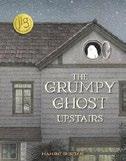
In this Japanese import, a ghost makes a friend— eventually. At first, the little ghost is content to live alone in an attic, enjoying his own company. When he decides to venture outside, a tanskinned, dark-haired girl who bears some resemblance to Boo from the Pixar film Monsters, Inc. spies him; she ends up seeking him out in the attic, much to his dismay. Alarmed at the intrusion, he tries, and fails, to scare her in scenes reminiscent of Mo Willems’ Leonardo the Terrible Monster (2005). When he invades the child’s bedroom, instead of being alarmed, she is delighted. Her warm welcome (“I hoped you would come and visit me”) disarms the little ghost, who finds “that he [doesn’t] feel so grumpy” anymore. Shiotani’s illustrations are the real standouts here. The little ghost’s depiction is particularly delightful— rather like an updated Casper, but with tiny legs and arms. This unusual portrayal, appendages and all, is just one element of the subtle visual humor that readers will enjoy as they pore over the setting and take in the characters’ interactions. The muted, dark palette allows the whiteness of the little ghost to pop and results in a cozy, rather than frightening, tone.
Nothing to boo here, and much to enjoy. (Picture book. 3-6)
A funny, whirlwind romp that embraces the beautiful buzz of a busy brain.
Siegel, Rebecca | Peachtree
(176 pp.) | $19.99 | November 4, 2025
9781682637586

A brisk salute to a U.S. Army unit created and trained to keep Germany guessing about Allied troop movements and placement.
Armed with rubber tanks and trucks, huge speakers blasting recorded sounds of soldiers on the move, and other tools of deception, the self-dubbed “Ghost Army”— officially designated the 23rd Headquarters Special Troops— arrived in Great Britain just before D-Day and went on to sow confusion in the enemy’s ranks until the war’s end. Readers interested in the finer details of the Ghost Army’s methods, or how its gear was designed and constructed, will have to dig into Siegel’s substantial bibliography, but her running account of its multiple successes (and failures), well stocked with period photos and often based on oral histories and family interviews, successfully delivers the high points. While frankly and properly acknowledging the horrors Allied troops found in the concentration camps as they swept into Germany and also that the U.S. Army was both segregated and had its own share of antisemites, her narrative shows an overarching sense of pleasure in recounting the results of creative minds at work. The unit’s mission, she writes, was “breathtakingly strange,” and its “most potent weapons were smoke, mirrors, and the German imagination.” Lively and thoroughly researched. (maps, glossary, source notes, bibliography, photo credits, index) (Nonfiction. 10-13)
WOMEN ON A MISSION
Siqueira, Ana | Illus. by Olivia de Castro
Charlesbridge (32 pp.) | $17.99
October 28, 2025 | 9781623545796

Sibling relationships can be tough— even sticky. Claudia loves her little sister, Monica. After all, it’s fun to always have someone to play with. But sometimes Monica sticks to her like glue, trailing after Claudia and her friends and inserting herself into their games. When Claudia is invited to a fútbol tournament, Monica begs to come along. Claudia knows her sister will be crushed if she’s not included, but she longs for an activity that’s just her own. Claudia considers her options—pleading, bribing, even warning her sister about a scary monster. Nothing works. At last, Claudia turns to the hardest strategy of all: honesty. She explains that she simply wants to play with her friends on her own. To her surprise, Monica understands and agrees not to go. The sisters seal their new understanding by chewing some bubble gum, leading to a hilarious and literally sticky situation. Readers who have weathered both loving and exasperating sibling relationships will see themselves in this heartfelt story. The push and pull between the sisters feels authentic even as Siqueira maintains a playful, humorous tone, matched by de Castro’s exaggerated cartoon artwork. Spanish vocabulary is seamlessly woven throughout, and Claudia’s family members are brown-skinned and cued Latine.
A funny and tender celebration of sisterhood, honesty, and finding space while staying close. (Picture book. 5-9)
Slade, Suzanne | Illus. by Molly Magnell Charlesbridge (48 pp.) | $18.99 October 28, 2025 | 9781623543952
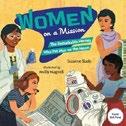
Salutes to 12 women who made signi ficant contributions to the Apollo program. Black “human computer”
Katherine Johnson is likely to be the only name on this roster familiar even to well-read young students of the early space program. But after interviewing surviving subjects or their families and delving into oral histories and published accounts, Slade has provided readers with 11 more women who were active members of Team Apollo, including thermochemist and rocket fuel expert Reatha Clark King; aerospace engineer Mary Golda Ross, co-author of NASA’s planetary flight handbook and member of the Cherokee Nation; and Yvonne Young Clark, who earned a degree from Howard University in mechanical engineering and went on to design the “rock box” astronauts used to collect lunar samples. Along with capsule accounts of their lives and specific achievements, the entries include a variety of photos, peppy direct quotes, and Magnell’s painted views of the subjects at work in labs, offices, and control rooms. The author concludes with a shoutout to Sally Ride and the rest of the first class of women astronauts. As she notes, these
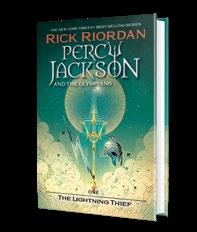
Rick Riordan
The young hero first appeared in his 2005 novel, The Lightning Thief. Disney Publishing celebrated the 20th birthday of Percy Jackson at an event in New York in August, the press announced in a news release.
Percy was first introduced to readers in 2005 with The Lightning Thief, which tells the story of a 12-year-old boy who discovers he is a demigod. Four more novels in the Percy Jackson and the Olympians series followed, and Riordan brought Percy back for two additional books, The Chalice of the Gods and Wrath of the Triple Goddess
A Disney+ series adaptation of the novels premiered in 2023 to positive reviews. The second season is
This review originally ran in the August 8, 2025, issue.

In author-illustrator
Sheckels’ picture book, a maid at a grand hotel dreams of watching her favorite band perform.
In a world of genteel, anthropomorphized animals, Flora, a ferret,
Sheckels, Astrid Waxwing Books | 40 pp. $18.98 | October 7, 2025 9781956393187
works as a scullery maid in a ritzy, three-story hotel. Scouring and scrubbing in her blue dress and apron, Flora hums along to the music in her heart, hoping that one day she’ll save enough pennies to attend a
scheduled for release in December.
Riordan appeared in conver sation at New York's Hudson Theatre with podcaster Lisa Cabello, who asked Riordan how Percy had originated.
“You really have to go back to 2002, when my oldest son, Haley, was struggling in school, because he had just been diagnosed with ADHD and dyslexia,” Riordan said. “To get him feeling better about where he was as a person

and as a student, I made up a Greek myth.…I told him, ‘You know, in my world, if you have ADHD and dyslexia, that might be a sign that you’re really special indeed. You might be a demigod.’ And he said, ‘That explains it!’”—M.S.

Rick Riordan
concert. When her favorite band, the Jazzers, is booked to play at the hotel, Flora desperately wants to watch them perform. The hotel manager, a snobbish fox, turns her away—but then the Jazzers themselves hear her humming outside their room. They’re in need of a vocalist, so they invite her to be their guest soloist, and then to join them permanently. Sheckels tells Flora’s story in straightforward, unrhymed prose, allowing the characters to take center stage without distraction; Flora is easily identifiable as a Cinderella
SPONSORED CONTENT
archetype. The lush, hand-painted illustrations are whimsical in the tradition of Beatrix Potter, Inga Moore, and Jill Barklem, capture an Edwardian opulence as well as the grittier circumstances of those whose labors maintained such opulence. The Jazzers, consisting of waistcoated racoon (double bass), skunk (drums), rabbit (piano), and possum (saxophone), evoke a time when free-spirited bohemianism aimed to challenge class barriers.
A sumptuously illustrated Jazz Age Cinderella story.


EDITORS’ PICKS:
Soul Machine by Jordana Globerman (Annick Press)
Chickenpox by Remy Lai (Henry Holt)
Muybridge by Guy Delisle, trans. by Helge Dascher & Rob Aspinall (Drawn & Quarterly)
THANKS TO OUR SPONSORS:
A Cat’s Historical Yarn by Lorraine Abrams
Dancing With Panthers by Patrick C. Notchtree
A Song for Olaf by Jennifer Boulanger
From Manila to Wall Street by Butch Meily
The Color of Mourning by Kim Dempster
Fully Booked is produced by Cabel Adkins Audio and Megan Labrise.
Chanté Timothy talks art and science on our Graphic Literature episode. BY MEGAN LABRISE
EPISODE 432: CHANTÉ TIMOTHY
On this special episode of Fully Booked , author/illustrator Chanté Timothy joins us to discuss her new middle-grade graphic novel, Supa Nova (Nosy Crow, June 3), in celebration of the Graphic Literature Issue of Kirkus Reviews.
“Ecological concerns prompt a young Black inventor to create a plastic-eating creature,” Kirkus writes in a review, calling Supa Nova “just the ticket for unstoppable young mixers and makers with big dreams.”
Timothy is a freelance illustrator based in London. She has illustrated 11 books, including A Black Woman Did That by Malaika Adero and Hey You! by Dapo Adeola. Supa Nova is her first book as both illustrator and author, and the start of a planned series.
Here’s a bit more from our review: “This STEM-centric romp introduces Nova, a science-loving child with a big personality, a pesky preteen big sister, and a gigantic underground lab. Having learned that scientists are working on mushrooms and mealworms that will consume the multiple islands of waste plastic floating in the ocean, Nova decides to help out. Unfortunately, Chomp, the little being she creates by zapping a mix of random ingredients, including her sister’s used gum (“IT’S ALIVE!”), doesn’t stop with eating the odd toothbrush and other small items—and Chomp grows bigger the more it consumes....Timothy brings the tale to a suitably thrilling climax that involves sisterly bonding, creative problem-solving, and wildly entertaining antics. Science for the win!”
In this episode, Timothy tells listeners all about Nova, an 8-year-old scientific genius who can create anything she imagines in her underground laboratory. We talk about Nova’s first big project— inventing a solution to plastic pollution



Supa Nova Timothy, Chanté Nosy Crow | 160 pp. | $9.99 June 3, 2025 | 9798887771335
in the world’s oceans—and the unintended consequences of her invention. She and I discuss illustrating for a living, the advantages of digital illustration, and why she chose to include character- drawing lessons at the end of the book. We touch on the real-life science behind the story, the AI system that assists Nova in her experiments, the next book in the Supa Nova series, and much more.
Then editors Laura Simeon, Mahnaz Dar, and John McMurtrie share their top picks in books for the week.
Editor at large Megan Labrise hosts the Fully Booked podcast.

To listen to the episode, visit Kirkus online.
lesser-known figures, too, “are heroes whose stories need to be told!” Totally justified, if tardy, tributes to women who also had the “right stuff” to take us to the moon. (author’s and illustrator’s notes, source notes, further reading) (Informational picture book. 7-10)
Smith, Heather | Illus. by Catherine Petit
Orca (32 pp.) | $21.95 | September 16, 2025
9781459840157
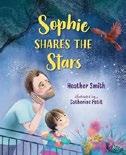
A glimpse into the life of a child whose parent grapples with a chronic illness. For the past five years, 8-year-old Sophie has lived with “My Michael,” a loving single guardian. Recently, My Michael has been feeling ill, but people outside their family don’t understand, pointing out that “he doesn’t look sick.” Sophie tries to help out—bringing My Michael ginger ale and saltines and sharing some of the stars that adorn the child’s bedroom—and My Michael’s mother, Julia, arrives to clean and make dinner. Drawing on her own experiences with long Covid, Smith offers a warm, loving vision of a nontraditional family with an authentic, empathetic voice. The narrative is light on plot, mostly consisting of one- or two-page anecdotes about Sophie and My Michael’s life, with quite a few seemingly extraneous details and dropped threads, such as My Michael’s pregnant best friend Kim and My Michael’s talent for singing. The lack of a clear narrative thread may leave some readers feeling unsatisfied, but others will appreciate the slice-of-life feel. The tale is at its best when exploring seemingly inconsequential yet poignant moments in the characters’ lives, like when Sophie, with great forethought, turns the “88” on their apartment door into two snowmen. Adult readers may wish for some acknowledgment of the toll that caretaking can have on a child—even if Julia does step in. The illustrations are pleasant and gentle. Michael, Sophie,
themes of love, betrayal, and the environment.
ASTERWOOD
Kim, and Julia are pale-skinned, while incidental characters are diverse. Compassionate and cozy, if a bit unfocused. (author’s note) (Picture book. 4-8)
Snow, Jess X. | Make Me a World (32 pp.) | $18.99 | December 23, 2025 9780593428511
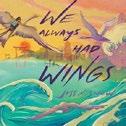
An ode to those who traverse boundaries, told by a mother to her daughter as they travel to see relatives for Lunar New Year.
Filmmaker and poet Snow uses birds as a metaphor for immigration in this story of a family—who have apparently journeyed to a new country—returning to China for a visit. Nervous to fly, the child wants to go home, but Mama gestures to the cranes flying alongside the plane (“They are your aunties”) and explains that “our family expands across borders. We belong in the sky.” She adds, “Long ago, when we were birds, we soared across the seas.” Snow’s illustrations are as grand as the book’s language: “The skies were our highways; the stars were our street signs.” Migrating birds holding the shape of people within their bodies fly amid a deep blue cosmos of stars. Mama notes that when the birds became people, flying down to Earth with the stars within them, those unfamiliar with the skies “built steel walls” that patrolled and surveilled, “splitting families in two.” Little Snow and Mama descend on the back of a giant bird and then have dinner with Grandma and her family. The juxtaposition of magical metaphor and the
psychedelic colors of everyday life at Grandma’s house feel surreal but perfectly convey the feeling of mystery and wonder at this world in which souls can soar. Young readers will understand Snow’s message viscerally, while adults will appreciate the political implications. A relatable vision of immigration that takes flight. (author’s note, note from Make Me a World founder Christopher Myers) (Picture book. 4-8)
Stelson, Caren | Illus. by Amanda Yoshida Carolrhoda (32 pp.) | $18.99 October 7, 2025 | 9798765611531

An American veteran returns an artifact of war to its Japanese owners. With the deployment of atomic bombs on Hiroshima and Nagasaki, World War II came to a dramatic, definite end. After his tour of duty in the Pacific, Captain Orval Amdahl arrived in Nagasaki with occupying forces and saw firsthand the destruction caused by those bombs. There, his superiors rewarded him with the spoils of war—a sword from a stockpile of surrendered Japanese weapons. He headed home to Minnesota, sword in hand, a tag identifying its owner attached. Over half a century later, a World War II researcher helped him find the sword owner’s family, to whom Amdahl returned it in a public ceremony. With simple, realistic illustrations, this picture book tells
Amdahl’s story soberly and with utmost respect. The bombs devastated Hiroshima and Nagasaki, while memories of war lingered with veterans their entire lives, and Stelson adeptly demonstrates how the return of a symbolic object cultivated a real feeling of reconciliation between the two sides. The story works best in conversation with Stelson’s transcendent A Bowl Full of Peace (2020), which shows how the consequences of war haunt its victors as well as its victims and how mutual understanding may foster meaningful peace. A cleareyed, compelling recollection of one soldier’s story. (author’s note, bibliography, photos) (Informational picture book. 7-10)
Sterer, Gideon | Illus. by Emily Hughes Clarion/HarperCollins (48 pp.) | $19.99 September 23, 2025 | 9780063375222
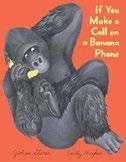
Wish fulfillment comes via fruitbased communications and a whole lot of imagination. With a tone and cadence similar to that of If You Give a Mouse a Cookie (1985), this tale informs young readers of what might happen if they were to go and make a call on a “banana phone.” Clearly, if you made a call on a banana, you’d get a gorilla on the other end. The creature might have a lot of questions about you, like why you’re calling or what you look like. (“They might want to know if you have stripes or spots, horns or a tail.”)
Family members may doubt that you’re really speaking to a gorilla, but soon enough, other animals will wish to talk to you, too. And if the gorilla and friends come to visit, you won’t be surprised. After all, if you make a call on a banana phone, “You might just make a friend.” Sterer’s text may lie almost entirely in suppositions, but the results are magical. Like a series of
Henri Rousseau paintings brought to life, Hughes’ artwork boasts a strong mix of fantasy and normality. The illustrations bring a warmth and understanding to not only the gorilla-child interactions but also to the human family unit. Human characters are pale-skinned and dark-haired.
Expect more fruit to find its way to young ears, thanks to this gentle cross-species tale of friendship. (Picture book. 3-6)
Stolos, Jacquelyn | Delacorte (272 pp.)
$17.99 | December 30, 2025
9780593814840

Can a social misfit help rescue a magical forest that’s under threat?
Ten-year-old Madelyn Delios prefers the woods behind her single dad’s farmhouse to school. She explores there on her own—even though she’s not supposed to leave the backyard by herself—and befriends blond, violeteyed Calle, who, oddly, recognizes Madelyn’s name. Later, seeking Calle down a trail her father has expressly forbidden her to take, Madelyn discovers Asterwood, an endangered, magical forest. The Tree Eaters are killing the rare Violet Aspens and harvesting their magic. A group of wilderness-dwelling children with violet eyes and diverse skin tones are trying to heal the trees and evade forest-dwelling cannibals. Madelyn, who previously knew nothing about her mother, learns shocking information about her parents—and her own potential powers. Stolos’ young readers’ debut is an environmentalist cautionary tale that features creative worldbuilding, evocative descriptions, and memorable characters. Details about the cannibals—a crown made of human bones, their roasting of human meat on a spit (“charred and glistening, a fatty cut, like pork but not quite”)—add touches of horror. Most compellingly,
the story explores conflicting emotions: Madelyn and the Asterwood children yearn for their parents, despite some of the adults’ appalling choices. Less compelling is Madelyn’s confusing chosen one status and the unanswered questions about the logistics of Homesprawl, the greedy Tree Eaters’ city. Madelyn’s family is cued white, and Calle uses they/them pronouns. A dark and creative fantasy that explores themes of love, betrayal, and the environment. (Fantasy. 8-12)
Sutherland, Tui T. | Adapt. by Barry Deutsch & Rachel Swirsky | Illus. by Jake Parker Colors by Maarta Laiho | Graphix/ Scholastic (256 pp.) | $14.99 paper November 4, 2025 | 9781339001296 Series: Wings of Fire Graphix
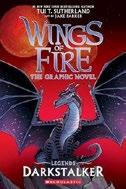
An origin tale for some legendary dragons from the Wings of Fire series. The IceWing dragon Prince Arctic opts to partner with a NightWing named Foeslayer instead of his mother’s preferred choice, setting a turbulent timeline in motion. Their child, Darkstalker, is born with the gift of prophecy and makes designs for power as early as the day he hatches. He grows up and becomes smitten by Clearsight, a NightWing who navigates multiple clashing visions of the future, including blocking Darkstalker’s villainous potential. Meanwhile, Prince Fathom of the SeaWings trains in the magical arts under his grandfather before an assassination upends the political order. A fair amount of blood is spilled in this tale of clashing kingdoms. The story has softer moments, too, as these dragons share love, trust, and friendship. Darkstalker and Fathom prove to be excellent foils for each other’s reckoning with their use of magic powers. Readers encounter a lot of information to absorb about the cast, who are rendered with the
sort of texture and layered personalities they’ll have come to expect from this series. Parker’s illustrations highlight each dragon’s distinguishing details, down to adornment and inherited features, and Laiho’s bright, jeweltoned color palette adds to the cinematic feeling of the art. A brooding, passionate, violent examination of willpower and control with strong appeal for series fans. (map) (Graphic fantasy. 9-13)
Sy, Stephanie Ellen | Illus. by Julien Chung Owlkids Books (32 pp.) | $19.95
September 16, 2025 | 9781771475464
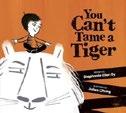
What makes a tiger a tiger?
The nameless young narrator has a pet tiger named Imran. Imran can speak, and he does have stripes on his pure-white fur, but they’re hard to see. This seeming omission makes the protagonist and other children question whether Imran is actually a tiger at all—though the big cat insists that he is. Throughout, Imran repeats the phrase, “You can’t tame a tiger,” rejecting the narrator’s repeated efforts to make him conform to preconceived notions of tigerhood. Chung relies on a limited palette, using orange as a highlight against blue-gray backgrounds, with painterly black brush strokes and flourishes of green and yellow. Painting black stripes on Imran’s fur makes him look like a zebra; festooning him with polka dots just makes people think he’s a cheetah. The youngster tries painting Imran orange, but he jumps into a pool of water and washes away the paint, all the while insisting on his true tiger nature. Clearly, the children cannot make this pure-white tiger change his (figurative) stripes. Ultimately, a loud “ROAR!” convinces the narrator and the other children of Imran’s true tiger nature, white fur and all. Readers may find deeper meaning in this story about self-definition and accepting others for who they say they are, though these
messages are subtly conveyed; the true lures are the bantering dialogue between the child and Imran and Chung’s energetic artwork. Human characters have skin the color of the page; hairstyles imply diversity. Catch this tiger tale at storytime. (Picture book. 3-6)
Tash, Sarvenaz | Illus. by Ericka Lugo
Knopf (240 pp.) | $17.99 | November 11, 2025
9780593809822

Two New York City friends have a new mystery to solve in their venerable apartment building in this sequel to 2024’s The Queen of Ocean Parkway Roya’s grief over the loss of her beloved Baba is slightly abated by keeping busy solving mysteries with her friend Amin and recording their podcast. Their neighbor Thea Lim-Lambert has discovered her great-grandfather Declan’s fantastical secret room hidden behind a closet containing intricately carved wooden doors and drawers, her grandfather Errol’s boyhood journal, and a note addressed to a “Lambert of the Future,” which provides a clue for a scavenger hunt in the building that leads to a valuable treasure. After Thea asks the two sleuths to help her solve this complicated mystery, the friends use their considerable skills to decipher Errol’s baffling clues, dealing with setbacks and triumphs and supporting each other through side adventures along the way. Thea sees herself as inadequate and unseen in her talented, artistic family and has difficulty accepting that Roya and Amin could be her real friends. In a nice twist, Errol, who has Alzheimer’s, has some heart-tugging lucid moments that help provide further information. The mystery is compelling, with lots of surprises and a very satisfying conclusion. Readers will love visiting
Brooklyn with these exceedingly clever, kind, and compassionate characters. Thea is cued Korean and white, Amin presents Indian American, and the previous book established Roya as Iranian American. Final art not seen.
An inventive puzzle filled with tenderness and warmth. (Mystery. 9-13)
Tatulli, Mark | Caitlyn Dlouhy/Atheneum (256 pp.) | $14.99 | November 4, 2025 9781665914901 | Series: The eXpets, 2

Stanky Dog, Laser-Eye Kitty, and fellow costumed pet superheroes go another round with their stinky archnemesis. Uh-oh—the fiendishly clever Skunk, who’s still out for revenge following the events of the 2024 series opener, is claiming to have kidnapped Stanky Dog’s human, Lily. On top of that, a giant black kitten has arrived from the moon bearing the Kittykahkah Necklace, a mystically powerful device that must not fall into the wrong paws because it’s capable of controlling the minds of all the world’s pets! It’s high time to call on “America’s favorite four-legged, fur baby, fiend-fighting force,” who have the questionable rallying cry of “EXPETS! EXPLODE TO ACTION!” (As one of them comments, “Seriously, my dudes, we gotta work on our catchphrase.”) Frenetic action is what’s on offer, along with loud colors and over-the-top dialogue that sometimes pops out of the floating cartoon panels. On the way to a warm, fuzzy close, the characters indulge in daffy exploits ranging from a side trip to Maine to steal the planet’s largest catnip toy to an escape from a rubber prison that’s tough enough to resist even the doughty canine’s acrid “super-shtink breath.” One significant human character, General Flagstaff
BAD CHEERLEADER
(“commander of all armed forces who protect the Earth”), presents white, and the other two, Lily and Professor Foozypinz (not “Fuzzypants”), are brown-skinned.
A raucously entertaining ruckus with a bit of world-saving thrown in. (Graphic science fiction. 7-10)
Thayer, Alex | Aladdin (288 pp.) | $18.99 November 11, 2025 | 9781665955270

Twelve-year-old Margaret, who’s nicknamed “Bag,” has a secret: She’s dyslexic. When Bag discovers that her sister, Minerva, is also hiding something, Bag is determined to figure out what it is. To do that, she must do the impossible— join the cheerleading squad with Minerva. What starts out as helping with equipment quickly turns into attaining a coveted spot at the top of the squad’s pyramid. The author deftly captures the discomfort of being viewed as different in middle school. Bag’s dyslexia doesn’t stop her from enjoying books and reading, but she hides her diagnosis—and her fears of being seen as unintelligent or not good enough— behind fake glasses that she believes make her “look smart.” The sibling dynamic is realistically depicted: The girls are sometimes close, sometimes antagonistic, sometimes protective of each other, and sometimes incredulous that they could have come from the same parents. The story also explores parental substance abuse. Minerva, who’s 13, has knowledge of their father’s
addiction that Bag lacks; Minerva’s experiences spur her actions, while Bag’s motivation seems to stem more from their father’s leaving and her desire for him to come home. Throughout, first-person narrator Bag shares ideas under “Random Thought” headings. This fun narrative technique emphasizes various points, and all the Random Thoughts appear at the end, organized according to the Dewey Decimal System. Main characters are cued white. A satisfying, character-driven story that explores secrets and sisterhood. (Fiction. 9-13)
Theule, Larissa | Illus. by Victoria TentlerKrylov | Candlewick (48 pp.) | $18.99 February 3, 2026 | 9781536225839 Series: Material Marvels
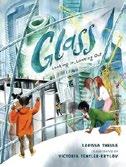
A close look at the history and prehistory of a common substance we mostly only look through Theule follows up her likewise revelatory book Concrete From the Ground Up (2022) by going even further back in time to track our association with glass from 300,000-year-old obsidian tools to today’s cellphone screens and fiber optic cables. She explains in general terms how both natural and manufactured glass is made and its many useful properties, how glassblowing was invented and refined into “one of the coolest (and hottest!) art forms,” and how the material came to be used for windows and architectural marvels as well as in eyeglasses and scientific
instruments. “We’re still finding ways to make it and use it,” she finishes— though she leaves readers to their own speculations rather than pointing out any innovations. Tentler-Krylov fills in at least some of the blanks. In her bright montages, glass items from spearheads and simple molded bowls to show-stopping stained glass windows and futuristic flying cars tumble past, accompanied by a cast of racially and culturally diverse glass workers and users who lighten the tone with appreciative or explanatory remarks. A quick glance, but as clear and colorful as its topic. (bibliography) (Informational picture book. 6-9)
Timmers, Leo | Trans. by Bill Nagelkerke Gecko Press (36 pp.) | $18.99 September 9, 2025 | 9798765670507
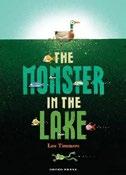
A timid mallard is anxious about crossing a possibly monster-infested lake, but after overcoming his fear, he finds something surprising underwater.
Despite the legends, Eric’s three birdie buddies are insistent that the lake doesn’t harbor any monsters. Nah, there’s only “boring old fish and frogs.” But on the extra-tall pages divided horizontally and offering views both above and below the waterline, the observant fowl—and readers—have a different vantage point. What they see in the shadowy depths is fish and frogs fleeing. Enter the monster, a textured teal creature with horns and requisite sharp white teeth but who also sports a warm grin and dapper crimson chapeau. Leaving his friends blissfully unaware, Eric dives and explores a monster-ific world via an impressive gatefold. Inside is a grandiose underwater city cleverly constructed from human detritus where vibrantly colored, just-barely scary monsters cavort. Emboldened by his
adventures, a newly self-assured Eric returns to his now-alarmed friends and reassures them that “there’s no monster in the lake,” a statement that leaves the tale on a curiously ambiguous note. Translated from Dutch, the wry narrative is told entirely in short, declarative lines of conversation. The contrast between the oblivious birds floating in stark white and Eric with the rainbow monster menagerie below is flawlessly deadpan. The book’s multilayered aerosol spray and acrylic paint illustrations are uniquely pleasing. Here be monsters—and they are monstrously fun! (Picture book. 4-8)
Tysoe, Alina | First Second (320 pp.) $23.99 | $14.99 paper | October 7, 2025 9781250896698 | 9781250896681 paper

A trio of sisters deals with magical secrets and dangerous trials. In the wake of a century-long war among magicians, magic has become a matter of history. Tell that to the residents of the WolfDrake House, where Rosie and Mira struggle to keep up with their little sister Peanut’s shape-shifting and other magically mischievous abilities. Their parents are away on an important expedition, and the phone line to connect with the older daughters is unreliable. Familial love sees the girls through their parents’ absence, such as when they clean up Peanut’s mess while listening to a recording of their mother’s good-night lullaby. Tysoe portrays the cast members as a pack of
charming goofs, all puffy cheeks and doe-eyed expressions. The visual humor helps maintain a sense of levity throughout the story, including when Rosie and Mira engage in combat training at Whisper Cove High’s Adventure Academy and have a showdown with a shadowy creature that seeks to steal Peanut’s magic power. Dashes of warmhearted romance and friendship round out this appealing tale: Rosie has a crush on classmate Yana, and Peanut makes a friend, Lydia, who can also transform. A couple of final plot beats hint at more to come, which readers will welcome like a heartfelt hug. The characters have diverse skin tones and hair textures, a variety that’s present within the Wolf-Drake family. Delightfully funny and exuberant. (Graphic fantasy. 8-12)
Vanece, Ariel | Illus. by Jade Orlando
Rocky Pond Books/Penguin (32 pp.)
$18.99 | October 14, 2025 | 9780593617816

A young Black boy visits his neighbor each morning, only to find that a cherished gospel hymn has slipped from the older man’s memory.
Caius, who used to sing frequently with his grandfather, knows that songs can be memories that “make even the coldest day feel like summer.” Determined to help Mr. Johnson, Caius embarks on a quiet search—reading books, listening to records, and, finally, talking to his grandmother—to recover the lost lyrics and, in doing so, preserves a
A tender portrayal of a child’s bond with an elderly neighbor.
SEARCHING FOR MR. JOHNSON’S SONG
shared piece of cultural history. Enhancing the story, an author’s note frames gospel hymns as a longstanding tradition in Black communities, linking past to future and bridging generations. Vanece also explores the history of the song in question, “Further Along,” once heard in churches and later recorded by artists from Sam Cooke to Dolly Parton, adding depth and cultural resonance to the narrative. Orlando’s warm illustrations deepen both the hymn and the story, layering emotional texture with historical detail and a vivid sense of the present. Vanece’s prose demonstrates how a child’s unprompted empathy and support for an older neighbor can make a meaningful difference in both of their lives. Also commendable is how the story quietly reflects the reality of many children’s lives by depicting a nontraditional family structure (Caius lives alone with his grandmother) without making it a point of conflict or focus.
A tender portrayal of a child’s bond with an elderly neighbor. (Picture book. 4-7)
Van Sciver, Noah | TOON Books/ Astra Books for Young Readers (96 pp.) | $17.99 | December 23, 2025 9781662665400

Calamity Jane’s legend goes under the microscope. At the 1901 Pan-American Exposition in Buffalo, N.Y., Calamity Jane recounts her exploits to a diverse crowd of spectators. The crowd audibly gasps as the former Pony Express rider—known to friends by her birth name, Martha— describes how she bested a desperado armed only with a meat cleaver. Buffalo Bill Cody, his Cowboy Band, and mighty warriors of the Lakota tribe all converge on the stage for a “rousing climactic performance.” On her break, Jane takes trespassing young
waifs under her wing, offering them food from her tent alongside a more personal version of her life story. Ultimately, Jane leaves and goes west. Van Sciver’s successful graphic nonfiction formula sends another tall tale packing. An author’s note preempts the narrative with essential historical context on harmful stereotypes and caricatures of Lakota people. Backmatter from contemporary Indigenous scholar and professor Dr. Susana Geliga (Sicangu Lakota and Boriken Taino) expands this context even further to truly center Indigenous perspectives against the mythic “Wild American West.” Sepia tones and crosshatching call to mind classic Western comics; the color palette also effectively delineates flashbacks from the story’s present. Photographs add authenticity to the lore, while Jane’s unreliability as a narrator and figure is brought into question and deliciously muddies the truth.
Engaging and eye-opening. (bibliography) (Graphic nonfiction. 8-12)
Van Zandt, Christine | Illus. by Lesley Breen Union Square Kids (32 pp.) | $19.99 December 9, 2025 | 9781454961659 Series: Mighty Models
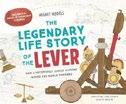
An overview of ways that levers have been used throughout history and prehistory. Instructions for a build-your-own catapult (and an included model) add interest, but this introduction fails on multiple fronts to provide systematic or useful information about the simple machine the device employs. For one thing, while Van Zandt does offer some unusual examples of levers in use (such as a filmmaker’s clapperboard) and properly points out how they often work in tandem with other simple machines like inclined planes and wedges, she never quite gets around to identifying the three types of levers or
A vibrant walk-through, equally appealing to locals and visitors.
ZOHRAN WALKS NEW YORK
discussing more than a few of their distinctive capabilities. All three do appear in Breen’s busy historical scenes, colored as bright red bars to stand out, but these illustrations have issues, too. Though the author explains how “catapults” (or, more accurately, onagers) actually worked, the twisted ropes that powered them are either wrongly located, barely glimpsed, or not visible at all in the accompanying illustration of ancient Greek besiegers—some of whom aren’t even aiming their weapons at the stone wall supposedly under attack. The disconnect between text and pictures carries over to a pulley that’s described but not shown, and a lever that’s absent from a schematic view of the airplane engine throttle it supposedly controls. The illustrator does vary the skin tones slightly in the groups of smiling cartoon figures posed next to the scales, steam locomotive, and other technology from various eras. Skips too many basics to offer any advantage, mechanical or otherwise. (Informational picture book. 6-8)
Zohran Walks New York
von Platen, Millie | Calkins Creek/Astra Books for Young Readers (32 pp.) | $18.99 October 28, 2025 | 9781662681554

A stroll through New York’s boroughs with the socialist Indian American immigrant (and onetime hip-hop musician) who could become the city’s next mayor. Rushed into production sans mention of Democratic candidate Zohran Mamdani’s recent primary win in July
2025, this sunny ramble extends his campaign walk down the length of Manhattan to include appearances at a Bronx street corner and a Mets game in Queens, a wintry dunk into the ocean at Coney Island in Brooklyn, and a ride on the Staten Island Ferry past (pointedly) the Statue of Liberty. Invariably flashing his characteristic broad grin in von Platen’s simply drawn urban scenes, he sits with his wife, Rama Duwaji, on the subway in a scene that depicts them as newlyweds riding the subway from City Hall. He also dances amid a diverse crowd at a street party that’s near his home in Astoria, Queens, according to a map and explanatory key at the end. The author includes a few biographical facts at the end, along with glancing mentions of Mamdani’s political stances. But the book is at least as much a celebration of New York and its residents, and if the streets and parks may not actually be so tidy and spacious as depicted, he and the figures around him in the illustrations represent a realistically diverse cross-section of the city’s populace, its pets and pigeons included.
A vibrant walk-through, equally appealing to locals and visitors.
(Informational picture book. 6-8)
Whan, Christine | Illus. by Sienna Kim Beaming Books (40 pp.) | $19.99 September 9, 2025 | 9781506497594

A biracial child celebrates a bicultural Thanksgiving with both sides of the family. The young unnamed narrator, who has a Korean
mother and a white-presenting father, is helping “Mom make two lists—one for the Korean market, and one for the local market.” The hand-lettered lists are displayed side by side, surrounded by an assortment of simply textured cartoon art depicted in softly blended pastel colors. Whan’s gently paced narrative follows the pair as they visit the neighborhood market first before going to the Korean supermarket. The child seamlessly explores how the same ingredient can play different roles in each culture: “Carrots are soft in stuffing and crunchy in japchae!” As both sides of the family arrive, more commonalities between cultures are skillfully revealed: The youngster’s two grandmothers sip tea together, and the child’s father and uncle cheer for opposing football teams on TV. Over a delectable feast, both sides amusingly try different dishes: “Grandpa gulps water after a bite of spicy kimchi.” The family passes around a Thanksgiving candle as they share special memories. The tale comes to a satisfying conclusion as the protagonist expresses feelings of gratitude: “I’m thankful for all of you. My gajok. My family.”
A most welcome Thanksgiving story in which families blend cultures and traditions. (glossary, author’s note, recipes for japchae and stuffing) (Picture book. 5-8)
Williams Dockery, Patricia | Crown (256 pp.) $8.99 paper | December 9, 2025 9780593811368 | Series: Race to the Truth
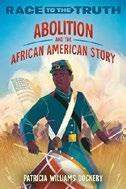
Williams Dockery, who contributed Slavery and the African American Story (2023) to the Race to the Truth series, returns to remedy the widespread omission of “free and enslaved Africans and African Americans…from history books.”
Focusing primarily on the late 1700s through Reconstruction, she shows how people challenged slavery
Fleshes out an oftenoversimplified era with a nuanced web of information.
ABOLITION
through overt and covert measures, leading to many judicial cases, such as Plessy v. Ferguson and Prigg v. Pennsylvania . Detailed explanations pepper each chapter, including anecdotes that show how states’ conflicting views of slavery resulted in laws that affected the lives of enslaved people and led to the Civil War and the broken promises of Reconstruction. Throughout, the author shares stories of brave people helping each other escape from slavery, including partnerships with Indigenous people and the Underground Railroad. She also highlights lesser-known examples of Black people’s contributions to American society and concludes with a discussion of the modern-day prison abolition movement. The chapters connect related concepts from different time periods, but because the book has few transitions between sections and the content skips around temporally, some readers may find the structure confusing. Some undefined terms and references indicate that this title may be best for readers who already possess some degree of background knowledge. Nevertheless, this volume is a valuable resource that helps push back against problematic erasure. Fleshes out an often-oversimplified era with a nuanced web of historical information. (resources, bibliography, image credits) (Nonfiction. 10-14)

For more in the Race to the Truth series, visit Kirkus online.
Williamson, Dorena | Illus. by Paran Kim Zonderkidz (32 pp.) | $18.99 August 12, 2025 | 9780310166788

Tools to help kids weather the ups and downs of life. The author’s aids for getting through tough times are good ones: breathe in and out (readers can’t help doing this each time it’s mentioned in the book); remember that you are loved and a unique individual and that life is a blessing (these last two points add religiosity with mentions of the “Giver of Breath” and “His precious blessings”); lend a helping hand; look for the helpers; and take life one day at a time. Illustrations often depict pairs, with the adult serving as the child’s anchor in the storm, a reliable person to whom a young person can talk and ask questions. And the book has some ups to somewhat balance its downs—a family camping trip, getting pushed on a swing, sharing time with friends. But while it’s true that everyone has rough days, those days aren’t necessarily comparable: a rainy day and a fire drill at school are different from being a wheelchair user, having a cochlear implant, or facing the damage from a severe storm in your community. Kim’s brightly colored illustrations highlight people of varying ages, skin tones, and abilities. Solid ideas for weathering storms, but the storms are as different as apples and oranges. (Picture book. 3-7)
Wu, Carleigh | Illus. by Sean Simpson Kids Can (80 pp.) | $19.99 | October 7, 2025 9781525311321

A math coach’s winning techniques for taking the mystery out of mathematics, and for acing math problems and tests.
Dismissing as myth the idea that some people are just born with a “math brain,” Wu offers a mix of specific techniques—all evidence-based from cited sources—and general encouragement designed to make mathematics less intimidating or inscrutable for anyone willing to make an effort. While urging readers to ask for help when necessary and to think of mistakes as learning opportunities, she introduces role models of the present and past like Maryam Mirzakhani (the first Iranian and first woman to win a prestigious Fields Medal) and points to math’s roles in unlikely pursuits like crochet and fashion design. She closes each chapter with a set of projects or activities (“Make a pie chart about how you feel during the day”). Meanwhile, along with spot art and periodic achievement badges, Simpson’s cartoon illustrations take a racially diverse group of young explorers successfully past various obstacles to a jungle’s sunny edge in tandem with the reader’s metaphorical journey from cluelessness to a self-affirmative “I’ve got this.” “It all adds up,” the author closes reassuringly, beneath a pithy summary of her main points. Positive in tone throughout and solid both in principles and procedures. (source lists, index) (Self-help. 8-12)
Wynne, Megan | Our Street Books (192 pp.)
$16.95 paper | October 1, 2025
9781803419176
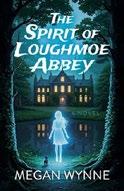
Twelve-year-old Dubliner Gwen has no idea of the changes awaiting her when she reluctantly agrees to attend a boarding school situated on ancient monastic ruins.
The year is 1986. Gwen’s mother has grown increasingly emotionally unstable while homeschooling her only child, so Gwen’s dad sends her to Loughmoe Abbey. School proves a tough adjustment; lonely, teased because of her weight, and struggling scholastically, Gwen rebuffs the overtures of kindly Hanuni and instead attempts to befriend another dormmate, the chilly Jess, with little success. By midterm break, her sole friend is the cook, who encourages Gwen to tell the principal, Ms. Friedman, about the strange things she’s been noticing: swirling leaves (on a day with no wind), rustling reeds, and a mysterious voice. Ms. Friedman calmly informs Gwen that a spirit is attempting to reach out and sets up an appointment for further communication. As Gwen engages with a spirit named Molly, the initially leisurely pace picks up considerably, and the supernatural elements gain in intensity. Though Gwen’s awkward, occasionally selfish behavior may put off some readers, the eerie atmosphere and intriguing plot will engage them, propelling the story toward happy endings on many fronts. Gwen’s bond with Molly results in an ultimately satisfying arc as she grows in confidence. Gwen and Jess present white; Hanuni is Black and Kenyan.
Positive in tone throughout and solid both in principles and procedures.
A spine-tingling tale of a youngster coming into her own. (Paranormal. 8-11)
Yarlett, Emma | Candlewick (32 pp.)
$17.99 | August 26, 2025 | 9781536246469
Series: Emma Yarlett’s Post Pals

A child helps a magical companion find a forever home in a sugary adventure with waggish interactive elements.
“It was a day full of RAINBOWS. And I was playing picnic in my TREE HOUSE…when all of a sudden I heard a KNOCK on my door. It was a unicorn. I LOVE unicorns.” Worried that the rainbow-maned beast is lost, the blond, peach-skinned young narrator offers reassurance (“I will find you a new home!”), and the two set off. Ruling out a pet shop, a farm (“The food was DISGUSTING”), and the “VERY STRANGE” Famous Unicorn Carousel (where the other unicorns “wouldn’t even stop to say hello!”), the pair visit plausible spots until landing upon the unicorn’s ideal home. The glossy, foil-tinged cover will surely speak to a certain dainty readership, but the protagonist’s thoughtful and mission-oriented persistence belies the princessy palette. Hand lettering reminiscent of Oliver Jeffers’ work adorns Yarlett’s pleasingly childish, candy-colored mixed-media illustrations on thick pages embellished with five lift-theflap elements— including letters and a shop flyer—that enhance the storyline. Humorously detailed, full-page artwork includes visual gags as the unicorn susses out each failed location. Redolent with pink, this first-person point-of-view evolution of a proprietary relationship into a bonded friendship delivers on its promised “magical surprises” and should delight fans of fantastical adventure stories and unexpected pet dramas. A sweet friendship tale, rosy in every sense. (Picture book. 4-7)

LAURA SIMEON
YEARS AGO I was struck by a conversation I had with the parents of an American teenager who was applying for a highly selective scholarship to the international high school network from which I had graduated. The UWCs strive to make “education a force to unite people, nations and cultures for peace and a sustainable future.” As a U.S. National Committee member, I delighted in interacting with teens and their families from every imaginable background and corner of the U.S. (and beyond). The
genuinely caring, concerned parents in question caught me by surprise when they asked, “If our son goes to one of these schools, will he be taught to hate America?”
The answer I gave then is what I’d say now to anyone in this increasingly polarized country who objects to books that present viewpoints that go beyond sanitized, simplistic, feel-good versions of the past: I told them that he’d be exposed to many different perspectives, some of them challenging and uncomfortable, and that his

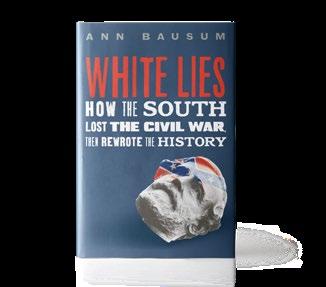
beliefs would certainly evolve over time. But crucially, he’d be taught how to think, not what to think.
Of course, you wouldn’t want to entrust your child to people—whether teachers or authors—you fear will lead them to scorn a cultural identity that is deeply meaningful to you. But true appreciation and respect go beyond the surface to embrace complexity. Discomfort opens the door to growth. To supplement the dry, bland history textbooks that limit substantive engagement and the patently biased ones that peddle falsehoods, offer teens one of these bold and courageous works that they can truly grapple with. These books expose them to writers who model critical thinking and construct persuasive arguments that are grounded in solid evidence.
Beginning with the title, White Lies: How the South Lost the Civil War, Then Rewrote the History (Roaring Brook Press, August 12), Ann Bausum holds nothing back in her latest work, which both reckons with a sustained campaign of deliberate historical misinformation and calls readers to action. By thoroughly and systematically demolishing 20 false tenets she finds underlying the white supremacist Lost Cause

philosophy, she exposes how deeply embedded it remains throughout the country.
For readers too young to have come of age during the most traumatic years of the AIDS epidemic, Michael G. Long’s Fight AIDS!: How Activism, Art, and Protest Changed the Course of a Deadly Epidemic and Reshaped a Nation (Norton Young Readers, June 3) will be an eye-opening and provocative read. It encourages reflection on the power of grassroots activism, the impact of homophobia and other biases on medical research and public health, queer community history, and more.
Ideal for those seeking compelling, historically accurate fiction, Under the Same Stars by Libba Bray (Farrar, Straus and Giroux, February 4), contains three interwoven storylines, two of which highlight youth activism in politically oppressive times—World War II and the Cold War in Germany. In the third, set in Brooklyn during the Covid-19 lockdown, a Filipino and white teen with two moms questions his identity, finds his voice, and figures out what he wants to say in a world that feels overwhelming.
Laura Simeon is a young readers’ editor.
Discovering yourself takes time.
Volbeda’s translated debut, which was named the Rainbow Book of the Year in its original Netherlands, unfolds in epistolary format as teenager Jip writes unsent letters to an unnamed classmate (and crush), discussing life, family matters, and general frustrations around an uncompleted art assignment to draw a self-portrait over spring break. Jip loves and has a talent for drawing, making it surprising that this project should be a struggle. Throughout most of the book, Jip’s gender is unspecified, but clues appear, conveying coded
messages that supply contextual information, such as a reference to a forebear named Jipernicus, the opinion other kids in gym class have about Jip’s grooming habits, and Jip’s choice to wear a hoodie and baseball cap even though it’s warm out. As the novel progresses, readers slowly learn about the gender Jip’s peers and family members assume to be correct. Ultimately, the letters help Jip to realize the truth and thus to draw an accurate and affirming self-portrait. The story’s meandering narrative is authentic, both in its stream-of-consciousness delivery and in the ways Jip’s self-discovery unfolds.
By Lyssa Mia Smith
By Ludwig Volbeda; trans. by Lucy Scott
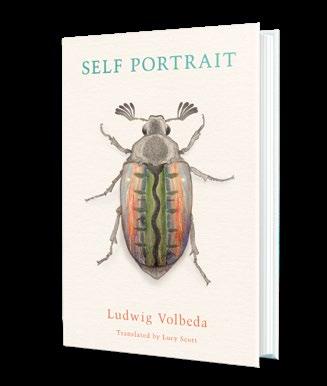
Volbeda, Ludwig | Trans. by Lucy Scott Em Querido | 240 pp. | $19.99
November 4, 2025 | 9781646145775
Glimpses of subplots, such as Jip’s grandmother’s cognitive decline and Jip’s parents’ turbulent marriage, are naturally woven in; these open-ended vignettes further enhance the realism and beauty of Jip’s world and journey.
Volbeda’s exquisitely delicate sketches, executed with fineliners and mechanical pencils, are sprinkled throughout, adding texture. Breathtakingly raw and fresh, just like adolescence itself. (Fiction. 12-18)

For another translated Dutch coming-of-age tale, visit Kirkus online.
Alvarez, Jennifer Lynn | Delacorte (352 pp.) | $12.99 paper
October 28, 2025 | 9780593900611
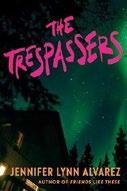
A teen finds herself in moral and legal turmoil. Eighteen-yearold Finley Dunn became fast friends with Mya Green, River Madden, and Eli Kalluk in preschool. Four years ago, following a shootout that left Finley’s and River’s fathers dead, Finley and her mom fled Anchorage for Los Angeles. But Finley’s grandmother has died and bequeathed Finley her house, so she’s back in Alaska. Her return fuels Mya’s fears that her presence could shake loose a secret that would make their friendships implode. The secrets multiply when Mya throws a drugfueled party at a house her real estate agent mom is showing. Finley injures Jason Walker, a homeless man sheltering there, who then disappears. Finley’s wracked with guilt, especially because she and her mom experienced homelessness in L.A. To keep them all out of trouble, Mya must conceal the crime—and keep Finley from confessing. As the search for Jason intensifies, Finley’s increasingly conflicted first-person narration explores such issues as justice, peer pressure, and housing insecurity (which is portrayed with great nuance). In third-person chapters, Mya scrabbles to keep her secrets under wraps. Flashbacks to four years prior build to shocking revelations. Unfortunately, despite a suspenseful premise, the expository narration and
underdeveloped characters dampen the story’s emotional impact. Mya’s cold affect feels particularly twodimensional despite the author’s attempts to show her family’s struggles and dysfunction, and readers may find Finley’s susceptibility to Mya’s influence frustrating. Most characters read white, and Eli’s surname cues him as Indigenous. Disappointingly uneven. (Thriller. 14-18)
Blair, Kate | DCB Young Readers (272 pp.) | $16.95 paper October 4, 2025 | 9781770868021

Keira Martin, a Toronto 17-yearold, is trying to solve a cold case from 80 years ago involving a dead German soldier.
Keira is attending a prestigious museum summer program at Camp 43 in the small Canadian town of Westonville. Her winning project and the focus of her summer involves solving the murder of Erich Stein, a German POW from World War II who was held at the camp. When Keira meets her fellow participants, she feels like she doesn’t belong. Asha, who’s South Asian, and Ephram, who’s Black, seem to come from rich families, and Keira feels snubbed by them. Ruth, who’s white like Keira, is pushy but “magnetic,” and Keira falls in with her. When Ruth is found dead, Keira wonders if it really was an accident, as everyone believes—or whether her death might have something to do with the camp’s
history. This double murder mystery takes place in timelines that unfold in Westonville during the 1940s and the present day. The narrative attempts to address the complicated question of what actually makes someone culpable as a Nazi. The original premise is marred by the large cast of characters, both past and present, many of whom are involved in their own dramatic subplots, which makes them difficult to track. While the circumstances surrounding Erich’s and Ruth’s deaths are resolved, Kiera’s own story feels unfinished.
A sincere though disappointing effort to examine a still relevant moral question. (Historical mystery. 12-18)
Chapman, Clay McLeod | Delacorte (368 pp.) | $19.99 | November 11, 2025 9780593904084

A new drug craze promising perfection has dangerous consequences, even for those who abstain. Rather than party and discover a similar penchant for “fun” as the biological mother who abandoned her, Kyra Cartwright determinedly sticks to the straight and narrow. The trauma of her mother’s addiction has left Kyra with a distaste for her peers’ drug- and alcohol-fueled lifestyle, and she struggles to control the creeping tendrils of her “anxiety ivy.” Lately, Kyra’s adoptive brother, Gabe, who’s normally chaotic and unserious, has been a different and unsettling version of himself. When her edgy, offbeat best friend, Halley, suddenly becomes invested in hanging with the in crowd, Kyra knows something is seriously wrong. The influence and power of local pharmaceutical company BoTanic, the school’s corporate sponsor, is showing up everywhere, leaving only Kyra and new student Logan Kidman, who’s equally unimpressed by everyone’s shiny new selves, to resist the
pressure to be perfect and solve the mystery of what’s going on. Inspired by a variety of classic horror and sciencefiction books and movies, Chapman’s young readers’ debut offers satisfyingly gruesome body horror alongside pointed social commentary. However, Kyra’s voice doesn’t come across like that of an authentic teen girl, and her portrayal feels derivative. The thin characterization makes this work feel out of step with the believably drawn teens typically found in YA. Main characters read white. A modernized homage to vintage horrors that would have benefited from greater emotional depth. (Horror. 14-18)
Charlotte, Emily | Simon & Schuster (304 pp.) | $20.99 | November 18, 2025 9781665971423 | Series: Varsity, 1

Two high school rivals learn there’s more to each other than meets the eye. With her college dreams hinging on the success of her jewelry business, Harper is desperate to be awarded a Young Entrepreneurs Grant and frustrated that everyone at her school privileges the athletes. Hockey team member Dawson hopes to be recruited by college scouts; he’s also battling pressure from his dad, a former hockey star. Though Harper and Dawson find each other annoying, they often cross paths since Harper works at Dawson’s family’s diner. When Dawson’s coach is fired for misuse of funds, one of the hockey players starts a rumor that Harper is involved. But over time, the dynamic between Dawson and Harper begins to change as they reevaluate themselves and each other. Despite the slow start, this charming enemies-tolovers narrative succeeds thanks to the well-paced progression of the leads’ relationship. Their alternating first-person points of view allow the
complexities of their inner feelings to show through. The characters’ interactions feel intentional, and the emphasis on connection and friendship extends beyond romance, for example, through the supportive, open communication between Dawson and his friends Alex and Ryan. Charlotte’s debut successfully combines sports, friendship, and the emotional highs and lows of high school love. Main characters are cued white.
A heartfelt romance that shows how letting go of the past can bring you an even brighter future. (Romance. 14-18)
Chow, Keshe | Delacorte (480 pp.) | $19.99 October 7, 2025 | 9780593898475
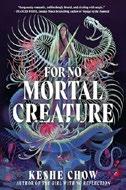
Jia Yi can come back from the dead, but does she want to?
Her whole life, 16-year-old Jia Yi was told that she was an Untouched, someone who possessed no magic. But then she was killed by Andres Brisson, a lieutenant general for Prince Essien Lancaster of Yske, a neighboring kingdom that’s populated by the fantasy-European rivals of her Chineseinfluenced land of Fengzhi Yuan. After Brisson runs her through with his sword, Jia realizes she has the power of resurrection, which opens up an afterlife populated by the ghosts of her past, including that of her childhood best friend, Lin, who betrayed her before he died a year ago. She’s desperate to get back to her dying High Priestess grandmother—only to find out that she has already passed. In her quest to find her grandmother and understand the prediction a shaman once made, Jia discovers a complicated afterlife with multiple levels. She risks everything while navigating feelings for the old friend who hurt her deeply and the prince who isn’t what he at first seems to be. The love triangle in this novel, which is inspired by Wuthering Heights, unfortunately lacks the original’s emotional urgency due to
characterization that often feels flat. The design of the afterlife is complex and intriguing, however, and will appeal to readers who appreciate original worldbuilding.
A romantic fantasy that’s strong on setting but light on character development. (map) (Fantasy romance. 13-18)
Chupeco, Rin | Sourcebooks Fire (352 pp.) | $12.99 paper November 4, 2025 | 9781728255941

A teen investigates the bloodstained secrets of a town built on ritual, silence, and monsters. Wispy Falls promises safety— but a 17-year-old vlogger, a black-haired, brown-eyed boy who goes by Storymancer, knows that’s a lie. His 7-year-old brother, Lee, is among those who vanished in the woods. After someone finds a body in the woods, LightParticle121, a conspiracy message board user, sends Storymancer a news clip from a local station that strangely doesn’t appear in the news archives. Storymancer begins corresponding with LightParticle121, who claims that all the missing were sick (Lee had cancer, but few people know that). Even as their exchanges grow increasingly unhinged, Storymancer pursues this lead, documenting his investigation into the bloodmoon ritual, which the authorities claim will protect citizens against the cryptids in the woods. But the deeper Storymancer digs, the more he questions the ritual—and suspects that the Penumbra Institution, which controls the town’s medical care, may be hiding something far more sinister. Told through video and radio show transcripts, emails, and more, the found footage–style narration creates a chilling realism. Chupeco demonstrates a keen understanding of how misinformation spreads and digital natives process fragmented
information, though the structure works against the story’s emotional core. The town’s mythology and the cryptid classifications are well-crafted, but the pacing sags under the weight of the plot’s complexity and exposition-heavy forum posts. A haunting and twisted, if unevenly developed, tale that explores the line between safety and control. (Horror. 14-18)
Comerford, Helen | Bloomsbury (384 pp.) | $19.99 | November 11, 2025 9781547617234

A teen girl breaks the gender barrier to join the ranks of superheroes and battles to save the world.
In Comerford’s duology opener, The Love Interest (2024), Jenna Ray discovered she’d acquired the ability to control water and exposed King Ron, the corrupt head of the British Heroics and Power Authority. But there are many in the media who think he should still be in charge. The new head of the HPA, Mia (who uses they/them pronouns), is determined to improve the organization, starting with recruiting Jenna as “the first female hero.” However, when Jenna has a terrifying incident in which she loses control of her powers and causes catastrophic damage, Ron reaches out to her from prison, claiming that she’s being possessed by the EV, a force that powers all the heroes, and only he can help her. This entry introduces a range of new heroes from around the world, who join the well-drawn cast of central characters and add depth to the worldbuilding. Jenna’s forbidden to date a fellow hero per the HPA rules, making her relationship with Laurie Lin aka Blaze—the boy who rescued her, putting her in the public eye—humorously complicated. The nonstop action is incredibly fun, and clever jokes combined with swoony, tender moments between Laurie and Jenna make this
adventure a real page-turner. Jenna is Black, and the earlier book established Laurie as Chinese and white. Fast-paced, cinematic action paired with a heartfelt love story. (Fantasy romance. 14-18)
Dashner, James | Akashic Media Enterprises (280 pp.) | $25.95
September 9, 2025 | 9798988421535
Series: The Maze Cutter, 3

This sequel to The Godhead Complex (2023) ambles its way to a close amid just deserts and joyful reunions. In the third volume of this series, which is set some seven decades after the events of the Maze Runner books, the possibility of a remedy for the zombie-making Flare virus sends parties of Immunes toward Alaska. The story unfolds through the perspectives of several point-of-view characters—Isaac, Ximena, Minho, and Alexandra. The descendants of the characters from the original world are joined by sage Old Man Frypan whom fans of the earlier series will already know; he accompanies Isaac, Ximena, and Jackie and gets the chance to try to persuade an underground colony of scientists that it’s time to rejoin the outside world. The cast just seems to be going through the motions here—so bland and juiceless that even the villain, a glib killer with a god complex who periodically enters a mystical state by reciting numbers in the Fibonacci sequence, seems too weak to merit the
violent fate she receives. If ever a series showed clear signs of running on empty, this jumble of mini-chapters, darting choppily back and forth between storylines that are, too often, just marking time, fits the bill. Names cue some diversity in the cast.
A weak trilogy finale: thin, purposeless, anticlimactic. (Dystopian. 12-18)
Davis, Ana | Keylight Books (368 pp.)
$33.99 | October 14, 2025 | 9798887980874

A teenage girl will do whatever it takes to become queen, no matter how bloody her hands get.
In Davis’ debut, inspired by William Shakespeare’s Macbeth, a trio of teens find themselves thrust together by three witches’ prophecies. Dark-haired, brown-eyed Lady Adelina Malves Ducança, marquise of Lis and niece to the king of Jumaral, has just lost her brother to murder— and she suspects her family members are to blame. Now next in line for the throne—and, thanks to the prophecy, at risk of meeting her brother’s fate—Adelina enlists scrappy refugee orphan Jasibin Guan, who can speak to the dead, to unravel the secrets behind her brother’s death. She also ropes in Sebastião Pinheiro, Jas’ chosen brother who’s also from faraway Huojen, as a pretend suitor. The setting’s combination of press photographers, telegrams, carriages, a newly invented motorcar, cobblestones, castles, and undercover alchemists evokes a fantastical early-20th-century
Clever jokes combined with swoony, tender moments make this a page-turner.
Portugal. However, the rich premise is let down by confusing plotting, clunky prose, and simply drawn characters whose emotional extremes prevent the reader from finding a fully engaging, sympathetic protagonist or even a complex villain; the cruel and calculating Adelina, although she sometimes vomits from guilt, displays none of Lady Macbeth’s nuanced internal conflict. The violent ending leaves plot threads unsatisfyingly unresolved, and its quick escalation feels incongruous with these characters’ earlier development. A Shakespearean retelling that delivers neither fantasy thrills nor the eeriness and pathos of its source material. (map, content warning, pronunciation guide) (Fantasy. 13-18)
de León, Aya | Candlewick (288 pp.)
$18.99 | October 14, 2025 | 9781536239348 Series: The Factory, 3

A spy goes to summer music camp in this follow-up to Untraceable (2023).
Fifteen-year-old Amani Kendall is a plus-size Black girl who’s working as a spy for the Factory, an international organization that fights racism. She found out recently that her parents were spies, she’s been going on missions with them, and now it’s Amani’s turn to head out into the field by herself. Sixteen-yearold Danielle Hunter has behaved unpredictably ever since she learned that both of her parents worked for the Factory (and that her father died on the job), worrying leaders at the top-secret agency. Danielle, who’s Black, is heading to Los Angeles with her band, the Quad, to audition for The Next Teen Sensation: Ten contestants will attend a summer training camp in Oregon, where they’ll prepare for a final competition attended by record label scouts and broadcast live from Northern California. Amani’s job is to assess the danger that Danielle
poses to the Factory’s anonymity. As a talented vocalist, she’s quickly invited to join the Quad, but engaging with volatile Danielle is hard. With its diverse cast and enriching, seamlessly interwoven conversations about Blackness and fatphobia, this story infuses thoughtful reflection into the fun and action. Amani is a relatable and engaging main character who’s sympathetic in her struggles with wanting to do a good job as a spy while also having real feelings for her bandmates.
Entertaining from beginning to end.
(Thriller. 12-16)
Ellis, Kat | Harper/HarperCollins (368 pp.) | $15.99 paper | October 7, 2025 9780063355248

Teen musicians end up stranded at a haunted house that’s out of an urban legend. After their car breaks down on the way to a music festival, Haden Romero and her Phantomic bandmate and best friend, Kizi Kennedy-Oshima, have to hitch a ride on the tour bus belonging to Haden’s childhood reality show co-star and nemesis, Deacon Rex, who’s originally from London. Making things worse, Deacon’s band has a new drummer: Cairo Martin, former Phantomic member and Haden’s ex-girlfriend. The bus goes off course and crashes, separating the teens and dumping them in a canyon near a swamp where mysterious white gravel paths lead to a lit-up manor house. From interstitial chapters, readers get glimpses of the house’s supernatural history and clues to the danger the characters are in, even as they try to rationalize their increasingly disturbing experiences. As well as delightfully deployed slow-burn haunted-house fare, such as signs that someone else is in the house with them, the text revels in body horror; sensitive readers are warned away by the detailed content
note preceding the story. The story delves into complicated friendship dynamics and what motivates the young people’s dreams of stardom. Interludes describing found footage prevent the claustrophobia from becoming stale, and the ending is bold and definitive. Deacon is white, Cairo is Black, Kizi presents Japanese American and white, and Haden’s surname may cue her as Latine. An atmospheric treat for readers who don’t suffer from squeamishness. (Horror. 15-adult)
Emery, Kate | Knopf (304 pp.) | $19.99 October 21, 2025 | 9798217030163

A teen marooned with her family at the home of her step-grandmother, GG, in rural Western Australia puts her sleuthing talents to work. As the novel opens, 14-year-old Ruth is looking forward to returning home to Perth. She’s bored with her uncaring GG’s stories, all about “her (dead) cat, her (dead) son, or her (dead) husband(s).” A freak run-in with a snake sends Aunty Vinka’s boyfriend, Nick (“part aging member of a K-pop band and part surfer”), to the hospital. Ruth, her dad, cousin Dylan, Aunty Vinka, Aunty Bec, and Bec’s boyfriend, Shippy, stay on with GG as Nick experiences more health mishaps and must remain hospitalized. When GG is found dead and the police open an investigation, the family members, suspicious of one another, are trapped in the countryside without phone reception or internet service. Humorous exchanges among Ruth and her eccentric relatives establish a light tone, which is further buoyed by Ruth’s lively, self-aware, and wry voice. As the first-person narrator, she occasionally addresses readers directly. Ruth is a fan of Sherlock Holmes, Agatha Christie, and Ngaio Marsh. In
an homage to these classics, family secrets—unknown to both the characters and readers—are gradually revealed, clue by clue, in an airy murder mystery where an isolated Australian farmhouse stands in for an English manor. The snappy dialogue contributes to the strong sense of place. Most characters read white. A zany and entertaining whodunit. (Mystery. 12-18)
Fergus, M.L. | Tundra Books (376 pp.) $13.99 paper | September 23, 2025 9781774886113 | Series: Fractured Kingdom, 3

Persephone confronts her heart and her fears as she heads into battle in this final book in the Fractured Kingdom trilogy. After several setbacks, Persephone is captured and left to face great challenges alone without having time to grieve the death of her brother. She must decide once and for all what role and responsibilities she’s going to accept and how Azriel will fit into it all. Mordesius, the duplicitous regent set on reigning over the kingdom himself, will stop at nothing to take what he wants, including brutally disfiguring or killing his foes—and even his allies. Mordesius, who’s portrayed as bitter about his disability, despises servants who “flaunt their strong bodies and straight limbs in front of him.” The lives of everyone in the five clans of Glyndoria hang in the balance, but Persephone can’t save them all on her own. Drawing upon her determination, compassion, and ingenuity, Persephone escapes her captors and works to unite the clans of the kingdom for this worthy cause. She races against time to find Azriel so he can keep his oath and assist her in stopping the murderous Mordesius. Will the prophecy that started it all finally be fulfilled or will all be lost? The third-person omniscient narration shifts among multiple characters’ points of view, maintaining a fast pace that will
A
romance with a winning combination of humor and magical adventure.
DEADLY EVER AFTER
keep readers’ attention. Most main characters present white. An action-packed finale on a grand scale. (content warning) (Fantasy romance. 14-18)
Franco-Cook, Andrea | Lodestone Books (352 pp.) | $24.95 paper November 1, 2025 | 9781803418964

Lost in an alternate version of the ancient world, a Greek American archaeology student tries to return home.
Nineteen-yearold Amara Kalogridas’ life isn’t perfect: Her mother died nine years ago, after which her father struggled with alcohol abuse, but her family has pulled through. Now, Amara, her brother, Greg, her best friend, Sophie, and her archaeologist father are working on a dig in Tunisia, where they’re hoping to learn more about the rise and fall of Carthage. Amara is just an intern, but she’s determined to make a discovery of her own. Soon enough she does— and the artifact she uncovers sends her back in time to ancient Carthage. Time travel is bad enough, but Amara quickly learns that she’s in an alternate universe with harpies, djinn, and other beings. Amara has unwittingly become embroiled in the Punic Wars and an even older conflict involving beings that move between dimensions and have their own convoluted motivations. Magical Carthage and the possible futures it invokes make for thought-provoking exploration and
speculation. The potential of the alternate-reality situation, however, is diffused by Amara’s preoccupation with her love life and the ancient love triangle that develops, which are less intriguing elements of the story. The plot is largely engaging, although the novel is at times overly reliant on dialogue for exposition.
A light time-travel adventure that struggles with heavy-handed execution. (author’s note, pronunciation guide) (Fantasy. 15-18)
Hinds, Emma | Wednesday Books (352 pp.) $20 | October 14, 2025 | 9781250369499
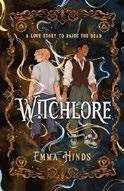
Grief and identity are at the heart of this queer fantasy set in an alternate England. Orlando “Lando” Southerns, a nonbinary white student at Demdike College, a school of witchcraft in the Northern Quarter of Manchester, is blamed by their witch classmates for the death of their girlfriend, Elizabeth Toppings, even though it was ruled accidental. Lando is a shape-shifter, their body changing between various female and male forms, but they have no control over this power. When Bastian Chevret—a Black third-year transfer student with Haitian, Jamaican, and Cornish roots—proposes to Lando that they do a resurrection spell together, Lando accepts. It’s an incredibly dangerous spell and requires hard-to-obtain ingredients, but Lando feels they have little to live for, and they’re willing to take any risk to get popular, blond, bicurious Elizabeth
back. But when they begin experiencing visions of an unknown shifter’s past and developing feelings for Bastian, they start to question their plans. This characterdriven fantasy thoughtfully explores Lando’s gender identity and the prejudice they face. The romance element is cozy and matches the book’s overall themes of being authentic and recognizing the value of life. While the plot takes a little time to really get going and some of the worldbuilding and side characters feel underexplored, the surprising and hopeful ending adds extra layers of meaning and is emotionally fulfilling. A comforting fantasy that grapples with realistic hardships. (content note) (Fantasy. 13-18)
Johnson, Brittany | Putnam (288 pp.) | $19.99 November 4, 2025 | 9780593859537

Two dead princesses seek true love and a second chance at life.
Princess Amala has spent her entire life trying to be perfect— docile, obedient, and above all, faithful to the god Ados. She sees her upcoming marriage as the only way to escape her abusive father and her sheltered life. But on her wedding day, she’s murdered—but she doesn’t know why or by whom. After the death of her beloved brother, Damien, the bold and brave warrior princess Kha’dasia has become angry and bitter. She didn’t get to say a final farewell to Damien, and she’s determined to make it up to him by visiting every one of the 34 places on the bucket list they created. But as she nears the final destination, she gets sick and dies. The princesses, who are Black, are visited by an Elder, who promises to bring them back to life if they complete a treacherous journey across The Garden to find true love’s kiss. While the quest is central, it doesn’t overshadow the book’s exploration of love and gender roles as
Amala and Kha’dasia fall for each other. The pacing is strong, with new challenges cropping up in each chapter, contributing to the nonstop action, and the intensity is leavened by lighter moments. Johnson’s debut novel features strong worldbuilding and character development and will remain with readers long after they’ve finished reading.
A queer romance with a winning combination of humor and magical adventure. (Fantasy romance. 14-18)
Johnson, Leah & George M. Johnson
Farrar, Straus and Giroux (320 pp.) | $19.99
December 2, 2025 | 9780374391690
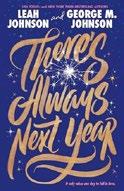
Two formerly close cousins who have drifted apart find themselves on opposing sides of their Indiana hometown’s gentrification— with their family business in the crosshairs.
After his video went viral, Dominique Cole, 17, left Oakrun behind to pursue life as an influencer in New York City. When Oakrun’s mayor reaches out to Dominique with an opportunity that could reinvigorate his struggling career—being the public face of the town’s fancy new hotel—he reluctantly returns. Aspiring journalist Andy Cole, also 17, writes for Oakrun High’s student paper, reporting on issues like the impact of the mayor’s economic policies on local businesses. It’s personal—Cole’s Hardware, which her family has run for over 70 years, will soon close, to be replaced by the boutique hotel chain Dominique is representing, and she’s sure there’s something fishy going on. Both cousins are attempting to help their family; their clashing approaches eventually lead them to reconnect and grow. Sweetly, along the way, the teens, who are Black and queer, each find love in unexpected places. The story unfolds hour-by-hour over the course
of New Year’s Day, swiftly but with enough breathing room to explore the complicated ethical tensions at its heart. The ending is a little too neat, but the story’s optimism is its greatest strength, joyfully depicting the power of community care.
A well-told holiday tale about family, forgiveness, love, and doing what’s right. (Romance. 14-18)
Jordan, Amie | Chicken House/Scholastic (384 pp.) | $19.99 | November 4, 2025 9781546136637 | Series: All the Hidden Monsters, 2

Following All the Hidden Monsters (2025), Sage is sent to deal with a volatile feud. Unhappy that he lost the bet and had to allow Sage to join the paranormal police force Arcānum as the first werewolf among warlocks, Roderick, their captain, sends her to an isolated part of the Jura Mountains. There she’ll attempt to resolve tensions between the local werewolves and witches. It’s a poison pill assignment—the witches will believe her to be biased, and territorial werewolves look poorly on non-pack werewolves— and an eruption of violence that kills Sage would suit Roderick nicely. Oren insists on accompanying her, letting her take the lead in the case, which starts off simple but escalates into dangers and unveils past wrongs. The pair grapple with their feelings and the impossibility of their relationship due to their different lifespans in yearning-filled descriptions of their messy emotions that fans of the genre will devour. Oren is keeping secret from Sage some suspicions he has—if true, the lifespan obstacle might be moot but other dangers would arise. Juxtaposed with the slow-burn romance, P’s storyline includes the sweetly done beginnings of a flirtation. The relationships focus on emotional over physical connection, using strong characterization to drive readers’ investment. The
How an award-winning YA writer approaches challenging topics for teen readers.
BY CAROLE V. BELL
AMBER MCBRIDE’S heroes wield pens.
Known for writing young adult novels of great substance and style while navigating difficult topics with grace, National Book Award finalist Amber McBride traces much of her creative confidence and clarity to her mentors, most of them Black women, and to an event over a decade ago that proved it sometimes pays to meet your idols.
On a single day in 2012, McBride, then just 23, met a constellation of literary luminaries she had long looked up to. Maya Angelou, Toni Morrison, Angela Davis, and Sonia Sanchez had gathered at James Madison University for “Sheer Good Fortune,” a tribute to Morrison organized by Nikki Giovanni and McBride’s mentor, the sponsor of her postgraduate internship at the Furious Flower Poetry Center, Dr. Joanne Gabbin. Through Gabbin, these superstars all knew McBride’s name and that she had just completed an MFA. They wanted to know what she was working on now. She explained that she had “kind of stopped” writing after a alienating experience in the grad program. She described a sense of being ground down by it: “I had not lost my voice, but definitely had just been put down so much.” To a woman, the authors responded, “Why?” “Why do you give a fuck what people say about what you write? It gets published. It doesn’t. You still wrote it. It’s for you.” That resounding chorus recentered and refueled McBride, made her feel defiant. She thought, If I have these women telling me this, why do I care what anyone else has to say?
In the ensuing decade, after two rejected books, McBride secured an agent and wrote and sold her debut publication, Me (Moth), a novel in verse that would win the Coretta Scott King Award and become a finalist for the National Book Award. Another book, Gone Wolf, won the Los Angeles Times Prize for young adult literature in 2024. McBride’s seventh book, The Leaving Room , out this month, centers a girl who is the keeper of memories in the transition between life and death for those who die young. We recently spoke to McBride by video call from her home in Virginia. Our conversation has been edited for length and clarity.


You’ve written middle-grade and YA novels, as well as poetry for adults. How do you match the storytelling, the narrative voice, and the content to the audience?
I’ve studied poetry, I understand poetry, and I don’t dumb down my poetry. If I don’t think that my prose or verse is something I’d want adults to read, then I’m not going to publish it for young adults either. So for me it’s more, How are we handling things? If I’m talking about mental health, I probably wouldn’t put a suicide on the page for a young adult. We have to be more creative in the way that we show difficult topics.
But also, you don’t want your book to get banned. You don’t want to start with something that could be like a bomb. So there’s sensitivity in thinking about my reader: Is this going to be too much?
For example, in We’re All So Good at Smiling, one of
the characters self-harms. Instead of saying, “He cuts his skin,” there’s a line in there, “I don’t trust my own hands with my skin,” which implies what he’s doing. There’s a little bit more up for interpretation when I talk about difficult topics for young adults and middle grade. It’s knowing that these kids can handle this, but they also might not have the language to talk about it yet. So let’s do this in a more nuanced kind of way.
Just like, with The Leaving Room, the way we’re talking about death or near-death experiences, or realizing that you might be queer. It’s a bit more subtle but still holds the same weight as what would happen in adult [fiction]. I come with a level of empathy with young people that I don’t always come with to adults, because I know that I might be their introduction into something.
You mentioned book banning. How has that played a part in your consciousness?
You can breathe wrong and your book could be banned, so I don’t really think about it when I’m writing. Now when we talk about my book Gone Wolf—which is about a president who doesn’t think he lost an election, separates from the Northern states, and re-institutionalizes a new form of enslavement—I already knew that was going to be a problem. So I wasn’t too worried. You’ve got to write the book that feels right at the time.
The worry comes with the fact that often the books that get banned are the books for readers who need them and might not have access. I want my books to be in
libraries. I want my readers to have access. But as far as censoring myself, I try not to, unless it’s [about] something like mental health that I really wanted to make sure wasn’t pulled off the shelves.
When I was doing school visits for We’re All So Good at Smiling , the one about depression, I remember one kid—this gets me every time—one of them raised their hand and said, “Why is the title We’re All So Good at Smiling ?” And I said, “Aren’t we? Aren’t we all just smiling through and pretending that we’re fine?” And he asked me, “Why do you think we do that? It’s exhausting.” So even as a teenager, you’re already thinking it’s exhausting— how much I have to act for my parents, for my peers,
for my teachers, and how that weight is just going to keep holding, being on top of your shoulders. I wanted that book to be in schools. So I didn’t go into self-harm and the aspects of depression that might have made it more controversial. But when it comes to political things, I just don’t care.
What is inspiring you now?
When I talk about my art now, I’m very inspired by music. I’ve been a ballet and modern dancer for 18 years. So music, art, movies, television, that’s where I get most inspired. I love singer-songwriters. Hozier is one of my favorite artists. Lyrically, Kendrick Lamar. I’ll sit down with the lyrics and I’ll be like, Why can’t I write like that? It’s like when you listen to a
song and you get goosebumps. I often think, as a writer, how can I make those goosebumps happen on the page?
I’m 50,000 words into writing an adult gothic novel. I saw Sinners, and there was a story in my head that I didn’t realize I needed to write. And also there’s hoodoo in it! It got me so excited. I got home, sat with my notebook. I wrote out an entire plot idea, named the characters, then went to my whiteboard. That’s the kind of thing that gets me inspired—excellence and pushing boundaries makes me feel like I can do that, too. It reminds me specifically when Black artists do that, that I can do that too.
Carole V. Bell is a writer in Boston.



1. Title: Kirkus Reviews
2.Publication Number: 078-070
3.Date of Filing: August 26, 2025
4.Issue Frequency: T
5.Number of Issues Published Annually: 24
6.2024 Annual Subscription Price: $179.00
7. Complete Mailing Address of Office of Publication: Kirkus Media LLC 1140 Broadway, Suite 802 New York, NY 10001-7693
8. Headquarters Office of Publisher: Kirkus Media LLC 1140 Broadway, Suite 802 New York, NY 10001-7693
1140 Broadway, Suite 802 New York, NY 10001-7693
Simon Family Trusts LLP 1.16%
9. Full Names and Complete Mailing Addresses: Interim Publisher & CEO: Judy Hottensen Editor in Chief: Tom Beer 1140 Broadway, Suite 802 New York, NY 10001-7693 Herb Simon 225 W Washington St - 14th Floor Indianapolis, IN 46204 51% Marc Winkelman 604 Hillcrest Court Austin, TX 78746 15.68% Paul Hoffman 4616 Madrona Dr. Austin, TX 78731 1.16%
11. There are no bondholders, mortgagees, and other security holders owning or holding 1 percent or more of total amount of bonds, mortgages, or other securities.
12. Tax Status: The purpose, function, and nonprofit status of this organization and the exempt status for federal income tax purposes have not changed during preceding 12 months. Publication Title: Kirkus Reviews Issue Date for Circulation Data Below: August 15, 2025 Extent and Nature of Circulation: National distribution to libraries, publishers, publicists, and other publishing professionals
A.T
B.Paid and/or requested circulation
1. Paid/requested outside-county mail subscriptions
2.Paid in-county subscriptions
3. Sales through dealers and carriers, street vendors, counter sales, and other non-USPS paid distribution
4.Other classes mailed through the USPS
C.Total paid and/or requested circulation
D.Free distribution by mail
1.Outside-county
2.In-county
3.Other classes mailed through the USPS
4.Outside the mail
E.Total free distribution
F.Total distribution
G.Copies not distributed
H.Total



O’Brien




steadily building mystery expands the world’s magic and factional conflicts. Aside from occasional mentions of geographical heritage, most characters present European, and Jordan uses the supernatural species for commentary on multiculturalism and other social themes. Emotionally decadent and immersive. (Paranormal mystery. 12-18)
Korsh, Kate | Scholastic (288 pp.) | $19.99 November 4, 2025 | 9781546131649

A teen facing progressive sight loss sees her friend’s ghost. Hattie Murphy’s trying to cope after her good friend Mason, who had epilepsy, drowned in a kayaking accident. Hattie sometimes dreamed they could have been more than friends. But it’s hard when her mother is so overbearing, and her father, now blind from retinitis pigmentosa, is depressed. Her increasingly steamy relationship with Richard, “the Arthur to [her] Guenevere” in their high school play, Camelot, would be a promising distraction…if she weren’t apparently competing with her co-Guenevere, Amanda, for his attention. When Hattie learns she’s inherited RP, she struggles to conceal her vision difficulties. But RP isn’t the only secret she’s keeping: Somehow, she can converse—well, banter—with Mason’s ghost. What does he want? Is he her guardian angel? Or is Hattie supposed to help him? While Mason sometimes feels more like a spectral counselor than a lost love interest, he and Hattie share some sweet moments. Korsh, who has RP, believably portrays Hattie’s misconceptions and conflicting feelings about the diagnosis, including fears of “ending up like [her] dad, defective and trapped.” Though Hattie’s tendency to misjudge others is occasionally frustrating, readers will root for the snarky teen as she comes to terms with RP and learns that
people aren’t always what they seem. Most characters read white; there’s some diversity in the secondary cast. A highly original exploration of disability and grief. (Fiction. 14-18)
Lee, Lyla | Harper/HarperCollins (368 pp.) | $19.99 | November 18, 2025 9780063330412
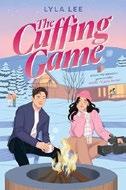
Pride and Prejudice meets reality television—but make it college and sprinkle it with the sweetness and fluff of quirky K-dramas.
Mia Yoon, a Korean American girl from Texas, arrives at film school in Los Angeles with an ambitious four-year plan—one that doesn’t include meeting her longtime crush, Noah Jang, a Korean boy she follows on social media. He’s the campus’s most eligible (and emotionally unavailable) heartthrob, and he loves challenging her in class. Rather than engaging with her feelings, Mia channels them into planning Campus Crush, a documentary that will follow students who are grappling with unrequited love. When the project faces cancellation due to lack of interest, however, she desperately pivots, changing the concept to one that Noah proposes. The Cuffing Game will be a reality dating show starring Noah himself; he’s hoping for a real connection beyond his curated online persona. Paired with Mia’s roommate, Celine Huang, he navigates the show’s scripted chaos while wrestling with his attraction for the one person who’s off-limits: the host herself. Set in a snowy lodge and
told in the leads’ alternating points of view interspersed with behind-the-scenes interviews, this rom-com explores how vulnerability and the pressure to perform shape modern relationships. Mia’s perfectionism and Noah’s emotional guardedness create compelling romantic tension, while their intellectual sparring adds depth to their chemistry. Mia’s queerness adds to the book’s thoughtful diverse representation. A clever, contemporary romance that explores authenticity in an age of endless scrutiny. (Romance. 14-18)
Liu, Corey | Little, Brown (304 pp.) | $19.99 October 14, 2025 | 9780316571845

Colin Ong doesn’t like his best friend Ren Hsu’s new boyfriend. After leaving the gay club they’ve snuck into with IDs belonging to a couple of Ren’s college student friends (fortunately the bouncer is a “White Person Who Can’t Tell Asians Apart”), Ontario high school seniors Colin and Ren get harassed by homophobic bullies while taking their usual path home. They reroute through the woods, where they encounter a demonic force that snatches Ren. Seconds later, Ren reappears, acting as though nothing happened—and soon, he seems to be dating someone new, someone not quite human, as evidenced by the disembodied voice Ren speaks to when he thinks no one’s around. Then there’s his unusual avoidance of mirrors (Colin observes, “This is noteworthy because
Explores how vulnerability and the pressure to perform shape relationships.
CUFFING GAME
Ren loves looking at himself”). Colin is determined to figure out how to save Ren from his demonic boyfriend’s grasp. Though the supporting characters are underdeveloped, by emphasizing Colin’s and Ren’s friendship, Liu refreshingly lets the boys’ platonic love eclipse romance. Portraying a boyfriend’s possessiveness as literal demonic possession highlights the important message that control is abusive and not romantic. Fannish readers will enjoy Colin and Ren’s conversations, which are peppered with geeky references. In screenwriter Liu’s debut novel, both Colin’s and Ren’s Chinese Canadian parents struggle with their sons’ sexuality. Unlike Ren’s parents, Colin’s mom takes a journey toward acceptance that includes some realistically incremental development. A deliciously creepy queer story that puts friendship first. (Horror. 14-18)
Lowham, Elizabeth | Shadow Mountain (384 pp.) | $24.99 | October 7, 2025 9781639934355 | Series: Casters & Crowns, 2
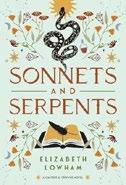
After Princess Eliza de Loegria’s father banishes the boy she loves, she runs away to find him and discovers an unlikely, lifealtering bond.
Nineteen-yearold Silas Bennett, who’s no fan of arrogant royals, has a plan: secure a professorship in Pravusat by proving his hypothesis about magic stealing and flee Loegria, where he could be killed for being an Animal Affiliate with shape-shifting magic. But the best-laid plans oft go awry, and an ill-fated bargain throws Eliza and Silas into each other’s paths. They end up bound together by gold bracelets given to them by a Stone Caster—and the only way to break the spell is to “fall madly in love” and engage in “a passionate kiss.” Can they overcome their mutual prejudices and
antagonism and weather their inner storms to get what they want—and do they even know what they truly want? This sequel to Casters and Crowns (2024) is propelled by classic genre tropes, although some of the emotional beats feel rushed. The story alternates between the leads’ third-person points of view. Eliza, plagued by self-doubt, high emotions, and action-hero impulses, is refreshingly idealistic; snarky and cynical Silas is an effective foil, although the enemies-to-lovers storyline comes across at times as forced. But the core themes—balancing love and fear, connection and betrayal, and unlearning the dehumanization of others—resonate deeply, and the storytelling is warm and sincere. Eliza has pale skin, and Silas has dark eyes and “honey-brown” skin. An enjoyable light fantasy. (map) (Fantasy. 13-18)
Martin, Tori Anne | Holiday House (336 pp.) $18.99 | October 7, 2025 | 9780823460359

In Martin’s YA debut, two teenage witches must work together despite their mutual antagonism.
Lily Allerton and Chrysanthemum Quinn can’t stand each other. Lily assumes Chrys is a bitter goth who’s trying to outdo her at every turn. Chrys, whose family struggles financially, perceives Lily to be a pampered, stuck-up princess who’s sure she’s better than everyone else. The two seniors vie annually to win the student magic fair and now they’re both striving to be class valedictorian. The girls’ annoyance bubbles over into direct action as they each use their magic to send misfortune the other’s way—until one pivotal moment of animosity unleashes something that neither one fully understands or is prepared to deal with. What’s even more horrible is that working together may be their only way to stop a curse
from threatening the entire town of Thornhaven. As they reluctantly collaborate and get to know one another, their feelings for each other begin to change into something radically different. The story is set on an island that’s been a witch enclave since the 17th century; the witches, many of whom relocate there from mundane places, live side-by-side with normies, who sense the “weirdness” that manifests subtly. The whitepresenting leads possess emotional layers that run deeper than the abundance of popular romance tropes, and while the final chapters stumble to the finish line, the atmosphere of the culminating Halloween/Samhain scene makes this a good autumnal read.
Dramatically cute.
(Fantasy romance. 14-18)
Martinez, Ruby | Knopf (416 pp.) | $19.99 September 9, 2025 | 9780593901038
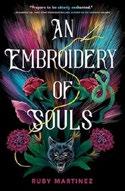
Jade Aguilar, a rich girl, and Lukas Keller, a poor boy, must team up to save their families and unmask the vicious murderer who’s indiscriminately killing Mérecal’s citizens.
As a thread speaker—someone imbued with the rare gift to “stitch love, embroider away death, and unspool memories”—17-year-old Jade must serve Queen María-Celese after her thread speaker mother disappears. Meanwhile, Lukas, who’s originally from Kabrück, a country that presents fantasy-German, lives in slums that are on the brink of revolt. As mysterious murders sweep Latine-influenced Mérecal, the two strike bargains with unpredictable rulers. The slippery queen wants Jade to examine evidence the polesa find for clues to the killer’s identity. The cutthroat Cora Ramos, who controls the city’s underworld gangs, agrees to make Lukas a serpensa—joining her crew will help him help his family—if he finds the killer, for
which he needs the help of a thread speaker. The reluctant pair must work together to overcome their mutual mistrust, embarking on an epic adventure and battling myriad enemies, including a terrifying beast and a bounty hunter. Debut author Martinez deftly explores inequality, sacrifice, and forgiveness, although the main plot is predictable and the worldbuilding is lackluster. But the heart of the story— Jade and Lukas’ budding relationship—is well developed and helps compensate for the one-dimensional characterization of the supporting cast.
Likable characters enliven a fun if formulaic fantasy. (Fantasy. 14-18)
McPherson, Stephanie Sammartino Twenty-First Century/Lerner (160 pp.) | $37.32 | November 4, 2025 9798765660454

A comprehensive and concise look at the development, influence, and future of artificial intelligence.
In an overview chapter, “The Age of Machines,” former educator McPherson sets the stage with a brief overview of AI, before moving on to “The Beginnings of Artificial Intelligence,” which focuses on military efforts during World War II. Chapter 3 introduces Timothy Berners-Lee and deep learning, and Chapter 4 opens with an engaging anecdote about Nobel Laureate Demis Hassabis, who first became interested in AI as a child who excelled at chess. Later chapters cover generative AI, algorithmic bias, accuracy and security, and AI’s potential positive and problematic effects on the job market. A later chapter points out AI’s potential environmental benefits, including through planning airline routes, managing fires, and predicting weather, and summarizes the “serious environmental downside” as complex,
noting that “Environmentalists, researchers, and many elected officials are united in their quest to develop AI systems that promote sustainable practices, minimize pollution, and halt climate change.” The author presents both the benefits and drawbacks of AI, although the problematic aspects are often framed as “concerns,” which may feel less serious than is warranted. The conclusions to the chapters use openended language that supports a positive mindset. The clear explanations, photos, color palette, and layout (which includes frequent subheadings) are well-suited to the intended audience, and informative text boxes add additional context. An information-rich, teen-friendly, and overall hopeful look at AI. (timeline, glossary, source notes, bibliography, further information, index) (Nonfiction. 12-18)
Nanua, Sarena & Sasha Nanua Holiday House (352 pp.) | $19.99 October 14, 2025 | 9780823460427

Tara Gupta was a mystery to everyone who knew her—and then, seven years ago, in 1906, she disappeared.
Now, Tara’s daughter, Sana, is turning 18. She returns from staying with relatives in Canada to the Guptas’ Parisian home, Razorthorn Manor. Expecting a simple homecoming to claim her inheritance, she instead finds herself invited to enter a high-stakes competition to determine the next heir to the manor—and to a razorthorn seed, a magical relic gifted to the Gupta family (whose “ancestral home” is in Punjab, India) by the
goddess Flora. Sana must team up with three other young people from around the world: Korean Kim Minho, Filipino American Isabelle Flores, and English Richard Fox. Together, they race to solve riddles and unravel the manor’s secrets. But for Sana, the game becomes personal. Temperamental and vulnerable, she’s still haunted by the loss of Maman. Unlocking the riddles means winning the prize and uncovering “spotty” childhood memories and the truth behind Tara’s disappearance. Set in an alternate belle epoque France where people worship Roman gods, the novel maintains a steady pace and a richly mysterious atmosphere. Razorthorn Manor, with its gothic architecture and rumored hauntings, is as much a character as the people within it. While the final reveal borders on a Scooby Doo–style confession, the journey there remains engaging and immersive. A moody tale of family secrets that stumbles at the end but will still draw in fans of dark academia. (Historical fantasy. 14-18)
Nedd, Alexis | Bloomsbury (400 pp.) | $19.99 November 11, 2025 | 9781547605057

Two esports contestants fake date to game the rankings at a competition. In this companion novel to Don’t Hate the Player (2021), autistic gamer Zora Lyon, 17, is ready to impress her idol, Brian Juno, co-founder of Wizzard Games, by dominating the company’s Summer Academy Royale. But she’s thrown off by the presence of 18-year-old Ivan Hunt, the misogynistic jerk she defeated at
A sweet summer romance that’s full of heart and hope. THE WILDEST DREAMS BOOKSHOP
regionals. Ivan is ready to rehabilitate his image after a scandal that broke up his team and destroyed his reputation last year. Each of their plans to win is shaken when they learn that streaming popularity matters more than gaming skill. Frustrated and overstimulated during a match, Zora lashes out, alienating her peers—until being mistaken for Ivan’s girlfriend wins her approval. The rivals agree to fake date to bump their rankings, but the more time she spends with her pretend boyfriend, the more confused Zora becomes about the guy she thought she hated. Told in Nedd’s witty style, this story presents lovable characters and humorous banter balanced with serious moments, such as ones exploring sexism in the online world. Gamers will appreciate the game references and well-articulated gaming culture. Unfortunately, the chaotic pacing, resulting in truncated storylines and a rushed ending, makes it difficult to stay grounded in the story or the pair’s relationship development. Zora is Black, Brian and Ivan are white, and there’s diversity among the supporting cast. A fun story with strong worldbuilding that’s debuffed by poor pacing. (Romance. 13-18)
Ogden, Heather | Morgan James YA Fiction (180 pp.) | $16.95 paper | October 7, 2025 9781636986757

As the daughter of Libertis’ leader, Angelette Arabella appears to live a privileged life, but not everything is as simple as it seems.
Angelette’s powerful father, Valerius, rules with an iron fist, and not even his own family members are safe from his cruel treatment. Valerius was always Angelette’s hero, but when her mother and brothers mysteriously disappeared right before her 10th birthday, Angelette began to question what kind of man her father truly was.
During the ensuing five years she’s spent alone with her father, Angelette has had to engage in a delicate subterfuge to convince him that she’s still the naïve, loving daughter he believes her to be. When Angelette discovers a secret magical room in her school, it’s the first step in finally finding a way to join the rebels who are working against her father. The magical elements of Ogden’s debut are disappointingly underdeveloped, a feature that goes hand in hand with the generally weak worldbuilding. Little concrete information is provided about the story’s setting, leaving readers with more questions than answers about the rules of the world. Flat characterization, stilted dialogue, and inconsistent pacing further plague the book. All main characters are cued white.
An interesting premise let down by lackluster execution. (Speculative fiction. 14-18)
Olusoga, David, Yinka Olusoga & Kemi Olusoga | Illus. by Kemi Olusoga
The Experiment (512 pp.) | $19.95 paper September 30, 2025 | 9798893030938

A comprehensive collection of historic events showcasing the experiences of Black people across time and all over the world. In this work that is organized around the months of the year, readers are immersed in grit, violence, pain, and struggle—as well as triumph. The first of the 366 entries, “January 1, 1960—The Year of Africa,” presents Ahmadou Ahidjo, the prime minister of Cameroon, who on that date declared his country’s freedom from France. The three pages for this section also briefly cover the origins and impact of the Pan-African movement. In March 1581, Yasuke, a man who’s believed to originally have come from Mozambique, traveled to Japan as the bodyguard of an Italian Jesuit missionary. His presence caused a stir,
and the warlord Oda Nobunaga took him under his wing. Yasuke became a samurai, going into battle as Nobunaga’s weapon-bearer (and later inspiring a Netflix anime series). Readers will encounter notable people, groups, and events who will be new to them, as well as more familiar names, such as George Washington Carver, Rosa Parks, Nelson Mandela, Trayvon Martin, Colin Kaepernick, Kamala Harris, and more. Placing these widely recognized figures within a global historical context makes for an enriching and enlightening reading experience. Text boxes labeled “Did You Know?” add intriguing tidbits, and black-and-white photos and illustrations break up the text. The fascinating, well written profiles will motivate many readers to explore further.
A triumphant acknowledgement of Black people’s trials and achievements. (authors’ note, timelines, glossary, quote sources, image credits, index) (Nonfiction. 14-18)
Page, Gracie | Avon A/HarperCollins (352 pp.) | $12.99 paper | November 4, 2025 9780063479012 | Series: The Wildest Dreams Bookshop, 2
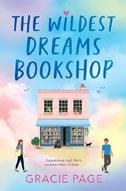
A driven 18-yearold from London spends the summer in a small Cornish village and learns that slowing down can still get her where she wants to go. Anna had it all—a prestigious law firm internship, a perfect boyfriend, Max, and plans to attend a top university in the fall. But when she freezes up during her exams, the internship falls through, and Max dumps her, despite all their carefully laid-out plans for their future, Anna’s only option is to accept her aunt’s offer of summer employment at the Wildest Dreams Bookshop. Anna travels to Fox Bay, ready to make the best of things and find her way back to her dreams. But when she arrives, she quickly gets
off on the wrong foot with Jacob, the local boy her aunt sent to collect her from the train station. At the bookstore, Anna is greeted enthusiastically by Aunt Josie and Pushkin the cat. As she gets to know the village, Anna finds a new friend in Raye, the other bookshop employee, and is charmed by the eccentric locals. Fox Bay—itself a character—brings out Anna’s best qualities, and she exhibits subtle and well-paced development. Fox Bay’s inhabitants shine as instigators of change, who help Anna on her path, and the romantic tension between Anna and Jacob crackles. Main characters read white.
A sweet, character-focused summer romance that’s full of heart and hope. (Romance. 13-18)
Poranek, A.B. | McElderry (368 pp.)
$19.99 | June 24, 2025 | 9781665936507
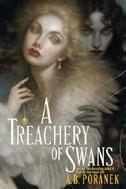
Swan Lake reimagined as a queer romance between a cunning actor and an elegant noblewoman.
Odile Regnault, who has “citrineyellow” eyes and dark hair, is an actor by trade but a spy by legacy. Her scheming father, Regnault, the renowned director of the Théâtre du Roi and a secret sorcier, sends her on missions to scam and steal from the noblesse of Verroux. Regnault’s latest plot is the most ambitious yet: steal the powerfully magical Couronne du Roi, which is hidden in the royal Château. Regnault claims he’ll use it to restore magic to their world. Restoring “the time of sorcery” would be life-changing for Odile, who was born a sorciere but is unable to access her full powers. Determined to succeed, she helps her father magically transform the refined Duchesse Marie d’Odette d’Auvigny into a swan while she assumes the duchess’ identity. Once in disguise, Odile sets her sights on seducing the Dauphin, Aimé-Victor Augier—or at
least fooling him long enough to complete her mission at the Château. But just as her plans begin to take off, the King is found murdered and the court descends into chaos. Odile must navigate complex intrigues while also grappling with her helpless attraction to the real Marie, who assumes her human form at night. There’s enough pageturning drama to propel readers to the story’s conclusion, but Poranek’s opulent prose also allows them to savor the dreamy fantasy-French setting. A lavish fantasy heist steeped in romance. (map, dramatis personae) (Fantasy. 14-18)
Ron, Mercedes | Trans. by Adrian Nathan West | Bloom Books (272 pp.) | $14.99 paper September 16, 2025 | 9781464234279 Series: Tell Me, 1
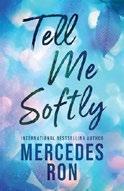
A girl’s strained relationships with two brothers causes strife in this trilogy opener by Argentinian author Ron that’s translated from Spanish. In the small American town of Carsville, Kamila Hamilton was friends with her neighbors the Di Bianco brothers. Taylor was Kami’s constant, kind companion; older brother Thiago grew increasingly antagonistic. When she was 10 and a half and he was 12, Thiago coerced Kami into her first kiss. Following the revelation of a family secret, the Di Biancos moved away, but a restraining order against Thiago led them to return to their old home after eight years without contact. But 20-year-old Thiago’s new job as assistant basketball coach at the high school where Taylor is on the team and 17-year-old Kami is a cheerleader brings the white-presenting trio into close contact, leading to tense confrontations over past events. Thiago and Kami’s interactions are marked by antagonism and lust (Thiago: “Accumulated rage, bitterness, hatred, and arousal….I could have taken her then
and there, not even thinking of the consequences”; Kami: “I felt like a small, defenseless animal being hunted by a beast”). The softer and more empathetic Taylor tries to smooth things over. Thiago’s abuse of power—he uses his role as coach to confront and bully Kami—is uncomfortable and feels like a misguided attempt by the pair to process their traumatic history, which Ron purposefully reveals, making this overall read more cringeworthy than romantic. Unexamined toxic masculinity makes this romance anything but. (Romance. 16-18)
Rutherford, Mara | Wednesday Books (368 pp.) $20 | October 21, 2025 | 9781250359889
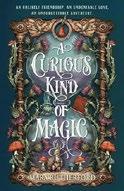
A surly shopgirl, a kindly boy, and a girl who’s struggling with a curse forge an unlikely alliance. After the death of her Da, 17-year-old Willow Stokes manages their family business, Edward Stokes’s Cabinet of Magical Curiosities, a store with precarious finances that sells purportedly magical items. When Brianna Hargrave arrives in Willow’s small village seeking a grimoire, the two, joined by Willow’s gentlehearted best friend (and possible love interest), Finlay Barrow, find themselves on a whirlwind adventure to save Willow’s shop and break Bri’s curse. Willow has a tough exterior, preferring to keep her feelings internalized, something that’s becoming increasingly difficult as she wrestles with her newfound feelings for Finlay. Bri, on the other hand, has a gentle demeanor, but she grapples with self-imposed isolation—if she touches anyone, she’ll imbue them with magic. Rutherford’s sweetly wrought fantasy is bespelling in itself, combining magic, witches, an enchanted dragon egg, a heist, and a swoonworthy friends-to-lovers romance. From a visit to a grimoire library to a tempestuous journey on the high seas, fantasy fans will find much to enjoy
here, from the popular, recognizable tropes to the themes of found family and working through grief, all presented with a dash of wish fulfillment. Willow, Brianna, and Finlay are white, and there’s some racial diversity among the supporting characters. Bewitching. (Fantasy. 13-17)
Sharpe, Tess | Marvel/Random House (320 pp.)
$18.99 | September 2, 2025 | 9781368101998
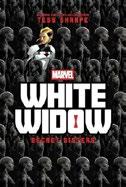
A good Widow puts “aside emotion and silly wants in pursuit of a much greater goal”— but one of the best is confronted head-on with big feelings. Headquarters has sent their best Widow-in-Training to the American Outpost to collect information on their relatively new program. Sixteen-year-old Yelena Belova has so far caused plenty of upheaval, mainly in the form of the physical damage she’s meted out to her sparring partners. Yelena thinks the girls’ training is too indulgent of emotions and should be more unforgiving and reminiscent of conditions in the field. Speaking of which, she’s keen to see some real action, and so she volunteers for a mission. The team’s objective is to destroy a “package”—but they aren’t told that they are to carry out an assassination, much less that their target is an 8-year-old girl, one who’s a “perfect replica” of Yelena at that age. Stunned and acting on instinct, Yelena escapes with the girl, whose name is Leni. Her new mission becomes protecting the emotionally expressive Leni and uncovering the bizarre conspiracy she’s stumbled into. This book is both an exciting chronicle that will please fans of the Marvel Comics and Marvel Cinematic Universe character and a fun spy thriller that’s accessible to readers who are unfamiliar with her story. Alongside the sassy banter and hardcore fight scenes,
the story meaningfully focuses on sisterhood and the power of emotional perceptiveness. The Marvel canon established Yelena as Russian. A gripping read with broad appeal. (Thriller. 14-18)
Smith, Lyssa Mia | Storytide/HarperCollins (384 pp.) | $19.99 | November 4, 2025
9780063239623

After a brutal public betrayal, an 18-year-old girl with magical powers seeks revenge on her former best friend. In late-19thcentury New York City, Emmy Vallillo doesn’t have much, but she has her father, her dressmaker best friend, Grace Montgomery, and her magic— turning ordinary metals into gold. When the Society of the Charmed, a wealthy, secret group of magical people, invites Emmy and Grace to a debutante ball, Emmy thinks she’s made it: She’s found a way to study and grow her magic openly. Until, that is, she performs for the Society. Fool’s gold falls from her dress—a dress Grace gave her—and she’s accused of being a fraud. Suddenly, her powers are suppressed, she’s imprisoned, and her father is killed. Two years later, Emmy escapes, thanks to a fellow prisoner, wealthy Jack Fontaine, who was born into the Society. Like her, he has a score to settle with them: the death of his entire family. Jack needs Emmy’s magic, just as she needs his connections. Their hesitant alliance soon blooms into a complex relationship marked by love, fear, and desire. Smith effectively weaves in themes of friendship, loyalty, fate, and family. Jack and Emmy, who are cued white, are beautifully drawn characters, who show strength and love in their actions, even those driven by darker emotions. Minor characters play a significant role in bringing out the
pair’s best, helping to create a world readers will want to revisit.
An exciting, emotional, twist-filled page-turner. (Fantasy. 14-18)
Wang, Rona | Simon & Schuster (320 pp.) | $19.99 | November 11, 2025 9781534488519

To escape her small town and attend a prestigious summer tech program, a Chinese American teen switches coasts.
In Chinook Shore, Oregon, Charise Tang’s life is at a standstill. Her stepfather has taken her savings, her white sort-of boyfriend persists in making microaggressive comments, and even Zach Torres, the valedictorian who escaped the town and its limited opportunities, has returned, on academic probation from Vanderbilt. After being accepted into an all-expensespaid summer program at MIT for “the next generation of tech leaders,” Char tries to leave without telling her family. When she’s caught, her stepfather, a white Iraq War veteran, declares that she’s never allowed to return. In Cambridge, she has a quintessential meet-cute involving spilled coffee with Khoi Astor, a Vietnamese American boy who happens to be in the same program. Khoi and Char team up for the program’s hackathon, both hoping that the prize will provide Char with the financial safety net she desperately needs. Despite the sweet blossoming romance, the couple’s dynamic often feels imbalanced: Khoi feels overly perfect, while Char’s acerbic and bitter tone can become tiring. Khoi’s epilepsy mostly serves as a plot device. However, through Char’s Chinese immigrant mother and Khoi’s Vietnamese parents (one a refugee and one a transracial adoptee) the narrative effectively conveys the isolation experienced by many immigrants. A potentially STEAM-y romance, but the code could use some debugging. (Romance. 13-18)
KIDS ARE NATURAL explorers, so it’s no wonder that so many children’s books take place outside, where one can observe animals of all kinds, living their lives in their own habitats. Many young readers don’t live near a wilderness area, so illustrated poetry books can meet them where they are while also offering a window onto the natural world. Here are three fine works of children’s literature, all recommended by Kirkus Indie, that ably combine verse and fullcolor imagery to tell charming tales of creatures great and small:
In The 20 Little Poems for 20 Little Gnomes , author Raven Howell offers several lovely, relatable verses in which nature, and its wild residents, add beauty to the narrators’ lives. In “Red Robin’s Gift,” for instance, the speaker— pictured as a happy, raincoated youngster in Nazli Tarcan’s lively, rustic illustration—tells the titular bird, “you’re so kind / to leave for me a bit of you” in a birdhouse:
“You’re welcome here at any time— / thank you for the feather!” “The Cone Flower” presents a vivid sketch of bees: “Cones draw drones, / bees hone honey, / nectar nuggets / sweet and sunny.” Other poems mention housecats, bears, and even book-reading mice, and nearly all espouse the wonders of simple, outdoor delights, such as picking berries or catching a snowflake on one’s tongue. Our reviewer highlights the “rhythm, rhyme, and warm emotions” of this notable book.
S.J. Russell’s series starter, To Snail or Not To Snail , presents a casual conversation in verse between a snail and a bee, in which they discuss what they do to help the earth, such as enriching soil or pollinating plants (“How would fruits and flowers re-create,” asks the bee, “if I weren’t there to pollinate?”). All the while, the realistically depicted creatures move through bright nature scenes (captured by artist Kaity Lacy in rich images employing pen-and-ink, watercolors, and pastels).




Other animals go about their business along the way, including a frog, a hummingbird, a squirrel, and a comparatively giant deer. “Fabulous Facts” at the book’s end will encourage youngsters to find out more. It’s “a lovely, enlightening tale about how unique roles make ecosystems—and communities—work,” according to Kirkus’ starred review. (A follow-up, To Bird or Not To Bird , depicts a similar conversation between a red-winged blackbird and an earthworm; it also received a Kirkus star.)
Night Critters Play, by Essaboe Kwami Nyamidie, presents a simple poem about creatures who only come out when it’s dark— either to make noise, in the case of owls, frogs, and
crickets, or simply to be out in the world without fear of harm, like armadillos, hedgehogs, and porcupines. As morning approaches, the various animals all head back to their homes. Our review highlights one of Nyamidie’s more lyrical passages (“The Milky Way loses all her freckles. / The drowsy leopard stretches her speckles”), as well as Pamela B. Christiansen’s “gorgeously layered” imagery; one painterly illustration of an owl and the Milky Way, our reviewer notes, “could easily be a framed print.” Overall, it’s “visually appealing work that lap readers will want to look at again and again.”
David Rapp is the senior Indie editor.
Johnson’s collection of short stories centers around Black voices and experiences. While much recent literature has sought to prioritize diversity, highlighting more Black voices in the American story, the “Black experience” is often relegated to specific segments of history and culture. In his collection of short stories, Johnson addresses this unfortunate tendency, exploring the Black experience against the backdrop of over a century of American life, starting with the Reconstruction and leading all the way up to the turn of the 21st century. His stories capture a multitude of communities and individual perspectives, from largely Black church communities (as in “Vicarage” and “The Wages of Sin”) and segregated schools (featured in “Waddellee” and “Angeline
Smith Was Retiring”) to the star-crossed love of a wouldbe interracial couple in 1960s Vermont (“Summer’s End”) and the misadventures of interracial friends (“The Doughnuts”) to worlds in which race is indeterminate. Each piece captures human vicissitudes in a uniquely microcosmic way. The narratives are fluid, traversing time and space; however, they are all uniquely American, encouraging readers to think about the essential themes of American literature in the context of racially marginalized groups. Each character is larger than life and very much a product of their environment while maintaining universal appeal (“Unlike the church ladies, Cora and Martha gladly profiteered in illegal business: they played

Johnson, Thomas Penn | Atmosphere Press
200 pp. | $24.99 | $15.99 paper | August 1, 2025 9798891327559 | 9798891327191 paper
the numbers, and the 700 block of Sevier Street was the only block in their Alcohol Beverage Control town where two rival neighborhood bootleggers peacefully lived and practiced business next door to each other”). At times, the author plays with form, creating cinematic depth with italicized dialogue that elicits feelings of disconnection and memory,
or constructing cyclical plotlines that create a sense of everyday surrealism. The result is a collection of memorable stories that tackle questions of identity, faith, community, and injustice. A literary masterpiece from start to finish, this collection is a must-read.
A captivating body of stories spanning much of American history.
Alexander, Melissa C. | SmallPub (336 pp.)
$15.99 paper | March 15, 2025
9798991204804

A commitment to train a broken dog reunites a mourning family in Alexander’s novel. When Charm Freeman flees the small town of Collier, Mississippi, at 16, he never intends to return. But 18 years later, the death of his brother-in-law, Jake Gibson, who was killed in a car accident, calls him back home to help his sister, Elle, and his young nephew, Lucas, who was hurt in the crash. It turns out, Elle is struggling to manage the family’s farm and care for her injured son in the wake of her grief, and Lucas is desperately holding onto the only thing keeping him afloat: a curly-coated retriever named River that he and his dad were training to compete in a field trial. Against Elle’s wishes, Charm decides to stay for six months to help Lucas train River. After all, Jake was Charm’s best friend and the one who got him out of town all those years ago, and Charm owes it to him—even if everyone considers River’s training a fool’s mission. What follows is a heartfelt, well-paced journey as each character deals with their loss: Lucas, who believes everything will be OK again if River, who is also suffering from trauma, wins the trial; Elle, who’s dealing with her anger after finding out Jake left them in debt and trying to stay strong for her son; and Charm, who’s realizing he might be more like his drunk father than he wants to admit. Alexander ably captures a claustrophobic small town, from everyone knowing one another to a productive rumor mill
(“I heard you totaled your sister’s truck and half killed your nephew,” one of the locals says after Charm drives into a small ditch). There’s often a lot happening at once, but it never feels too overwhelming or morose in its exploration of grief.
A moving, well-rounded tale about surviving tragedy.
Artwohl, Robert | FarView Press (462 pp.)
$17.99 paper | July 24, 2025 | 9798992675115
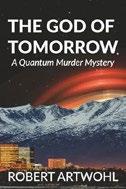
A widowed police detective investigates a string of murders in this thriller that explores quantum physics. Eddie Vaugner is a homicide detective and amputee who moves with crutches when he isn’t wearing his state-of-theart, below-the-knee prosthesis. He lives and works in Anchorage, Alaska, with his mother, who has moved in to help him care for his 11-year-old son, who had leukemia but is now in remission. Eddie is assigned to the murder depicted in the opening chapter, a scene that hints at the metaphysical layers of the writing to come as the slain priest is sent “down a dark vortex at impossible speed,” arriving before a mythical beast who rips him in half. The killer is Dr. Grayson Lange, a highly skilled surgeon who slips away undetected. Artwohl follows both characters in parallel tracks—the detective and the killer he’s trying to find—while slowly broadening the players who surround them. Eddie’s son is gifted and, since his initial bout with leukemia, increasingly drawn to
questions about God and the meaning of life, including a preoccupation with quantum entanglement—how molecules are linked in ways that defy people’s everyday understanding of space and time. Eddie himself is increasingly drawn to the new medical examiner, Rebecca Raven, and their relationship develops as they continue to work on the case. This initial murder investigation is complicated by another high-profile homicide: the assassination of Dr. Jack Peplow, a scholar meant to deliver a speech about the separation of church and state. Peplow was killed, according to his family, by a fanatical religious organization trying to rewrite the Constitution “to make the United States the mecca of modern Protestant Christianity.” The two cases and the parallel storylines begin to converge in a fast-paced final third. Although the story builds momentum toward its thrilling finale, there are several subplots that take a while to fully develop or seem extraneous, like Becca’s stalking ex-boyfriend. In creating multiple characters given to info-dumping—Becca, Lange, and Eddie’s son are all extraordinarily smart—the novel is often riddled with streams of specifics like “Palladium’s 4d orbitals overlap and interact with gold’s 5d orbitals, creating hybrid molecular orbitals. This hybridization increases the energy gap between gold’s 5d and 6s orbitals.” This extends to the prose itself, which is often fleet when not similarly describing exact details, like Lange’s expert climbing: “Using Black Diamond Turbo Express ice screws, he created two eight-inchdeep ice holes about a foot apart, oriented at 45-degree angles to each other, creating a V-shaped vertical passage.” Artwohl’s take on modern megachurches is satirical yet somewhat chilling, as in his scene at the American Salvation megachurch. That house of worship uses generative artificial intelligence to present the Founding Fathers calling out the “liberal atheists” who try to impose the separation of church and state in modern America. If the mixture of police procedural, thriller, and questions about the nature of God and the physics that govern
Earth does not always cohere, it is still a worthwhile ride.
A gripping crime story filled with complex ideas and sharp characters.
Bannick, Paul | Mountaineers Books (224 pp.) $39.95 | September 1, 2025 | 9781680513165

Bannick details 41 different species of woodpeckers across 11 genera in this nonfiction work.
The author became enthralled with woodpeckers at the tender age of 8 or 9 after spying one through his kitchen window; it’s a good bet that readers will grow equally enamored with the intriguing little creatures as well. That’s due to both Bannick’s encyclopedic knowledge of the birds and the often-lyrical prose he uses to describe them. “As the first golden rays of light splintered through bundles of needles on giant red-armored ponderosa pines in Washington’s Cascade Range, I began to hear a cacophonous mixture of shrieks, mewing, churrs, rattles, warbles, cackles, and chipping blended with loud, rhythmic drumming of various cadences and amplitudes,” he writes. The effect of such language is infectious and enough to send one off on a scouting expedition to see what might be uncovered in one’s own backyard. Woodpeckers can be found performing their indispensable handiwork from the Caribbean all the way to the Arctic; the author sets his sights on those living in North America over the course of a year. He calls them “tree doctor[s],” explaining that the birds are beneficial to humans as they control pests and shield trees from destructive budworms and the like. Woodpeckers also create and improve habitats by making sap available to migrating animals, dispersing seeds, and cultivating the soil with the wood chips they produce by hammering their impressive bills into
hard tree bark. How do they do this and avoid causing severe harm to themselves? Bannick has the detailed answer to that question, as well as a treasure-trove of many others. The text is fascinating and a delight to read, supplemented by a generous amount of stunning close-up full-color photography by the author. Sadly, some of these marvelous birds are in trouble due to a variety of factors ranging from excessive timber harvesting to climate change— the author hopes that a greater appreciation for woodpeckers and an increased awareness about the perils they face will spur humans to come to their aid.
Wholly absorbing—a sure-fire way to turn even a casual birder into a woodpecker fanatic.
Berg, Mitchell | Synthetic Prophetic (296 pp.) $18.95 paper | September 15, 2024 9798985609110
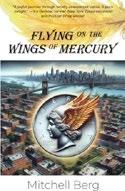
Spare change makes magic for an aspiring author in Berg’s novel. Struggling writer Zach Howard, living in a studio apartment in Astoria, New York (“Reality set in a few years after graduation when my most recent publication attempt was critiqued with similar sentiments to those of my 56 prior rejections”), discovers an old Mercury dime while sorting through his loose coins. Zach starts experiencing strange phenomena: After he places the coin on his laptop each night, the next morning he discovers fully written stories, with no memory of creating them. The dime has passed through the hands of people from different time periods and locations—traveling from a Chicago gangster in the 1920s to a Depression-era baseball enthusiast to an Italian immigrant in Philadelphia—before ending up with Zach. The coin acts as a literary time machine, transporting
Zach as he reads stories that blend historical details with emotional impact and strong narrative drive. The characters Berg creates are steeped in authenticity and feel genuine and vivid. They include the powerful yet vulnerable mob enforcer Charlie LiPari; young Billy Barrow, who dreams about playing for the Chicago Cubs; and the Algieri family, Italian immigrants hoping to build a future in America. The vignettes present both poignant moments and humorous elements that portray basic human experiences, including moments of ambition, loss, and quiet heroism. The narrative voice is captivating; the straightforward prose deftly shifts between chronicling Zach’s contemporary musings and the dime’s historical progression. The author balances the magical elements with genuine emotions, particularly when it comes to Zach’s feelings for Julie, his romantic interest. The novel is ultimately a tribute to narrative storytelling, meaningful small objects, and relationships that link people across time. This is an endearing work that will encourage readers to investigate the stories hidden within their own personal possessions. They’ll never look at a pocket full of change quite the same way again. An imaginative and touching exploration of history, memory, and the mysterious ways in which stories find us.
Carlton, J.A. | Self (228 pp.) | $12.99 paper July 6, 2023 | 9798338496428
Series: Heroes of the Line, 1

Two young brothers square off against predators both human and unearthly in Carlton’s supernatural thrillerseries starter. Ten-year-old Nick Emerson and his 5-year-old brother, Frank, feel like it’s them against the world. Dick Pickerd, their mother Lisa’s boyfriend and boss, regularly molests Nick, who
vows never to allow Frank to be victimized. Frank, meanwhile, is harassed by bullies who like to toss him in the school dumpster. The boys are also beset by “schades”: ghastly, pale beings who skulk in shadows, shriek at light, and sometimes attack; two years ago, Nick and Frank saw their dad, Nick Sr., get killed by one of them. Things look up when school janitor Harry Armstrong gives Nick a pendant watch that catalyzes his ability to stop time for several minutes—which he uses to defeat Frank’s bullies—and a doctor and Lisa spot the sexual abuse and have Pickerd arrested. Nick and Frank reconnect with Nana Emerson and Uncle Howie, who reveal that people with the Emerson bloodline have used paranormal powers in a 5,000year war against the schades, and they also help Nick develop his time-stopping ability and assist Frank with his burgeoning telepathic talent. Then Pickerd gets out of jail and aims to abduct the two brothers, closing in on them with the help of schades. This first book in Carlton’s Heroes of the Line series features monsters of several kinds, grounded in a compelling portrait of an abused child trying desperately to avoid his tormentor; Nick also has a psychic premonition that Lisa will die if she learns about the molestation. Carlton’s prose is eerie and atmospheric, with the schades a pervasive, macabre presence that heightens the boys’ panic and despair: “He dared a peek into the dim light just in time to see the gray peeling face fade back into shadows. It raised its dusty looking hand and waggled its fingers at him, but it was the sinister smile still hovering in the air while the rest of it disappeared that left him with shivers on the inside.” The result is an imaginative page-turner in which magic augments a tense psychological drama. A frightening fantasy tale that mixes cosmic dangers with domestic terror.
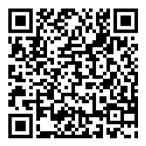
Carmicle, J.D. | Demon Mythos (337 pp.) $13.99 paper | July 1, 2025 | 9798992828504

A mysterious event turns much of the population into bloodthirsty monstrosities in Carmicle’s debut horror novel.
Attorney Jacob Freeman, his doctor wife, Rebecca, and their 10-year-old daughter, Micah, find their lives turned upside down when the world seems to go insane overnight. As their neighbors—some transformed into nightmarish creatures—murder each other outside their front door, Jacob feels himself fighting the growing “Darkness” within him as horns begin sprouting from his skull. After getting control of the evil thoughts plaguing him, he and his wife decide to take their daughter and leave their devastated neighborhood in search of other possible survivors. After meeting Judith, a seductive young woman who now has a tail (and some seemingly supernatural abilities), Jacob resolves to manipulate her into joining their group—though his very upset wife disagrees with the decision. The group of four begins “a voyage of discovery, a post-apocalyptic Lewis and Clark charting civilization’s ruins.” Along the way, they meet numerous horrific characters (including the Ghoul and the Pale Gentleman)—some of whom offer to help the travelers while others plot to kill them. Further complicating matters is the intense love/hate relationship between Jacob and Rebecca, and the transformation of Micah, who begins growing wings and becomes the target of a faction of “crazies.” A travelogue through Middle America that is fittingly described as a “carnival of horror,” the unapologetically violent novel does have minor issues: The pacing and intensity lag in places, and the concluding chapters seem inexplicably rushed and disjointed. But the laser-focused worldbuilding, excellent character development, and dynamics between the characters (particularly Jacob, Rebecca, and Micah) more than make up for these
shortcomings. The many unresolved plot threads at novel’s end create a solid (albeit not exactly satisfying) foundation for potential sequels.
A gruesome, compelling fusion of post-apocalyptic fiction and supernatural horror.
Chohan, Satish | BookBaby (300 pp.)
$27.99 | July 18, 2025 | 9798317805258

Political analyst Chohan cautions readers about the rise of antidemocratic sentiments in this nonfiction book.
According to the author, right-wing forces in the United States are cloaked in “campaign slogans, flag pins, and policy proposals wrapped in red, white, and blue.” However, although these popular symbols evoke ideals of American freedom and national pride, he says, modern conservatives are secretly committed to “shaping America to serve a concentrated few while convincing the public it’s for everyone.” Chohan begins his analysis with the well-known Powell memorandum of 1971. This missive, drafted by then-future U.S. Supreme Court Justice Lewis Powell, offered conservative think tanks and lobbyists a blueprint for rolling back decades of liberal reforms enacted by New Deal and Great Society legislation. According to Chohan’s cogent analysis, conservative operatives followed Powell’s guidance over the past half-century and systematically employed lobbyist groups, such as the Heritage Foundation and the Federalist Society, to influence politicians. They’ve also created an entire media industry, he says, which feeds Americans a constant stream of disinformation. Overall, Chohan’s work effectively makes a case that economic and political power is wielded by a select few by covering topics such as voter suppression, conservative saturation of the federal judicial system, and rollbacks of educational freedom, reproductive rights,
and regulatory restraints on big business. Although the book is almost dystopian in its assessment of contemporary America—particularly since the reelection of President Donald Trump—its final chapter sees hope in a rising resistance movement, and it calls for readers to “flip the script” with mass mobilization. Although the volume is polemic in its writing style, it’s backed by solid research from reputable academic and journalistic sources and concludes each chapter with helpful reference endnotes. In just over 200 pages, it carefully balances sound research and detailed coverage of contemporary conservativism in efficient, concise prose, replete with accessible, bullet-pointed lists. Its acerbic manner may alienate some conservatives, but its abundance of research will allow readers to come to their own conclusions.
A dark but substantive examination of the state of American politics.
Kirkus Star
Hindsight
County, W.D. | Self (270 pp.) | $12.99 paper June 5, 2025 | 9798284790700

A detective with extra sensory perception teams up with a psychic to solve a gruesome murder in this genrebending thriller. In County’s (Plastic Soldiers, 2020, etc.) suspenseful supernatural crime story, Nathan Ember finds out there are pros and cons to being hit by lightning: For one, he has the ability to see clearly into the recent past. His “gift” doesn’t give him “X-ray vision or super hearing. It’s more like two movies of the same place, superimposed and twenty-four hours apart.” This kind of “double” vision cost him his job as an air traffic controller, but it allows him to eke out a living as a budding detective. When he hears that a body was pitched into a dumpster and set on fire the night before, he revisits the past scene and sees a headless, handless body being discarded
and torched by a man with a maniacal laugh. He also sees the number of the man’s license plate, which he gives to a friend, Detective Sgt. Daniel Ballinger. But Nathan learns that psychic Galena Torres, who has hypnotic brown eyes and “grab-me curves,” had already given Ballinger the same intel. Initially, Nathan has a hard time believing Galena’s powers are real; but once he’s convinced they’re genuine, the two team up to find out who the dead man is and who murdered him. The novel’s crime-solving is engaging, and the progression of Nathan and Galena’s relationship is engaging, but the real treat is the author’s clever blending of past and present. Nathan must try to avoid being in the same place at the same time two days in a row so he won’t be confused when his two selves overlap and his senses become overwhelmed. Overall, the pacing is rapid-fire and the narrative jam-packed with surprises. Other bonuses include a rich mix of ethnicities and ages, plus a really creepy killer. Dialogue is sharp, and even biting when Galena meets Nathan’s tall, blond, bejeweled former wife Anita, who “has a thing about money. It’s called greed.”
An imaginative and offbeat blend of psychological intrigue, murder, and romance.
Daniels, Andrew | Lulu.com (114 pp.) | $25.70 paper | February 15, 2025 | 9781300569077

Daniels offers a poetry collection that celebrates the freedom and surprise of contemporary verse. The author, a poet and songwriter, presents a vibrant collection
of works that blend theatrical sincerity, wit, whimsy, and introspection. Rather than follow a single theme or traditional structure, the anthology embraces variety, both in content and in form, offering readers a dynamic reading experience that feels honest and unrestrained. From start to finish, the collection celebrates freeform line breaks, stanza placement, and visual spacing that lend each page a unique rhythm. Many lean into abstraction, while others reflect on urgency, action, and the unpredictability of life. Pieces such as “Push, Push, Push!” will inspire introspection (“Life is a long game of pushing back”) and others, such as “A Recipe for Disaster,” are tongue-in-cheek, with veiled calls to consider where society stands: “Ask yourself one question, are you a recipe for a reason, / a recipe for love, or a recipe for disaster? / If you are either of the first two, share that recipe with the world! / But if you’re a recipe for disaster, just keep those ingredients and instructions to yourself.” These timely poems are balanced well with works such as “The Pink Pearl,” which provides a dose of lighthearted encouragement. The collection avoids traditional thematic cohesion, which is a strength as Daniels invites readers to approach the poems intuitively, in no particular order. Several pieces evoke a knowing smile with clever phrasing or offbeat perspective. Adding to the richness of the reading experience is a diverse set of illustrations by various contributing artists, including Jenya Hitz and Jassed Jae Baldemor. These varied visual elements are full of movement and complement the text without overpowering it, creating a dialogue between poem and image that further draws the reader in. Overall, this is a collection best kept on a bedside table, where it can be picked up often and read in small, meaningful doses.
A thoughtful, well-crafted blend of clarity and creativity.
Dennstedt, Joel R. | Self (334 pp.) | $39.99 paper | August 10, 2025 | 9798285935308

In Dennstedt’s SF novel, an extraterrestrial robot is tasked with monitoring humanity’s painful ascent back to civilization after a devastating global war.
A worldwide war reduces humankind to stone-age savages ignorant of their high-tech glorious past. A concerned alien civilization, unable to directly intervene due to environmental issues, dispatches the narrator to the benighted planet; he’s a durable humanoid robot capable of self-repair and camouflage to blend with Homo sapiens. His mission is to spend millennia gently guiding the human race back to enlightenment and responsible function. The robot has a hummingbird-shaped scout drone called Billy who flits in out of the storyline, sometimes fatefully. The robot is a Wandering Jew-meets-Candide type figure who acquires assorted nicknames over the centuries but ultimately settles on “Scoots,” shortened to “Scot.” With new exploratory information periodically uploaded from Billy, Scot befriends a series of people, from children to a fairly enlightened monarch to a sailing-ship’s crew to a leper colony’s matriarch to a slum lord. Scot innocently strives to set sensible and ethical examples, but human aggression and perfidy often subvert the guileless hero’s motives. His mass-produced toys inspire the coinage of money and commensurate greed; marketplace pressures turn his repair shop into a gun factory; and his superspeed with firearms gets him conscripted into strongman/enforcer duties. Even after humanity evolves to build idyllic cities, will the Earthlings just blow everything up again?
Dennstedt supplements his novel I, Robot Soldier (2024) with this robo-yarn, which is only tenuously
A strong debut that feels timely despite looking back at a bygone era.
connected and can be read as a standalone. The episodic narrative owes debts, acknowledged up front, to SF grandmasters Isaac Asimov (whose Three Laws of Robotics come into play) and Robert Heinlein (Scot is the proverbial and eternal stranger in a strange land). The parable-like storytelling eschews hard science and works in a moderate amount of sardonic humor (“You know, Scot, if you plan on encouraging the human race, you probably should work on your people skills a little more”) as Scot violates a few prime directives to realize his goal. Illustrations by the author are generated via AI.
A loosely plotted, seriocomic pageant of humanity’s failures and foibles from a sympathetic robot POV.
Ende, Jean | Apprentice House (368 pp.)
$24.99 paper | April 1, 2025
9781627205580
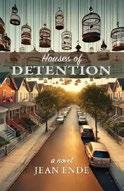
A family of Jewish immigrants struggles with the strict social and religious mores of 1950s America in Ende’s novel.
The Rosen family resides in their improvised 20th-century shtetl in New York City, a sort of mini-village in which all the members of the extended family live within shouting distance of one another. The family is organized around three sisters—Elaine, Rachel, and Helen—all of whom have young children who are close cousins. Though the family is secure, Elaine is terminally ill, and not long into the story she dies, leaving her daughter, Rebecca, and her son, Marvin, in the care of their pious, overly strict
father, Harvey. Racked with grief and traumatized by a nightmarish childhood lived in the murderous shadow of the Nazis, Harvey is ill-equipped to raise the children on his own. The summer Rebecca is 14 years old, the entire family (minus Harvey and the other men, except for weekends) spends the season together at a house in Atlantic City, New Jersey. There, Rebecca—physically mature for her age and newly rebellious—is caught in a compromising position with a young man. Afraid of Harvey’s wrath, the aunts conspire to downplay the incident, but Harvey sees right through their efforts, and Rebecca and Marvin are left to absorb his rage and grief, which sets the stage for Rebecca’s eventual flight and “descent” into a sort of promiscuity deemed unacceptable by her conservative father and society. Ende’s novel is expertly crafted from the start—readers will quickly feel immersed in the small (yet also vast and complex) world in which the Rosens operate. The passages describing midcentury New York and Atlantic City ring with the lived experience of teenage years spent on the boardwalk: “The moving spotlight on top of the Ocean Avenue Wonder Wheel traced a path from the roof of the arcade to its base, briefly illuminating the wall against which Sal and Rebecca had decided to take their romance to the next level.” Drawn with no small measure of compassion, the realistically flawed members of the Rosen family are sure to stick with readers long after the last page. A strong debut that feels timely despite looking back at a bygone era.

For more Indie content, visit Kirkus online.
Kirkus Star
Rook’s Gambit
Fraedrich, Dana | Goat Song Publishing (393 pp.) | $15.99 paper | June 17, 2025 9798987843611

A teenager whose newfound inheritance puts a target on his back decides to join forces with a ragtag group of thieves to help pull off the ultimate heist in Fraedrich’s YA fantasy thriller. In the fantastical realm of Springhaven, 14-year-old Varick Pendragon is adrift. His beloved grandfather has just died, and the teenager has inherited his entire fortune—much to the ire of Varick’s ruthless and conniving family. Varick’s life takes a startling turn when he catches a young thief named Coal stealing his sister’s jewelry and the two become unlikely friends. Coal introduces Varick to his band of fellow rascals, including Mercury (the charismatic leader) and Carver (whose ability to mimic voices is unparalleled). The group reveals their plans to steal the coveted Nightfall Crown, which will be on a luxury airship for an upcoming cruise— they need Varick to purchase the tickets and smuggle them onboard. Wanting to help the thieves build better lives for themselves, Varick agrees to the wild plan. But soon enough, everything begins to unravel: A brutal fight with Varick’s older brother threatens their scheme; a secret plot to undermine Varick’s wealth is underway; and a stunning last-minute betrayal leaves him questioning everything…and everyone. Fraedrich crafts an imaginative yet grounded world in which Varick struggles just as much with his toxic family as he does with pulling off the crown heist. The conferring of deeply humanizing characteristics—not just upon Varick, but on his merry band of thieves, as well—makes for a rich and rewarding read. The action (sometimes accompanied by a touch of magic) is frequent and exciting: “Well over an hour later, as the wee hours of the morning
drew into their weest, Varick wondered if he might still be dreaming. They’d traveled via rooftop as much as possible, and he’d been glad to get some more practice roof-running.” Ideal for both YA and adult readers, the novel effortlessly weaves together themes of friendship, generational trauma, and the value of staying true to oneself.
A rollicking steampunk adventure that expertly blends action and magic into a fantastical heist for the ages.
Garg, Ekta R. | Atmosphere Press (97 pp.) | $12.95 paper | August 12, 2025
9798891327405

Garg imagines the in-between moments of Western culture’s most famous fairy tales and nursery rhymes— as well as the characters’ backstories in this short story collection.
Each chapter presents a question, followed by the “answer” in the form of a unique narrative. The opening query, for example, concerns The Wizard of Oz: “When the tornado took Dorothy’s house to Oz, it landed on the Wicked Witch of the East and killed the witch instantly. What was the witch doing in the road in the first place?” The answer, it turns out, involves an argument with her apprentice. Garg explores a handful of tales, including the motivations behind duping the naked emperor (in “The Honor of Emperors and Thieves”) and the reason why Jack (of Jack and Jill fame) was carrying that pail of water in the first place (in “To Fetch a Pail of Water”). Each story varies in length; the haunting “Denying Hamelin” is only three pages, and the longest, “The Beauty Before She Sleeps,” is 33. While none of the stories can be called happy, some are particularly grim in nature—parents left bereft at the disappearance of their children, death, betrayal, etc. Each story gets its own question and answer except for “Sleeping
Beauty”and “Goldilocks and the Three Bears,” whose questions and answers combine in what feels like a fever dream involving shapeshifting witches and magic portals. While some stories veer toward the predictable (the real identity of Sleeping Beauty’s new lady in waiting, for example, will likely prove glaringly obvious to readers), these tales aren’t necessarily about changing the narrative of the established story from which they come. Instead, Garg adds depth and background to these familiar characters, making them delightfully all her own. An imaginative, thought-provoking compilation that playfully—and sometimes morbidly—riffs on the classics.
Golshevsky, Daniel | Illus. by Cora Muccitelli | Hardie Grant Books (224 pp.) $19.99 paper | September 2, 2025 9781761212888

Golshevsky, a Melbourne, Australia-based pediatrician, provides a positive parenting guide for parents of newborns. It’s a common feeling among new mothers and fathers to wish for an instruction manual—something to assuage the overwhelming feeling that one doesn’t have the training to take care of an infant. They often wonder how to cope with the many demands of parenthood; however, this book provides such readers with a supportive, uplifting, and rich foundation. Golshevsky, aka “Dr. Golly,” offers his expertise as an accomplished physician and father of three with advice that’s practical and nonjudgmental. For example, as he delves into the facts and how-tos of breastfeeding, swaddling, colic, and helping babies pass gas, among other issues, he also notes there is no one right way to take care of a child—and he emphasizes figuring out “the solution that’s right for
your baby and right for your parenting style.” He also places a high value on parental well-being: “The newborn period is not just about feeding, clothing and protecting the child—it’s also about protecting the parents.” This is where Golshevsky’s work differs from some other, similar guides, as he touts a well-rounded approach that cares for the parents as much as the newborn. Furthermore, he uses language that effectively highlights families’ diversity: “Babies arrive into families of all different shapes and sizes. From couples to single parents, blended families, adoptive parents and more.” Supporters outside the family unit also play a vital role in one’s health and well-being, he points out, and he provides sections on the power of such care partners, instructions for visiting the baby of new parents, what to buy a new family, and, specifically, how to encourage a new mother’s well-being. Muccitelli’s bright and colorful comic-style illustrations reinforce the text’s overall tone of warmth and make it even easier to readily find answers to specific questions. A fine addition to new parents’ shelves.
Harrigan, V.M. | December 1, 2025

A Cuban orphan is mentored by a benevolent space-and-timetravelling robot to oppose an invasion of Earth by ravenous, monstrous entities in Harrigan’s SF novel. Portals (or “doorways”) are appearing on Earth. On the other side of some of them await fiendishly hungry, shape-shifting horrors that possess cunning and intelligence, making them an extinction-level threat (“They always look like things we fear, predatory archetypes like reptiles, spiders, and others, but twisted, misshapen. They are also big, very strong, and hard to kill”). Tom Lafitte (taking his surname from the legendary pirate-hero of
New Orleans, Jean Lafitte) is a Cuban native, introduced as a terrified orphan fleeing a 1909 campaign against nonwhites in the island’s hinterlands. He finds a surprising guardian and mentor in “Pan,” a cloaked figure ultimately revealed to be a personable humanoid robot. Pan, with infinite patience, tutors the peasant lad in science fundamentals and the network of enigmatic doorways, several of which he is tasked to close with early versions of EMP bombs. An increasingly careworn and battle-scarred Tom returns to the central story thread at intervals; other chapters follow the travails of additional survivors, automatons who outlast the human race, and even the monsters themselves. The nontraditional narrative skips over a great deal of scientific exposition (and millennia of evolution) and get straight to business, some of which is very violent and gruesome (in the “splatterpunk” mode). There are also flirtations with Lovecraftian demon-worship, Voudon/Santeria spirituality, and the meaning of sentience (or, for that matter, existence), alongside cameo appearances by two children’s-book favorites, The Velveteen Rabbit and The Wind in the Willows. If those sound like curious ingredients for a bloodthirsty SF/ horror story gumbo…they are, but they constitute a novel diversion for genre readers looking for something a bit outside the usual “weird tales” fare that still delivers the requisite claws, fangs, and tentacles. An eccentric alien-invasion yarn of unusual scope and ambition.
Huyler, Stephen P. | Pippa Rann Books (408 pp.) | $49.99 | August 26, 2025 9781913738211

Art historian and author Huyler offers an account of his many decades of traveling and learning in India. The author first went to South Asia in 1971, and in the half-century since then, he’s explored India “by rickshaw, bicycle, camel, bullock cart, horse-drawn buggy,
elephant, tuk-tuk, scooter, motorcycle, car, bus, plane, boat, and on foot,” visiting almost every district, talking to countless people, and reveling in all aspects of the nation’s art and culture. Huyler grounds his travel tales in his larger life story, from his upbringing in Ojai, California, to his time at the University of Denver; his courtship and marriage to his wife, Helene; and his journeys to other locations, such as Afghanistan and Turkey. However, the heart of the author’s narrative involves his many encounters with the merchants, vendors, and artists of India, many of whom became longtime friends. Huyler recounts his dealings with people he calls “mentors”—such as Kamaladevi Chattopadhyay, the founder of the Central Cottage Industries, a government-owned arts-and-crafts store based in New Delhi—and he also shares a great deal of information regarding the history and traditions of various cities and regions he’s visited. All these experiences have made him an in-demand expert on Indian art and culture; for instance, in the 1980s, he was consulted by various collections and museums in the United States about various Indian art items they possessed. Throughout these reminiscences, Huyler is an unfailingly readable and genial narrator, effectively conveying the sights and sounds that made him fall in love with India and its people. He’s also excellent at relating the culture shock that he experienced coming home to the United States, which he calls a land of “good cars, modern buildings, and efficient businesses”: “After India,” he reflects, “my native society appeared too clean and antiseptic.” Aficionados of India will be captivated by the details that Huyler highlights, and armchair travelers will also find much of interest here. A highly personable story of one man’s long association with the world’s most populous country.

For more Indie content, visit Kirkus online.
Kahane, Claire | Brandylane Publishers (286 pp.) | $19.95 paper | June 3, 2025 9781962416825
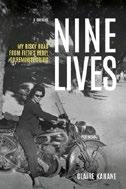
Kahane chronicles a life full of transformations during the mid-to-late 20th century in this memoir.
In 1935, the author was born in the Bronx to Jewish immigrants from Russia and Poland (“They were a tumultuous pair, my father and mother”). Per Kahane, their life traumas became ingrained in her psyche, resulting in a constant tug of war between being a stereotypical good daughter and pursuing the unconventional life she desired. Attending City College of New York, she met her lifelong friend and travel companion, Val; after graduating, they vagabonded through Europe, where she began the first of a series of fraught relationships with men. By 1966, her progress toward a doctorate degree at the University of California, Berkeley was at a standstill, and she realized that she “could no longer ignore the fact that [she] was inevitably drawn to men who needed [her] or something [she] represented.” The author began “the intimidating process of self-discovery” through analysis. Gaining insights from consciousness-raising groups popularized by second-wave feminism, Kahane “began to take [her]self more seriously as a scholar who was not just playing but working toward a serious profession.” In 1973, the author began her distinguished 24-year career as a professor of English at the State University of New York at Buffalo. Buffalo also provided a fruitful personal relationship with Rainer Hauser, a professor of German literature; they married and had a son in 1976. After retiring, the author returned to Berkeley full time, trained to become a psychoanalyst at the San Francisco Psychoanalytic Institute, and embarked on a new romance. Tracking her life from the Great Depression and World War II through the aftermath of the Holocaust, the 1950s and
1960s in New York City and the Bay Area, the anti-war and free speech movements, and the rise of feminism, Kahane’s compelling writing illuminates life during the turbulent 20th century from a female perspective often missing from history. The extensive descriptions of travel, varying from free-spirited, low-budget adventures through Europe, North Africa, and North America to professional conferences in Poland and China, are likewise fascinating. An engaging memoir of life lived to its fullest.
Kahn, James | BearManor Media (276 pp.)
$40 | $29 paper | May 4, 2025
9798887717319 | 9798887717302 paper
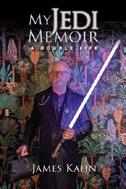
A medical doctor, bestselling novelist, and Hollywood insider shares details from his eclectic life. Kahn grew up in Illinois as the son of a general practitioner, and his interests have always been divided between medicine (which he describes as “a kind of sorcery”) and writing stories. After completing his medical internship, he took a year off to pen his first novel, Diagnosis: Murder (1980) about a crime-solving doctor. Later, while working as an emergency-room doctor at St. John’s Hospital in Santa Monica, California, Kahn met with film producer Kathleen Kennedy, who needed an expert medical opinion on a movie she was working on with director Steven Spielberg: E.T. the Extra-Terrestrial (1982). From there, Kahn’s life would be split between his career as a physician and his work on Hollywood productions. Spielberg would subsequently invite him to write the
novelization of another blockbuster film he produced—Poltergeist (1982)—which set the stage for a once-in-a-lifetime opportunity when he was later asked to novelize the final film of the original Star Warstrilogy, Return of the Jedi (1983). Kahn’s highly approachable remembrance is full of engrossing stories about his work as an M.D., his stints as a screenwriter for multiple television shows, and his side gig as a folk musician who released six albums.However, his work on Jedi takes center stage; not only did he bear the pressure of producing a novelization for what was perhaps the most anticipated movie of all time, but he also had to do so without having seen the final film— including its most iconic scene, in which Luke Skywalker finds out the truth about Darth Vader. The memoir explicitly tailors its behind-the-scenes vignettes to Star Wars fans, pulling back the curtain on the production of Jedi and blending Luke’s heroic journey with Kahn’s own life as he came into his own as both a writer and a physician.
The engaging story of a doctor’s unlikely connection to some iconic films.
Kennard, Byron | Self (206 pp.) | $16.95 paper | June 23, 2025 | 9798286391059

Kennard, an environmental activist and one of the founders of Earth Day, offers a set of essays on a variety of topics that have defined his life.
The pieces in this collection are short—most are only a few pages long—and they cover a
A lovely celebration of a long and fascinating career.
HOW I GOT TO BE A GREAT MAN
CAT MASK BOY
range of issues that have personal importance to the author, giving the book as a whole a memoiristic feel. The subjects include environmentalism, and what successful activism in that area involves—he was one of the co-creators of Earth Day, with Mike McCabe, in 1970, which mobilized millions, and he’s lobbied for important pro-environment legislation, among other achievements. He also talks about small businesses and their potential for innovation, political theory, and LGBTQ+ rights. Some essays are more autobiographical than others (as in one in which he notes that “the realization I was queer was a hellish experience, which I was forced to endure as a child ”), but all spotlight Kennard’s distinctive voice and explain how he’s put his beliefs and values to use. The tone is satirical but not caustic (“How come Bonaparte gets 300,000 books written about him and I get none? Not even one!), and it’s clear that Kennard doesn’t actually want to be blindly praised. However, he does discuss his considerable activism work, which may win over more readers to his ideas. It’s certainly fair for an accomplished fighter for justice, at the end of his career, to take the opportunity to show off a little bit, and Kennard proves to be a funny, generous writer. It’s a lot of fun to watch essays’ concepts overlap and influence one another, as when he notes the influence of economist E.F. Schumacher’s dictum that “Small systems are likely to be more manageable, responsive, efficient, accountable, and resilient than big systems.” His own expertise will almost certainly teach aspiring activists something new. Some may wish that some ideas were explained more thoroughly, but his essays are convincing and enjoyable throughout. He’s an engaging writer
and teacher, and it’s easy to see how his work brought so many people into the fight to save the planet.
A lovely celebration of a long and fascinating career.
Lew, Leslie | Illus. by Seyma Arslan Global Bookshelves International (24 pp.) $16.99 paper | May 1, 2025 | 9781957242248

Lew offers a picture book of affirmations for children. This book’s narration asserts that in order for one to have the heart of a warrior, one must first learn what such a warrior is: someone who faces their fears with a big heart, believes in themselves, feels happy, sad, excited, or scared, and knows that “Feeling these things makes them stronger.” Throughout, readers are encouraged to light the “tiny spark that makes them shine like a star” by saying the affirmations that appear in bold type on the following pages, such as “I stay true to myself,” “I rise when I fall,” and “I am a warrior, and I hold onto the love within me.” Arslan’s vivid watercolor-style illustrations are beautiful and lively, and they add greatly to the reading experience. There are no named characters, but one girl is highlighted; she experiences various emotions and is shown trying again after unsuccessfully approaching a task. (Other children are shown with various skin tones and body types with some using mobility aids.) The declarations are
impressively encouraging, empowering, and heartening, and they effectively connect to a foreword for adults, in which Lew expresses a hope: “may the affirmations on each page serve as the words you needed to hear as a child growing up.”
An uplifting and affecting work for readers of any age.
Liu, Linus | Nakama Press (192 pp.) | $10.99 paper | October 14, 2025 | 9781545821732
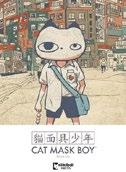
A clever underachiever must navigate the feared Kowloon Walled City in Liu’s winning manga.
In a colorful 1970s Hong Kong, 7-year-old Tiger, who “prefers to be clever rather than hardworking,” announces that he wants to be a superhero. He does so by leaping onto his teacher’s desk wearing an oversized cat’s head and declaring himself Cat Mask Boy, to the delight of his classmates. But his teacher disapproves, and so does his mother at home, who chases him around with a broom stick when he doesn’t do his homework and won’t take off his mask. Rather than improving through study, Tiger strikes a deal with a friend, Rocky: In exchange for Rocky’s homework, Tiger agrees to make him his own cat mask. The plan works, and Tiger is soon rewarded with his best-ever report card performance (though he’s still in the bottom three in the class). As a reward, they celebrate after school, and Tiger’s report card slips into a middle-aged man’s shopping bag. This sets Tiger on an adventure across the feared Kowloon Walled City, “a den of vice with gambling, drugs, and everything else.” Across the border, Tiger runs into Dragon, who’s a few years older and already a primary school dropout, wise beyond his years and similarly decked out in a cat mask. As he steers Tiger through the city in search of his report card, they grow closer as friends. While the stakes are low in terms of conflict, the everyday bullies and street toughs who stand in Tiger and Dragon’s
path entertainingly assume the roles of powerful manga villains in boys’ imaginations. Liu, doing double duty as writer and illustrator, brings their confrontations to kinetic life in dazzling action sequences. The color palette throughout mixes bright tones with muted, darker reds, browns, greens, and plenty of white (including the black-andwhite masks themselves). He is at his best in the final night sequences in the Walled City, where the Escher-like apartment buildings twist into each other as the friends try to escape before it’s too late. A fun, fast-paced ride with plenty of heart.
Manley, Bret | Illus. by Ira Baykovska Self (31 pp.) | $9.99 paper | July 30, 2025 9798992847505
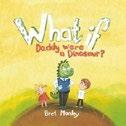
Two children urge their dad to play prehistoric pretend. On a rainy day, two children, who present white, lie restless on a couch while their father works from home. He appears stressed, so they urge him to give up his task to play with them instead. He asks if they want to build a fort or play superheroes, but what they really desire is for him to be a dinosaur. “What if Daddy were a pterodactyl? We’d climb on your back and rocket up high, / Soaring through clouds as we zoom through the sky.” Dad, in his button-down shirt, tie, and slacks, becomes a business casual pterodactyl soaring past a jetliner, but the children don’t stop there. They conjure up other imaginative possibilities: a stegosaurus that serves as a school bus, dolphin-watching cruise on top of a spinosaurus, and a triceratops that chugs toward a tunnel like a train. Even bedtime can’t stop the children from finding prehistoric ways to bring their family closer together. Manley’s debut picture book, a lively rhyming ode to parent-child relationships, is sure to be a hit in dinosaur-loving households. The different iterations of dad-as-dinosaur all
focus on the adult as someone who carries their children (or passengers) through adventures, an apt metaphor for parenting. Baykovska’s illustrations are reminiscent of a polished version of the drawings a child may give their father, but include subtle winks, like Dad casting a subtle dinosaur shadow. A sweet depiction of imaginative playtime with Dad.
Martinez, Marie | Mascot Books (208 pp.)
$21.95 paper | September 9, 2025
9798891381759
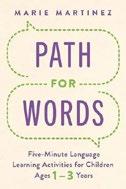
Certified speechlanguage pathologist and behavior analyst Martinez offers an easy-to-follow, research-backed guide to bridging communication gaps between toddlers and caregivers.
A young child wants milk but doesn’t know how to say the word milk —they simply point to their mouth, and their caregiver guesses at their needs by providing crackers and water. Frustrated with their inability to communicate, the toddler begins to scream and lash out. The caregiver feels hopeless, so they schedule an appointment with a local speech-language pathologist—only to hear it’ll be months to be seen. This sort of scenario is common in many households with a toddler, but in these pages, Martinez asserts that it doesn’t have to be that way. She presents a book of “preventive measures” so that caregivers can rest assured, knowing they have access to expert-backed knowledge and activities that can remedy miscommunications. Throughout, Martinez provides solid advice by drawing on the latest research as well as her own experience in her practice. For example, in a chapter on “concerning behaviors,” she notes that actions such as “tantrums, throwing, kicking, [or] hitting” tend to arise “in the
toddler years as children learn to communicate, regulate emotions, and navigate life as a small human,” and she follows this observation with a real-life, anonymized example from her own practice—and presents the strategy used to address the problem, which involved teaching a few simple words. The bulleted lists, clearly organized text, and easy-tofollow symbols in the activities section (standing for “next steps,” checklists, and more) will allow readers to implement guidance as quickly as possible “while… waiting for consistent support.” Finally, her ideas about “visual cues,” “modeling,” and “Grandma’s Rule” (“Grandma wouldn’t let you eat a cookie before your dinner, would she?”) will aid a wide range of caregivers, no matter what specific communication problems they face. Websites are included in the text of each chapter, and an extensive bibliography of additional resources appears in a final “Notes” section.
A helpful and easy-to-use language-learning manual.
Mulligan, Tim | Highpoint LIT (114 pp.) $24.99 paper | July 7, 2025 | 9798998972003
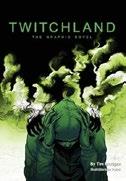
The concluding volume of Mulligan’s World of Witchland supernatural horror graphic novel trilogy. With the toxic wasteland of Richland, Washington—site of a billion-dollar nuclear cleanup and remediation project—as backdrop, Van and his daughter Ali have seen their fair share of tragedy living in Richland. The city’s proximity to a nuclear reactor has led to numerous recent radiation-related sicknesses and deaths. After Van’s husband—who worked at the power plant—died under questionable circumstances, Van has finally moved on and come to grips with his life as a widower. But with 50 million gallons of “toxic shit” still buried underground, Van and his friend Jennifer (a former power
plant employee) are questioning their decision to remain in Richland. When one of Ali’s friends (Brett) appears to become addicted to a new drug decimating the community, Ali and her father—along with Jennifer’s daughter Linda—join forces to investigate Brett’s bizarre transformation. What the amateur sleuths discover not only has links to the nuclear waste tanks but also has the potential to destroy countless lives. While the horror storyline with its mutant bogeymen isn’t exactly original, the power of this narrative comes from the well-developed cast of characters, who bring emotional intensity, dynamism, and authenticity to the story. Additionally, the distinctive illustrations by Pyrink perfectly complement the story’s thematic impact (their utilization of contrasting color, in particular, is noteworthy). Scenes in the local doughnut shop, for example, are depicted in vibrant yellows, pinks, and oranges while sequences at the nuclear reactor site and in shadowy back alleys feature unnatural greens and purples. Lastly, the (timely) subject of the country’s drug overdose epidemic was woven into the storyline with an interesting supernatural twist, and Richland itself was based on the real city of Richland with its dark history. A disturbing but engrossing read that deftly uses fiction to make relevant real-world social commentary.
O’Connor, Richard & Glenn Stout The Sager Group (460 pp.) | $23.95 paper May 13, 2025 | 9781958861608

“Big-time college sports is a cesspool,” according to New York City private investigator Elgin O’Brien—but he still decides to wade into it on behalf of a grieving father in O’Connor and Stout’s mystery novel. When the homicide of college basketball player Teddy Malone lands on his desk, Elgin—a former professional
b-ball player-turned-PI—is keen to prove that there was a motive behind the seemingly random shooting. There are no suspects in the murder, which occurred in midtown Manhattan, and Elgin soon uncovers that Teddy wasn’t the happy-go-lucky rising star that some claimed. His skills had been going downhill, despite what his head coach, Chris Corsito, says; the coach, whom Elgin, knows, considers himself a god at St. Stephen’s University—one too powerful to topple. After Elgin discovers that Teddy had a gambling addiction, it raises concerns about possible debts or game-fixing—which are only compounded when fentanyl is discovered in his bedroom. The case takes another turn when Elgin conducts interviews at a basketball camp and deems someone there to be a suspect—but there’s no obvious evidence, beyond the person’s guilty behavior. However, as Elgin gets closer to the truth, he’s offered a bribe to forget the whole thing, and Elgin’s girlfriend, actress Monique Montgomery, faces danger, as well. Despite all this, the PI continues to gather evidence and uncovers that some other people may have helped to enable terrible crimes. Elgin’s efforts lead to revelations of a very disturbing nature.
Although the book is set in the present day, the style and tropes of the story vividly recall the fast-paced adventures of decades-old detective stories. Elgin is sharp as a tack, although he’s sometimes cagy about it, and he has a dark past of his own that fuels his drive to discover the truth at all costs. Much of the investigation consists of interviews, and the quip-filled dialogue gives life to the story, and to Elgin as a character. Lines such as “I’ll find the shooter…but I’m not an executioner. I don’t deal in revenge” plunge the reader into the sometimes-melodramatic world of a crime-ridden New York City. Large sections of uninterrupted and unattributed dialogue disrupt the pace at times, but for the most part, the Q&A’s remain entertaining, thanks to Elgin’s strong voice. Along the way, the protagonist attempts to grapple with the money-driven world of professional basketball: “It’s really about power protecting power,” he reluctantly
concludes. It’s a hard-hitting message, and the vast conspiracy that drives the story is effectively horrific, even if it sometimes pushes the bounds of credulity; it seems unlikely that Elgin would happen upon a suspect and expose a massive secret so easily. He’s also personally threatened with violence before he seems to pose any real threat, and what Monique faces is not difficult to foresee. That said, readers will find it easy to immerse themselves in O’Connor and Stout’s fictional world, and they’ll judge Elgin to be a compelling guide.
An engaging whodunit with a hero with a sharp tongue and a sharper mind.
Orlesky, Toril | Mad Cave Studios (240 pp.) $19.99 paper | September 9, 2025 9781545820445

A graphic novel explores the relationship between a man and a centaur in 19th- century America. Evander Rook, a centaur and former Southern Unionist, gets hired by a sinister sphinx, Elen. Evander’s task is to kill Asa Langley, who’s the director of central west operations for Wakefield Steel and “crazy enough to eat the devil with horns on.” Instead of murdering Asa, Evander works for him, and a turbulent romantic entanglement develops. The pair travels through the United States. After first meeting in Iowa, they make a stop in Davidson, “a shithole town in Wyoming” that has a mine, and the Colorado territory Lynd, where Asa wants to build a railroad connecting to Denver. Evander and Asa consider living in Deseret, a provisional Western state that the inhabitants believe was Jesus’ final resting spot; it’s also a place rich in uranium, copper, and iron. After the duo’s plans are disrupted, Evander eventually gains
information about some puzzling questions, helping him make an important decision about his life and relationship with Asa. Using minimal and muted color tones reminiscent of sepia photographs, Orlesky skillfully renders images of an older America, though one inhabited by both humans and nonhumans. In this engrossing series opener, the engaging drawings depict multiple intriguing angles. One frame zooms in on Evander’s hooves crossing a railroad bridge while the next pulls back to show the centaur and a man as small shapes silhouetted against a panoramic sky. Marred by inner pain, Asa and Evander conceal it with laconic language. Their psychological battle, as they struggle not to kill or be killed, can get intense (and confusing), but wordlessly touching each other seems to bring them relief. Through Orlesky’s haunting illustrations of the uninhabited Western landscapes, wide open and natural, readers will get the sense of a land filled with promise and possibility that men like Asa exploit for personal gain. A twisted relationship searingly plays out amid beautifully delineated pastoral scenes of the American West.
Pajalić, Amra | Pishukin Press (330 pp.) | $20 paper | November 1, 2025 | 9781922871534

In Pajalić’s novel, the lead enters adolescence during the Serbian ethnic cleansing of Muslims in Bosnia. After the influx of refugees from the ongoing genocide, Dževahira Torlak, who goes by Seka, lives in besieged Srebrenica with her parents, grandparents, older brother, her mother’s sister and sister-in-law, as well as an uncle and two young cousins. Her family has taken in two refugees, Edina Muharemović and her son, Ramo, who is Seka’s age. As the family works to survive continual bombing,
An assiduously researched, cleareyed depiction of genocide.
TIME KNEELS BETWEEN MOUNTAINS
snipers, disease, and hunger, Seka and Ramo grow close and begin a romance as the years go by. In imitation of Anne Frank, Seka, who’s Muslim, writes in a diary to her friend, Zora, a Serb who evacuated with her family before the war. Seka’s writing eventually brings her into contact with a journalist from Australia, where Zora now lives.
Alyssa, the journalist, enlists Seka to write an exposé of the corruption in Srebrenica, which stems from closer to home than Seka first realizes. While the novel doesn’t require foreknowledge of the Bosnian genocide, Pajalić doesn’t provide much scaffolding; readers may want to research as they read. In an introduction, Pajalić provides trigger warnings, an index, and a glossary, all helpful tools for this harrowing story. According to the author, the “novel blends factual history with fictional storytelling to explore themes of justice, trauma, and complicity.” She gathered information for the novel from interviews she conducted with survivors of the genocide. Essays based on these interviews are collected in another of Pajalić’s books, Fragments of History: The Essays Behind the Stories. The novel, a thriller, deploys the drama and tension of the genre, though the action falls a bit flat during one character’s sudden villainous turn. Devastating descriptions of the gory consequences of war are the standout scenes here. Still, Seka experiences moments of beauty and joy, all lushly described: “I lost myself in the music, the anonymity of the darkness around us, the heaving bodies, and closed my eyes as I moved.” The novel skewers the international community’s complicity in genocide, which continues today. An assiduously researched, cleareyed depiction of genocide.
Pierlot, Maura | Big Ideas Press (350 pp.)
$16.99 paper | July 27, 2025
9780645099836

In Pierlot’s YA novel, a teen spends her school year racked with worries over her home life, her body image, and the new guy in class. Harley Hastings hopes this will be “The Year of Harley” at her school in Australia. But things aren’t looking good from the first day of Year 10; her best friend, Talia, who’s been gone all summer, seems intent on cozying up to the popular mean girl Eden. Likewise, Harley notices her close male friend, Griff, growing inexplicably distant. There’s a glimmer of hope, though, when an American student transfers to her high school. Handsome Colt Carter catches many an eye, but does the fact that he’s extra nice to Harley mean he likes her? As the year progresses, Harley fixates on a potential romance with Carter, as well as her anxiety over body issues. Convinced she needs to lose weight, Harley contemplates and tries several approaches, some of which aren’t healthy. Meanwhile, her father is constantly away on business, which may be the reason for her parents’ incessant arguments. Pierlot masterfully delivers a teenager’s narrative voice. Harley is sympathetic (she lost her beloved grandmother just before the school year begins) and endures fellow students, including Eden, mocking her. Her first-person account is so emotionally rich that her hang-ups and mistakes (even when she hurts someone) are understandable. (Carter doesn’t openly flirt with Harley, but he’s just warm enough to make readers understand why she’s
hooked.) The character is subtly nuanced—Harley excels at reading situations, such as Talia’s attempts to get a boy’s attention (“I’ve seen this show before and have no interest in re-runs”), but she isn’t quite as good at reading people. Watching her spiral and pick herself back up, only to fall again, is a heart-wrenching journey that’s worth taking. An insightful story showing that adolescence can be an enlightening but painful ride.
The Little Lion
With the Little Roar
Prentis, Nicola | Illus. by Maurice Carter
Lucky Rabbit (32 pp.) | $18.99 | $13.99 paper | August 19, 2025 | 9781966829003 9781966829010 paper

In Prentis’ picture book, a young lion learns how to harness her inner roar. Little Lion, a green-eyed cub with distinctive ponytail mane, dreams of developing her “grrrr ”and “purr ” into a proper, loud, grown-up lion “ROAR.” After a crocodile nearly snaps her up, she asks her animal friends for help. Hippo tells her how to “BELLOW” with one’s mouth, and Monkey explains how to “HOWL” from the throat. Little Lion can’t do either, but then Elephant suggests she try to “TRUMPET” by taking a deep breath and blowing it out. By tapping into what she’s learned, Little Lion finally learns to roar. Prentis writes in straightforward, unmetered couplets, employing simple end-rhymes or playfully subverting expected pairings, as in “Little Lion goes towards him. Crocodile snaps his jaws. / Little Lion throws her head back. She’s so surprised she... squeaks.” Carter’s illustrations render the savanna in lush and moody greens, purples, and pinks, employing strong lines, watery inks, and crayon shadings to striking effect. The cartoonish animals are full of character, allowing the story to function as both an unadorned narrative and as a personal-development fable. Young
An amusing, antic mystery with surprising and touching twists.
F*CK THIS MURDER
readers will enjoy Elephant’s colorful trumpeting and Crocodile’s comeuppance. A sweet, spirited story about overcoming obstacles.
Quant, Elizabeth Land & Signe E. Land | The Unpopular Publishing Co September 29, 2025 | 9798999439222
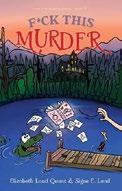
In Quant and Land’s comic mystery, a woman contends with numerous travails when former classmates converge at her just-opened bed-and-breakfast.
Minnesotan Maggie Livingston is an “almost divorced, thirty-something autistic woman who had just moved back down south to rent out her beloved ancestral home to strangers,” and she’s been dealing with one problem after another. First, she hustles the corpse of an elderly guest, who apparently died of natural causes, out of her place to escape the health inspector’s notice; later, it comes to light that old Mr. Trembolt may not have been who he said he was—and may have been the victim of a murder. Meanwhile, her booked wedding party, all former high school classmates, is plagued by numerous disasters over the course of a week, including food poisoning and poison ivy, aggressive yellowjackets, and the discovery of a severed human leg, among other things. In the midst of all this, Maggie—who once underwent fertility treatments—is nervous but hopeful that she may be pregnant, due to an ill-advised hookup with her cheating, soon-to-be-ex-husband, Lance. He tries to lure her back to Minnesota, as does a
promotion-offering former employer. Maggie’s also anxious about seeing Alice, her former high school girlfriend, whom she betrayed by sleeping with Lance some 14 years ago. There’s also a blackmail plot, related to a tragic event that occurred during Maggie’s high school days. This colorful, spiraling whodunit effectively combines suspense with tongue-in-cheek absurdity; chapter titles include “Scooby Do or Die” and “What’s a Body Part Between Friends?,” and there are nods to both the 1997 horror film I Know What You Did Last Summer and the TV series Buffy the Vampire Slayer. Readers may find that keeping track of this book’s large squad of characters is challenging, but they’re a believable and attractively diverse bunch of potential suspects. Ultimately, though, this novel has a sweetness to it, with Maggie and her former antagonists coming together in common cause.
An amusing, antic mystery with surprising and touching twists.
Ramstad, Sheryl | Muse Literary (355 pp.) $14.99 paper | January 27, 2025
9781960876805

A Minnesota judge and plane-crash survivor writes about her many personal and career accomplishments. In 1979, Ramstad was a 29-year-old lawyer with strong career ambitions, attempting her first solo flight. She was piloting a single-engine
Piper Tomahawk, and the engine sputtered and died while she was flying over her home base of Minneapolis— and in that instant, she knew that she was going to crash in less than 30 seconds. The descending plane caught fire after hitting power lines, and the author was severely burned; she survived the crash but spent seven weeks in a hospital burn unit. The agonizing process wasn’t one that her doctors thought she’d survive, but she did, and she immediately turned her attention to new challenges. As a prosecutor, she enjoyed courtroom battles (“Every argument made and every question asked was a step toward the truth”), but after the accident, she felt that she’d be better able to pursue justice as a judge. She also trained for a marathon, even though she wasn’t fully healed, and as a trauma survivor, the race presented unique challenges. She also served as commissioner of corrections in Minnesota Gov. Jesse Ventura’s administration. Along the way, she notes how she and her husband adopted three children, but also dealt with a troubled marriage. Ramstad’s highly readable memoir ably depicts how her initiative and drive led to a career and a life full of unique successes. It flows well, even as it describes a very busy existence, and when it discusses difficult subject matter, it succinctly presents the author’s challenges in an inviting and generous manner. Her accomplishments don’t end after she literally climbs a mountain— Mount Kilimanjaro, in 2006—but continue, showcasing her impressive drive for achievement. Some readers may wish that some aspects of her personal life, including her relationship with her spouse, were addressed in more detail. However, the memoir promises a “full throttle” narrative, and it is indeed full of compelling and inspiring stories. A vivid remembrance of a full life and career.
Reardon, Anna Binder | Trampoline Press (360 pp.) | $18.95 paper September 30, 2025 | 9798992419870

Reardon’s novel vividly depicts coping with mental illness.
Amelia Glickman can’t function without weed and alcohol and random hookups. And she can’t blame an abusive or even a chilly childhood. Her upper middle class parents’ divorce was traumatic, but they both love her fiercely and support her regardless. And they are even finding new and admirable partners. After Amelia, a longtime equestrian, puts her horse, Hope, at risk by jumping her while stoned, she breaks down and agrees to a “grippy-sock vacay,” a stint in rehab. Thus begins the lead’s long, hard trek to recovery, which will be the arc of the book. This means a series of dreary church basement meetings of fellow sufferers. But some of the sufferers become her fast friends and the little house with the red door on Wethersfield Road in Austin becomes an almost magical shelter and retreat. Of course, the journey has plenty of setbacks, stoking dramatic tension, often because of real jerks, guys who exploit her desperate need for love, or what passes for it. But through it all, at least she guards her sobriety and she lucks onto good people, like the wise Ethan who becomes her housemate (the key is to find people who have gone through the fire). She has a deep connection to her horse and to her dog, Delilah—no surprise that animals are more trustworthy and giving than so many humans. And she also has an eating disorder—bingeing and purging—which she managed to keep secret…until she
WETHERSFIELD ROAD
can’t. One theme here is Amelia’s learning to accept her body.
A former mental health therapist, Reardon infuses the book with a passion for recovery and appreciation of life. Her background brings bona fides to an expansive, engrossing novel that might have been based on well-meaning guesswork and assumptions. Amelia’s recovery is slow and often painful, especially after tangling with Jerk #1 and then Jerk #2. Were it not for Ethan, she would be justified in swearing off men entirely. Fortunately, that doesn’t happen. (She does discover, however, thanks to an encounter with Cat, her old high school rival, that she’s bisexual.) Reardon, a skilled writer, has made Amelia a witty guide through the drama and pain. From feeling when we first meet her like “a scream looking for a mouth,” Amelia fights through all her formidable demons, many of which had been incubated very early on—no surprise as these things go—to being so confident that she can go to grad school and become a mental health therapist herself. A recurring scene, and theme, is the annual New Year’s Eve party on Wethersfield Road to celebrate the good lives earned, a riotous affair even though all the revelers are cold sober. Amelia is a frustrating character until she eventually becomes a celebrant of the good life, inviting us to share it, at which point she becomes all but irresistible. Toward the very end of the novel, there is a coy surprise waiting for the reader, one that explains much.
An involving, well-written debut.
Reyes, Kimberly | Omnidawn (128 pp.) $19.95 paper | May 6, 2025 | 9781632431660
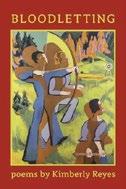
Reyes wrestles with race, gender, popular culture, and relationships in this fiery poetry collection. The book opens with “Red,” a meditation on Taylor Swift’s “fire-engine-Radio-Flyer- / Americana-taste-the-summer” hued lips, and
the “currency” between them. In the titular poem, Reyes disavows Swift due to the controversial circumstances surrounding Swift’s partner, Travis Kelce, and his ex-girlfriend, Kayla Nicole, who is Black. Though Reyes once loved Swift because “heartbreak was my story / and she wrote it so well,” the Grammy-winning artist failing to stand up for Nicole during media backlash led to Reyes’ conclusion that the superstar only “cosplayed as a sympathetic character.” In “claiming to know the tense in which love happens,” the poet notes that love’s timeline isn’t linear but is evident in small details, behaviors, and feelings. “It doesn’t always last, / and we don’t all even know that it’s happened, / when it’s happening, / which is the cruelest of all time thefts,” she writes. Reyes draws inspiration from Pulitzer Prize–winning Diane Seuss in “My love for things is partial,” a poem about her father and generational pain. Multiple poems discuss her estrangement from her brother and only sibling because “His girlfriends progressively got lighter / He got bolder. / Then he Ye’d.” “I grew up” contrasts Black and white professional basketball players, including Magic Johnson and Larry Bird. Reyes astutely notes that while Johnson smiled “on cue” for the cameras, Larry Bird “got to brood / with vain / moods.” The book concludes with QR codes for a playlist Reyes dubs the “Bloodletting soundtrack.”
Reyes cleverly combines memoir and cultural analysis in this subversive poetry collection. The book’s voice is its greatest strength. Reyes is at once introspective and uncompromising as she analyzes life for Black women in a world that often denies them full personhood. She not only calls out beloved icons, but she also interrogates her own fascination with celebrity. Rather than force a cathartic conclusion to her poems, she instead lets thoughts wander, leaves pages of white space, and invites readers to sit with her in the discomfort of powerlessness and rage. Her visceral descriptions will captivate readers, like when she compares the “silent synchronized / contraction, this tremble” of shivering bees to the “overproduced concert of crickets” and “melodrama / of cicadas who leave so much carcass in their wake.” Her descriptions of celebrities are equally
creative and sometimes literary, like one of professional basketball player Angel Reese, who Reyes declares has “nearly perfect baby hair // ends curved with the precision of Artemis’ bow, / yet soft and doe-like as an Oread’s touch.” Imagining her father as a child, she paints a clear, touching portrait of him at Coney Island, “happy / eating pee-water franks and vandalizing gray fire hydrants to unleash // cold fury.” Many of Reyes’ poems, however, are unfocused; the titular poem pinballs among myriad topics, including U2 frontman Bono, the Israel-Palestine conflict, astrology, Taylor Swift’s love life, and social media. With so many detours, Reyes’ message occasionally gets lost. But the strength and original delivery of the ideas here make up for the meandering. A fierce, involving analysis of modern culture that sometimes wanders off topic.
Rosenthal, Lorraine Zago | Tribeca Press (311 pp.) | November 11, 2025 9798990833173 | 9798990833166 paper

Rosenthal’s melancholic romance novel explores love, loss, and the people we can’t let go. Suzanne Starek is nearing 30 and stuck in emotional and professional limbo. An adjunct instructor of American history in Manhattan, she spends her days grading papers, dodging insecurities, and stoically carrying a torch for her lifelong best friend, Jay Darnell. “If he knew I was dying for more, it could ruin everything,” she confesses. “It might make things different. Weird. Awkward. I could lose him—and that would be even worse than spending the rest of my life being secretly in love with my best friend.” Jay, who lives with his troubled and emotionally volatile mother, Laurinda, is charming, decent, and, as Suzanne notes, “the only man I want to sleep on [my sheets] with me.” Their relationship is complex, shaped by decades of shared history and silent
sacrifice. But as old friends re-emerge, lovers circle in and out of the picture, and the memory of Suzanne’s gifted uncle and absent father haunt her, she’s forced to reckon with what it means to stay silent. Rosenthal’s prose is quietly luminous and deeply empathetic. Even everyday exchanges are weighted with unspoken longing: “You should eat,” Jay says gently. “You look very thin.” The book is populated with rich supporting characters, including Suzanne’s no-nonsense nurse mother, her bitter grandfather, Jay’s glamorous, toxic mother, and the enigmatic Tru Warrick, who may or may not be Jay’s latest love interest. The plot unfolds at a meditative pace, emphasizing emotion over event. Still, the narrative is layered with personal and familial drama—tenure-track anxieties, health scares, bitter generational conflict, and unresolved grief. At the beautifully melancholic story’s heart is Suzanne’s aching question: What do we do with the love we can’t express?
An elegant, slow-burning portrait of quiet heartbreak and enduring love.
Sherbanee, Joe | Hangar Business Publishing (346 pp.) | $24.99 paper April 27, 2025 | 9798992205411

Sherbanee presents a guide to business principles and operations for those who would rather be focusing on their art.
In this debut business book, the author, an entertainment technology executive, offers creatives advice on establishing a financially viable business while retaining an artistic vision and finding joy in creative work. The book opens with a comprehensive and high-level overview of economic concepts like profit, margins, business plans, and modes of financing. (The book covers everything from an explanation of supply and
demand to the details of financial statements in its opening pages, so readers with some familiarity with the subject will be able to skip around as needed.) Sherbanee then discusses the importance of establishing a unique value proposition and how this can be applied to different marketing concepts and business structures before turning to the particular importance of community for creatives (“Encourage your community to celebrate each other’s successes, offer help when needed, and collaborate around shared interests”). The book’s final section provides short takes on the ways in which artificial intelligence, the gig economy, and risk management affect those working in the arts and related fields. A particularly interesting subsection reminds readers of the many opportunities for work in noncreative (and occasionally more stable) roles that support the arts and are a crucial part of the creative community. The book is thorough and addresses the most basic aspects of running a business without talking down to its readers, offering plenty of details from Sherbanee’s own career and those of other creatives to establish his credentials as a teacher and demonstrate the validity of his advice. The book is at its strongest when providing concrete and actionable recommendations for easy-to-implement techniques, as when the author addresses the importance of establishing systems for smooth and consistent business operations (noting that this is a pain point for many creatives). Sherbanee makes it clear that his thoughtful and informative guidance can be adapted to a wide range of creative fields and economic conditions, giving the book a broad potential audience. An upbeat primer for running a creative business for artists at all levels of financial awareness.
Wang, Aaron | Books in Color (218 pp.)
$16.99 paper | September 9, 2025
9781069506412

In Wang’s novel, an unemployed Brooklynite is accused of his ex-boyfriend’s murder.
Pete Chan has had enough. It’s June 7, 2024, the beginning of Pride Month, and musician Charli XCX’s newest release, BRAT, is the perfect soundtrack for changing his life. Pete walks into his dreary office and quits his job as a communications coordinator on the spot, then heads to his boyfriend Toby’s house to quit him as well. Toby Lu is “a stereotypical artist: thirty-one, living off [Pete’s] hard-earned money.” Before the day is over, Pete’s moved out of the house owned by Toby’s wealthy dad and is living in his friend Johnny’s spare room. Through Johnny, Pete gains two more valuable things: a barista job at the cozy, plant-cluttered Volcano Café and the code to Johnny’s gun safe. Pete adores his return to barista life, but is promptly fired when he throws an iced latte into the face of a hyper-demanding customer. The incident winds up online, and soon Pete’s a viral internet icon, a “BRATista” remixed into countless Charli XCXsoundtracked videos that hail him as a fighter for service workers everywhere. A transformative night at the Charli XCX-led SWEAT tour convinces Pete to become a pop music critic, but he’s quickly castigated for his lukewarm review of Beyoncé’s Cowboy Carter album. Hurt, he tracks down his primary digital tormentor, a Chicagoan named
Frankie, and takes a road trip to a trendy Chicago cafe to confront him, carrying Johnny’s loaded gun in the backseat “just for security.” When he returns after a whirlwind weekend with the surprisingly kind—and hot—Frankie, police inform him that Toby was found shot to death, and Pete’s the primary suspect. Wang’s hyperspecific digressions on Brooklyn millennial gay life—including specialty coffee culture, hookup app etiquette, and a track-by-track breakdown of the SWEAT tour—are deeply entertaining but long-winded. Pete spends much of the novel interfacing solely with a screen, and it’s both fun and exhausting to read the play-by-plays of his digital activities, rendered in fond but frustrated detail. A clever, hyperonline thriller heavy on the cultural commentary.
Whittier, A.J. | Magical Seattle Books (350 pp) $16 paper | July 9, 2025 | 9798998880001 Series: Magical Seattle, 2
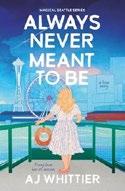
In this novel, an unhappily married woman meets her favorite actor and embarks on an emotionally fraught affair. Sarah Abbott has long been disappointed with her husband, Ben, who works constantly and seems to have forgotten she exists. Having lost her own high-powered job two years earlier and then nursed herself through depression, she finds that her only bright spot is watching movies featuring Joseph Robert Parker. Sarah feels a deep, inexplicable connection to the B-list actor (“Ever since the first instance she laid eyes on him almost twenty years ago, her sights have locked on him like a missile targeting system”). Then one day she sees her idol standing on a street in her home city of Seattle. After she introduces herself, Joe reveals that he’s in town to consider sites for a film, but the location scout had a family emergency, and now he’s on his own. Sarah offers
to play tour guide, and they’re both surprised when Joe accepts. What follows are two delightful days for the pair. Joe, too, is in a strained marriage, and he and Sarah feel significantly happier with each other rather than their spouses. They only wonder whether they can act on their desires, blowing up the lives they’ve built and hurting others in order to be together. Told in the third person, the book alternates between Sarah’s and Joe’s perspectives, offering pictures of how unsatisfying the home life each has built is and the hope they feel when they’re together. While acknowledging the inherent wrongness of extramarital affairs, Whittier deftly creates moral ambiguity in the characters’ actions. With the story providing suspense about whether Sarah and Joe will get caught—and whether they’ll choose desire over ethics—this engrossing, plot-driven novel will keep readers glued to the pages. Similarly, as the duo scouts movie locations, traveling from popular tourist haunts like Pike’s Place Market to lesser-known scenic parks, the author creates a love letter to Seattle, such that readers might find themselves planning a trip. While the work does include a few moments of magical realism that feel out of sync with the tale’s overall tone, the ultimate outcome is neither predictable nor trite.
An engaging, thought-provoking love story.
Williams, Anderson W. | Self (206 pp.) | $12.95 paper | June 19, 2025 | 9798280466180

A powerful thriller with religious overtones and a great twist ending.
PREPARE TO MEET THY GOD
In Williams’ novel, a humble Tennessee town disguises a history of mayhem and murder.
The Wimples— a family of preachers, zealots, and rebels—have probably lived in the mountain town of Summerton for as long as the town has
existed; in any case, they have the most names in the cemetery. There was Jeremiah “Papaw” Wimple, a bootlegger who, after he began preaching, built the Mountain Baptist Church of the Risen Christ in 1911. Amos, his son, attempted to organize workers at the local mill when they began mysteriously falling ill; he was blacklisted, and then caught the painful respiratory ailment himself. His lonely wife, Esther Mae, became a pawn in the wake of a local scandal. Earlier generations of the family had biblical names, but Amos and Esther Mae’s spirited daughter, Hattie Lou, is an exception; still, she grows up shadowed by church politics that she hardly understands, aside from the fact that the Mountain Baptist Church of the Risen Christ has recently been taken over by Brother Eli, a popular minister colluding with a rabble-rousing Tennessee senator, Clete Wilson. Williams presents a psychological thriller that builds slowly without fully revealing its secrets until the very end. The author skillfully conveys the dichotomy in rural lives surrounded by Christian ideals but controlled by corrupt politics. The touches of Faulknerian experimentalism are enthralling as Hattie Lou narrates some sections, while others are told from a third-person perspective. Williams also has a Chandleresque ability to craft accurately observed but sinister descriptions, even of everyday objects: “two aluminum folding chairs with woven nylon seats that had been leaning against the trailer so long that the weeds had tangled in the legs right up through the arms.” The work develops themes of faith and salvation as Hattie Lou searches for restitution, and it all builds toward an unexpected conclusion. A powerful thriller with religious overtones and a great twist ending.
Williams, Paloma | Illus. by Alena Karabach Self (38 pp.) | $22.99 | July 1, 2025 9798218675240

Williams tells a heartwarming story about a lovable bear learning to accept himself. Milo is a big bear with an even bigger heart, but he sometimes wishes that he wasn’t quite so large. So, he sets off on an adventure to find a fabled magical rainbow that might make him smaller. During his journey, he meets various forest animals—a bouncy bunny, a graceful deer, a keen hedgehog, a playful raccoon, and a grand moose—each with their own perspective on why they love themselves as they are. After his first interaction, he begins to rethink his view of his own size, and with each additional conversation, he grows more comfortable in his own fur. His trip leads to a moment when his size and strength help him to rescue a fox trapped under a rock. The experience leaves him feeling proud, confident, and finally at peace with who he is. Over the course of the story, children, caregivers, and educators are sure to love the fun, rhyming sentences: “I eat when I’m hungry, I stop when I’m done, / And that’s how I hop and have so much fun!” They’ll also enjoy the vibrant colors in Karabach’s cartoon illustrations of cute, endearing animals, as well as the book’s fine lesson about loving oneself.
A touching, well-illustrated story about embracing one’s unique qualities.

ISBN: XXX-X-XX-XXXXXX-X

